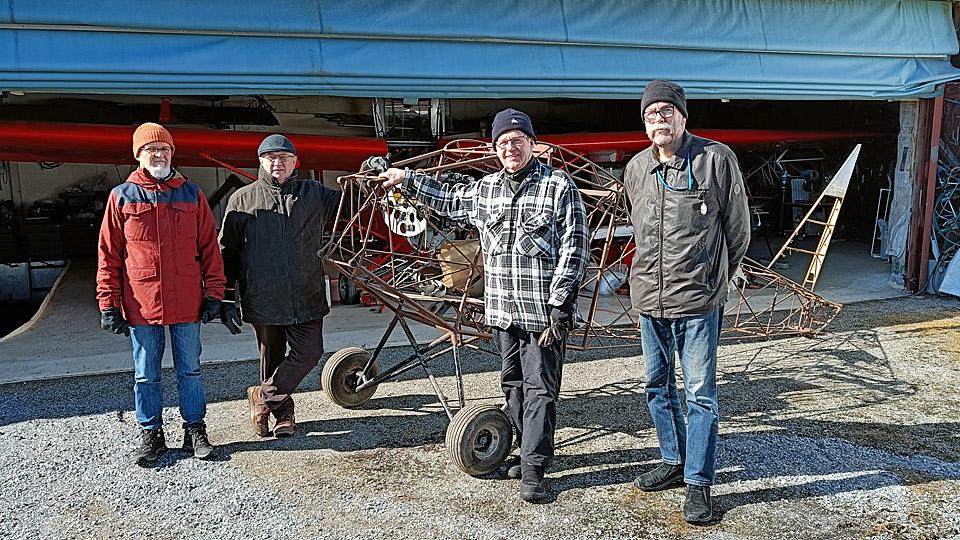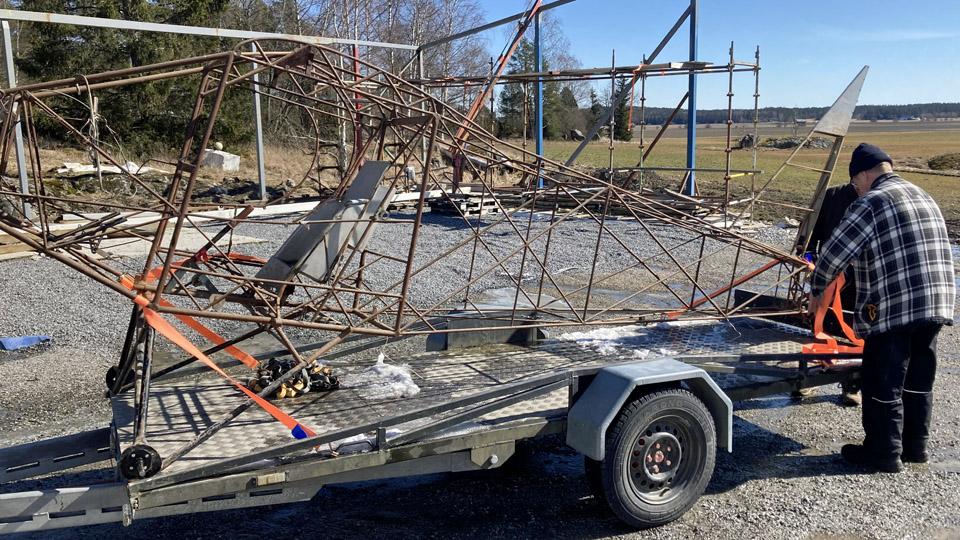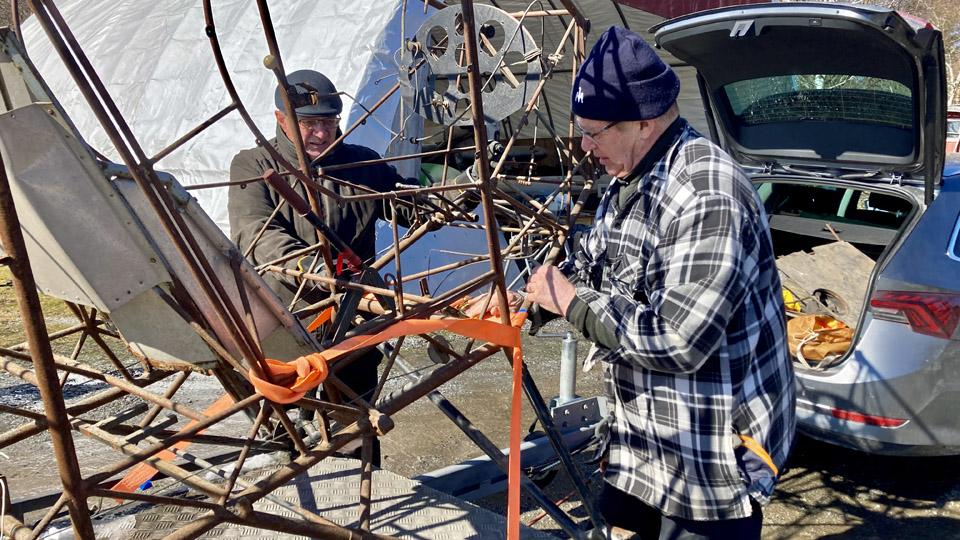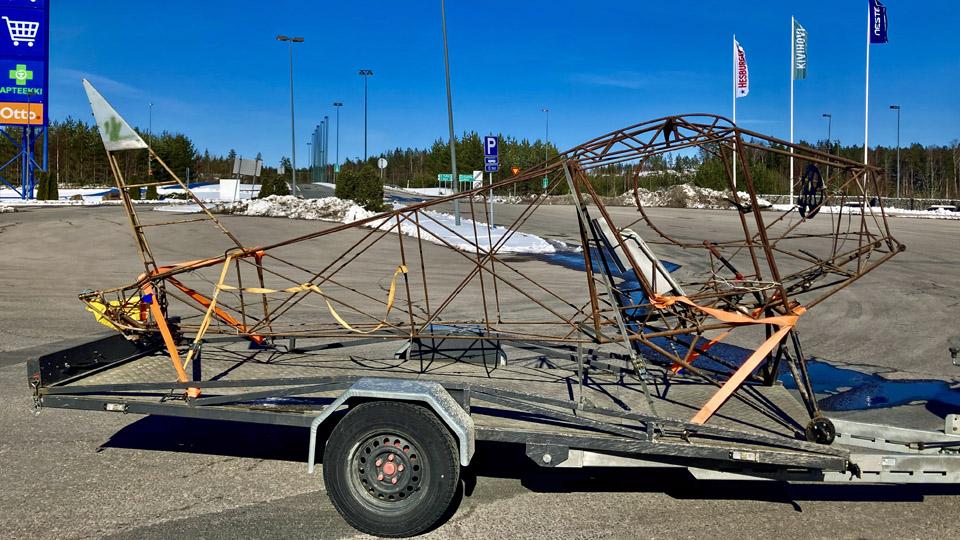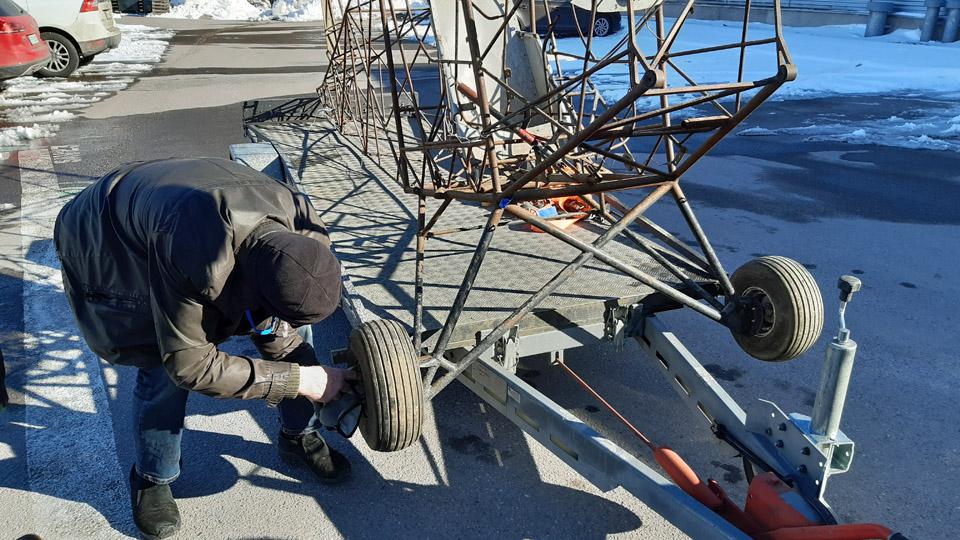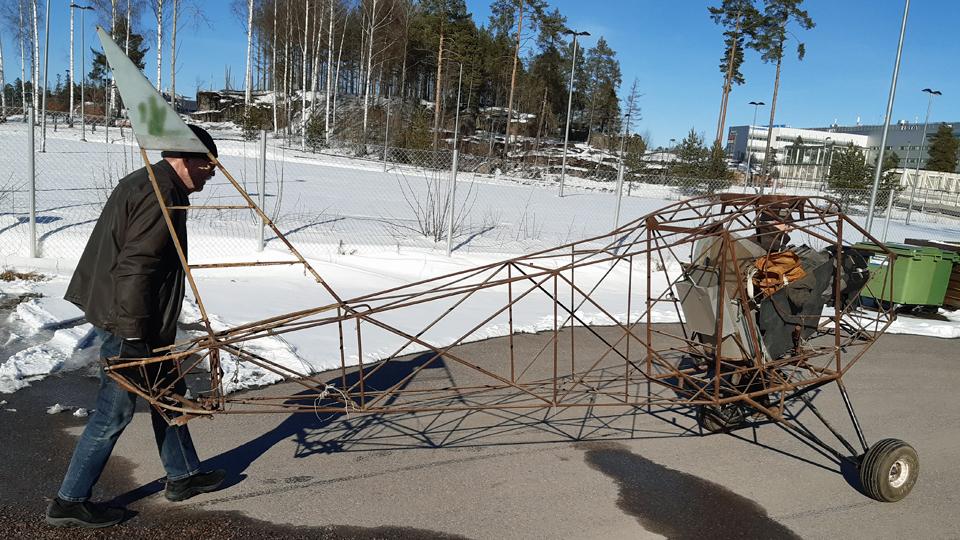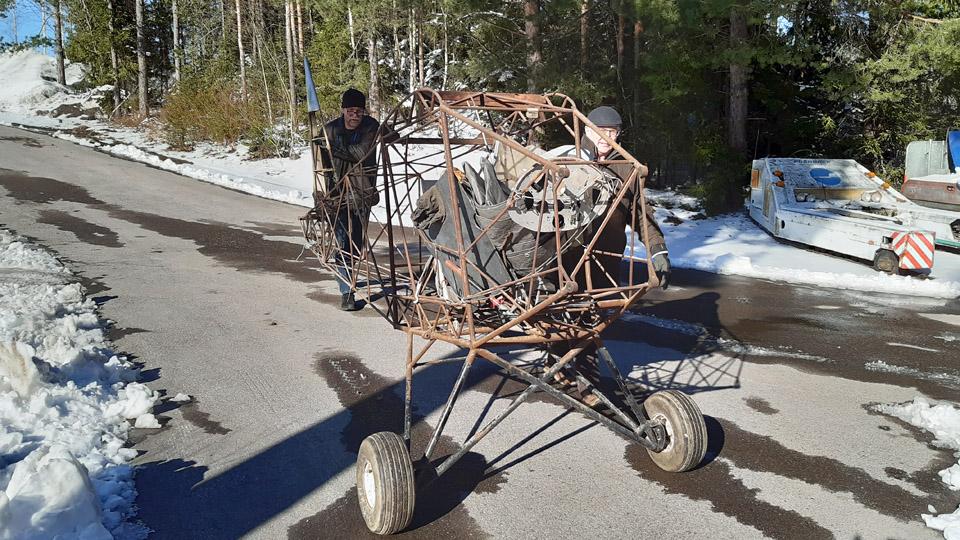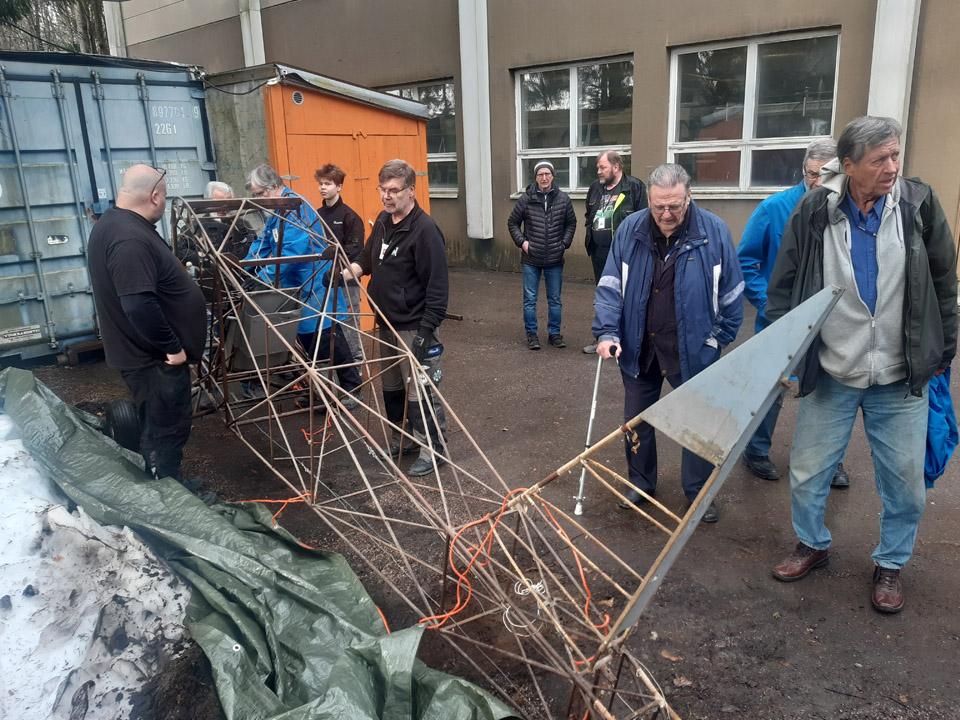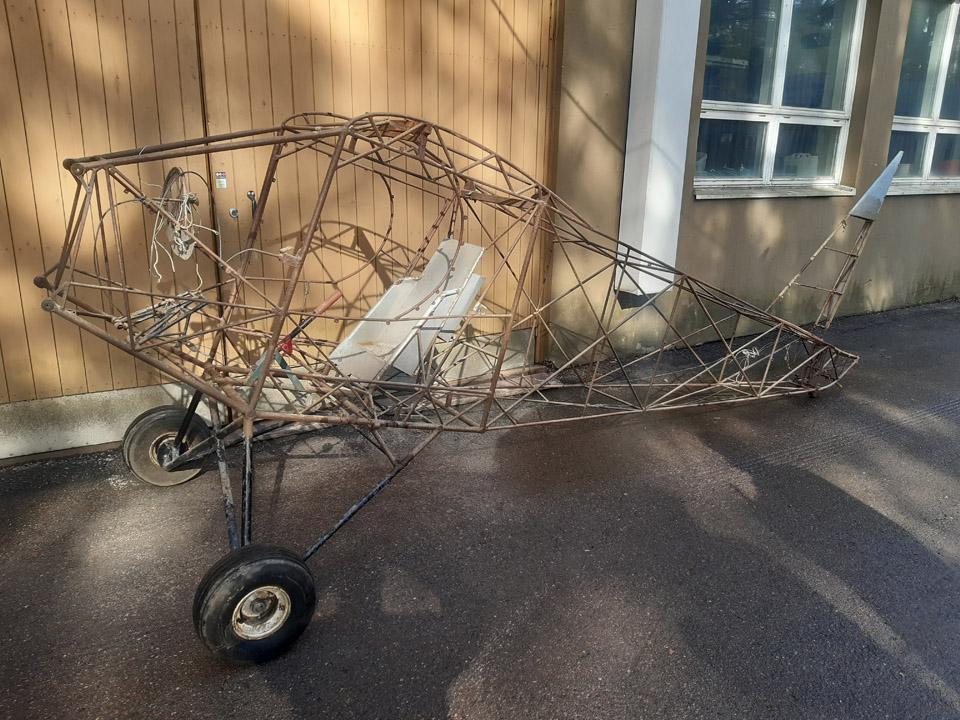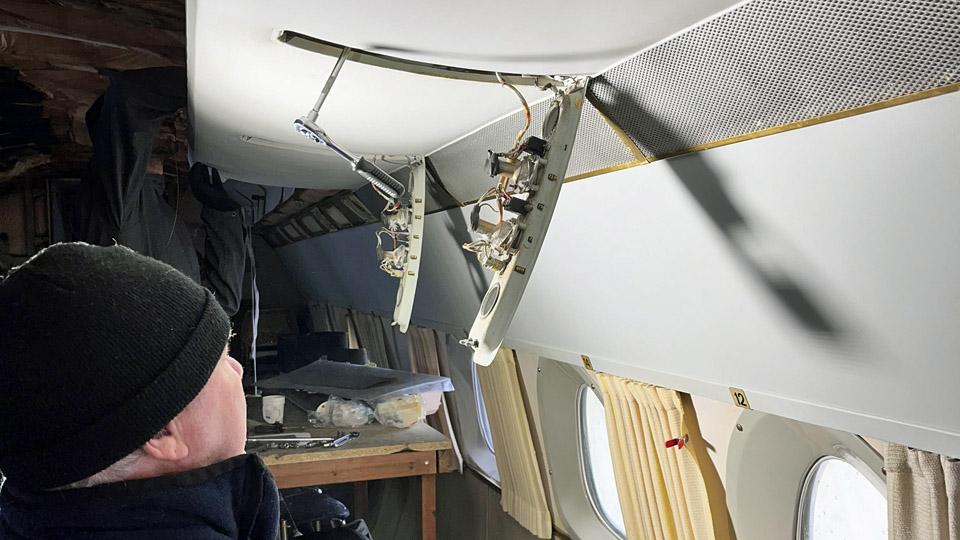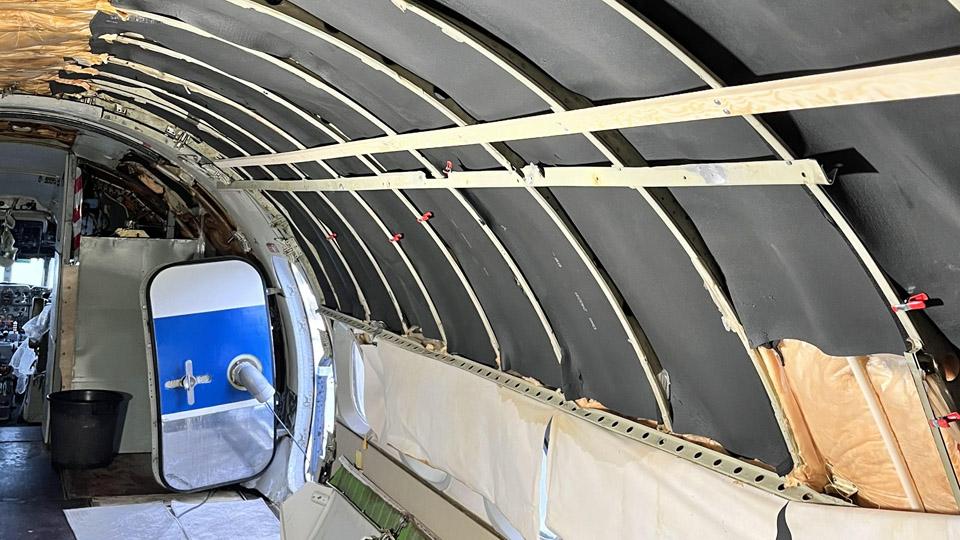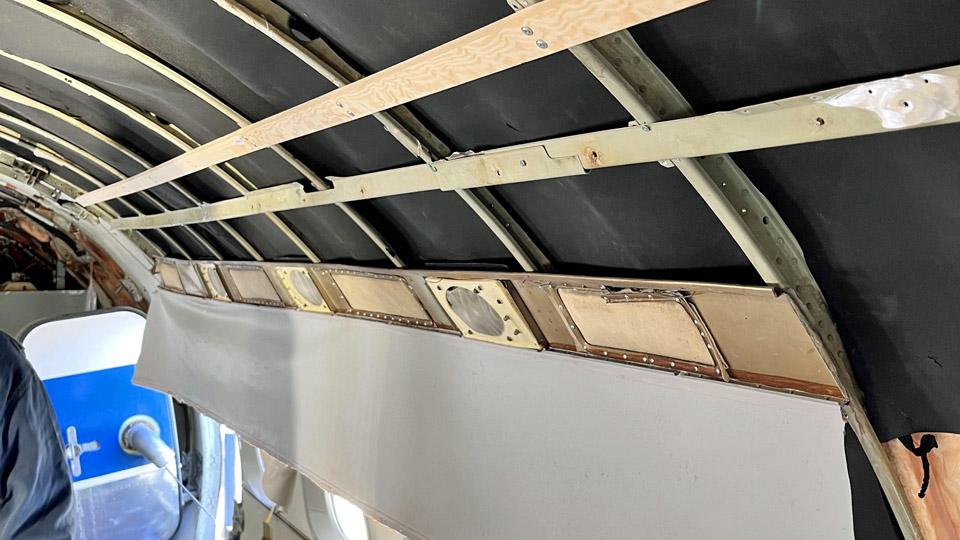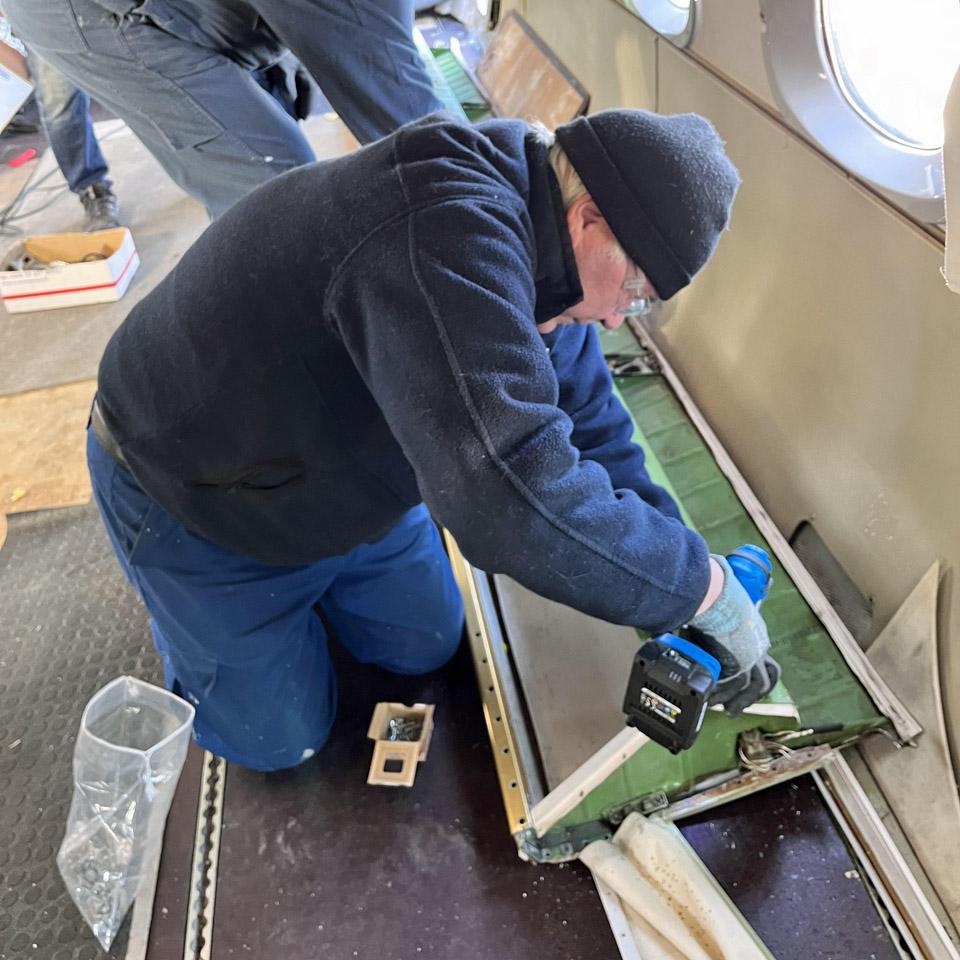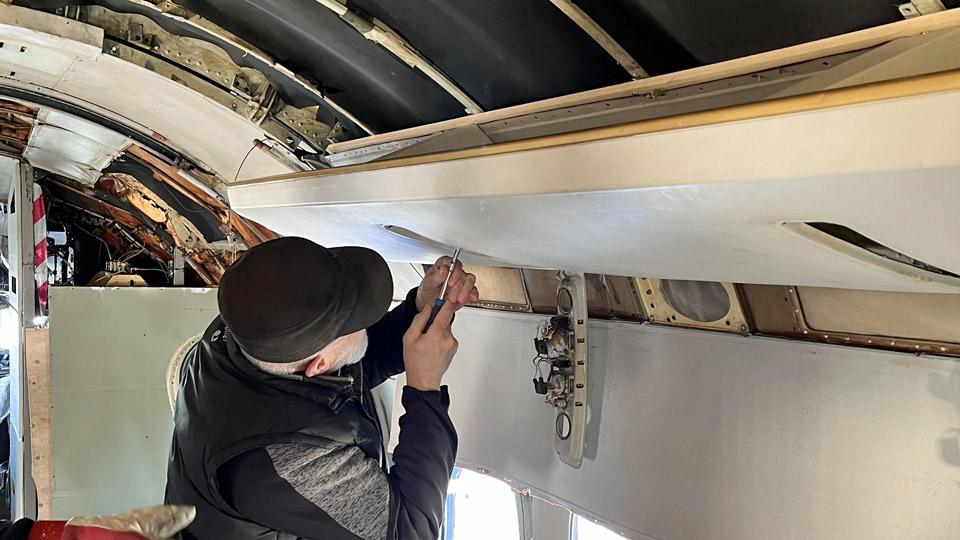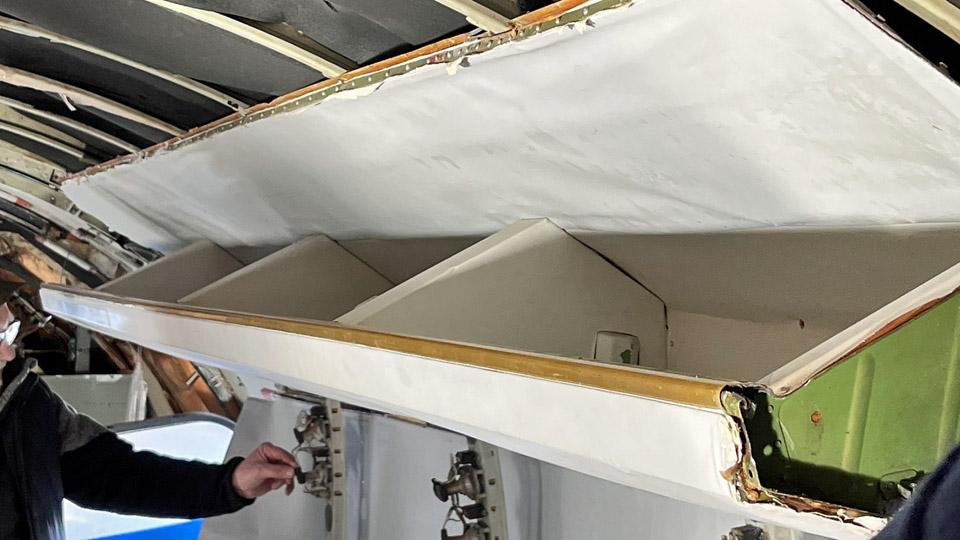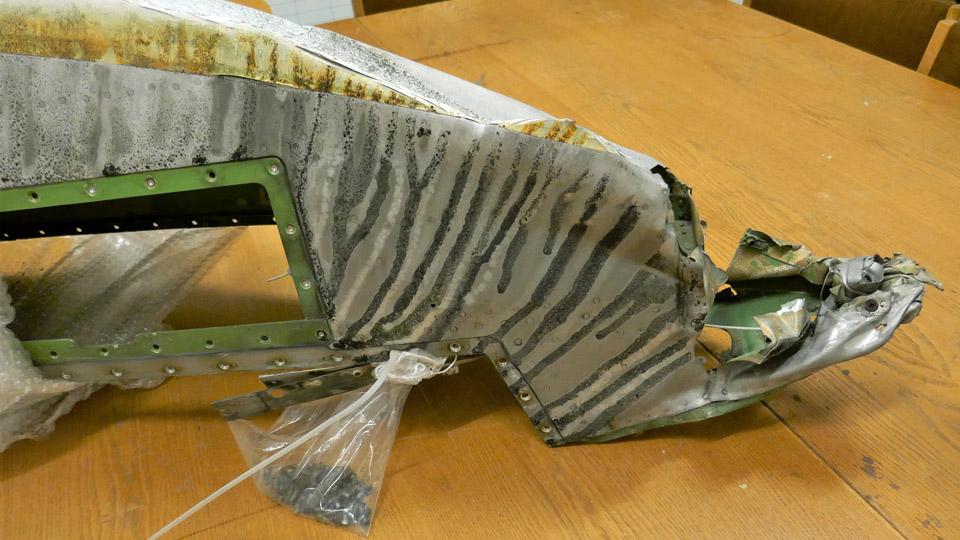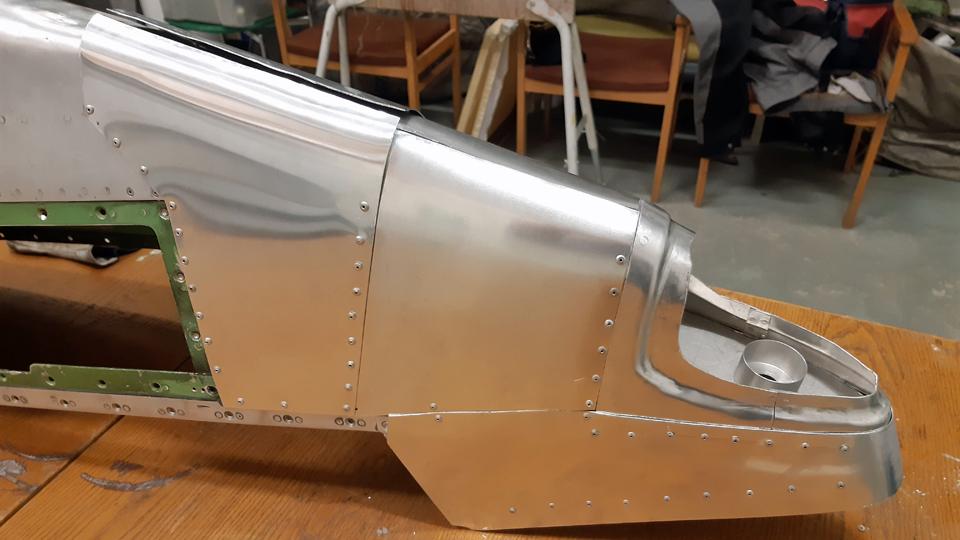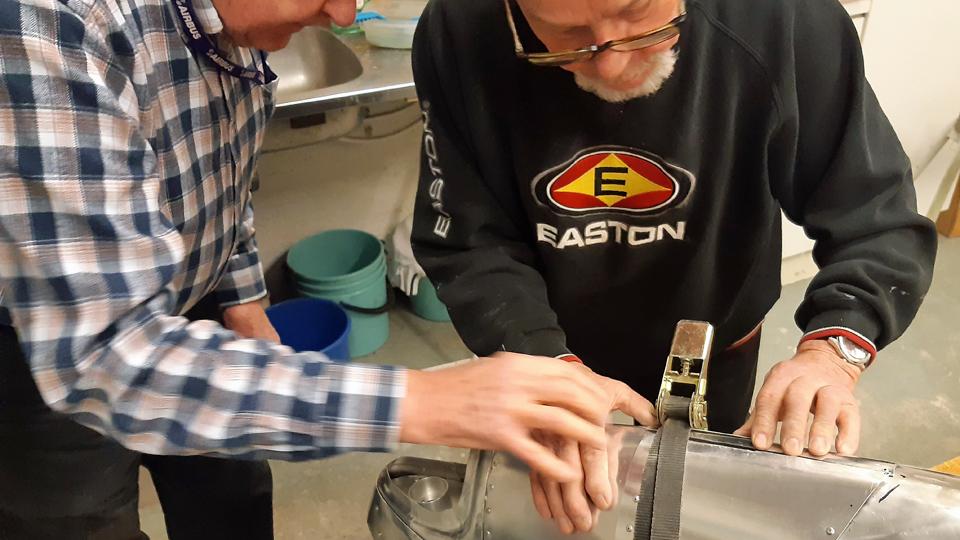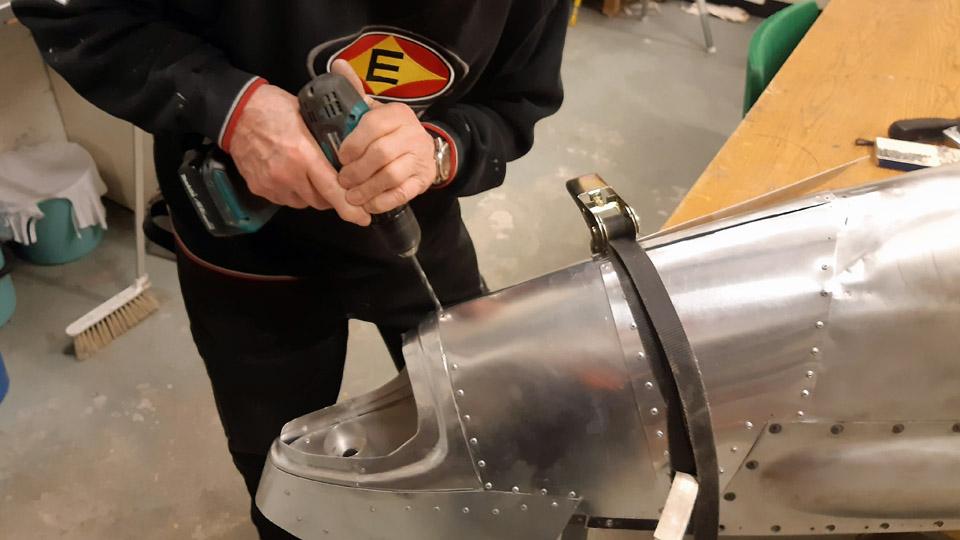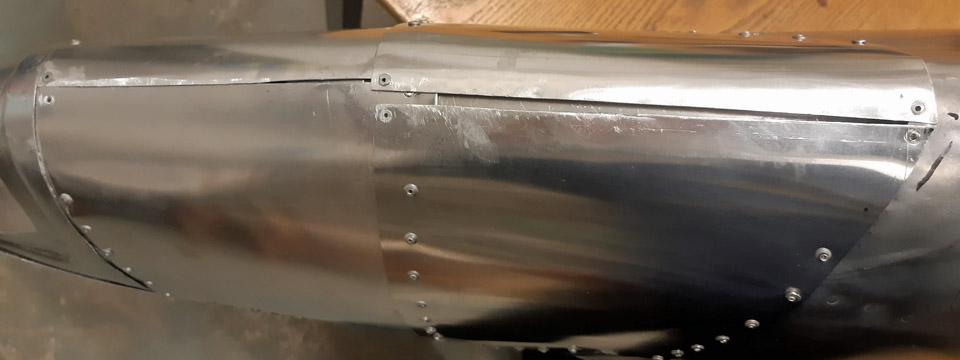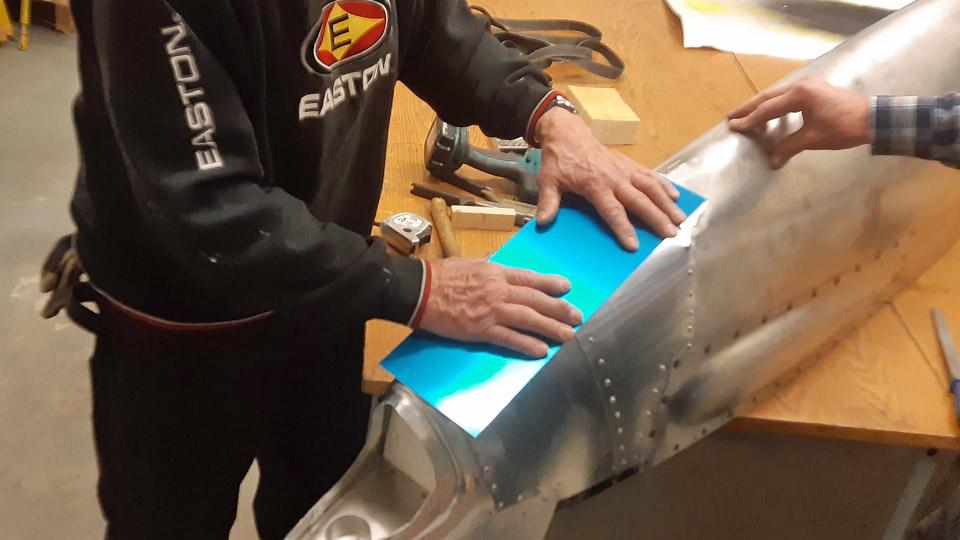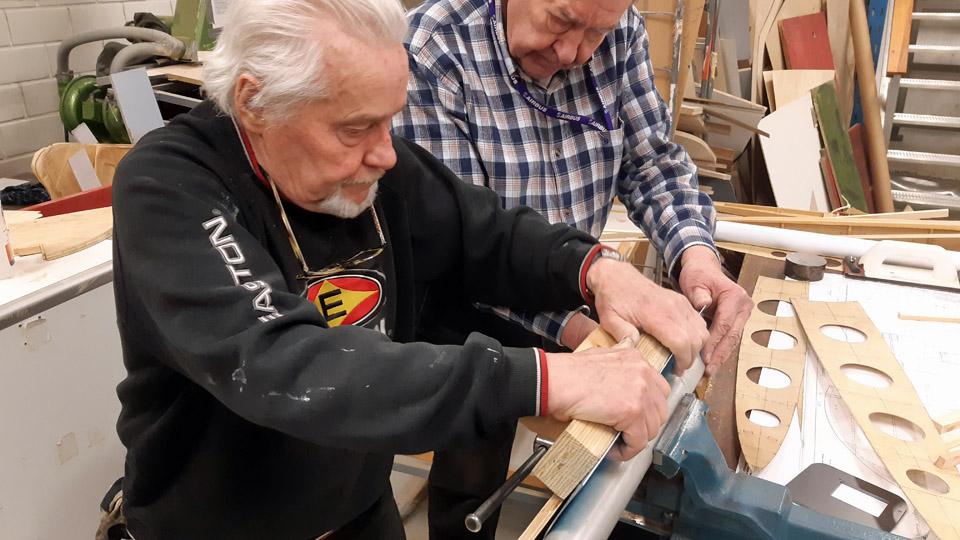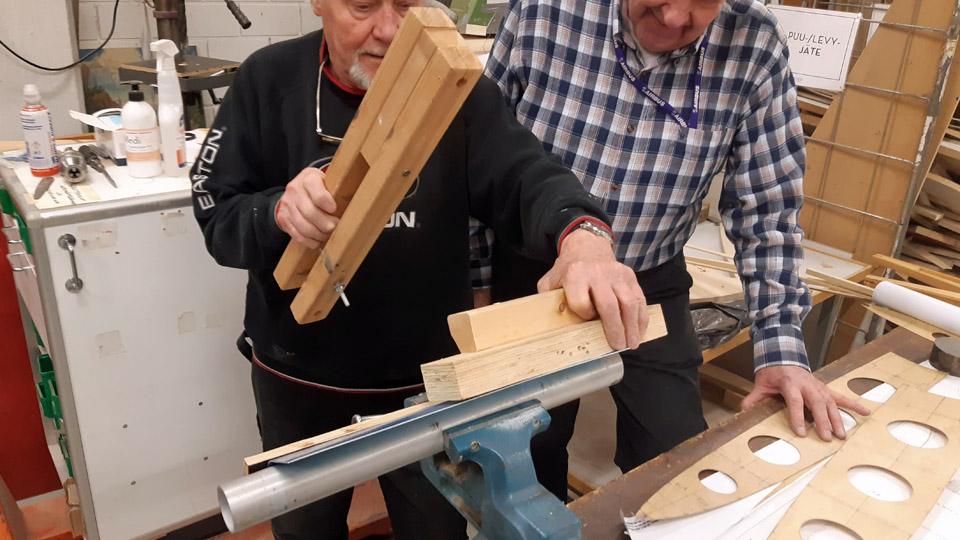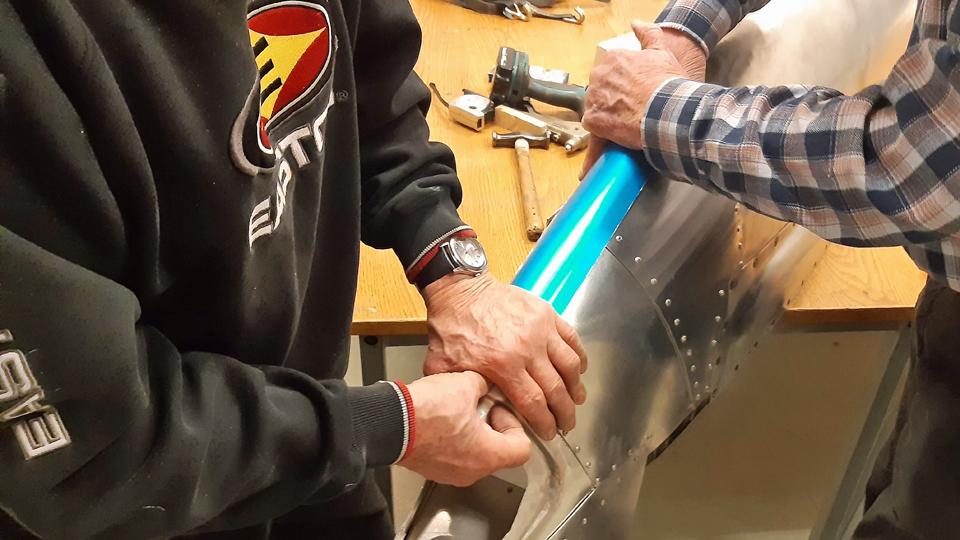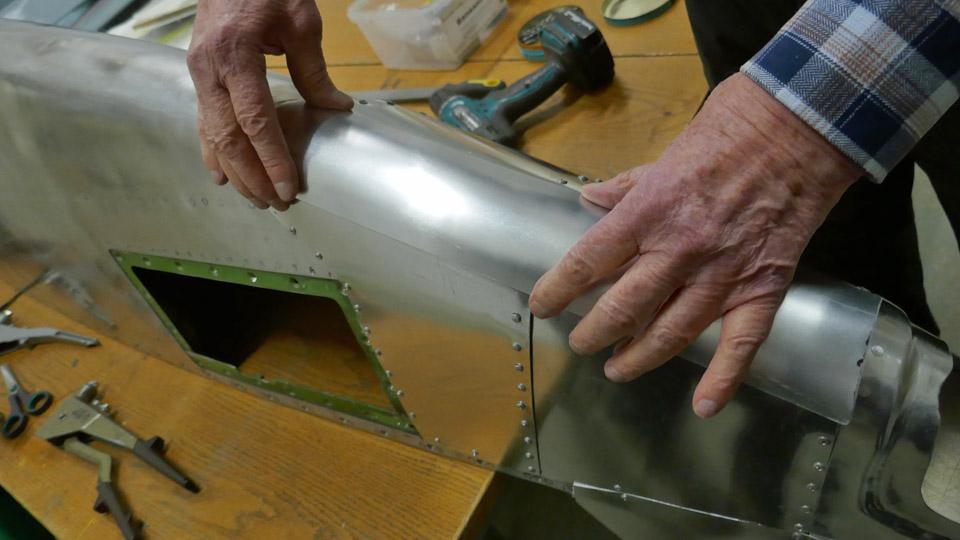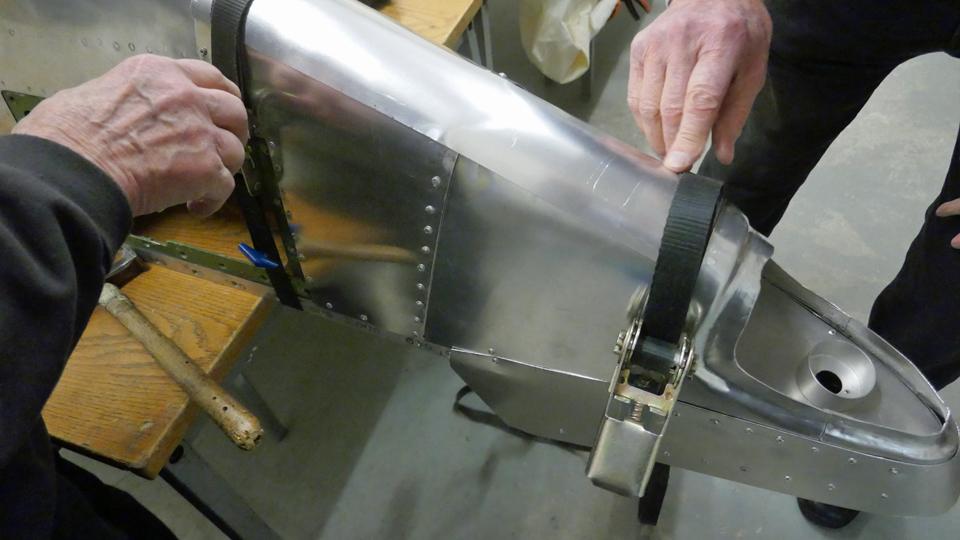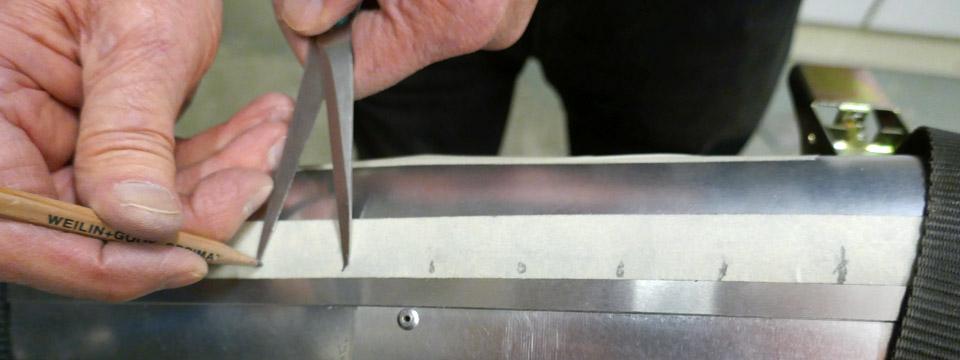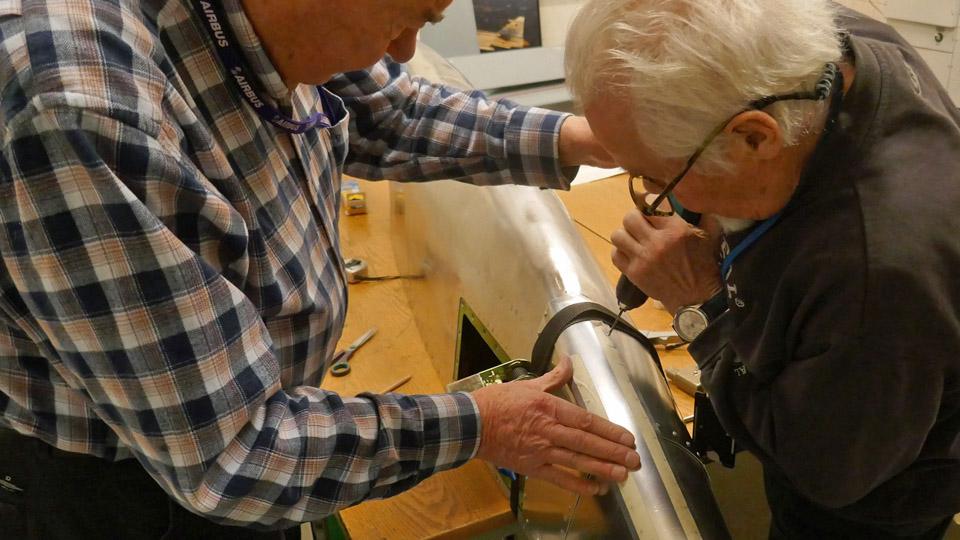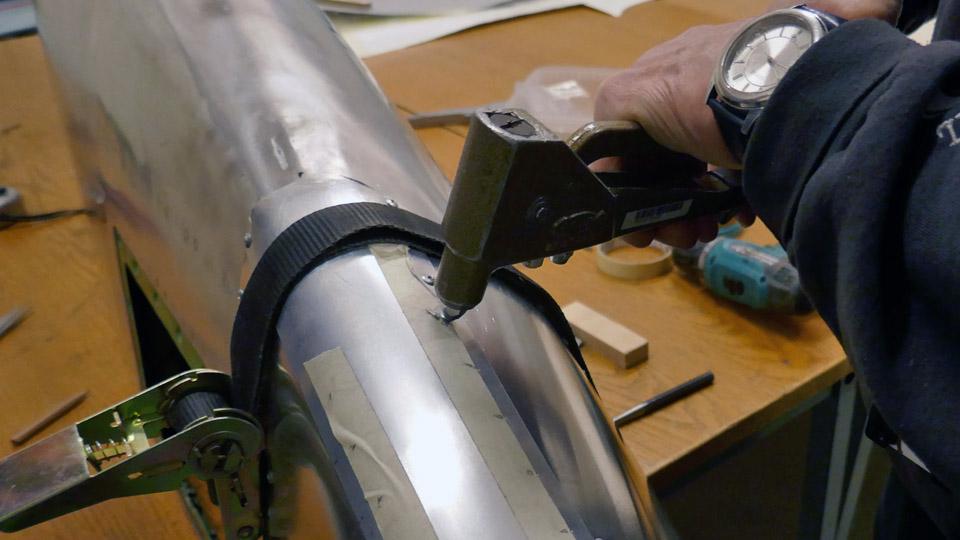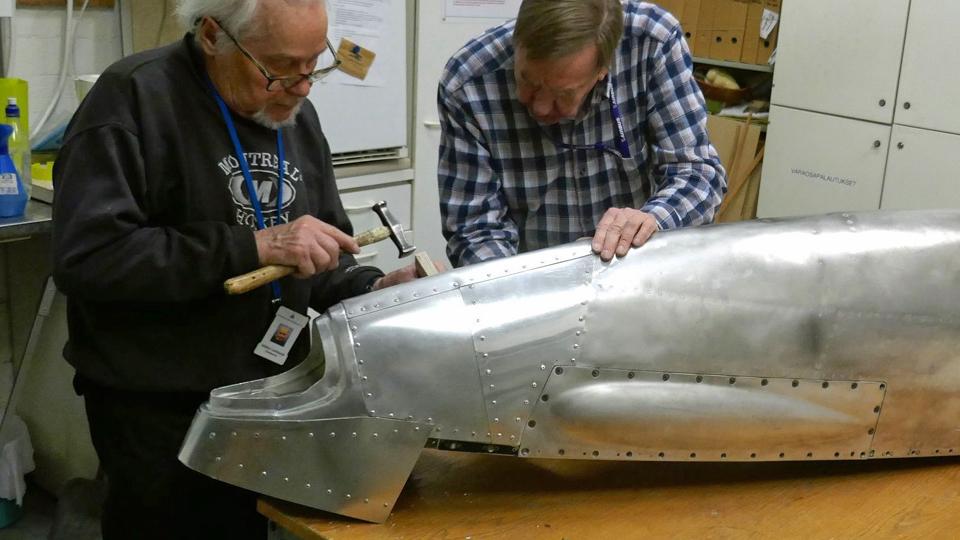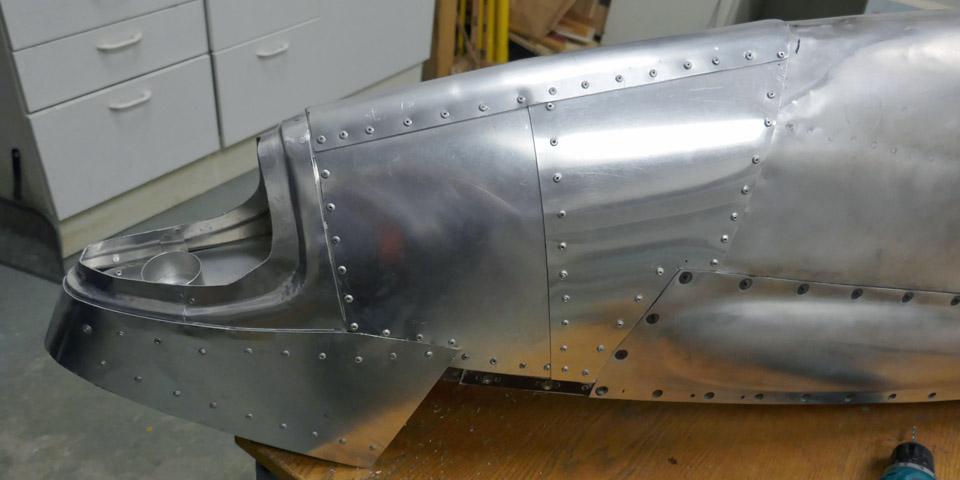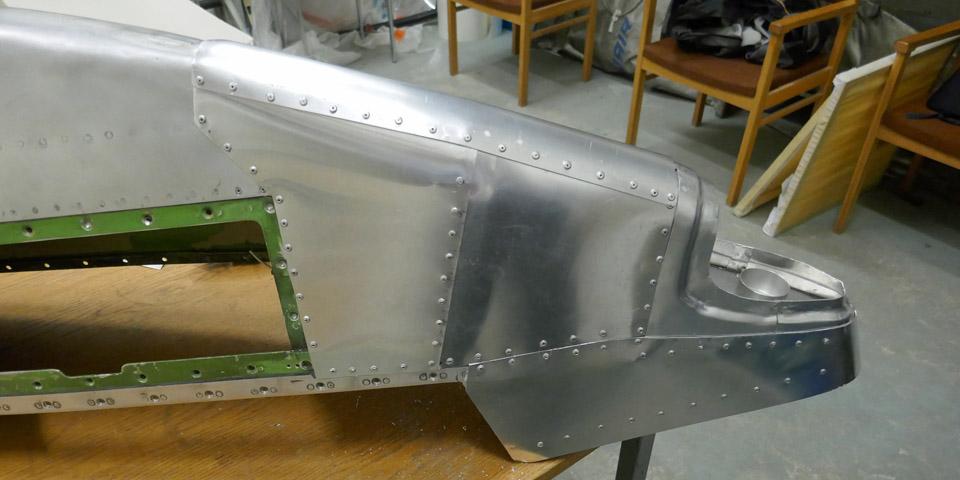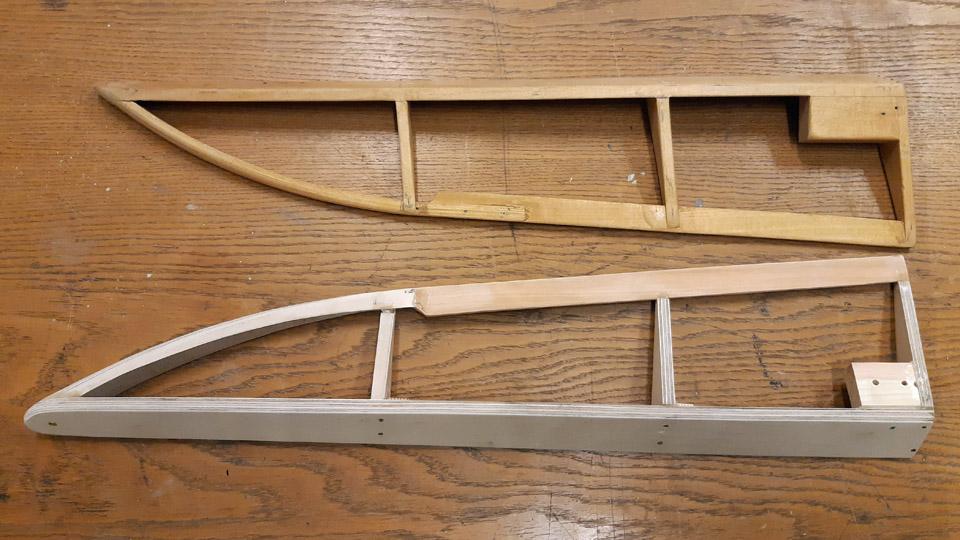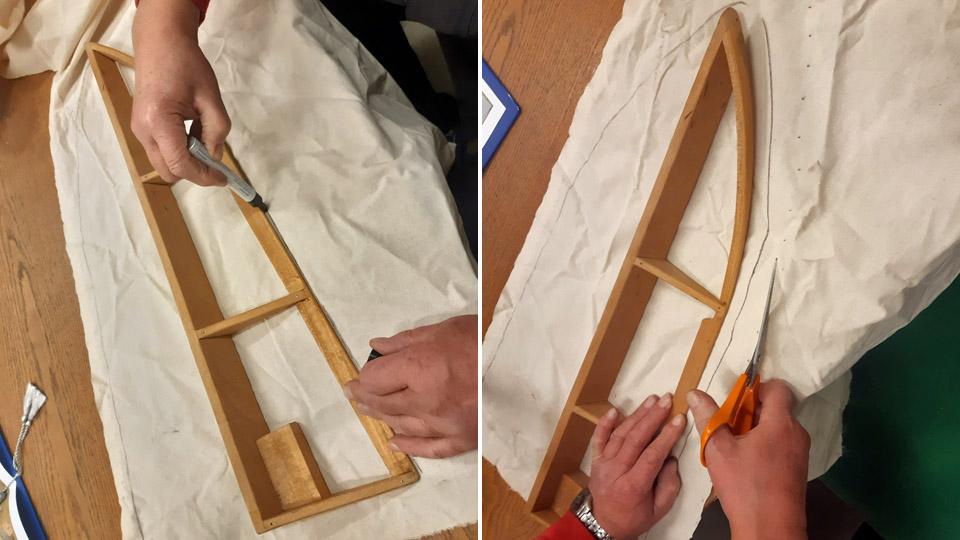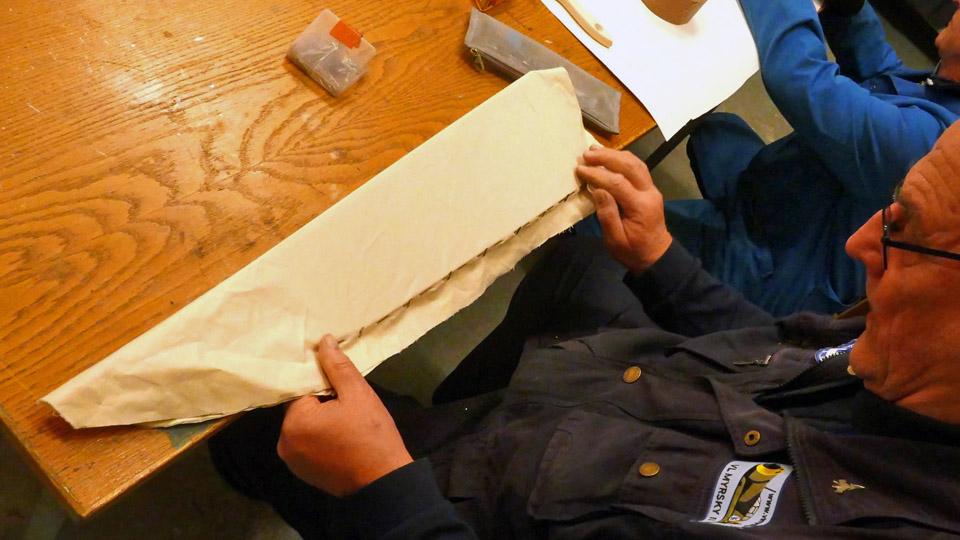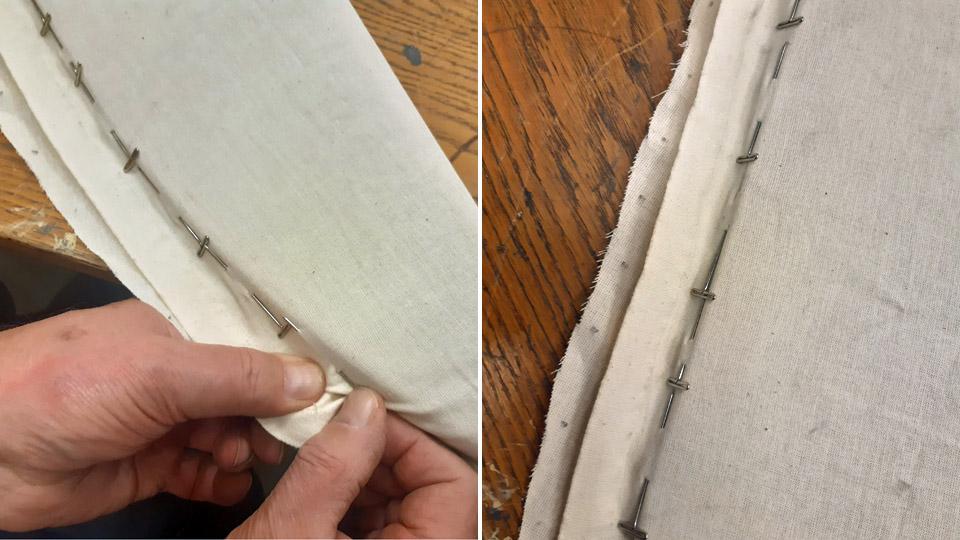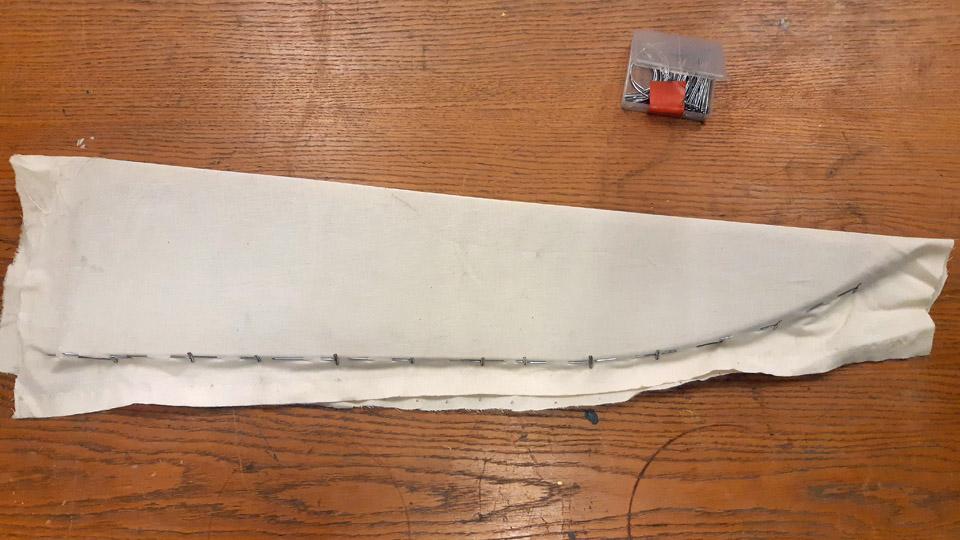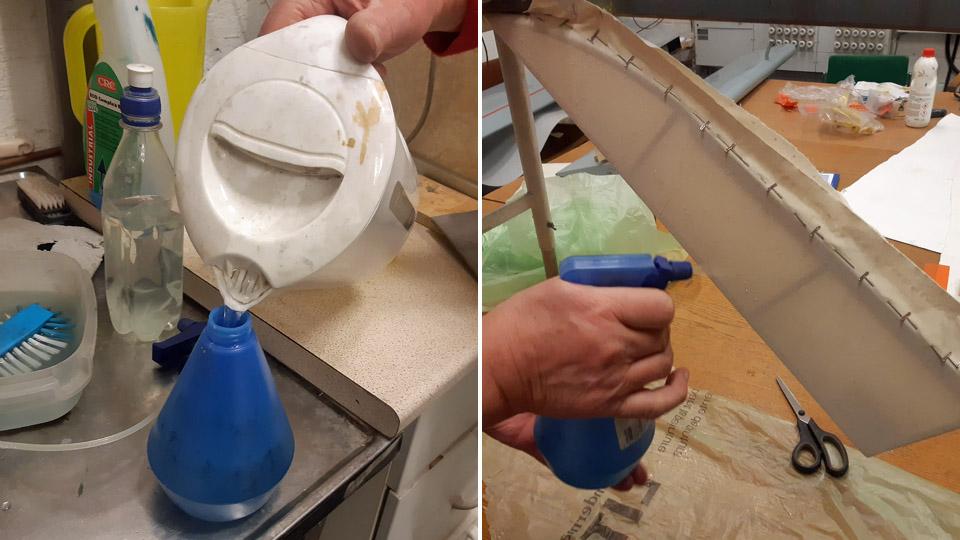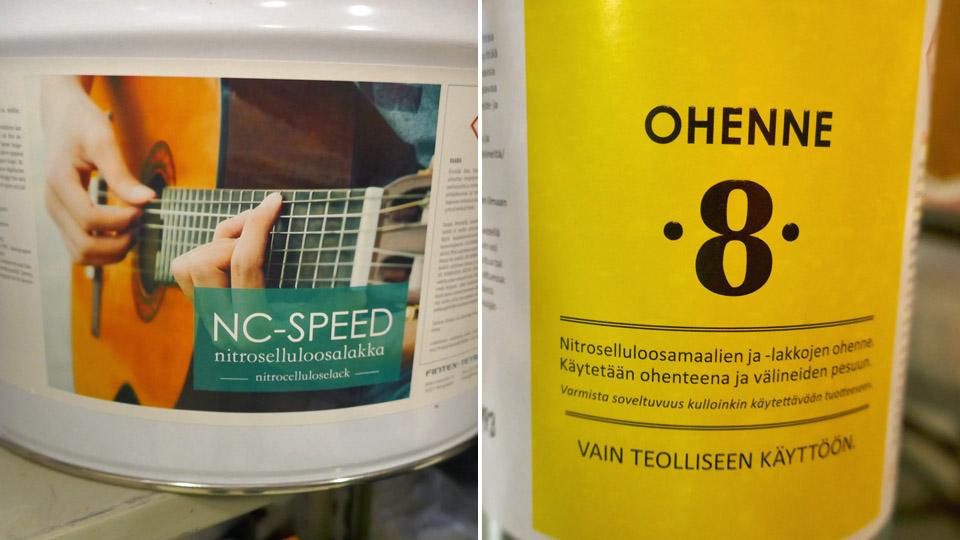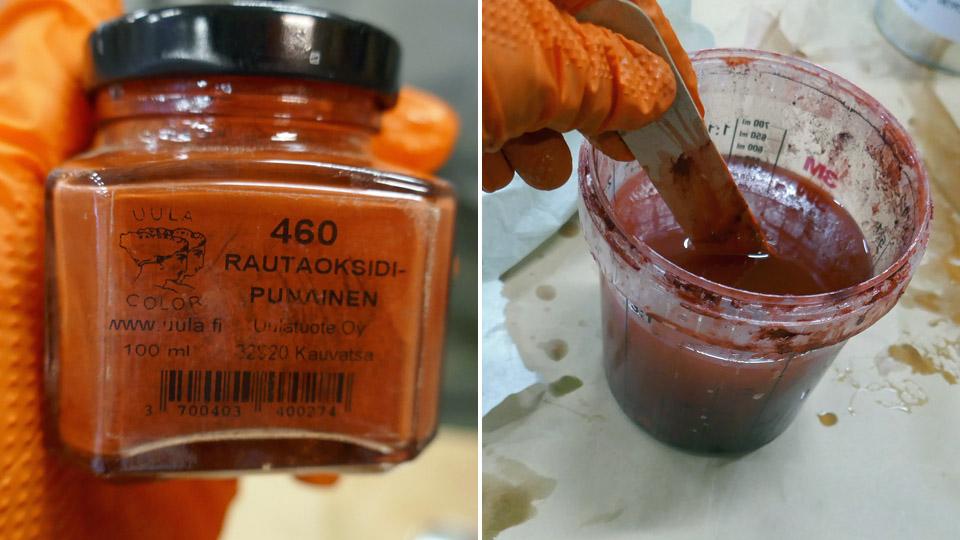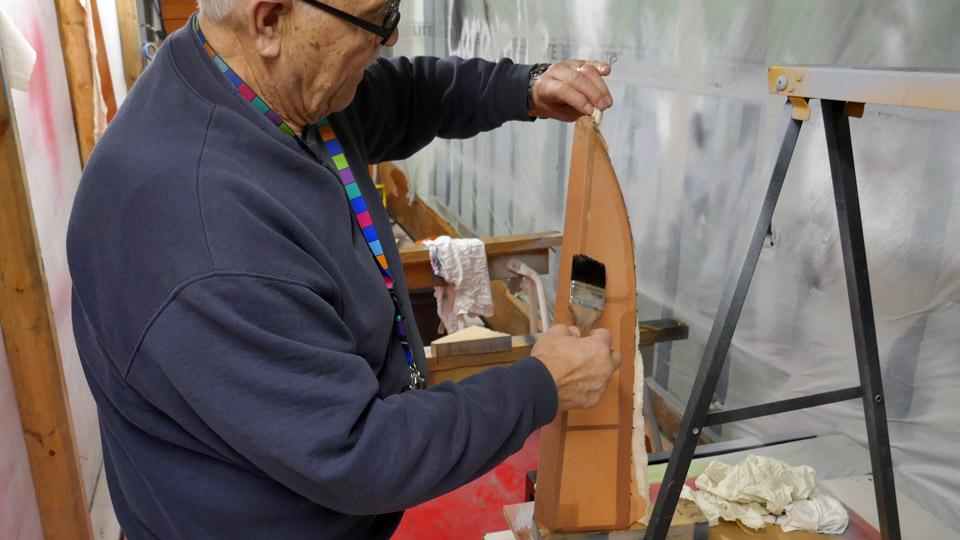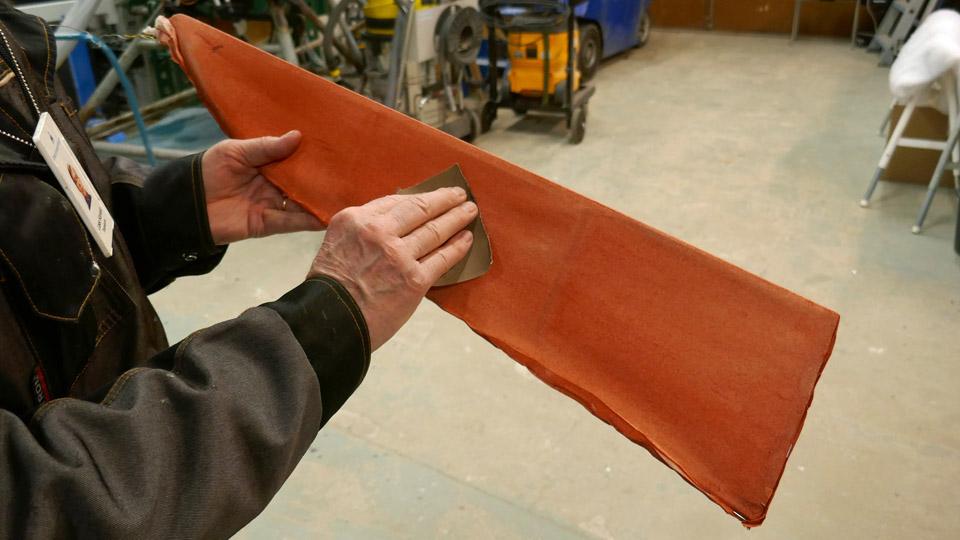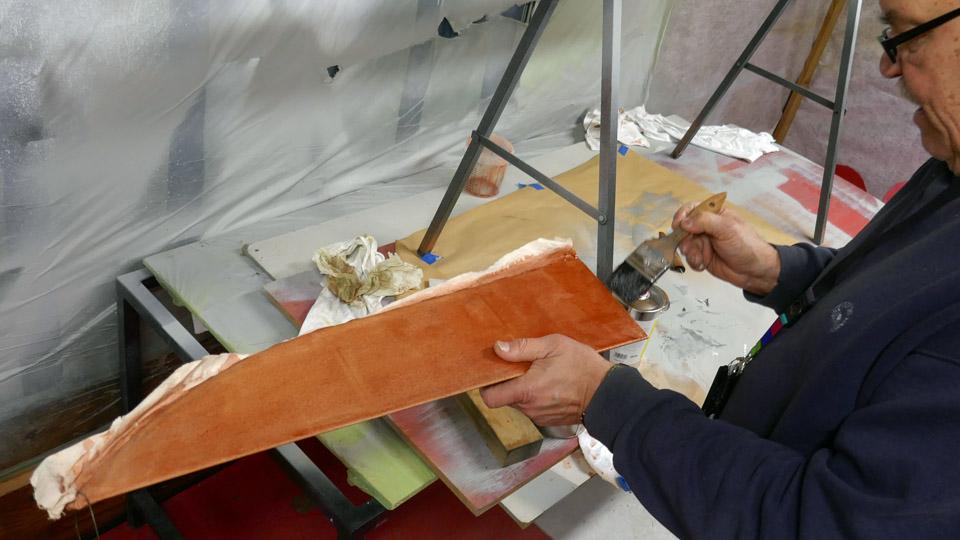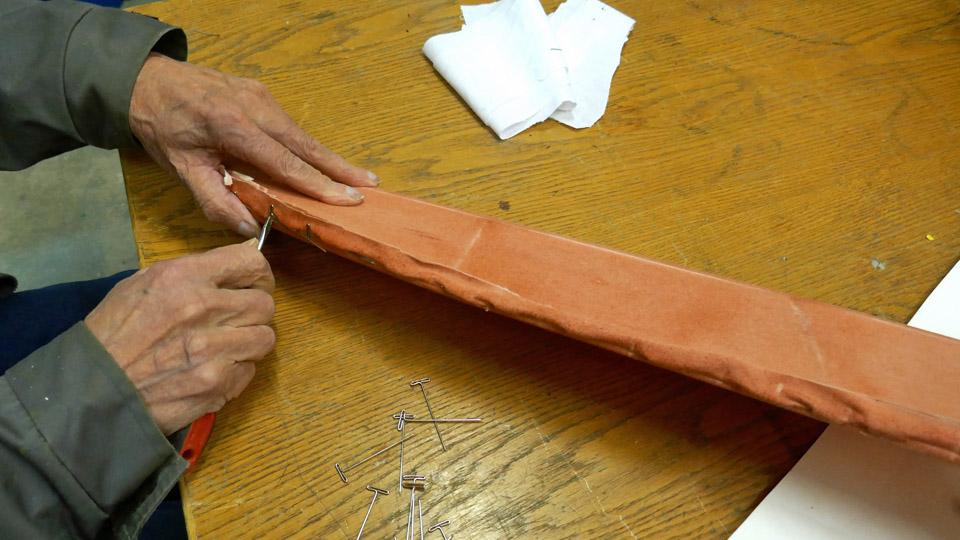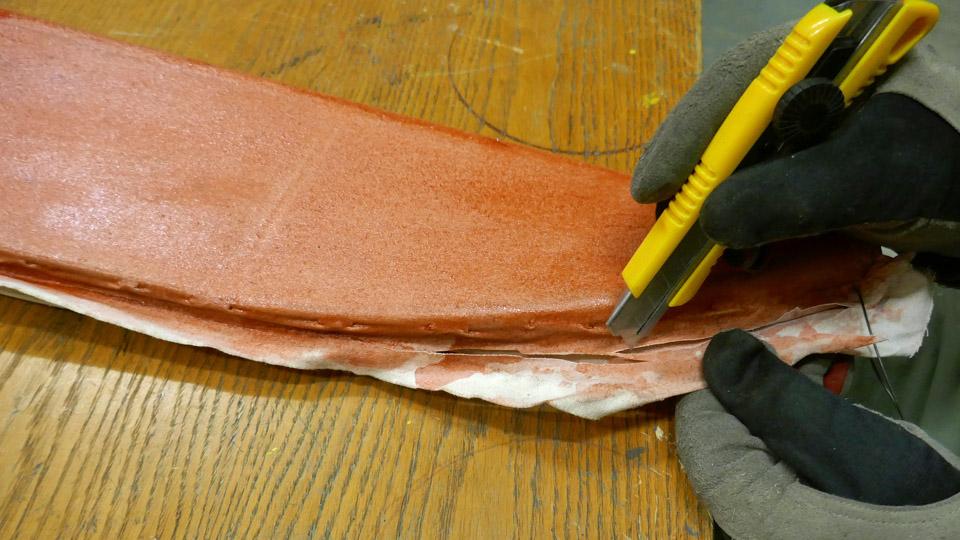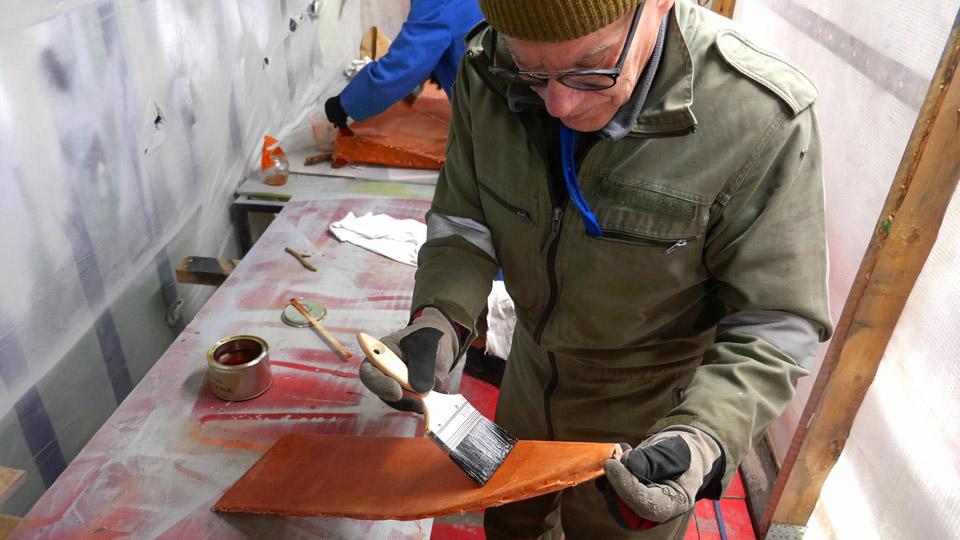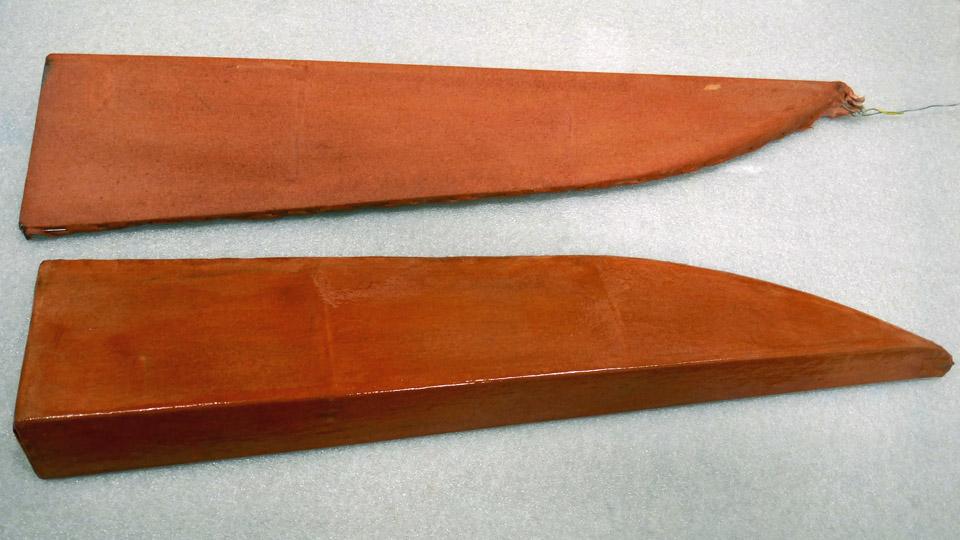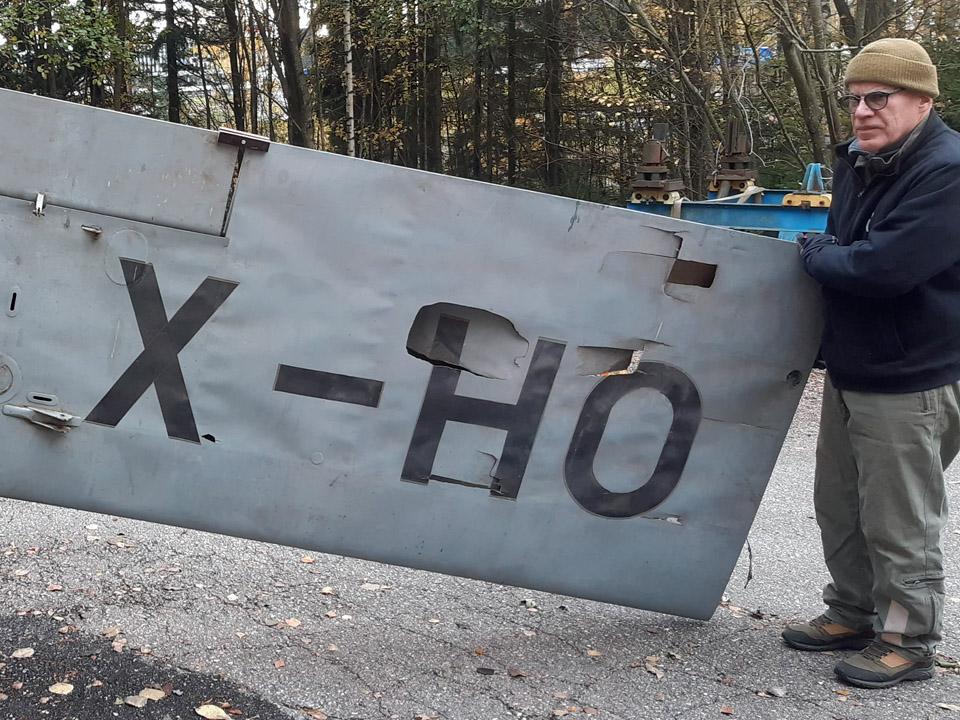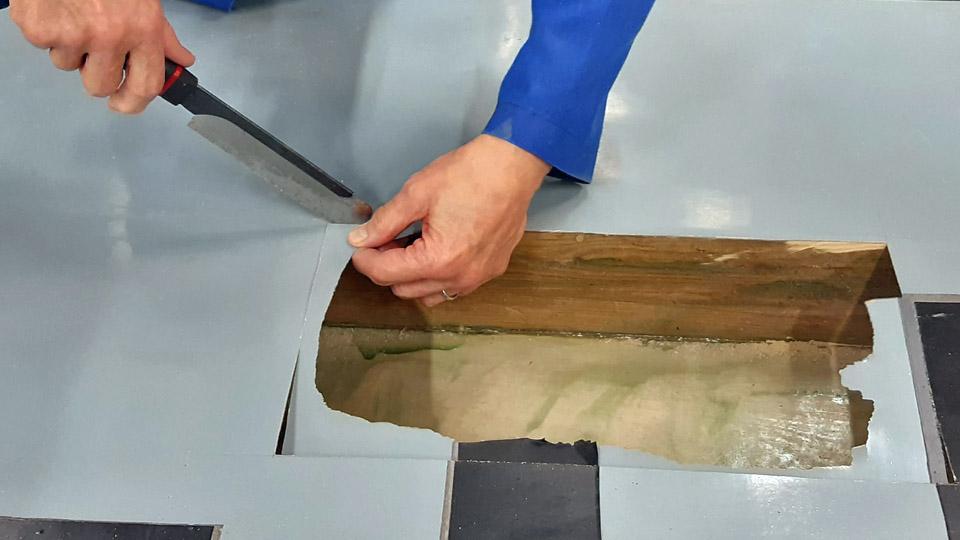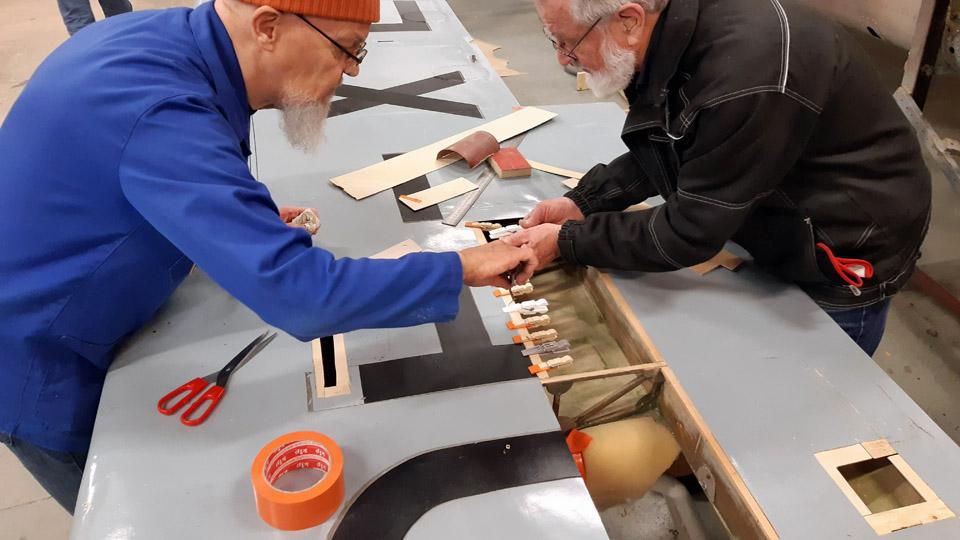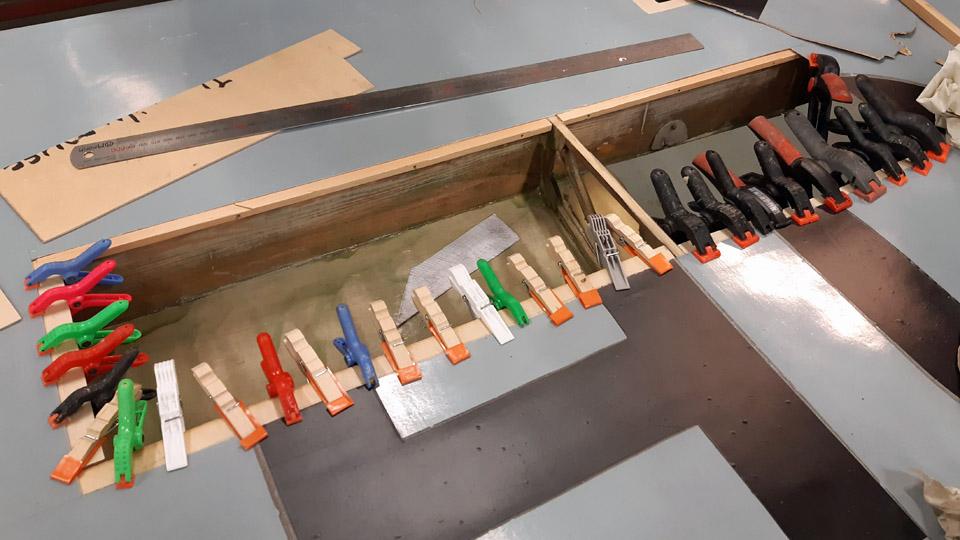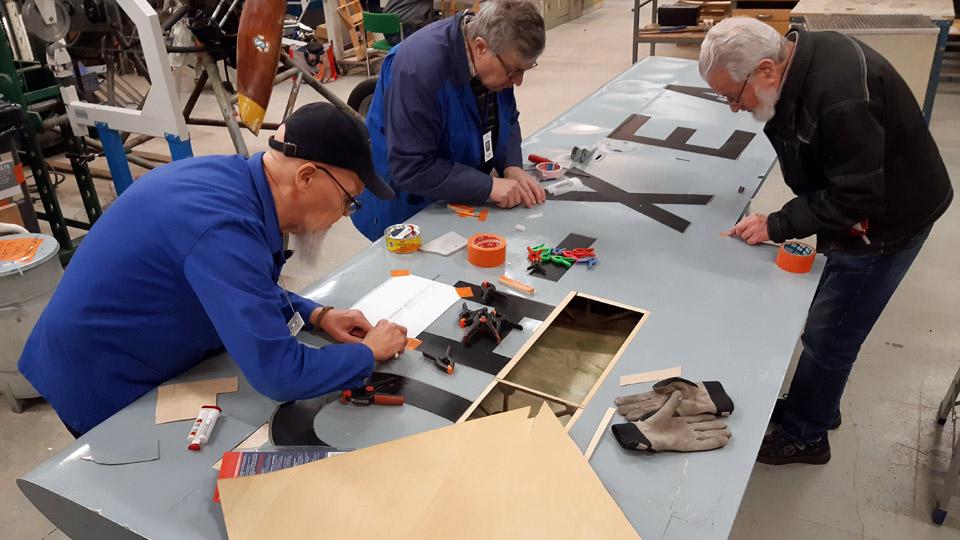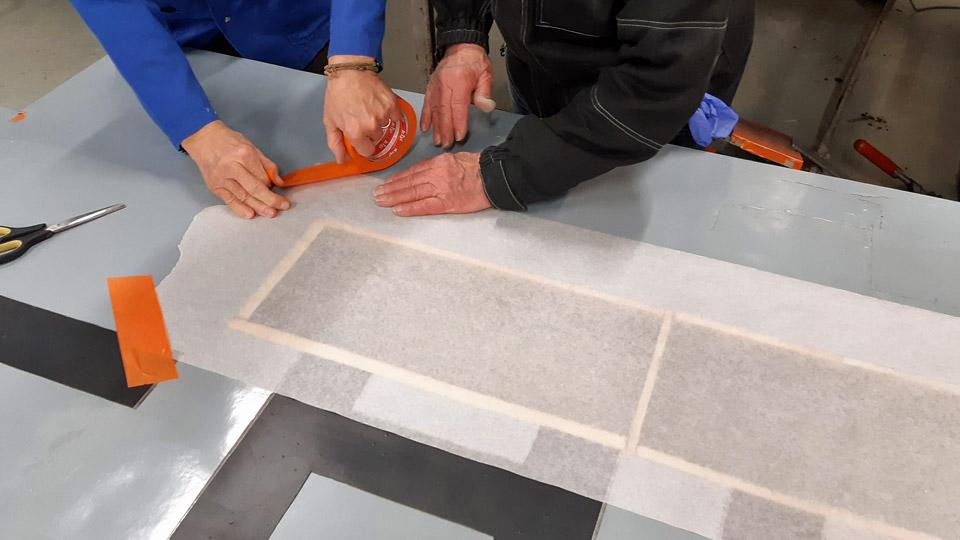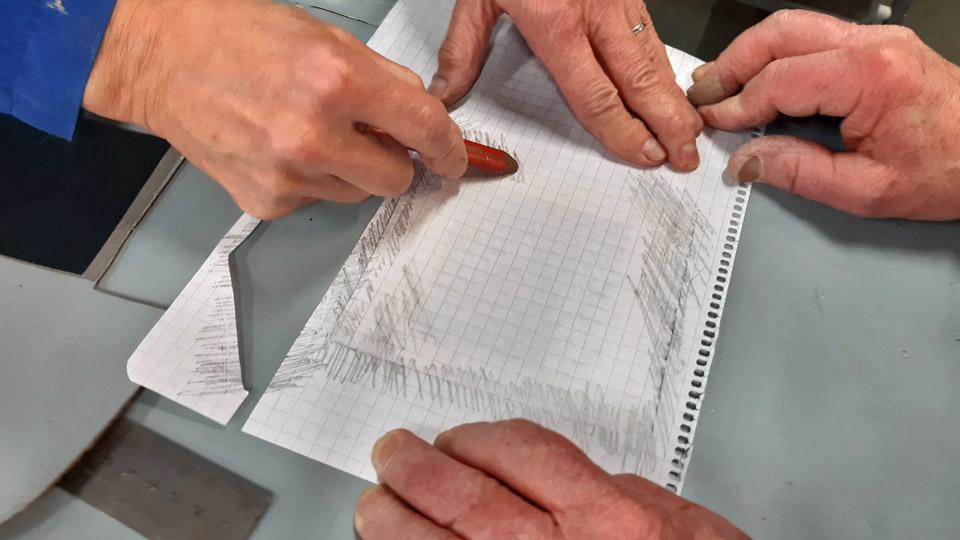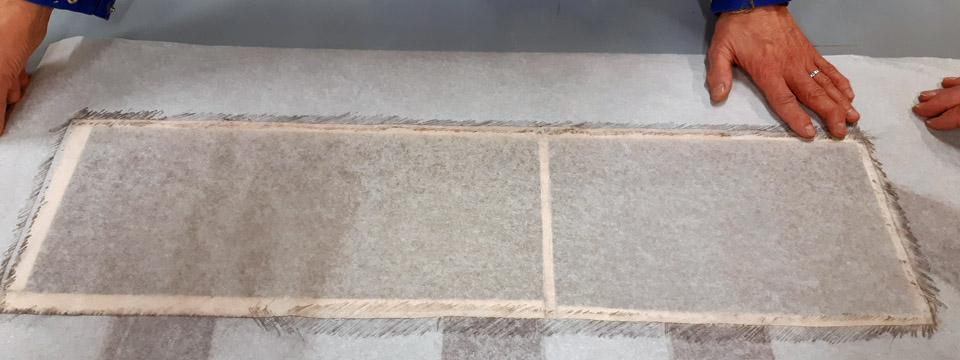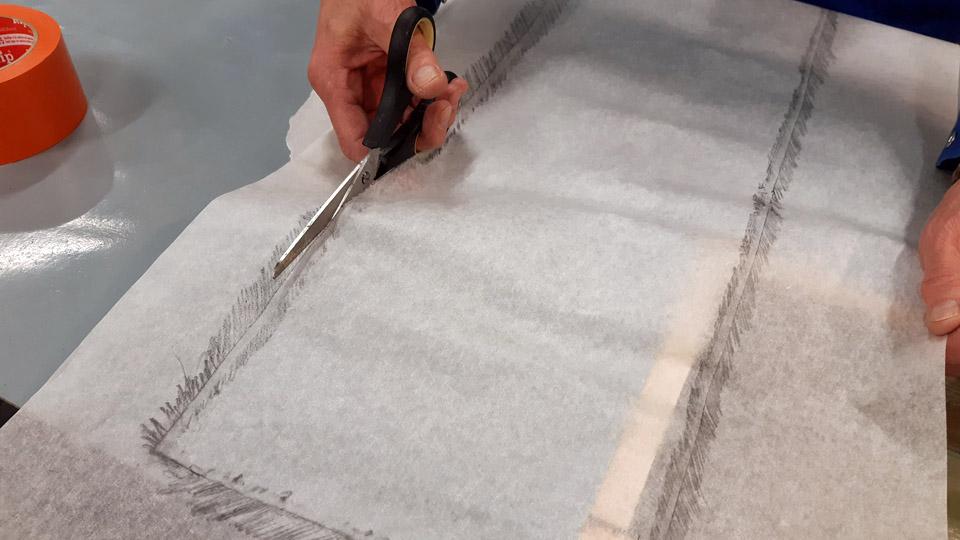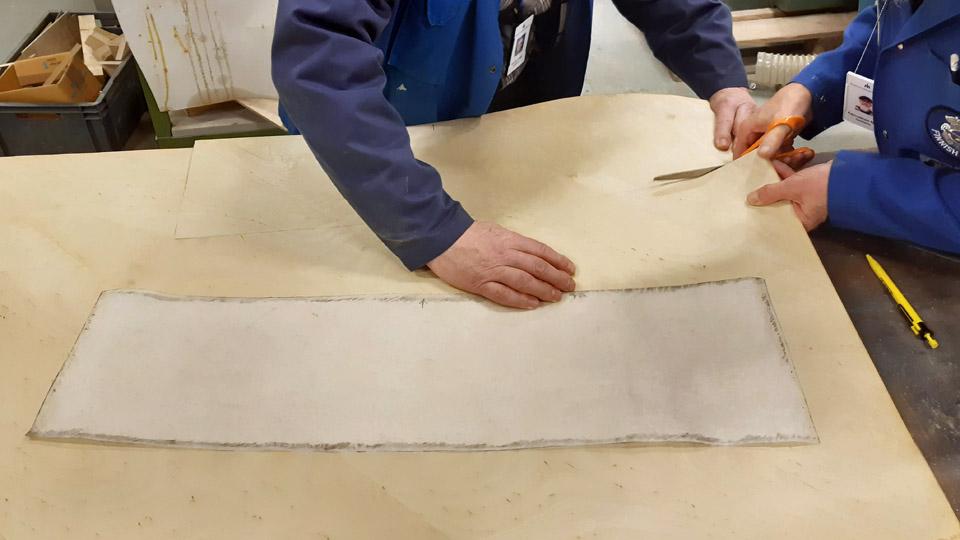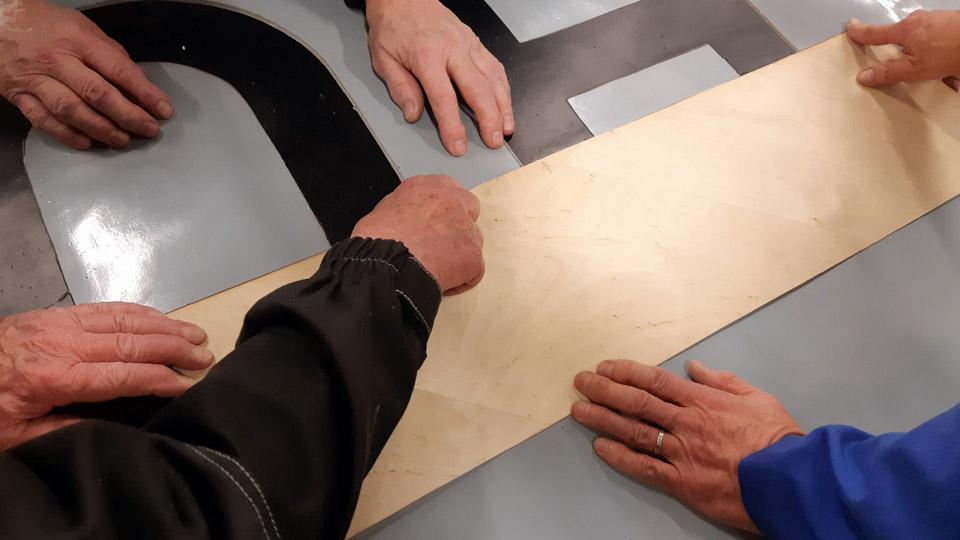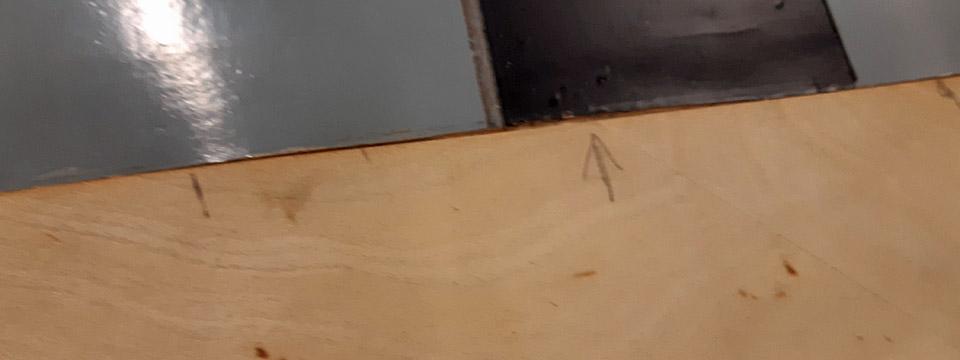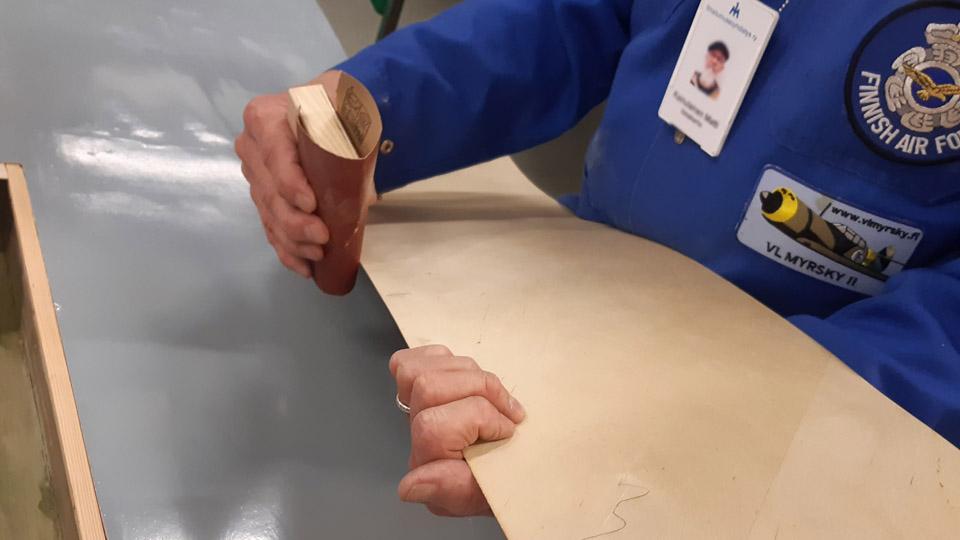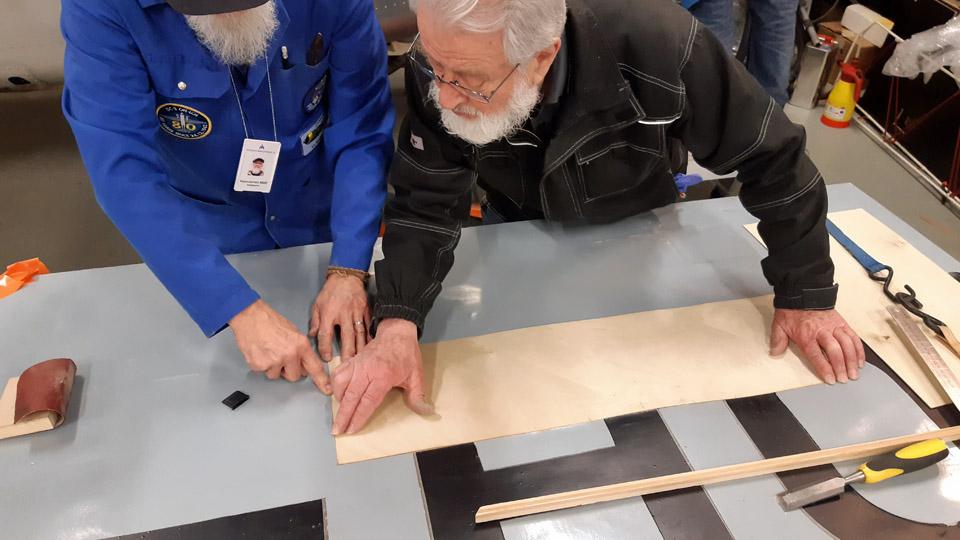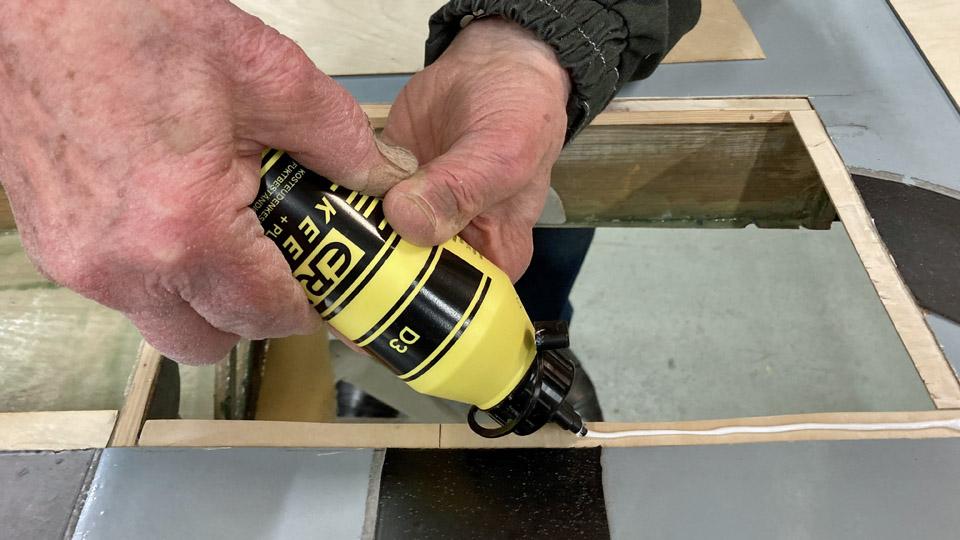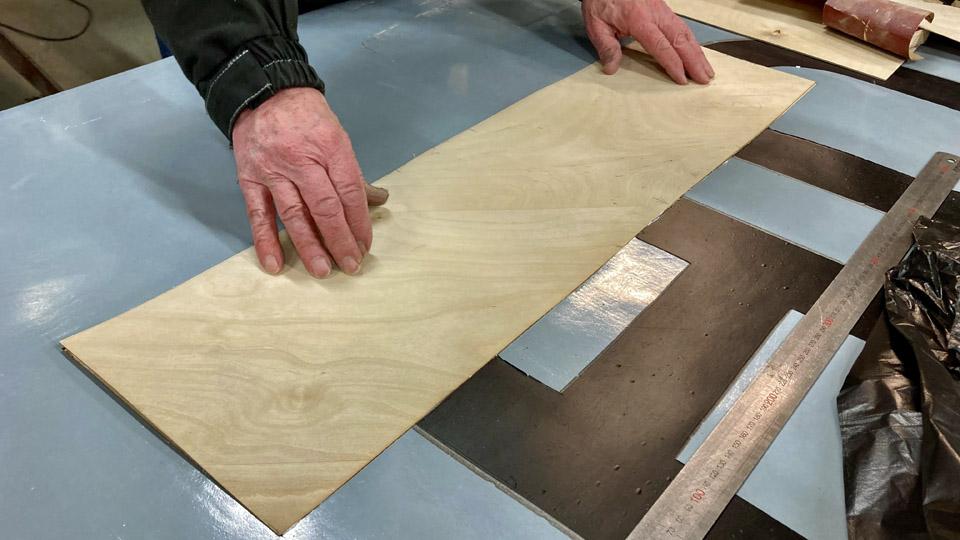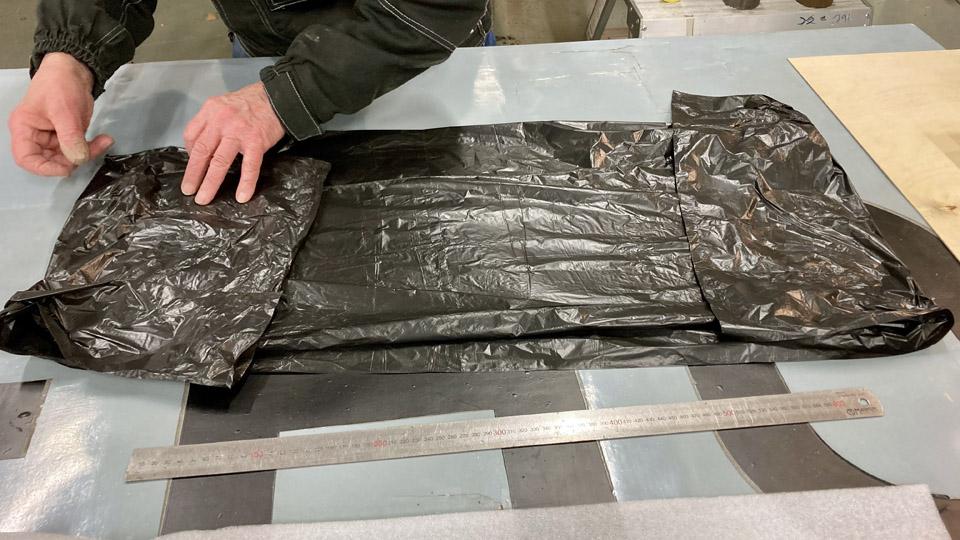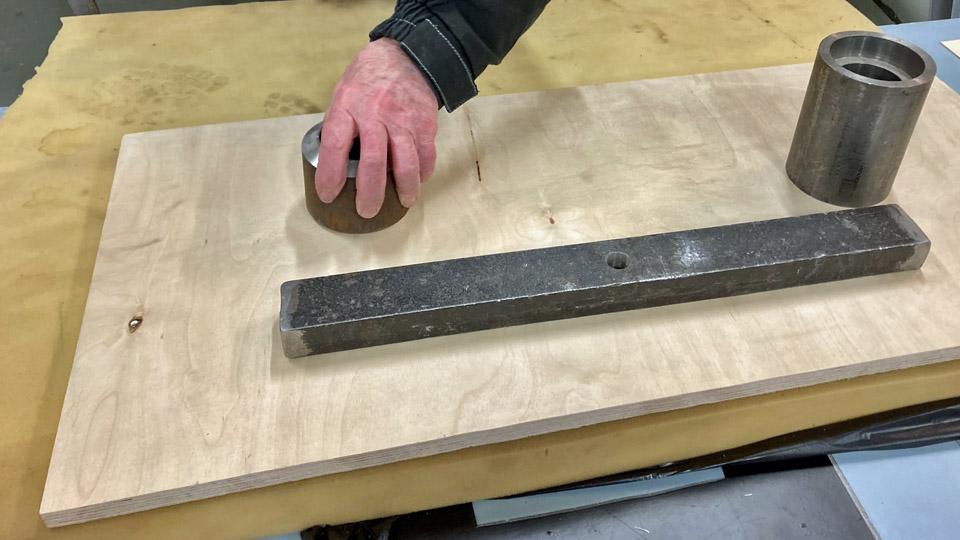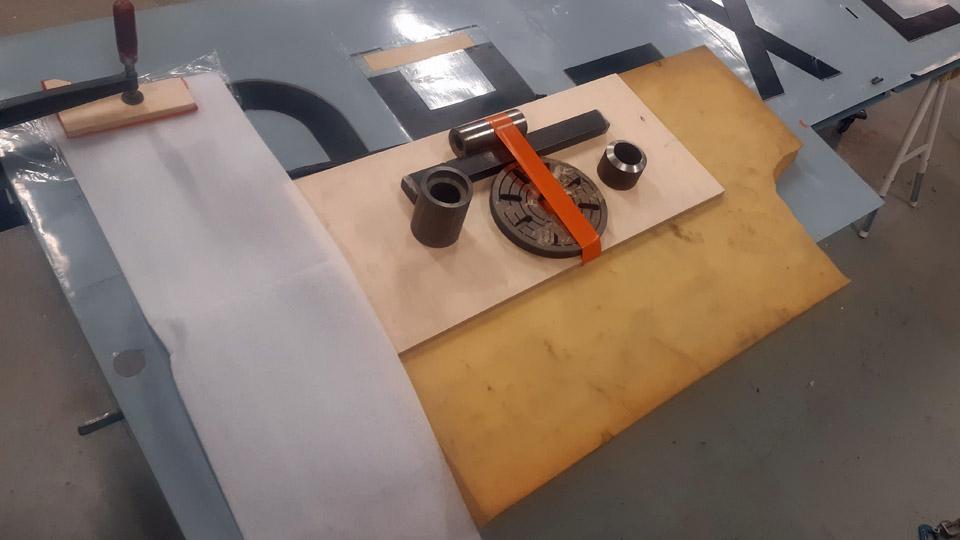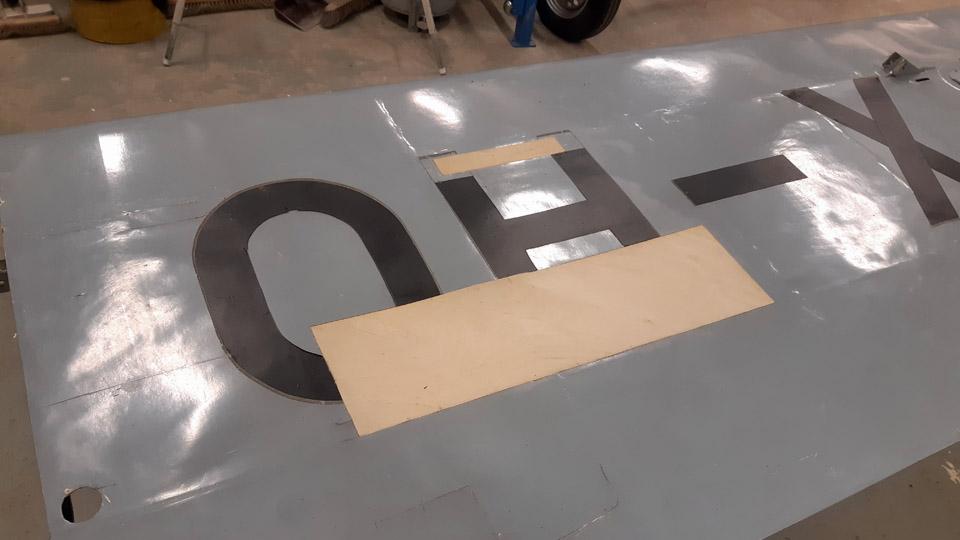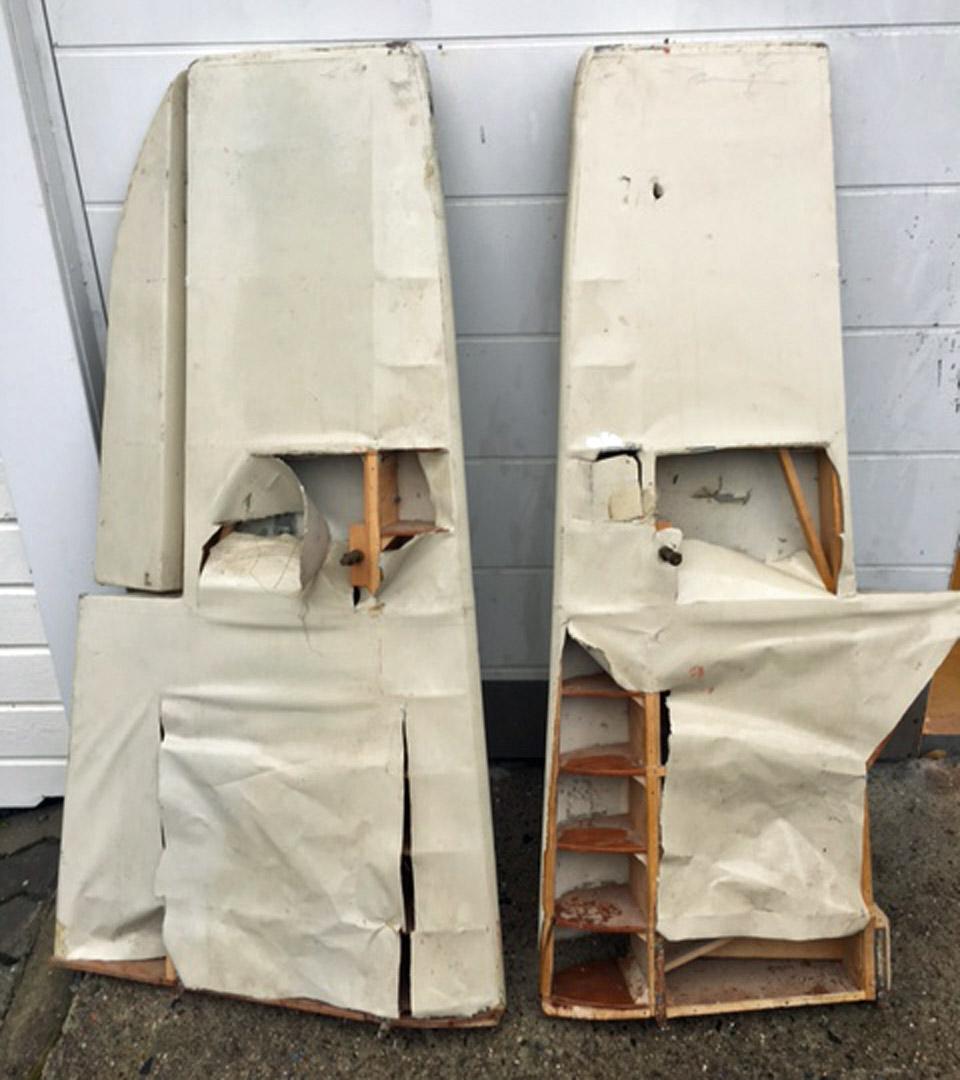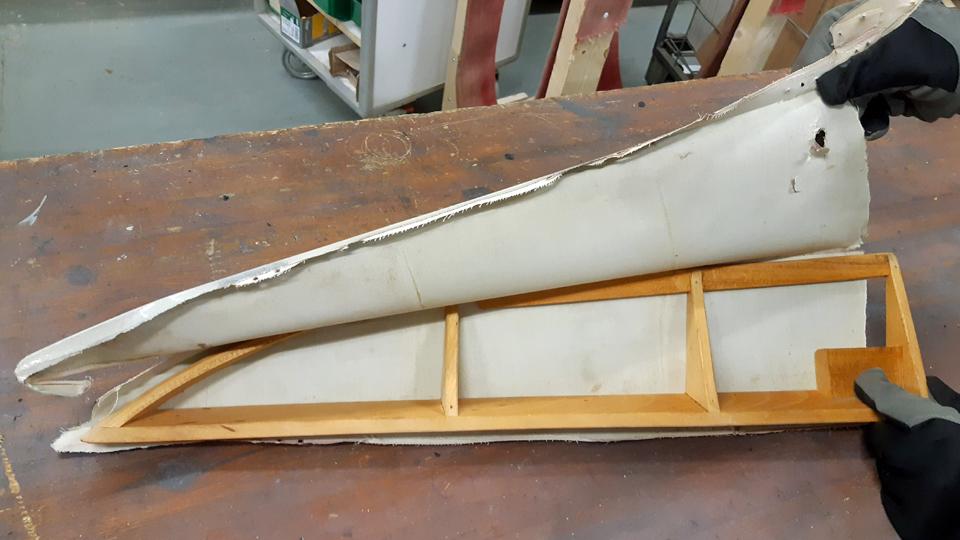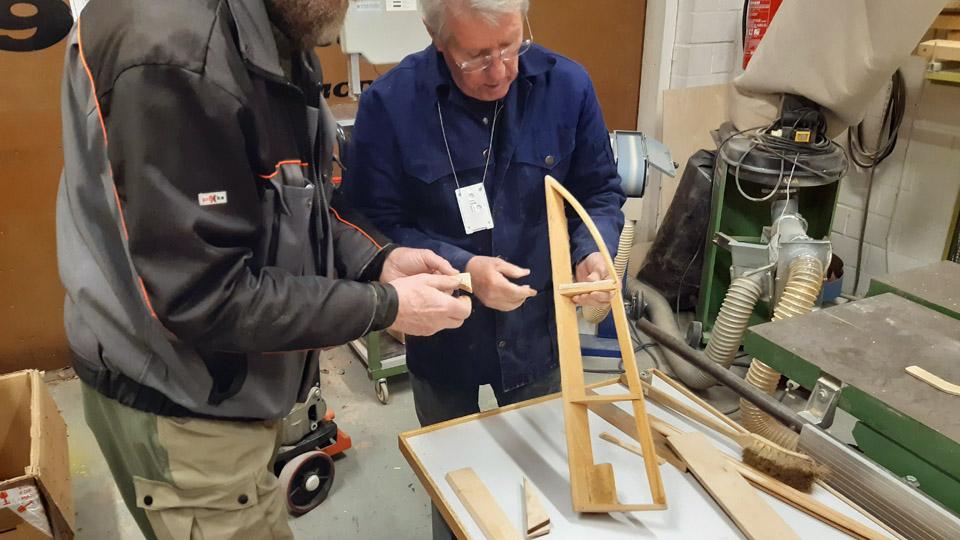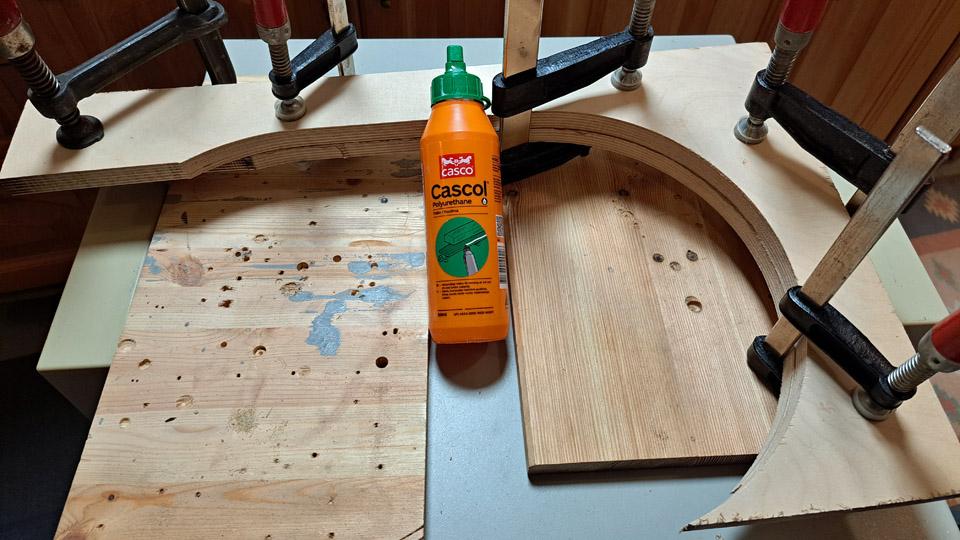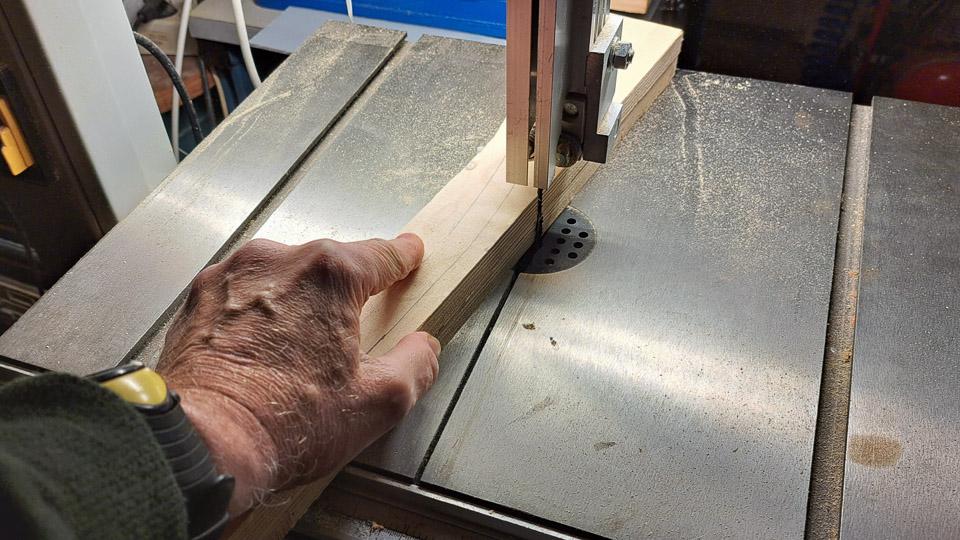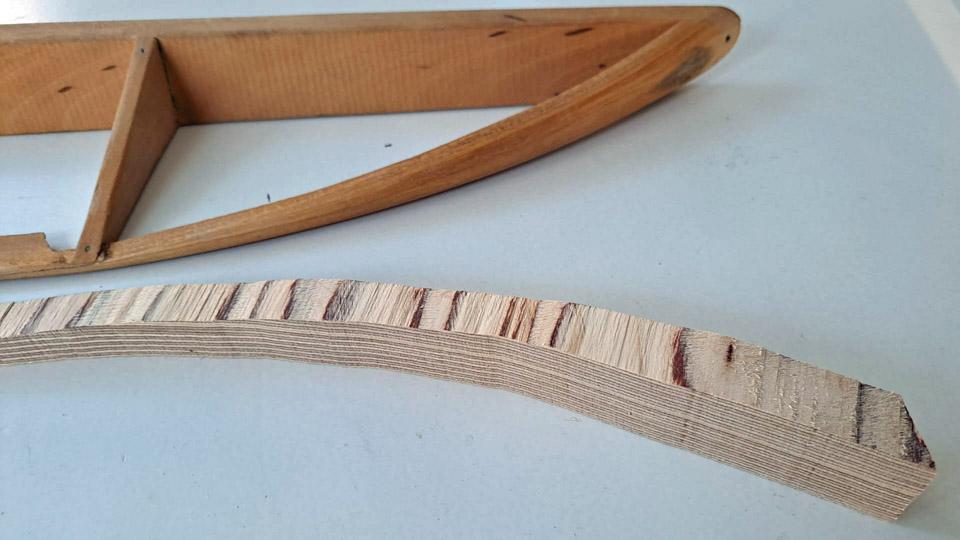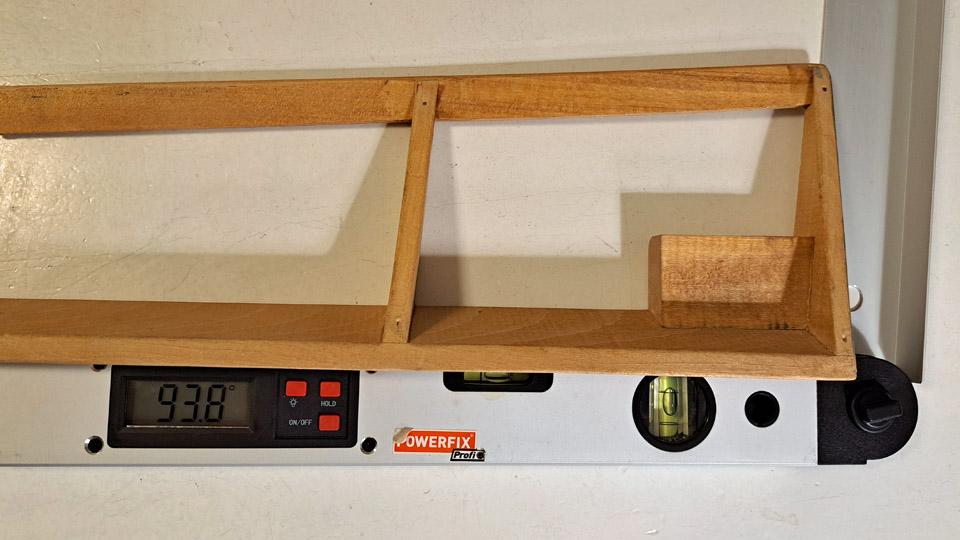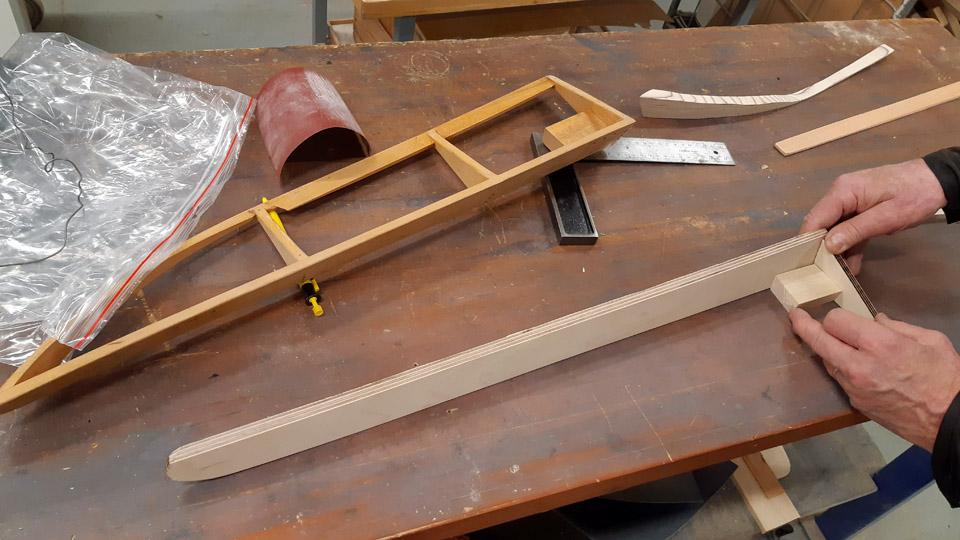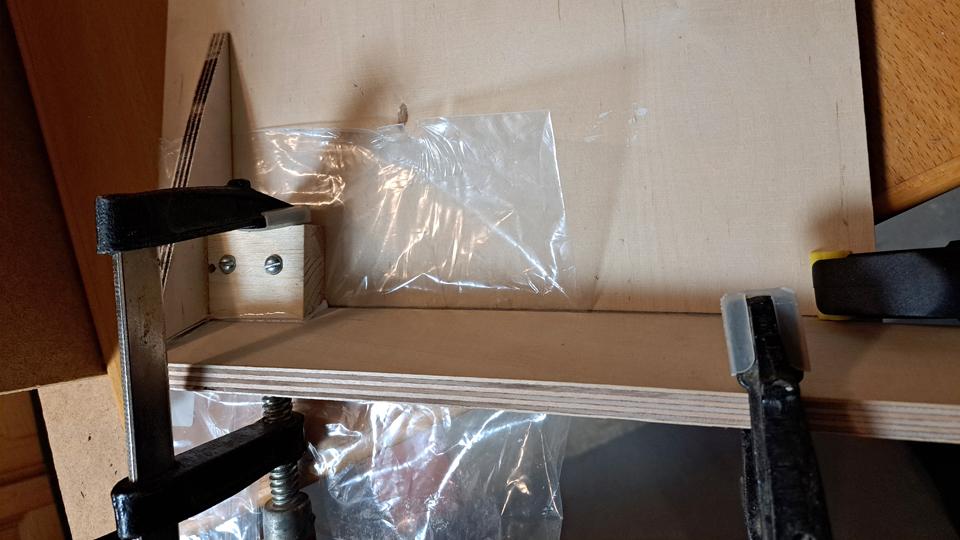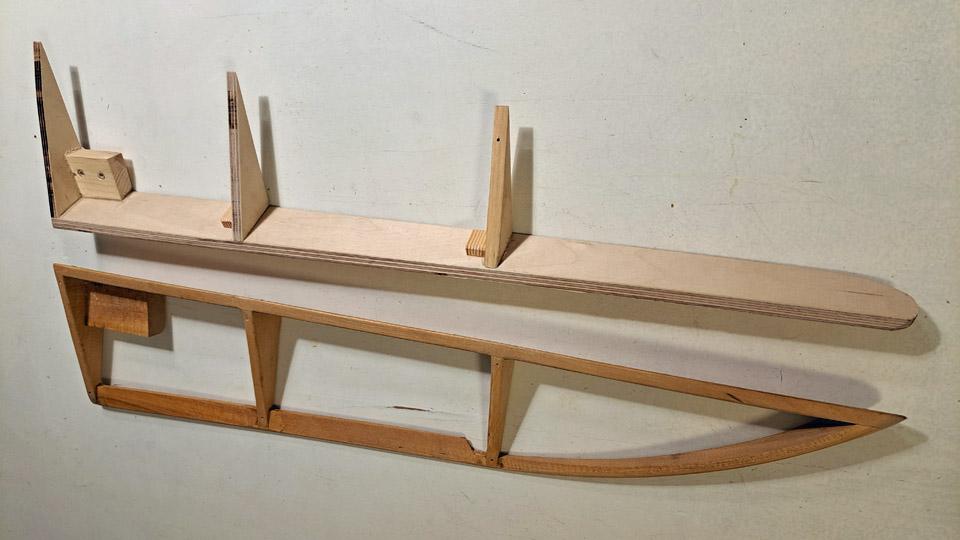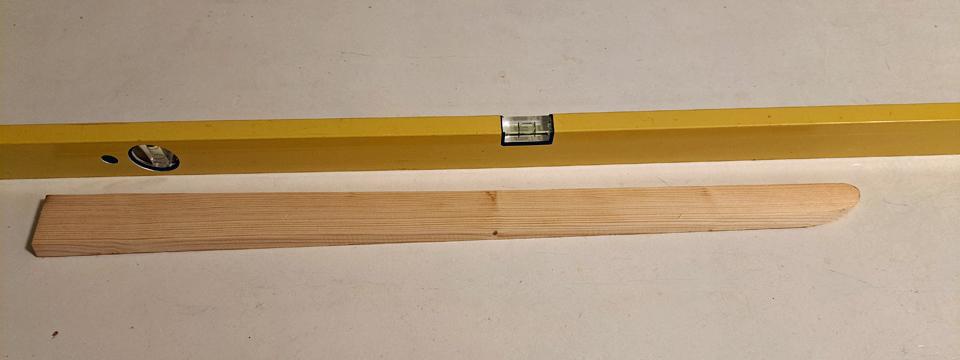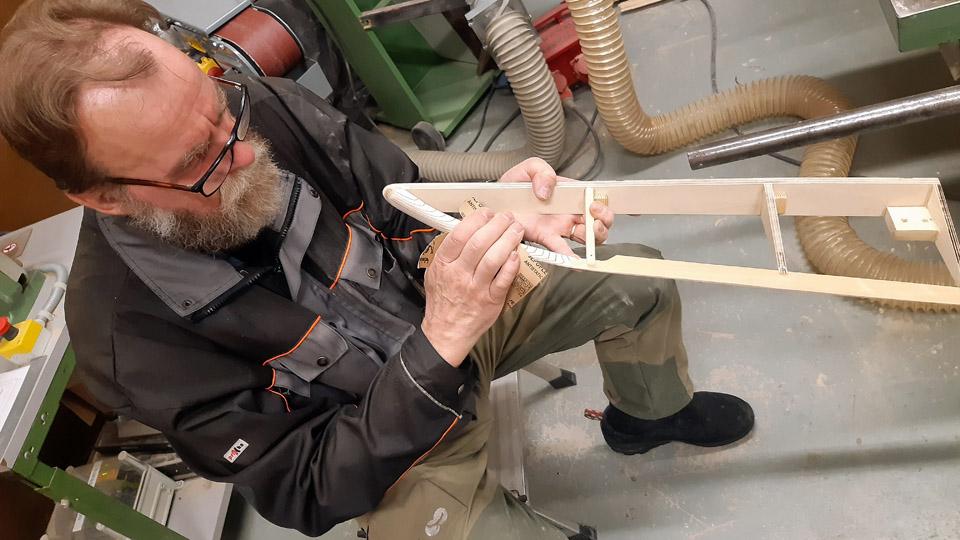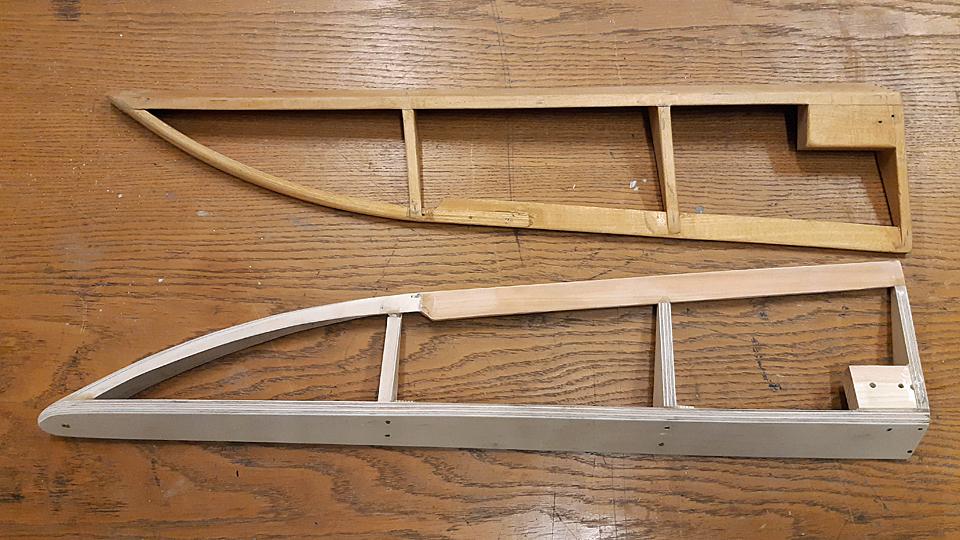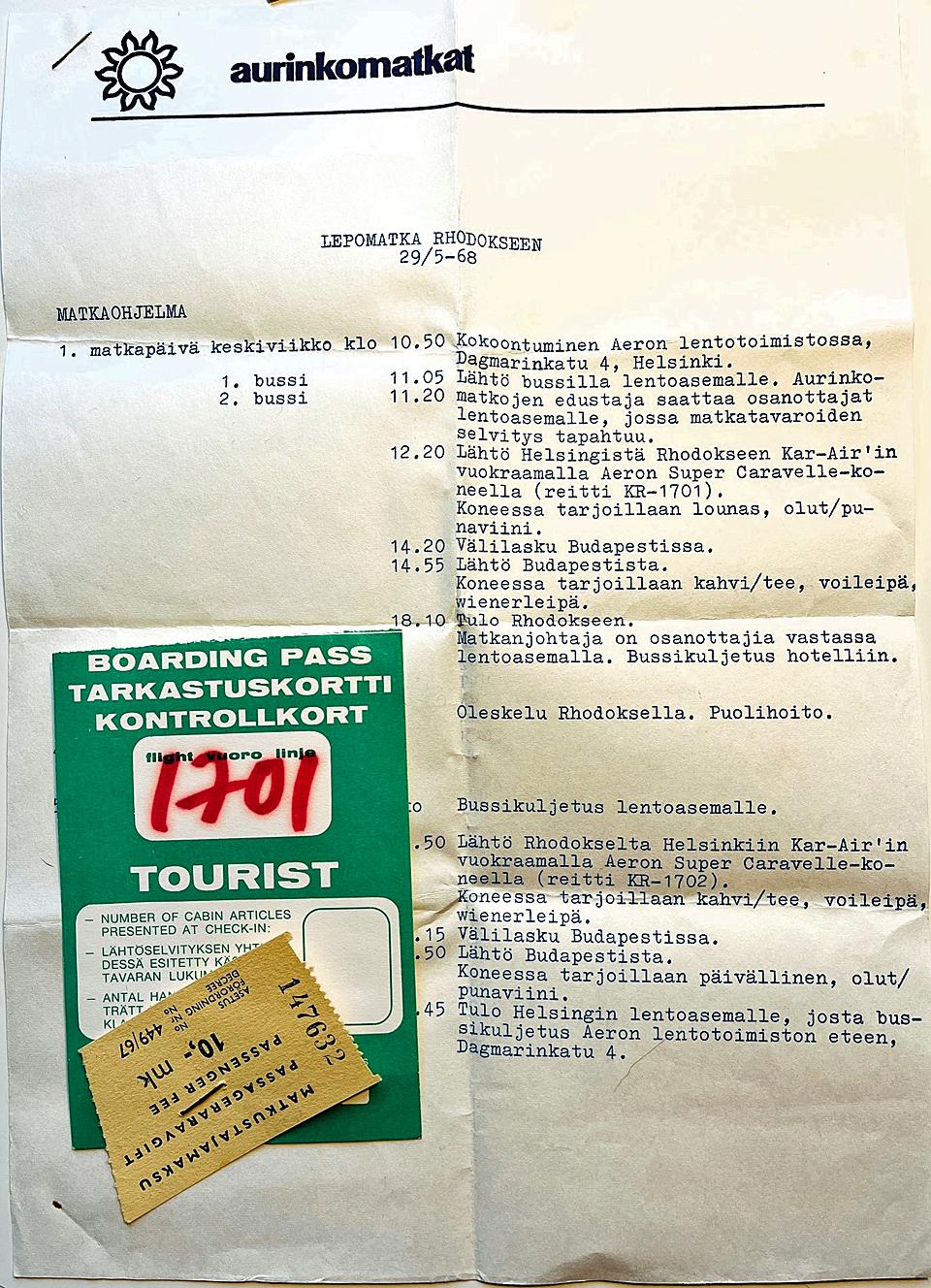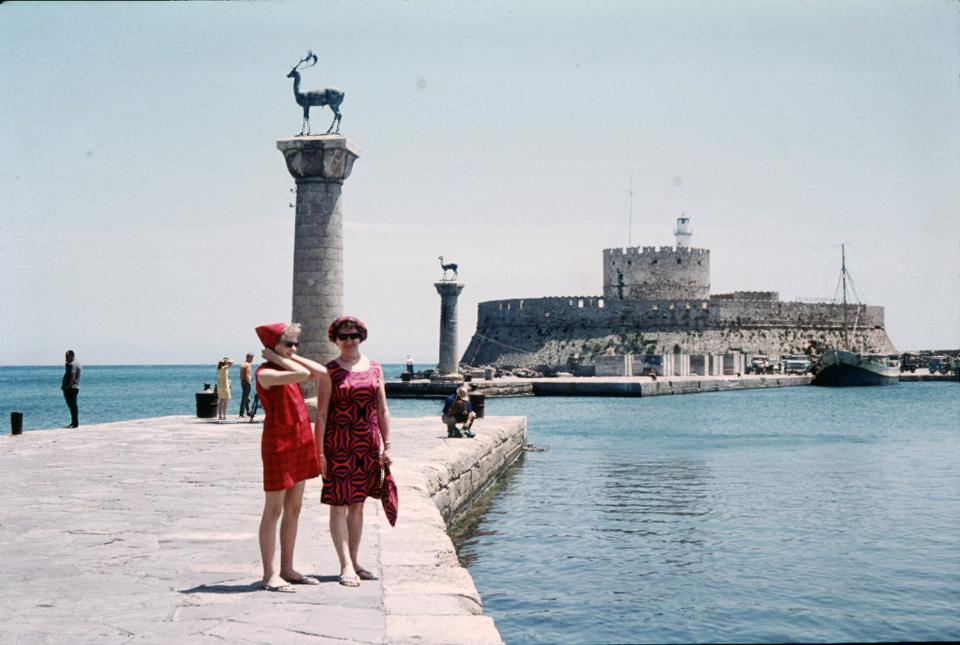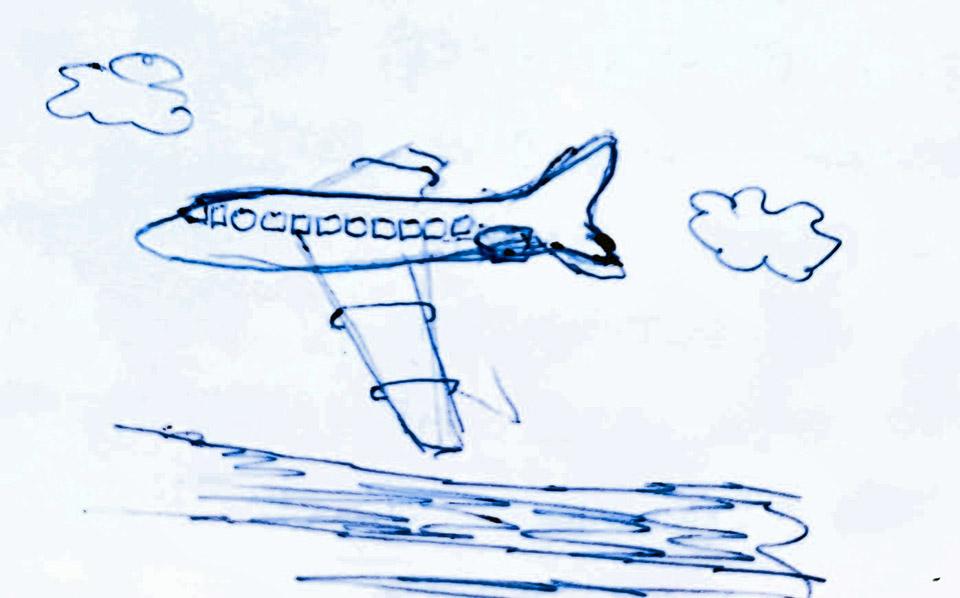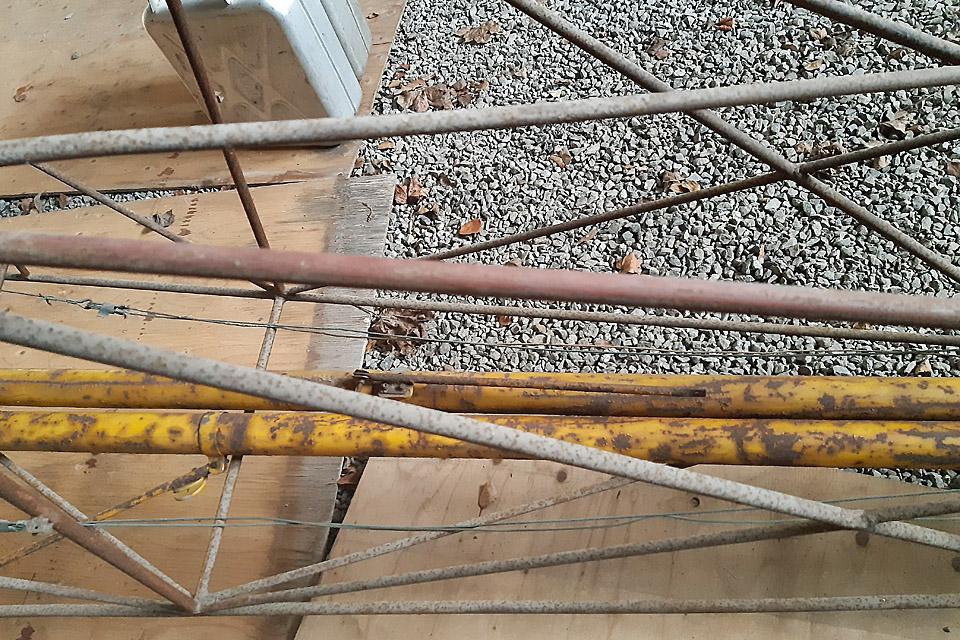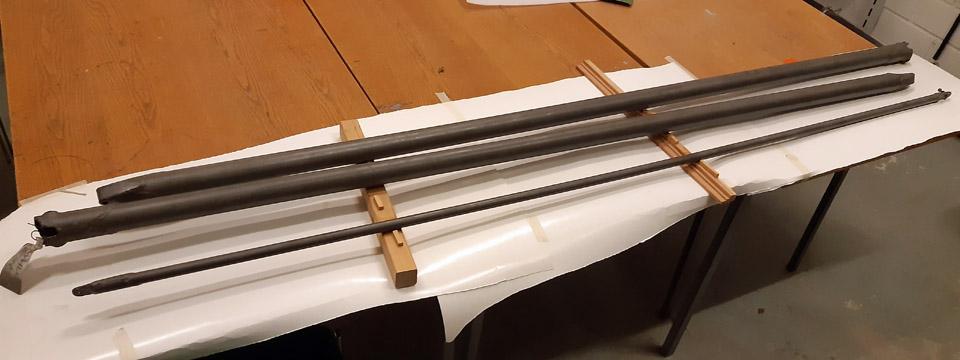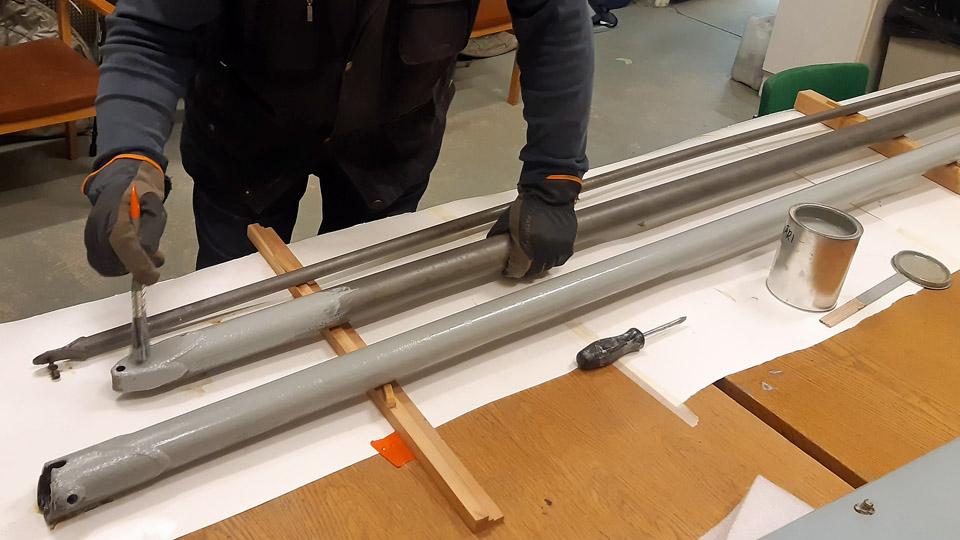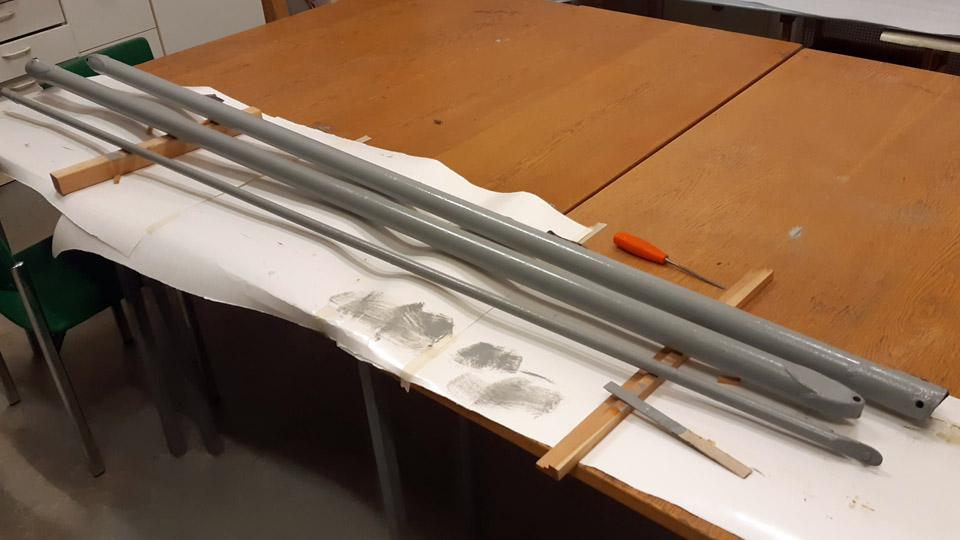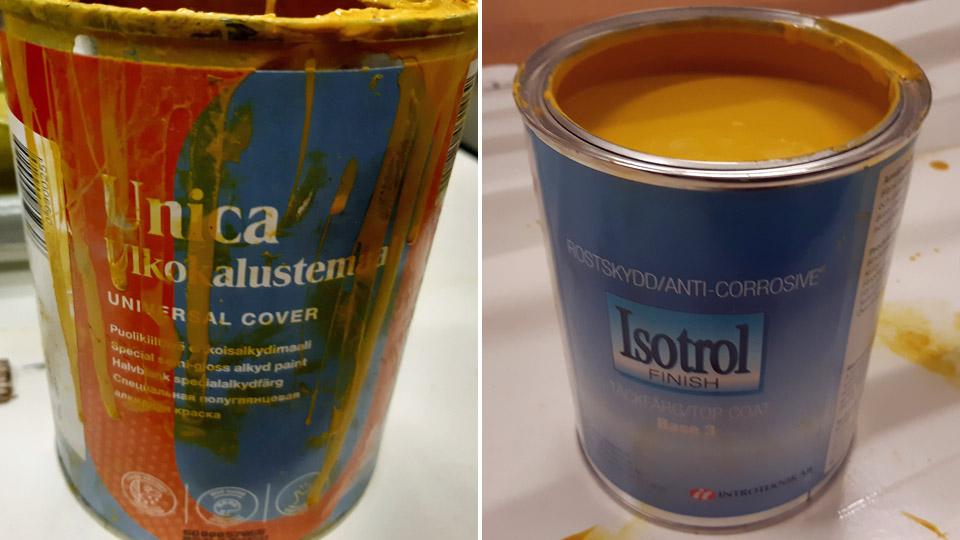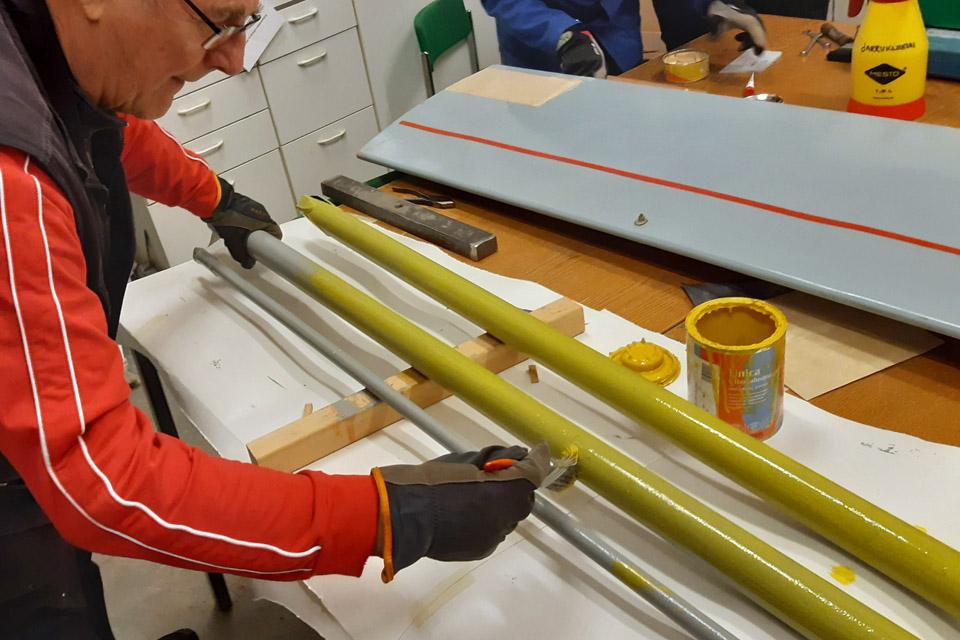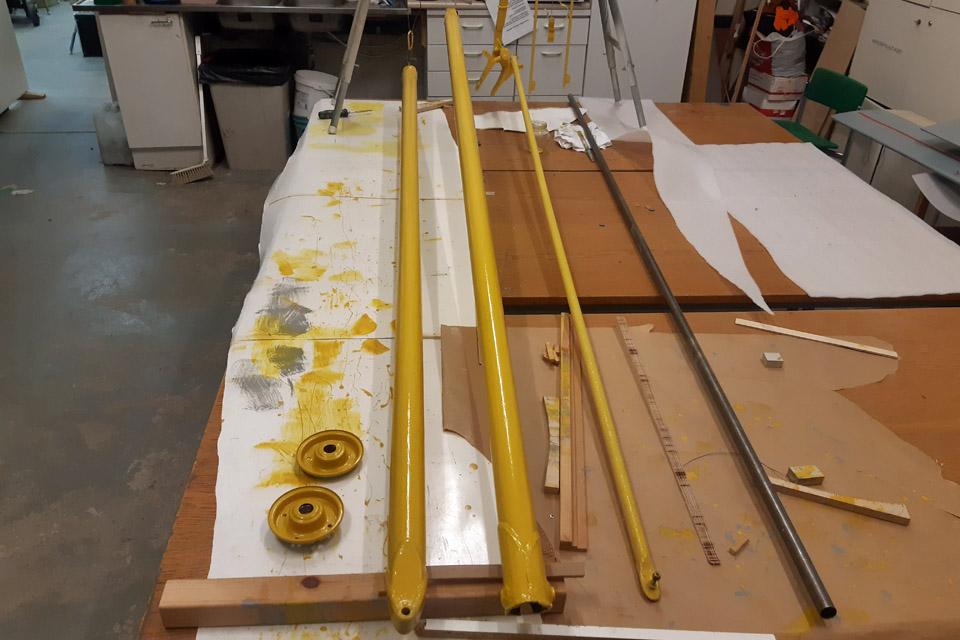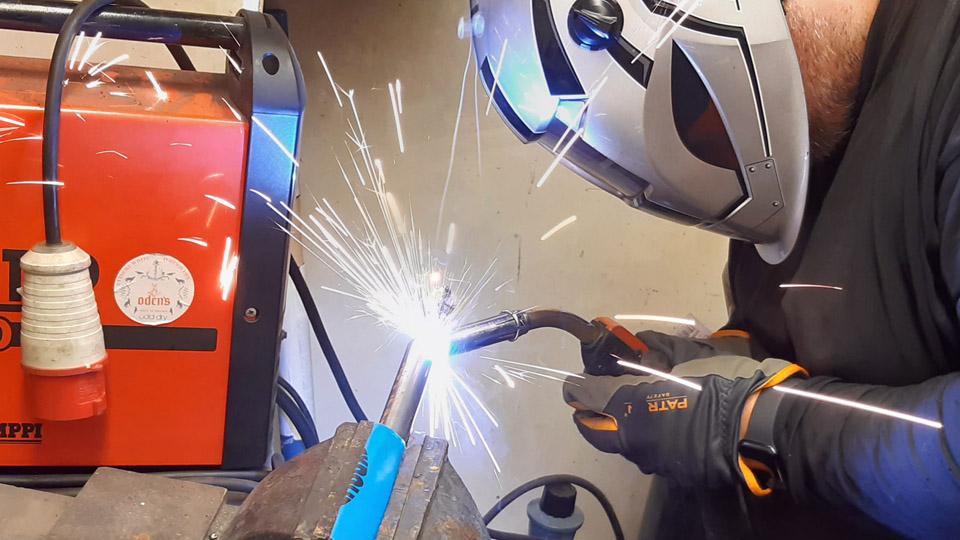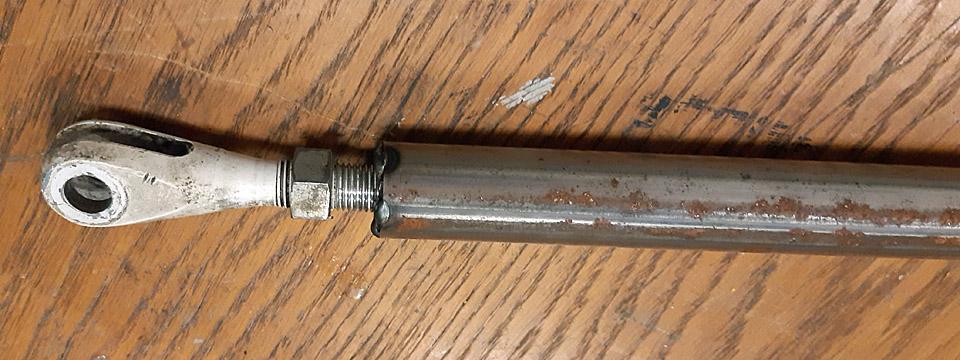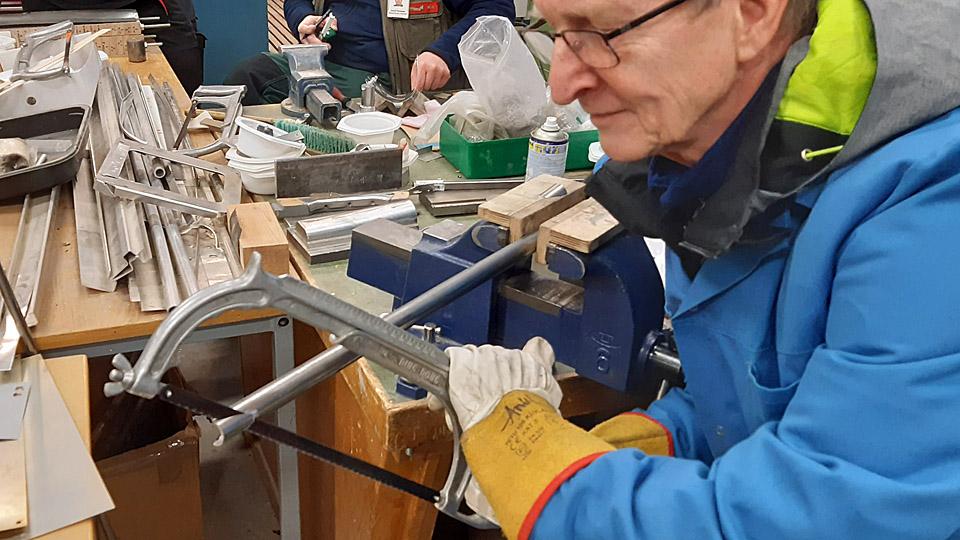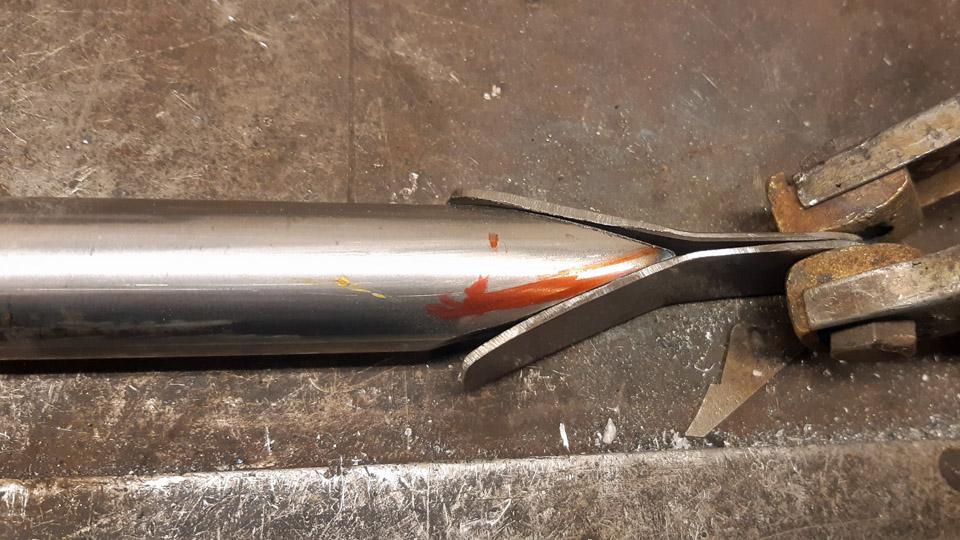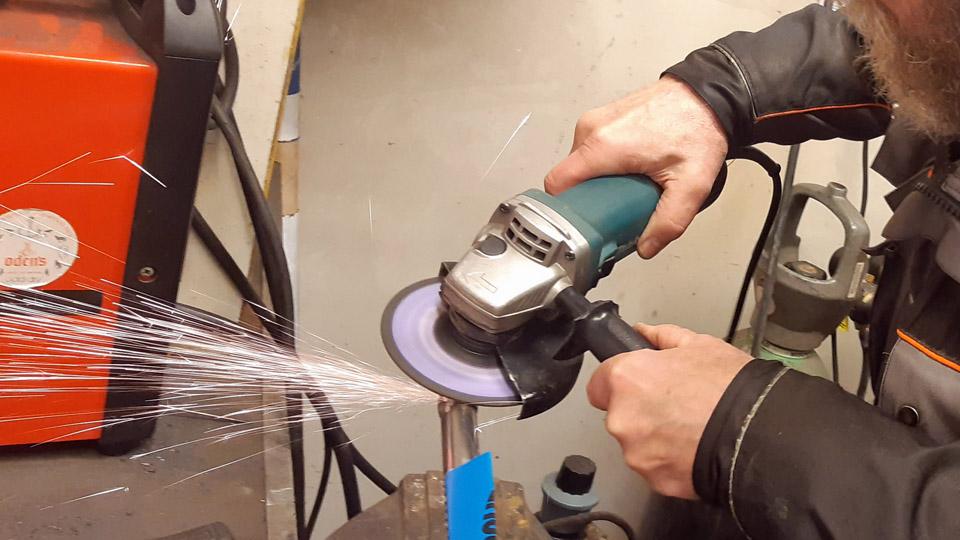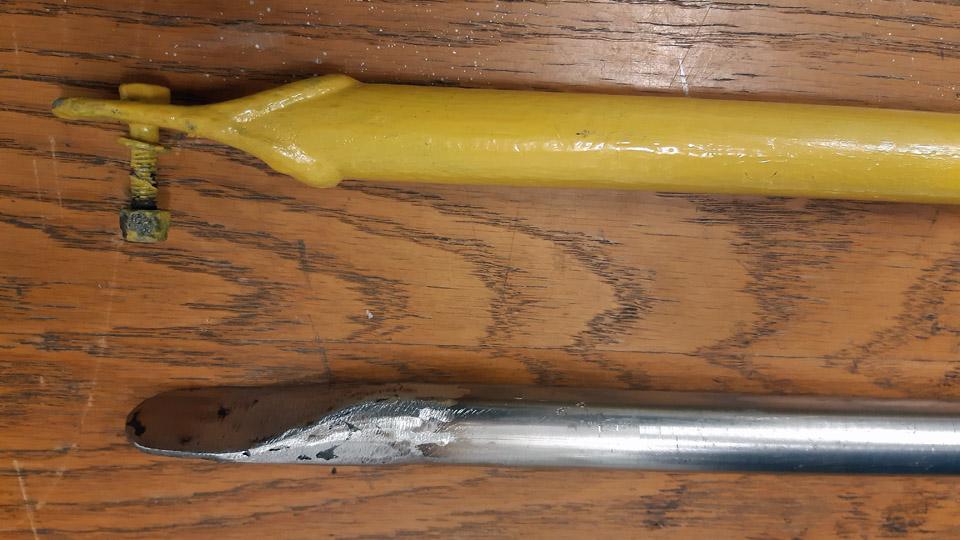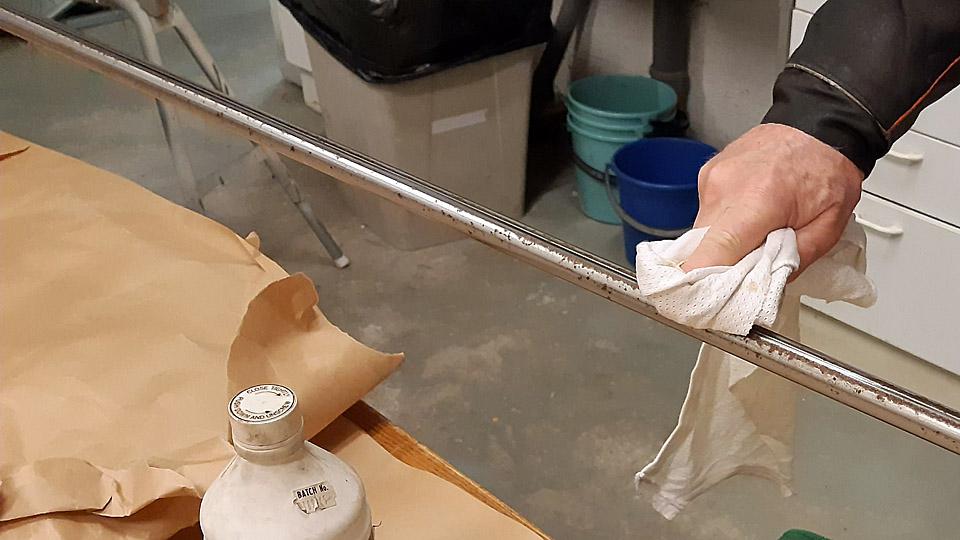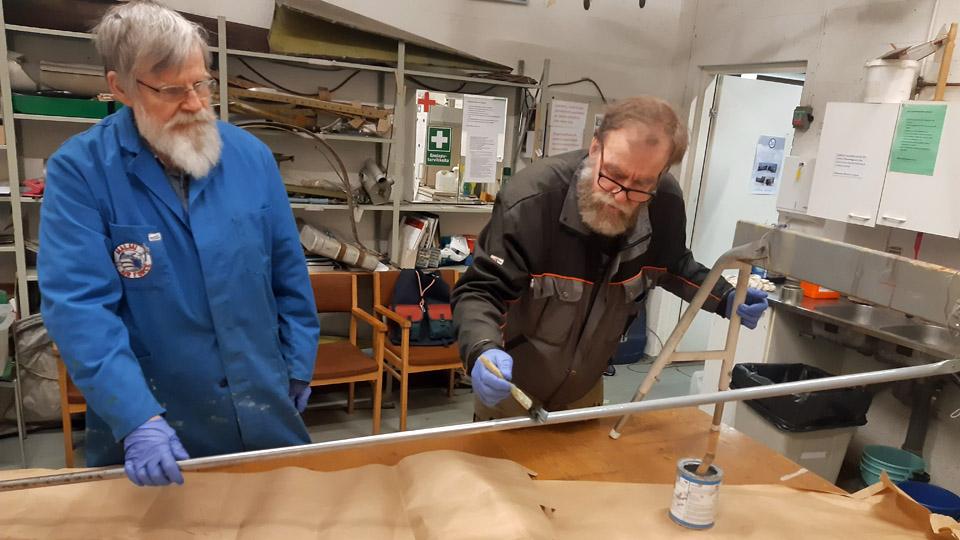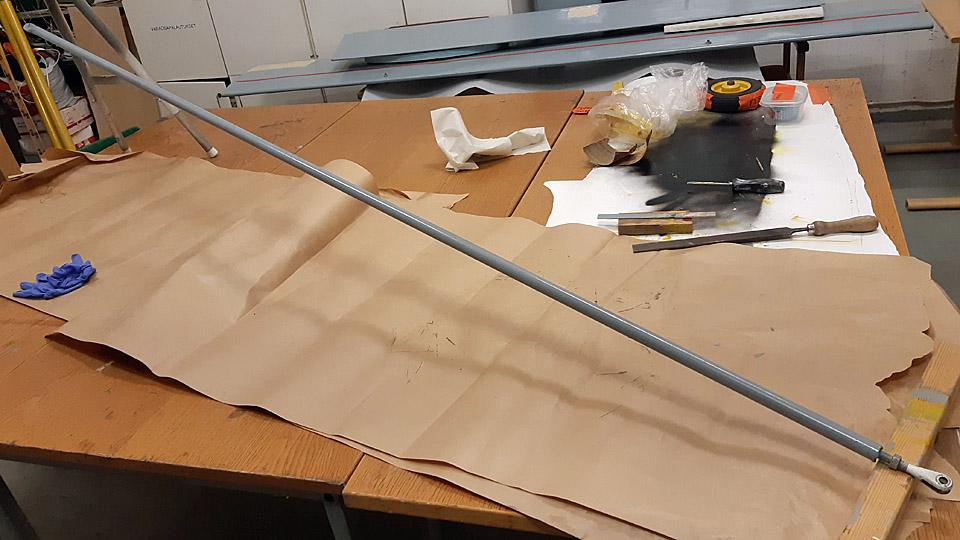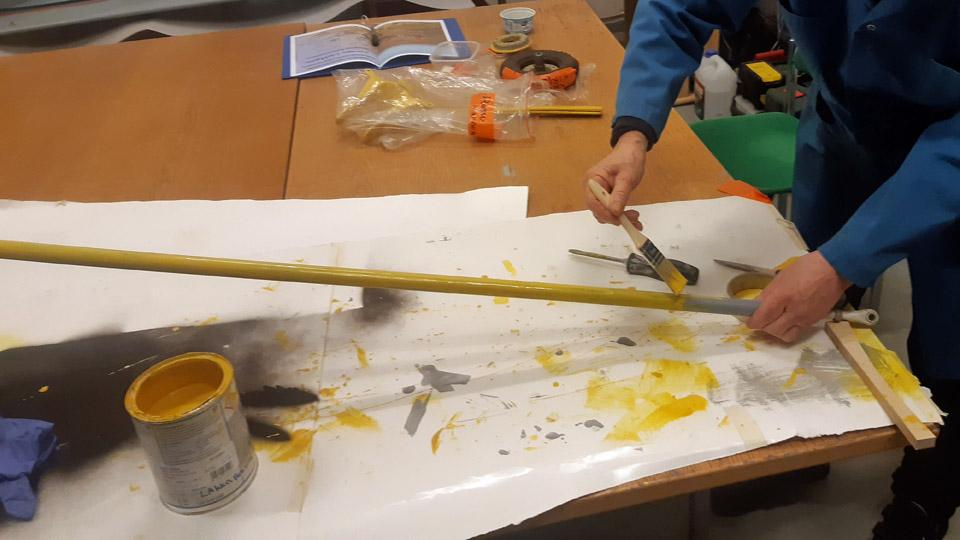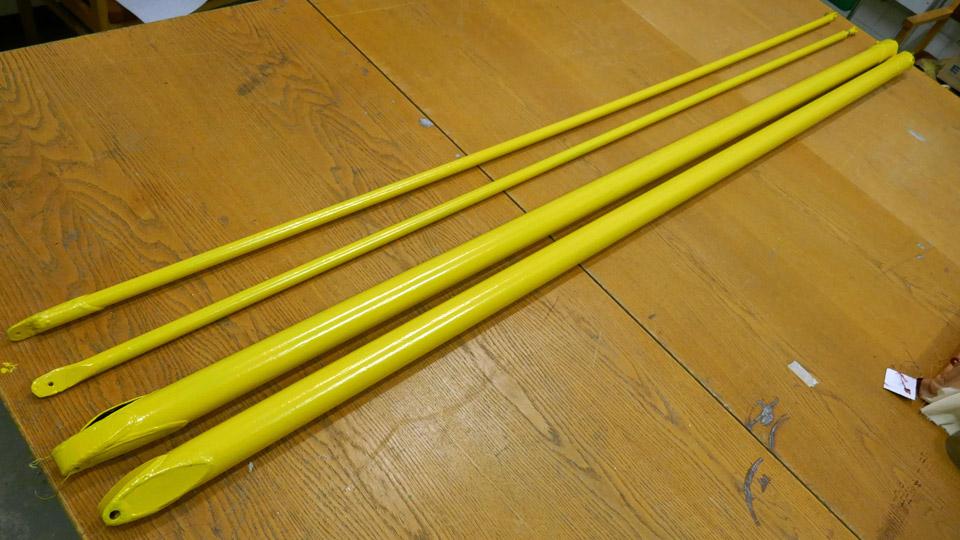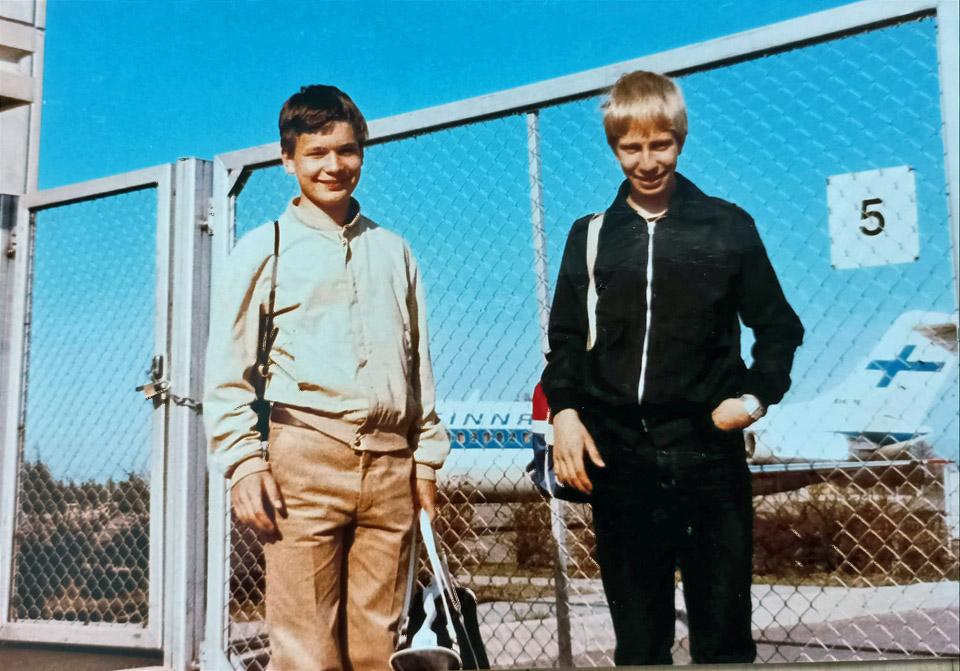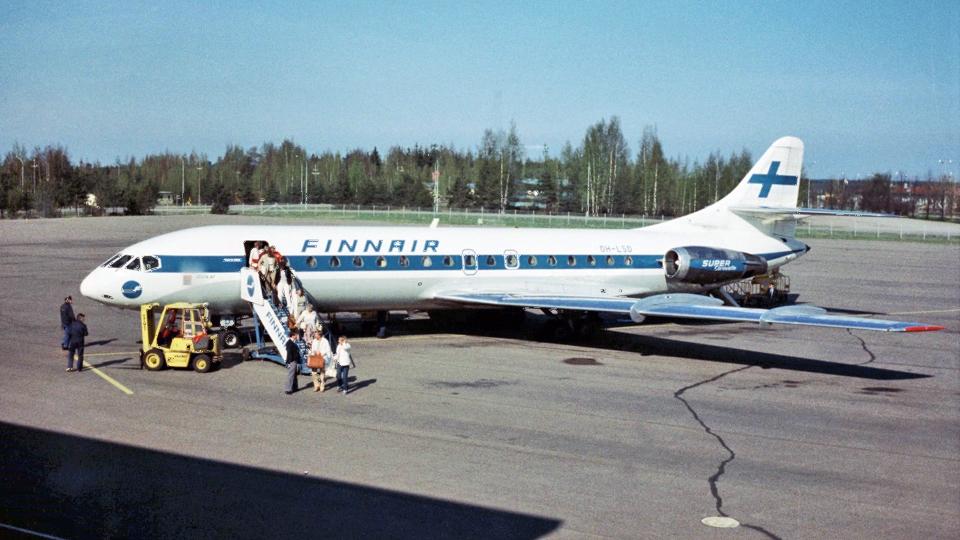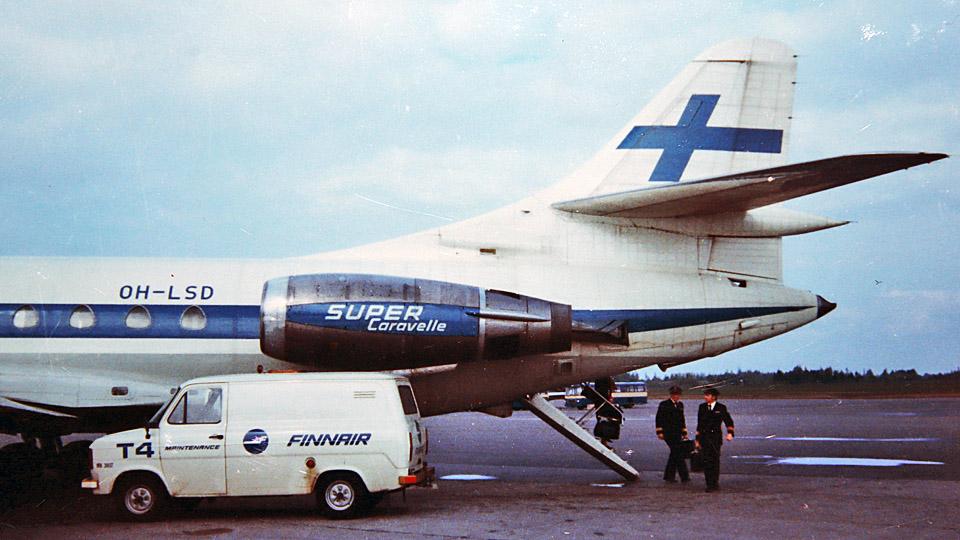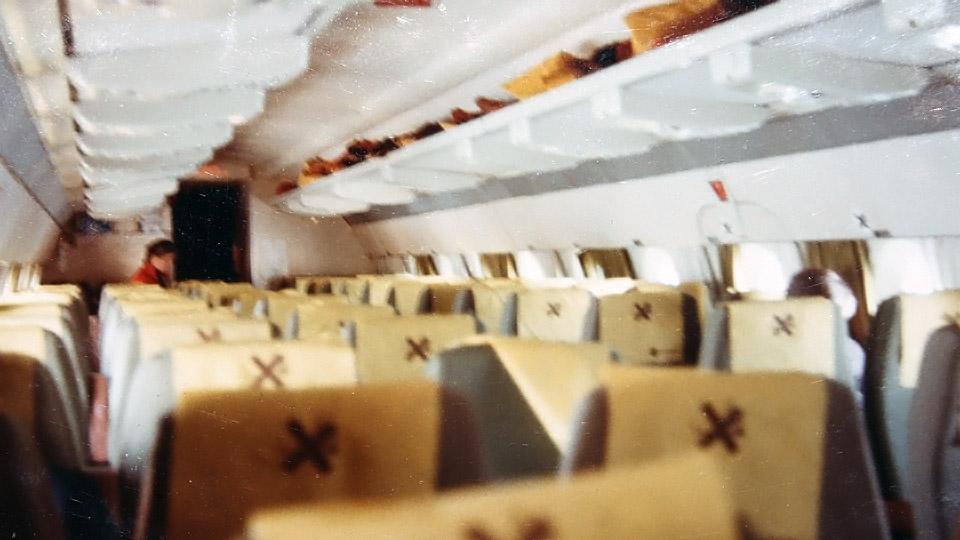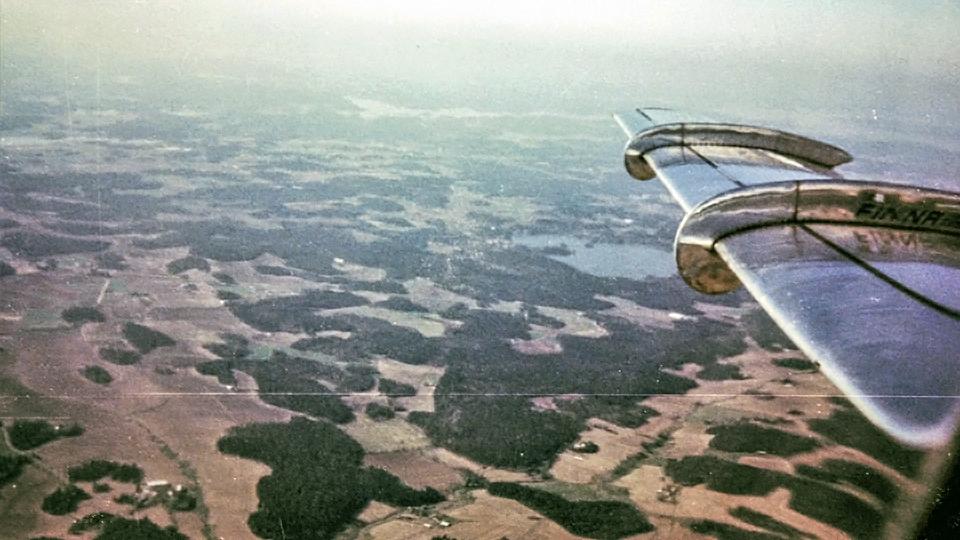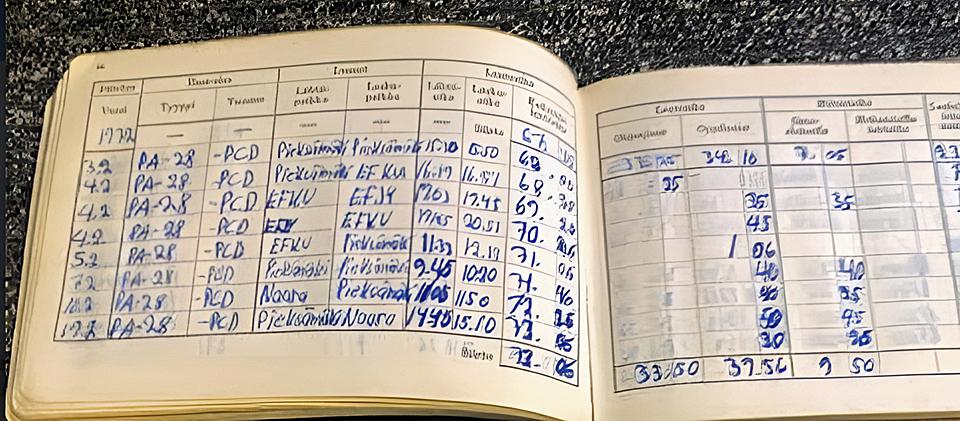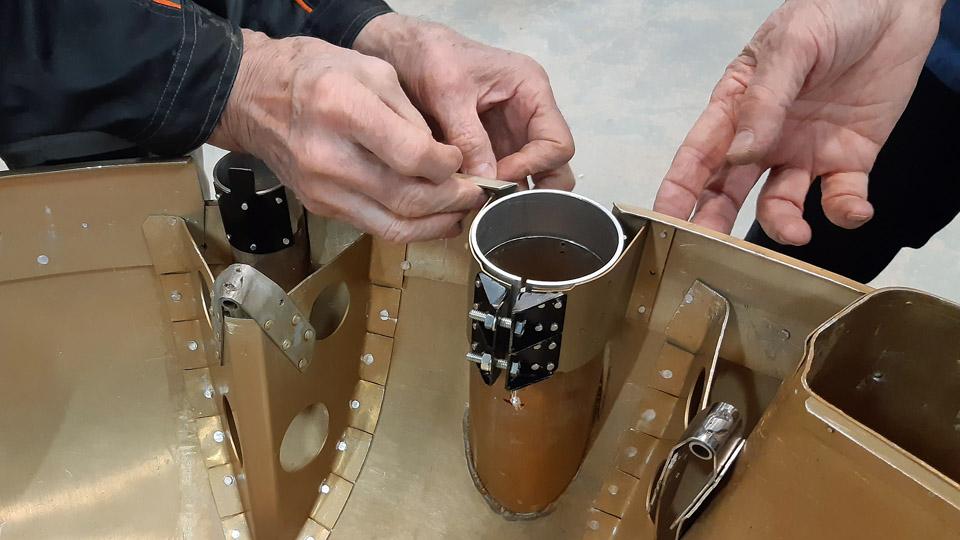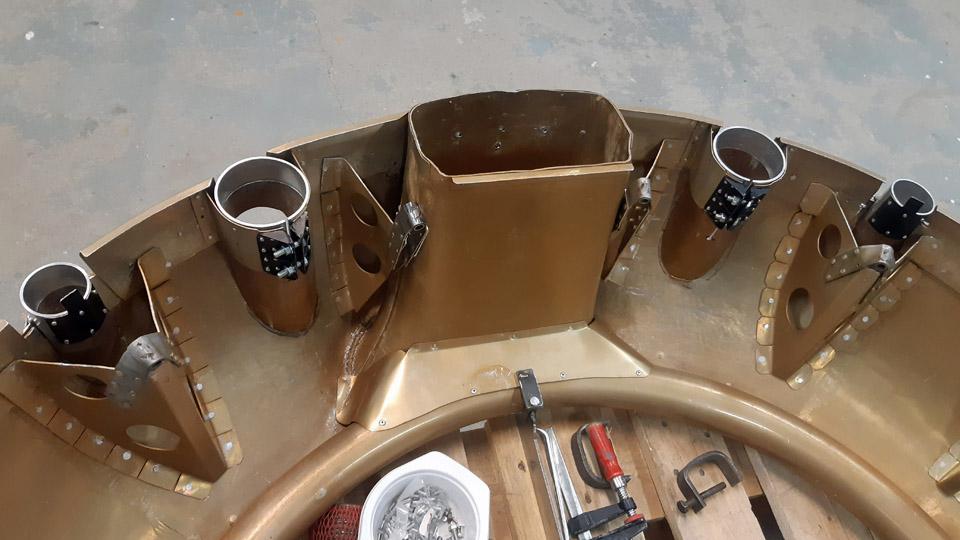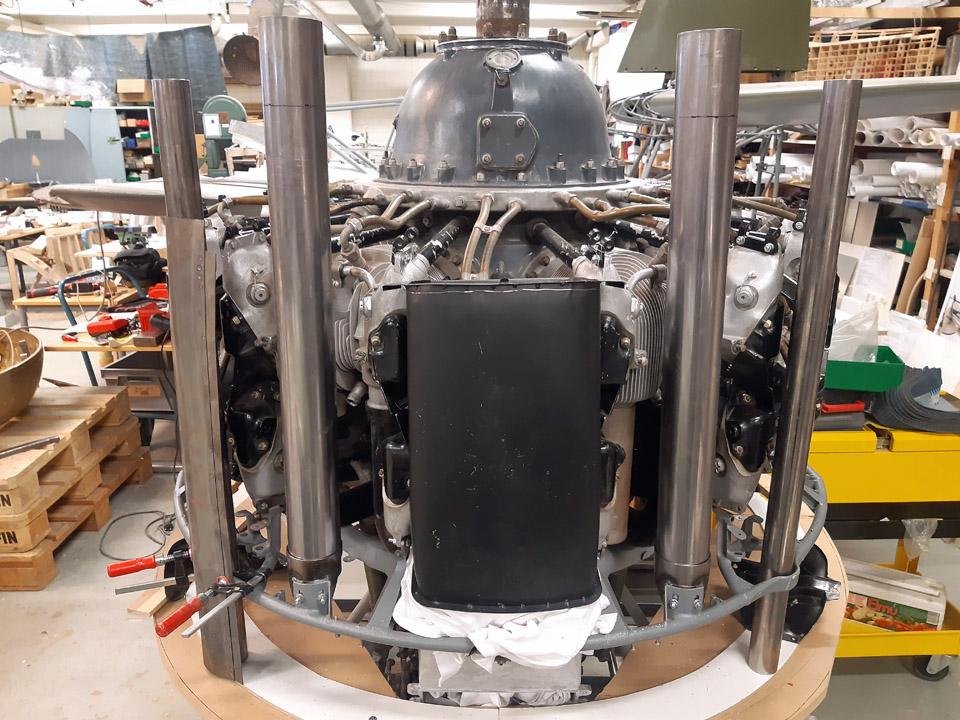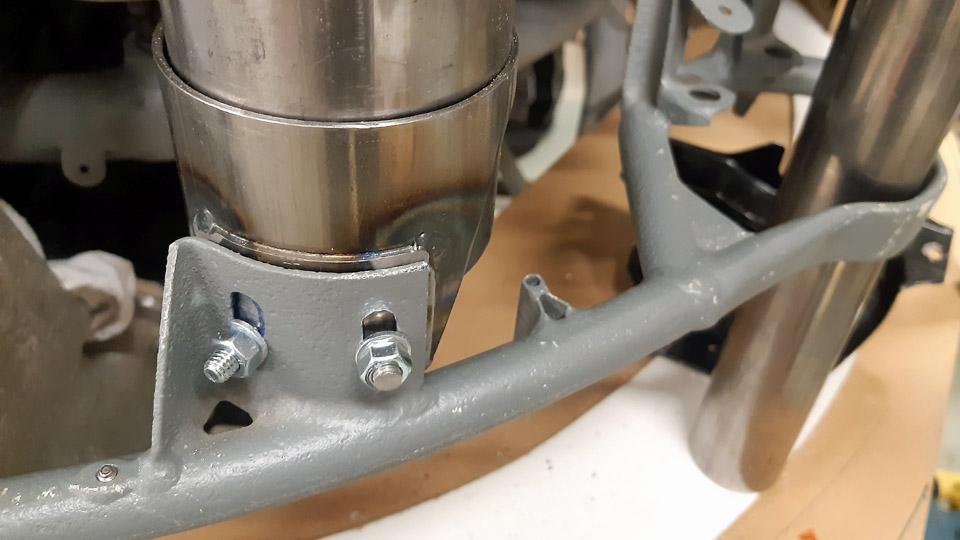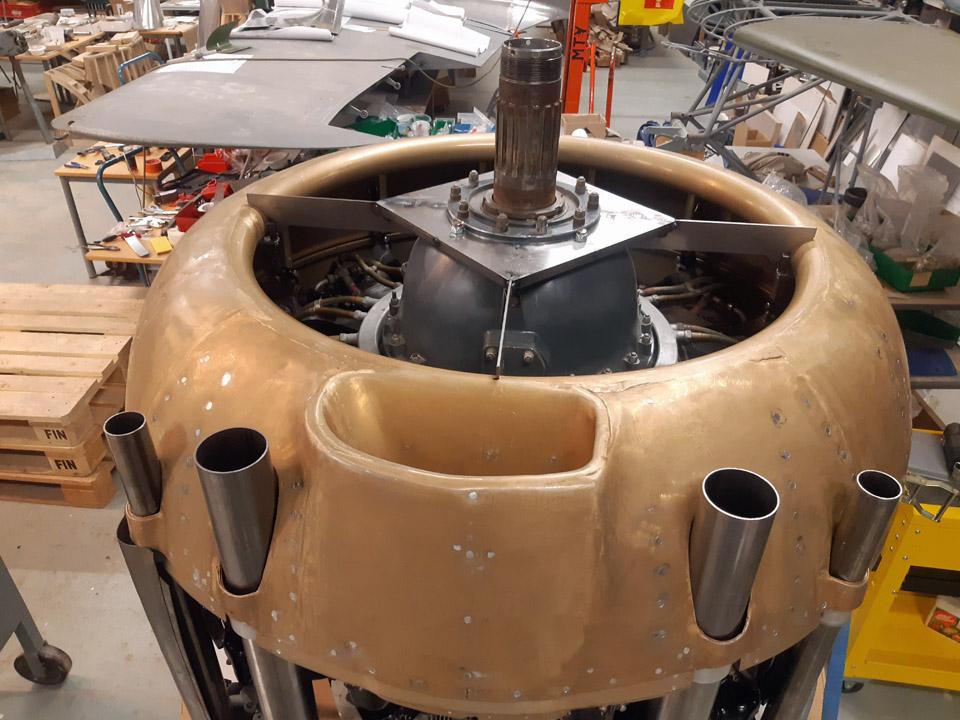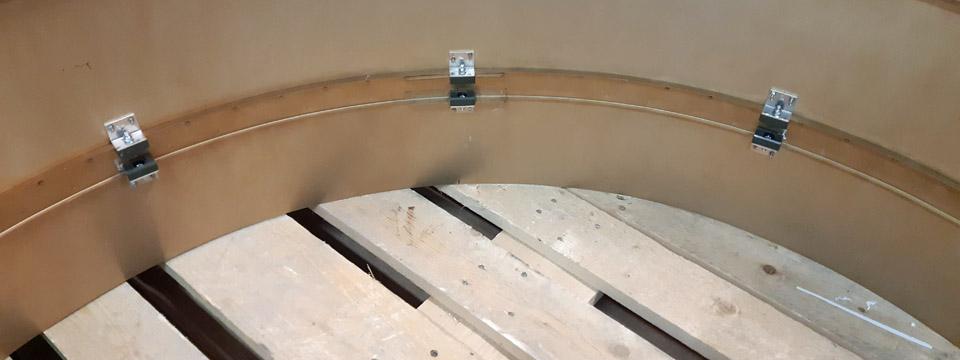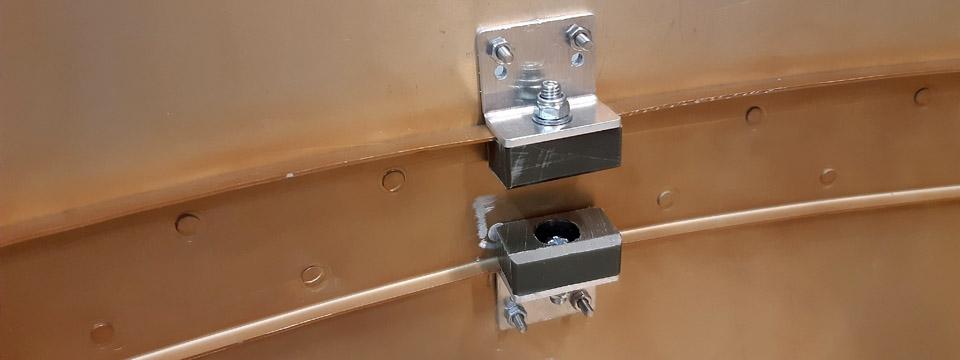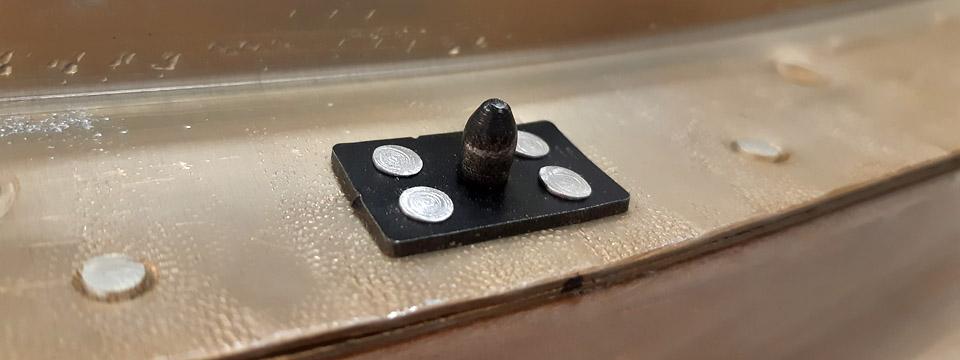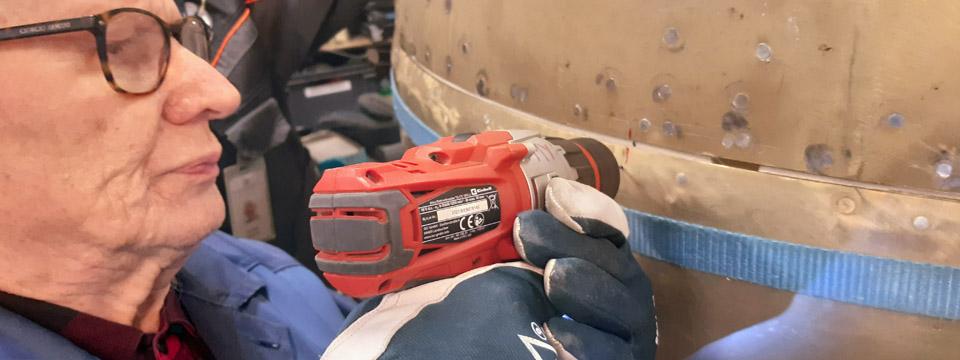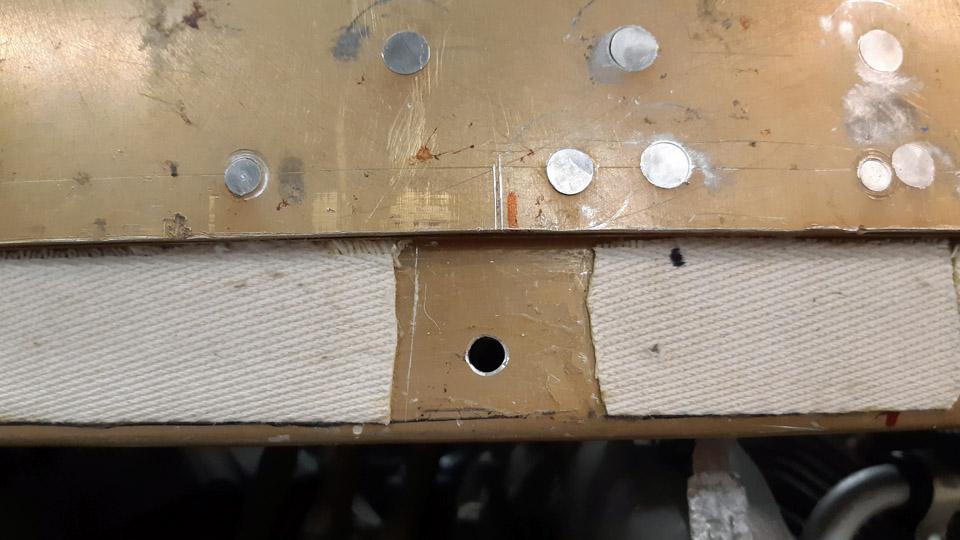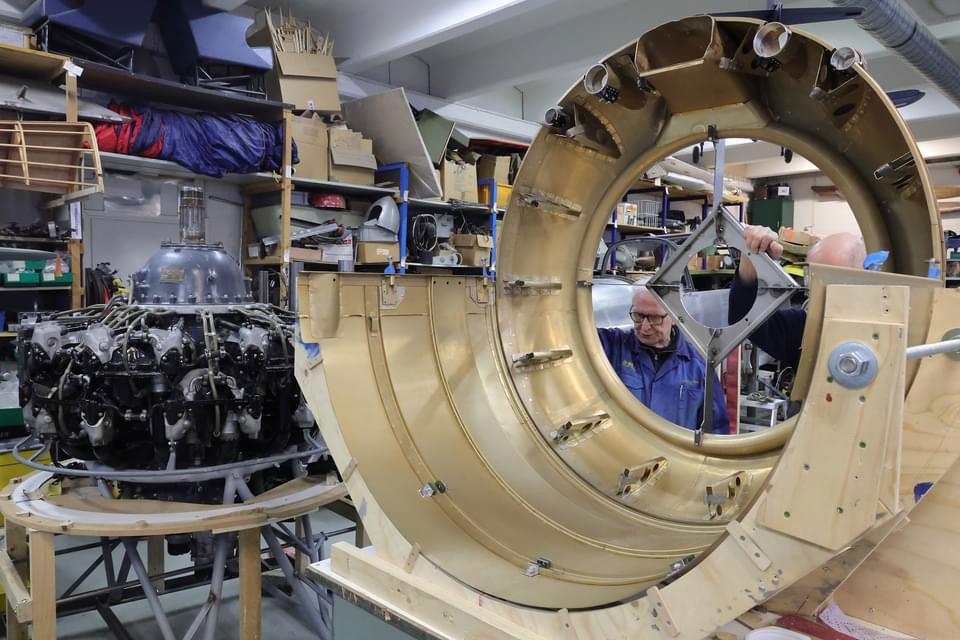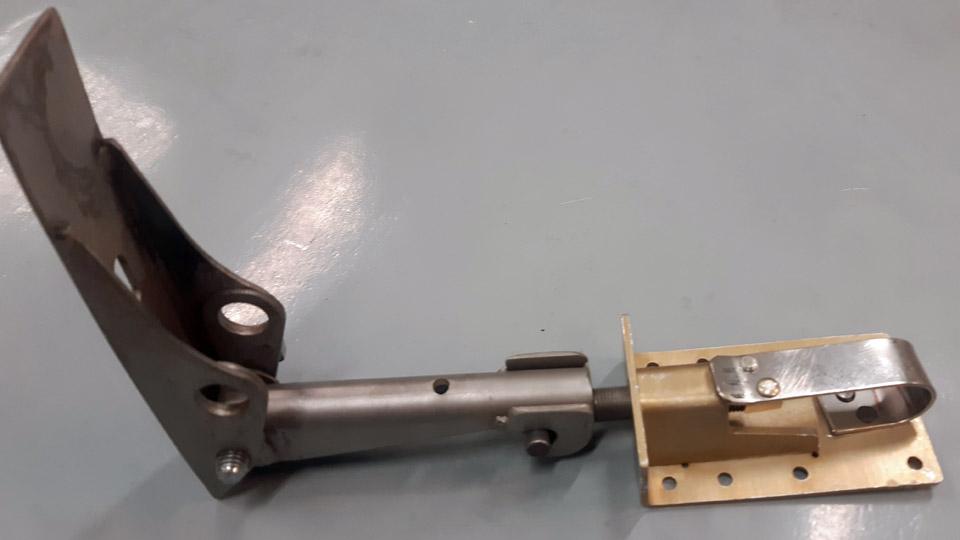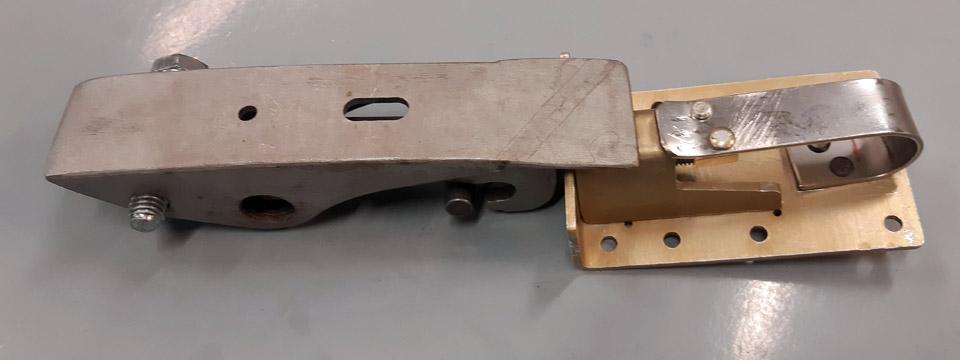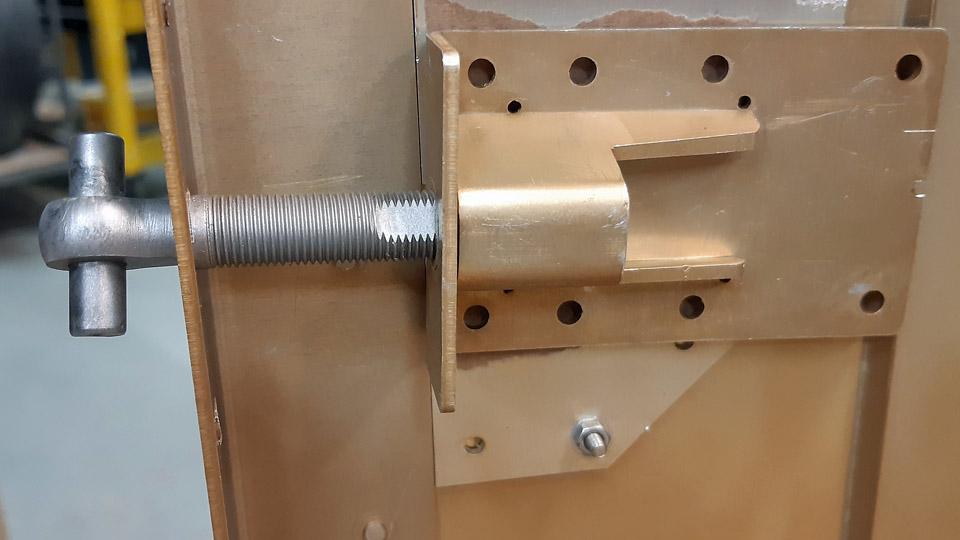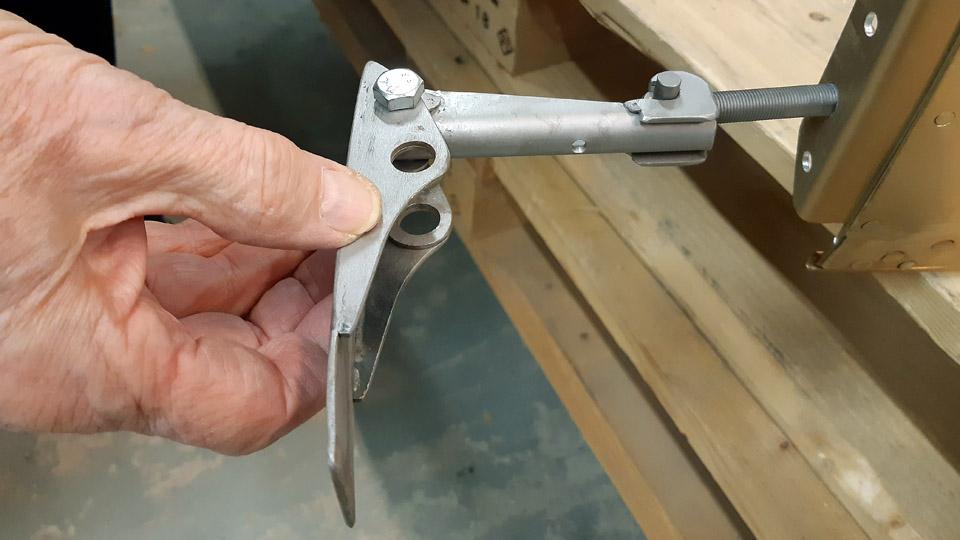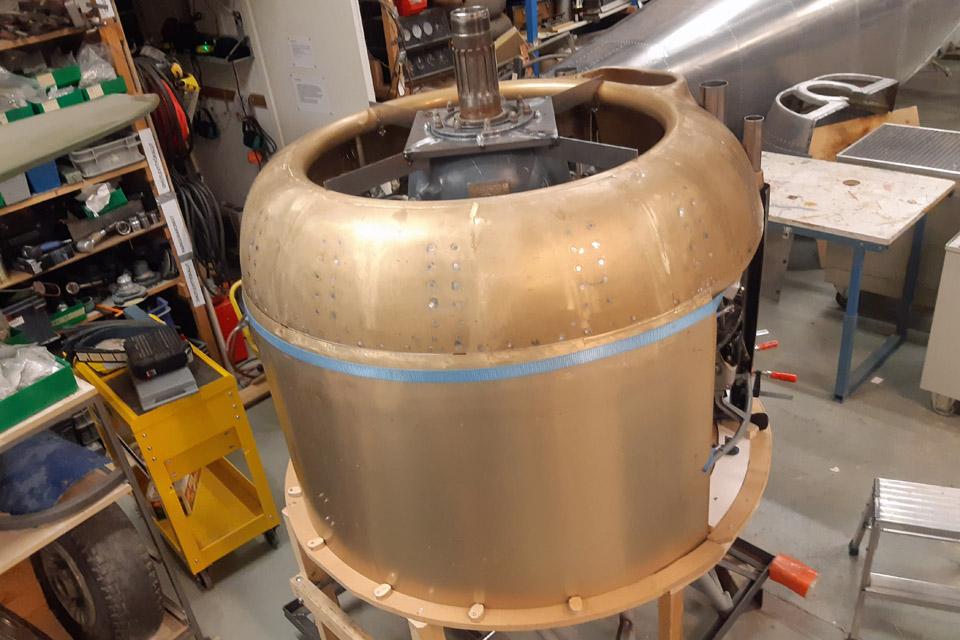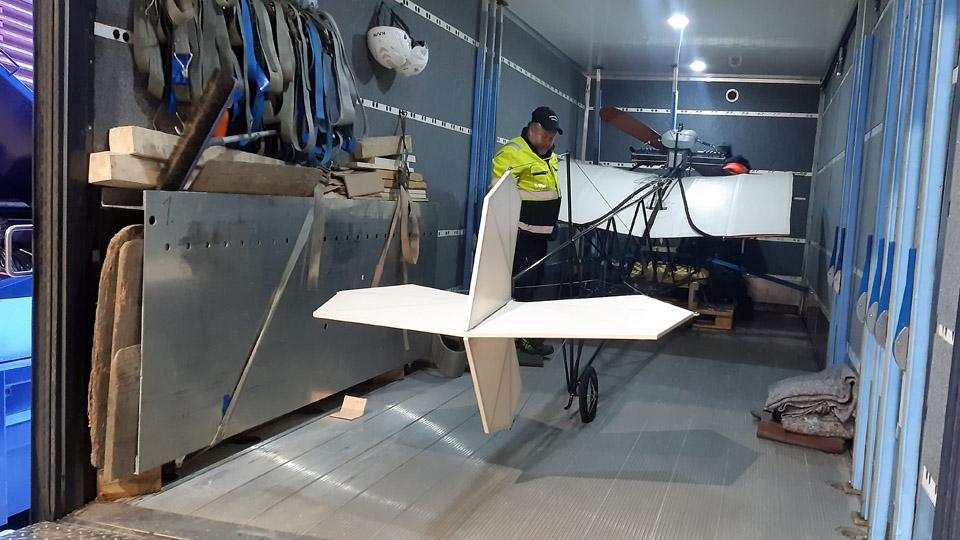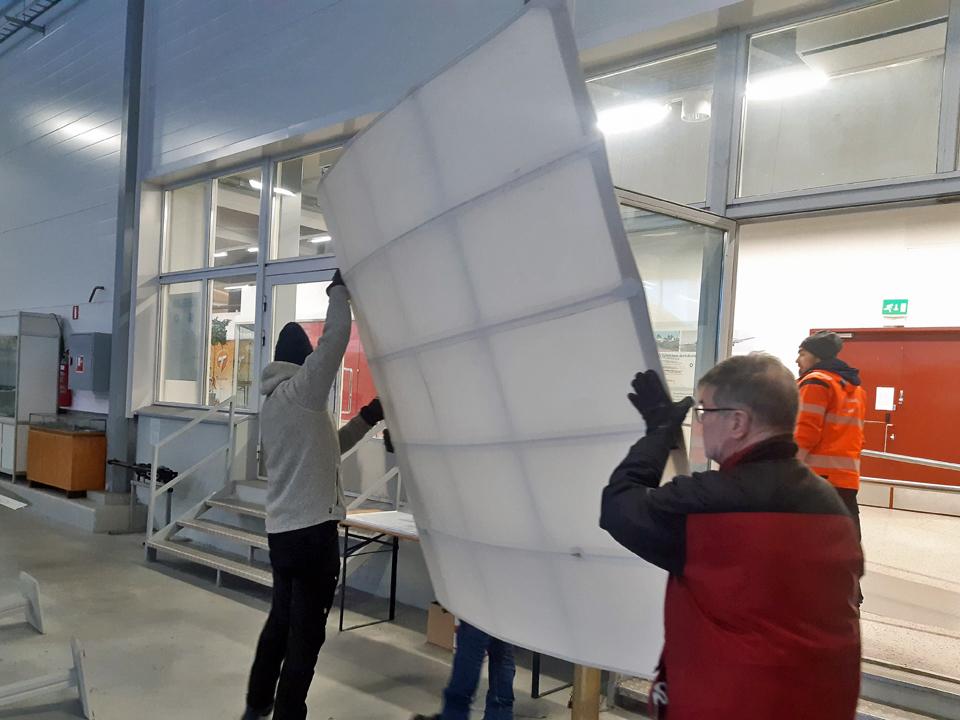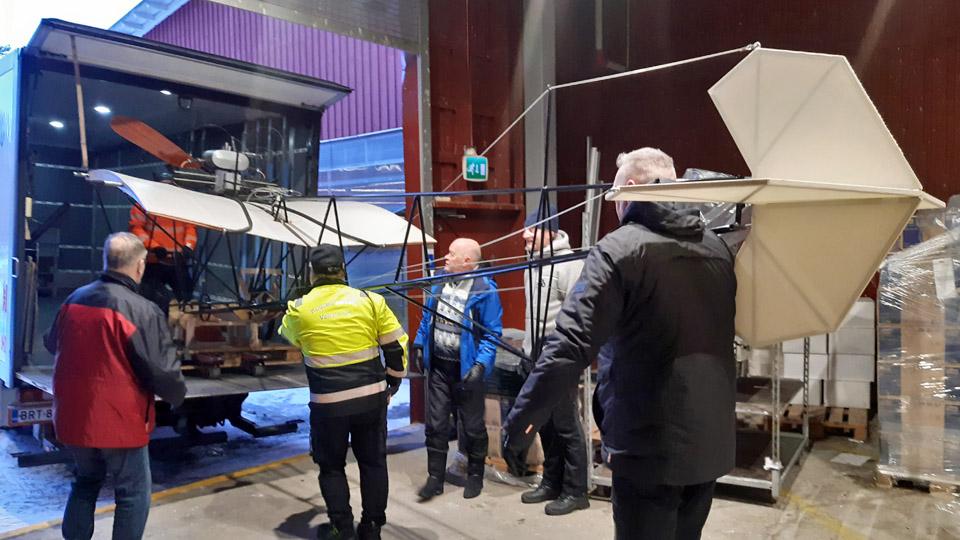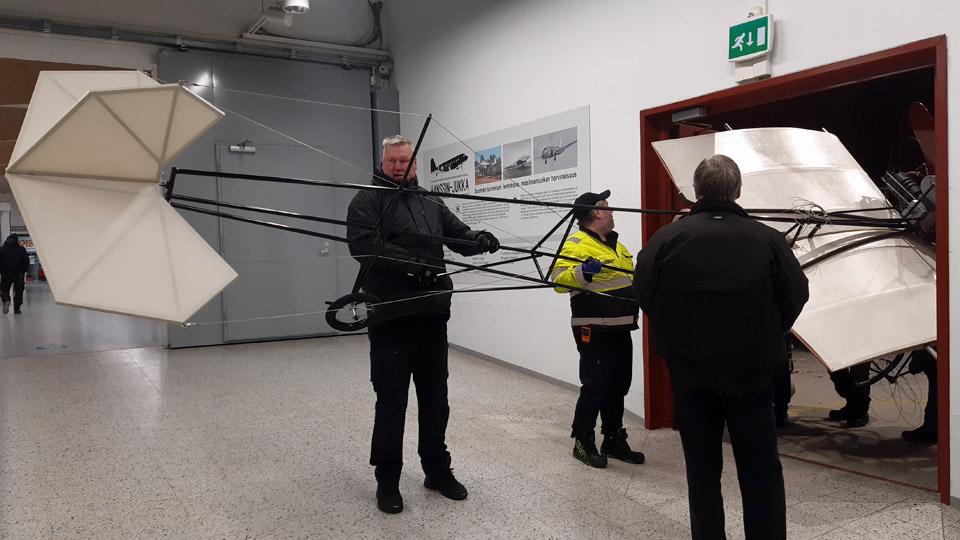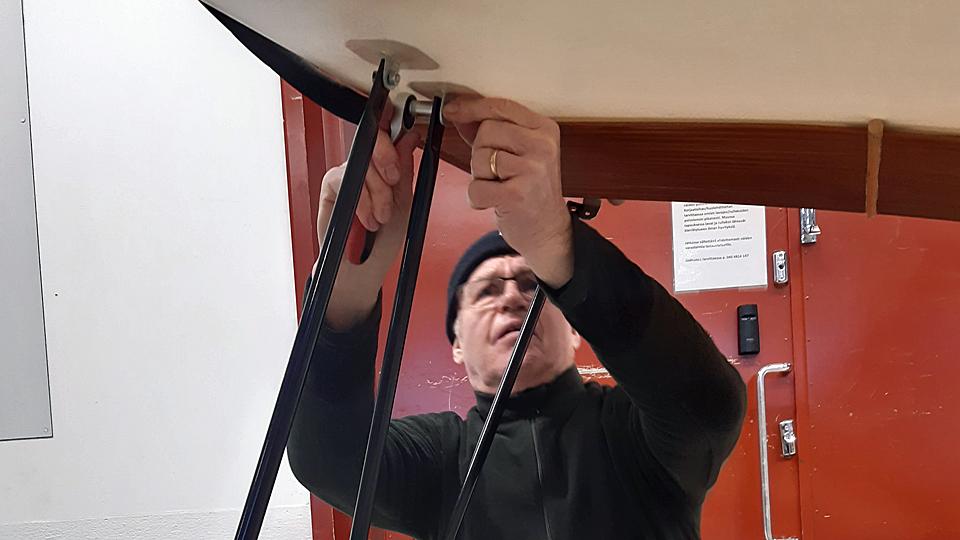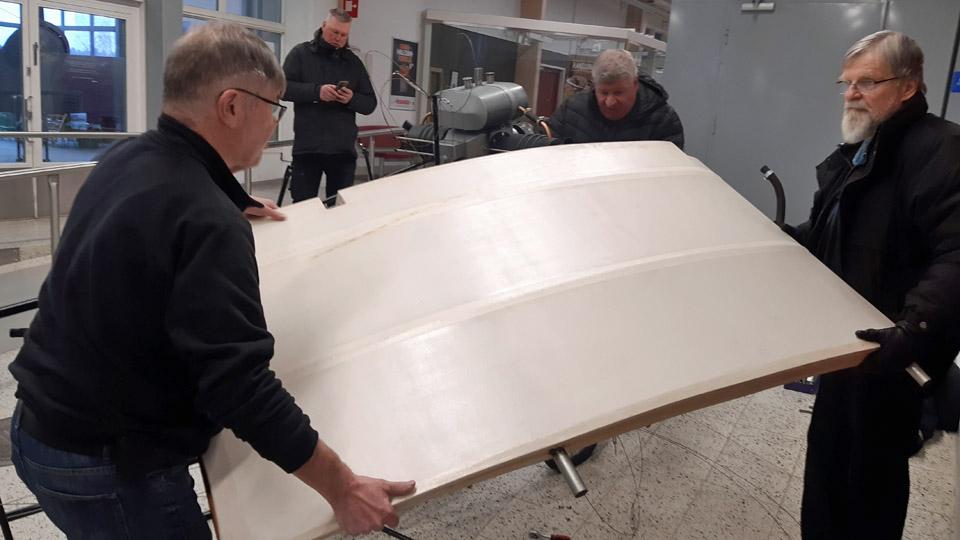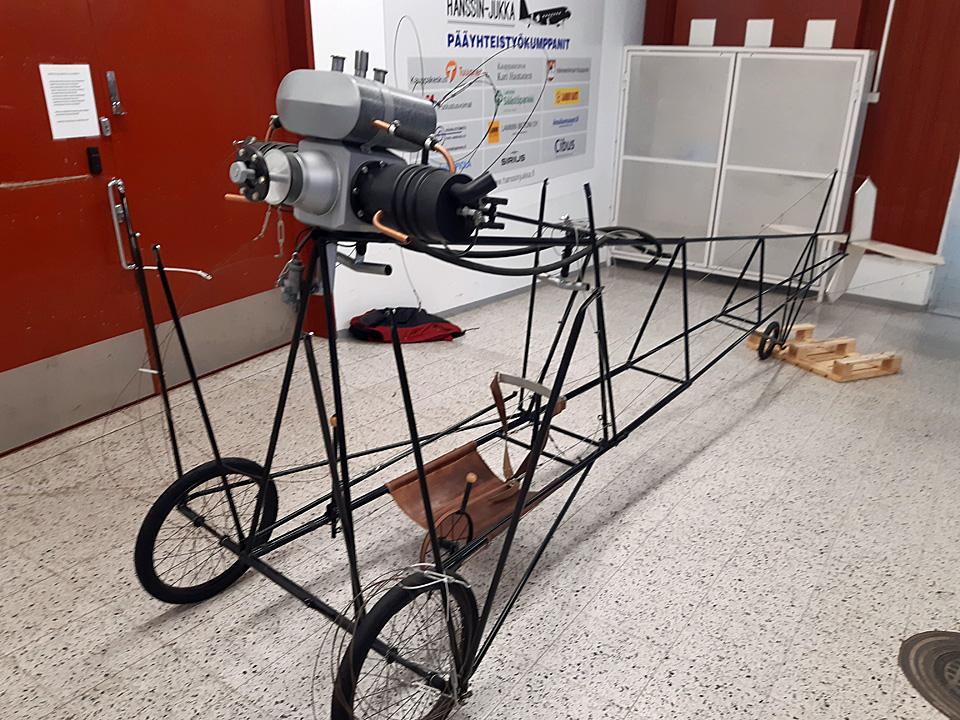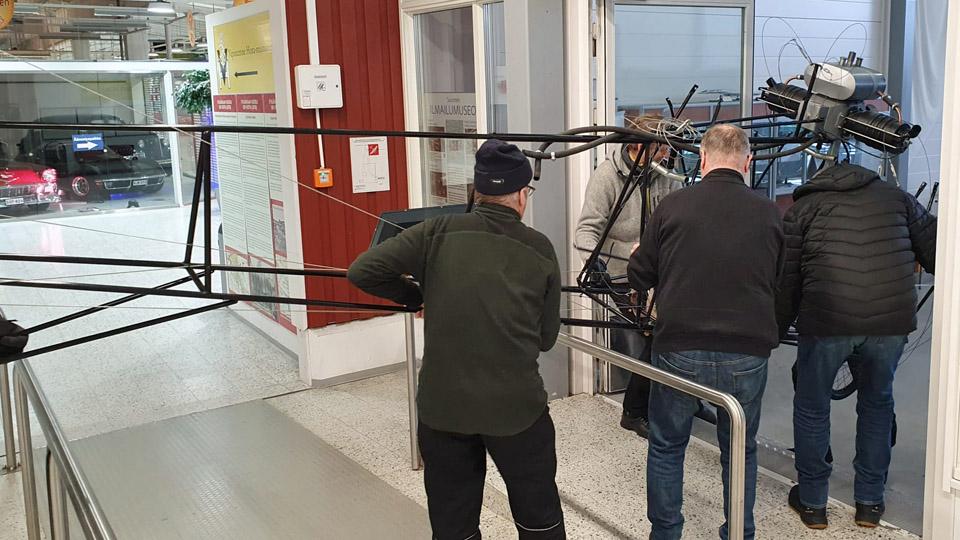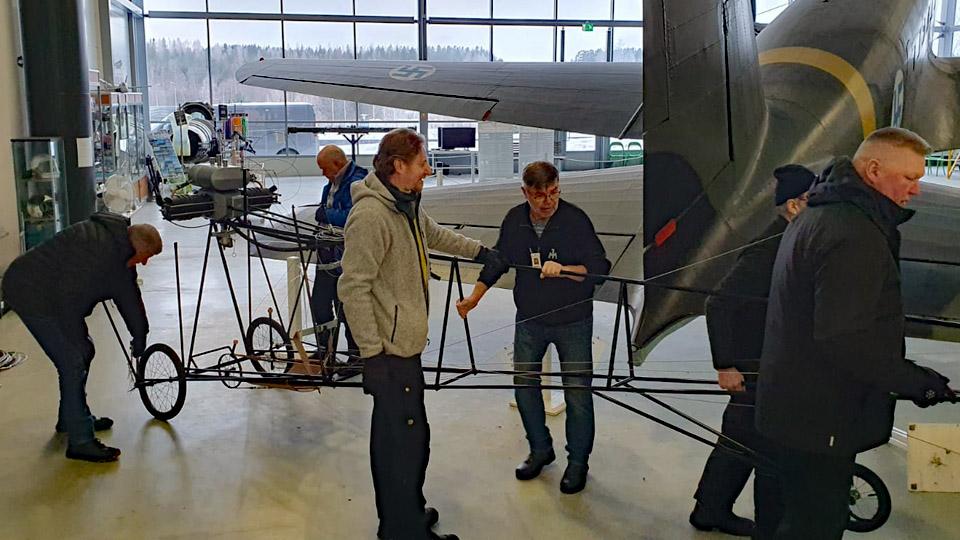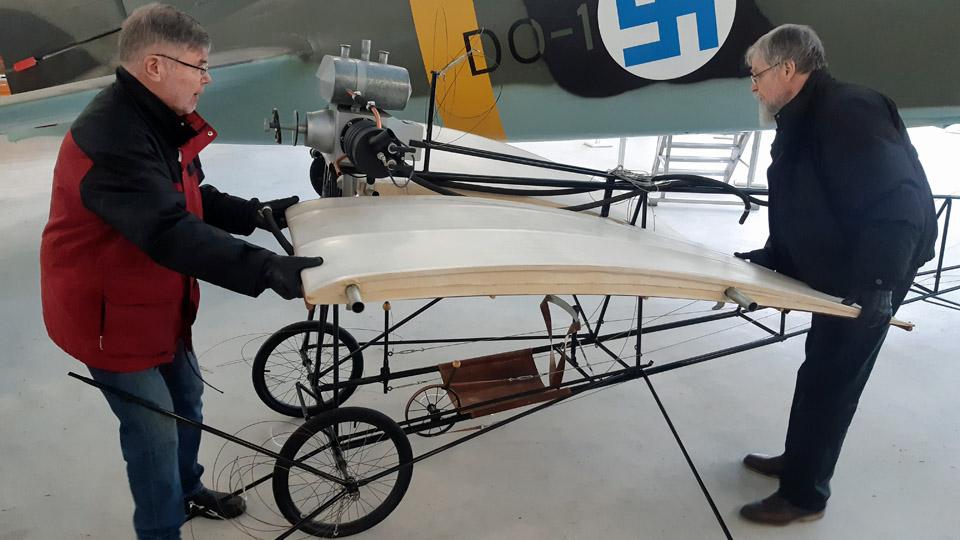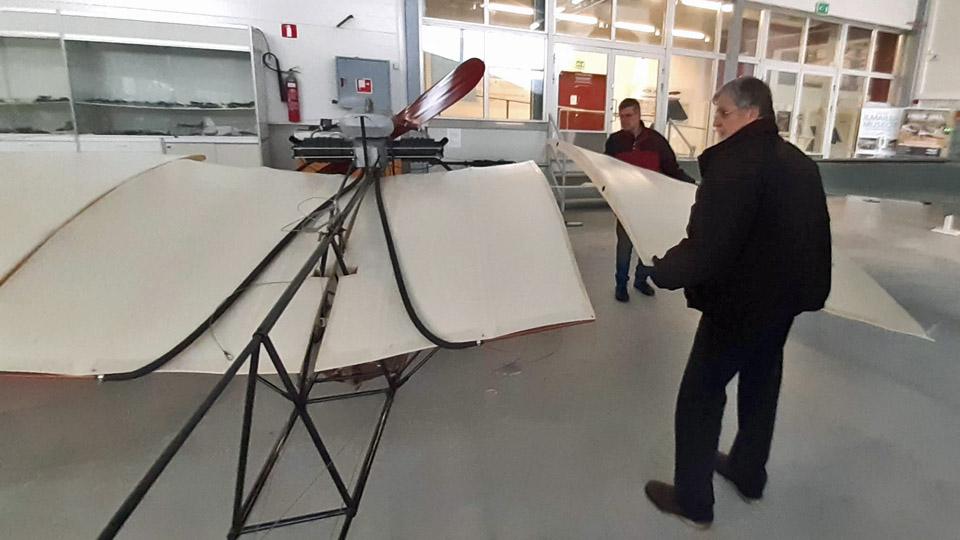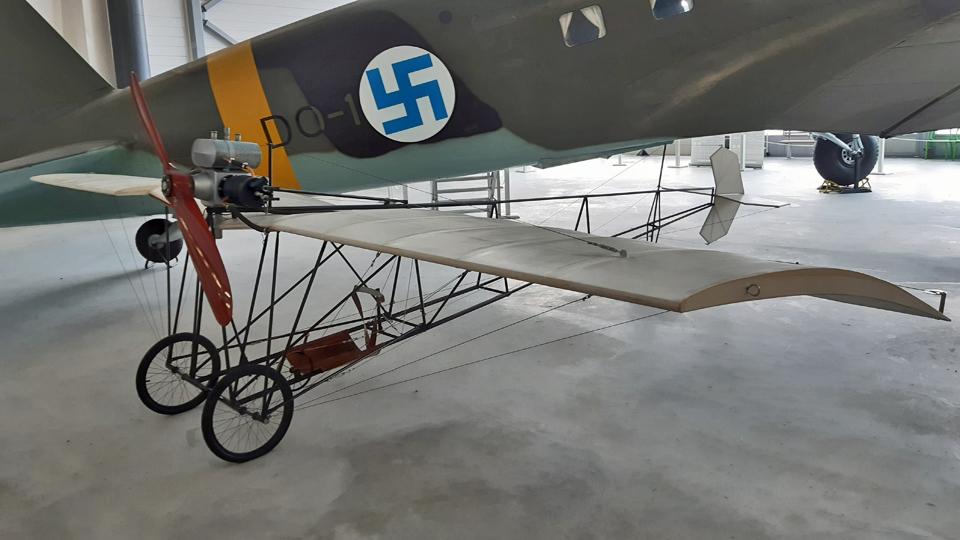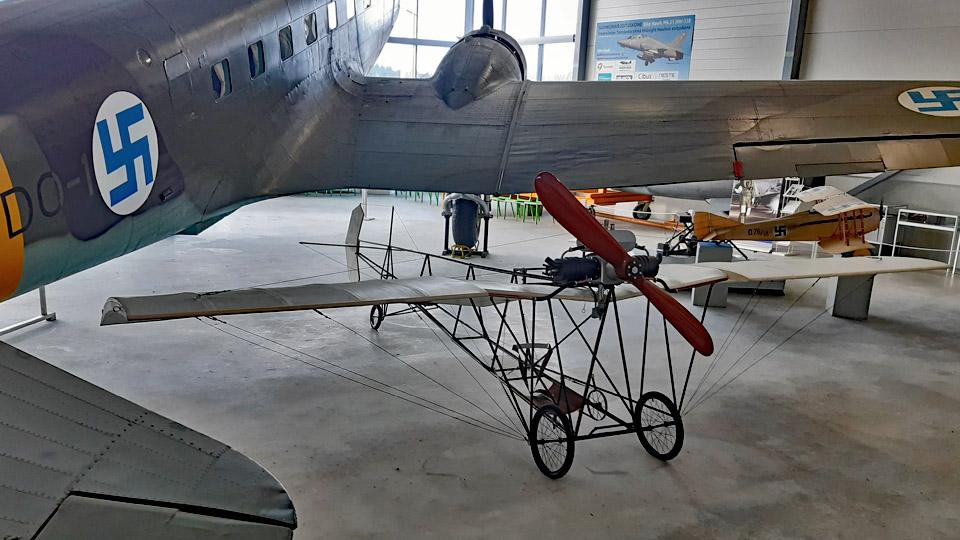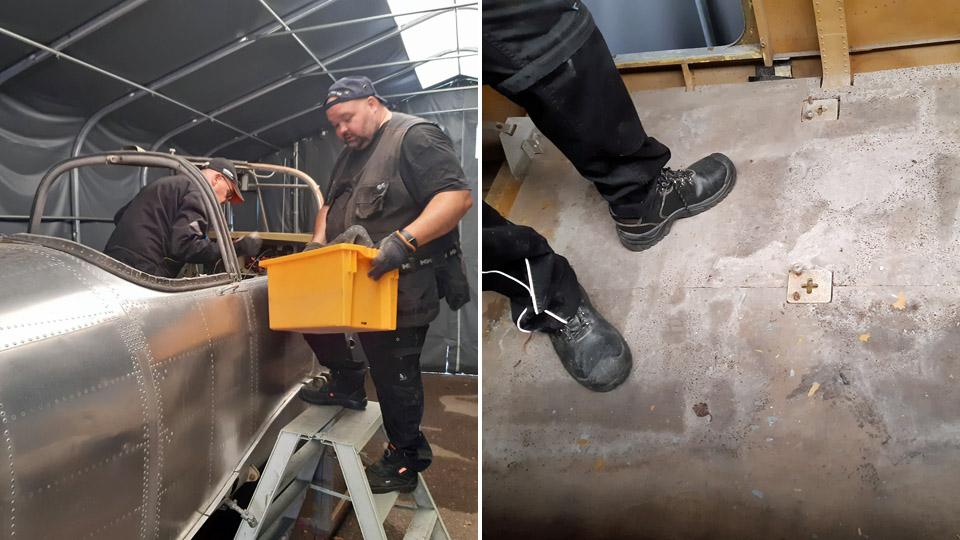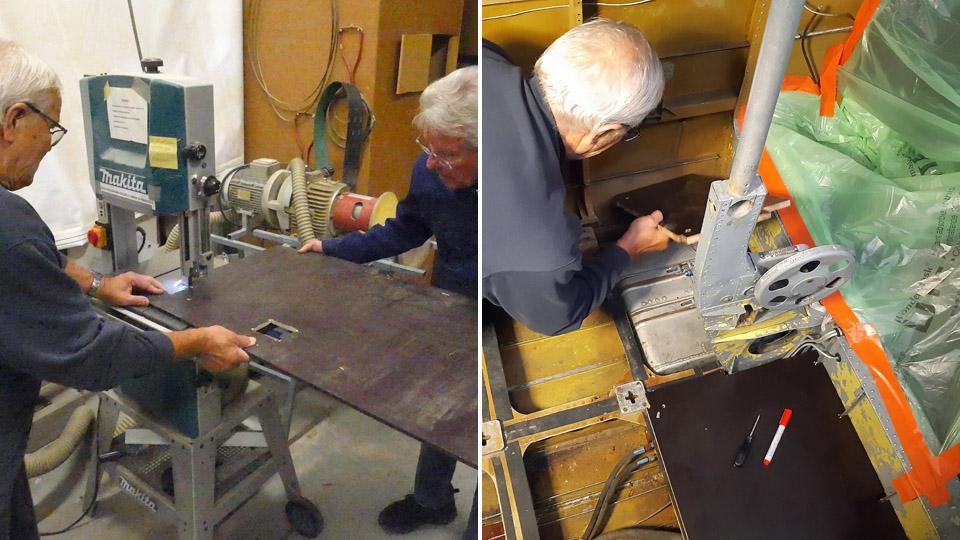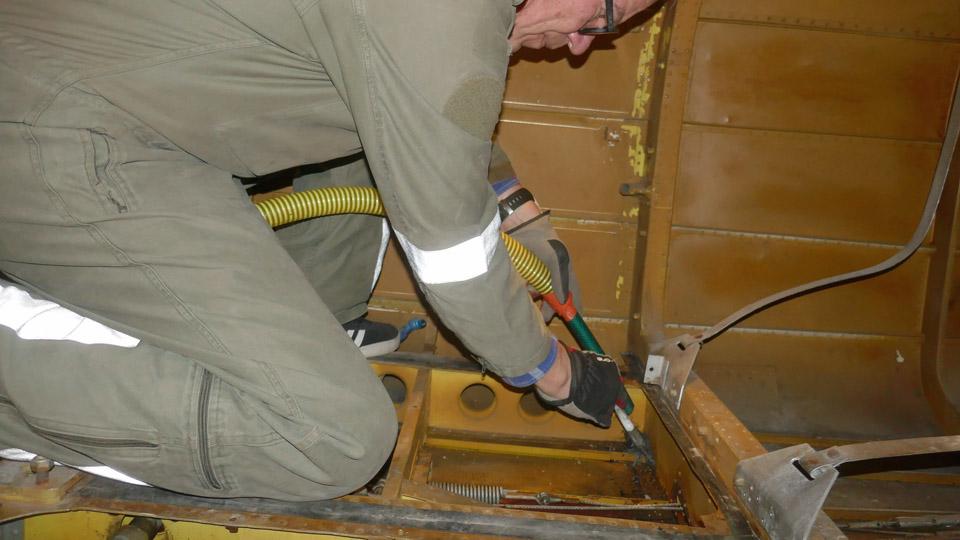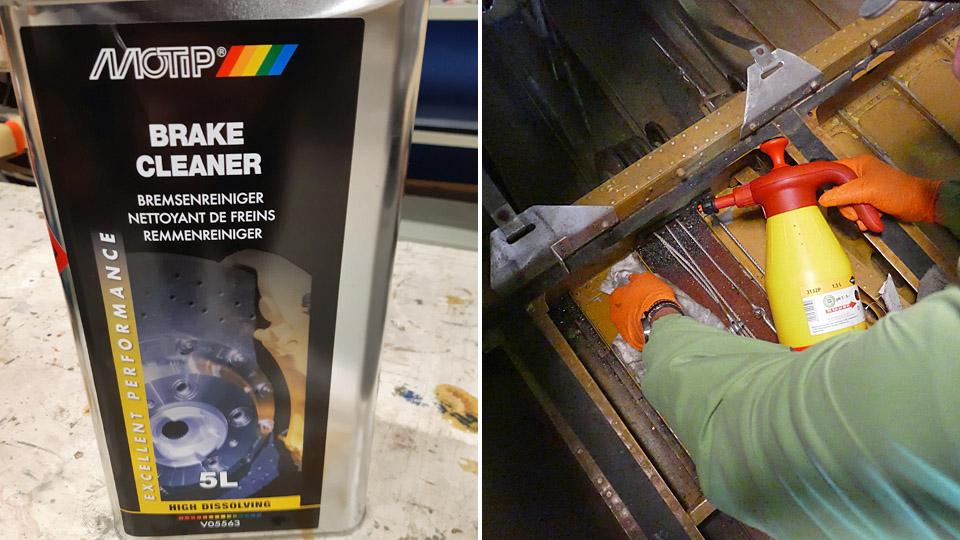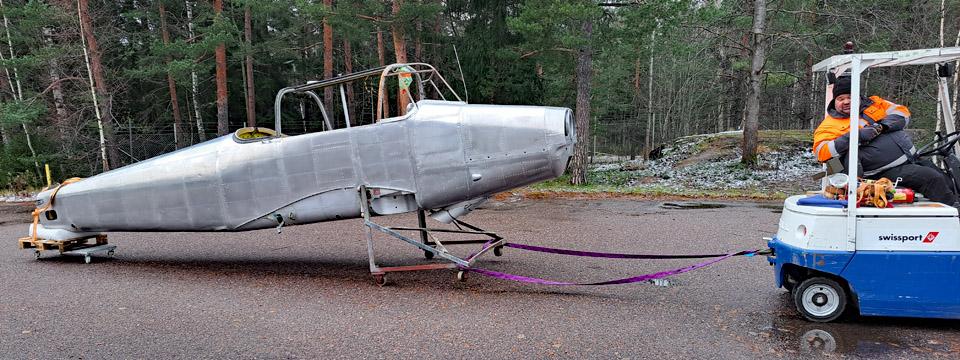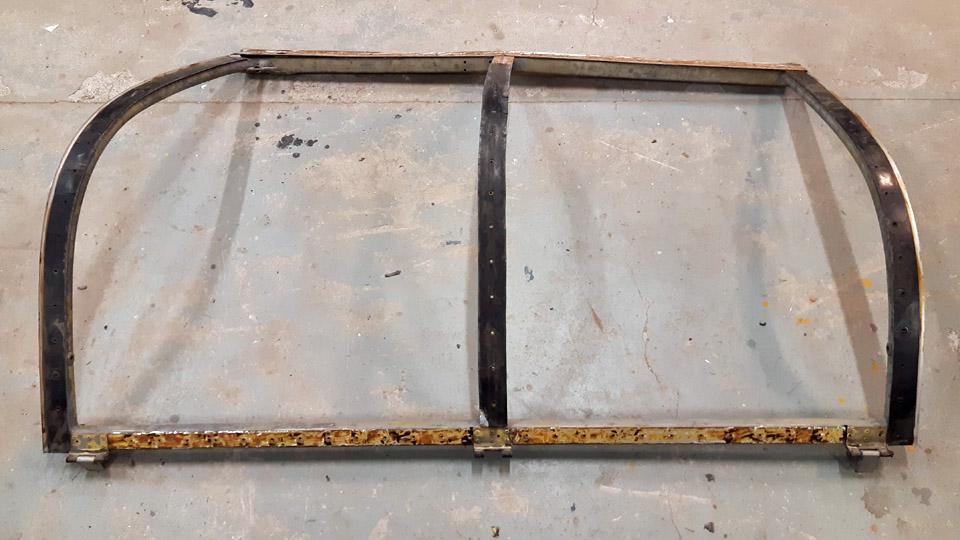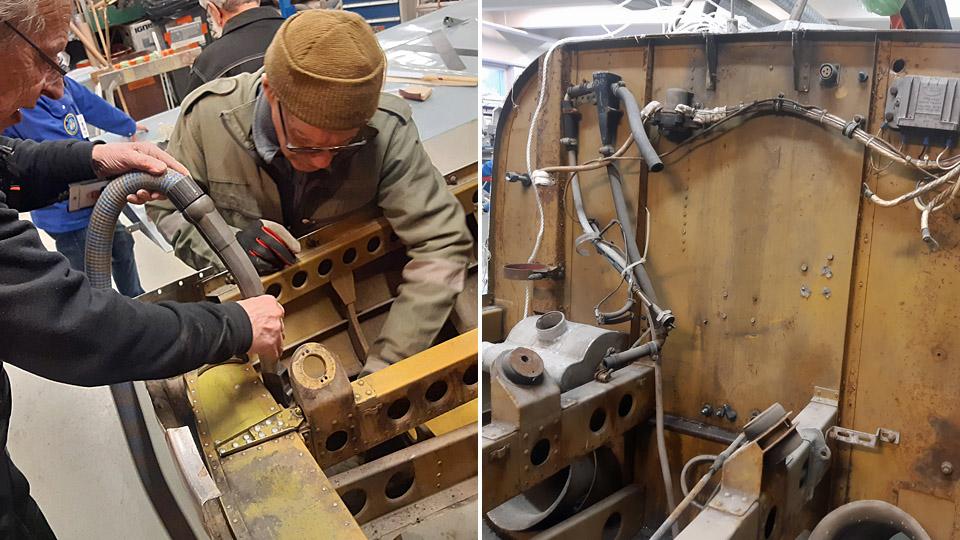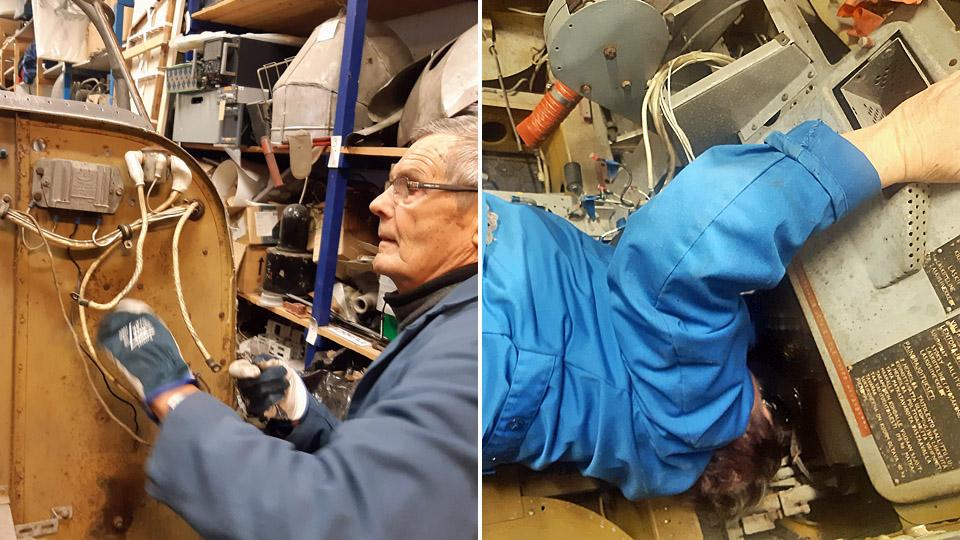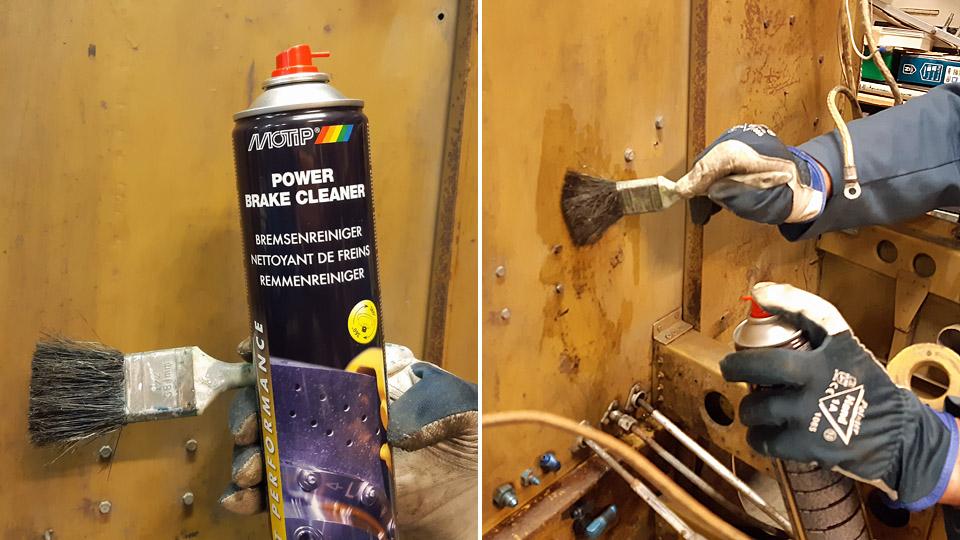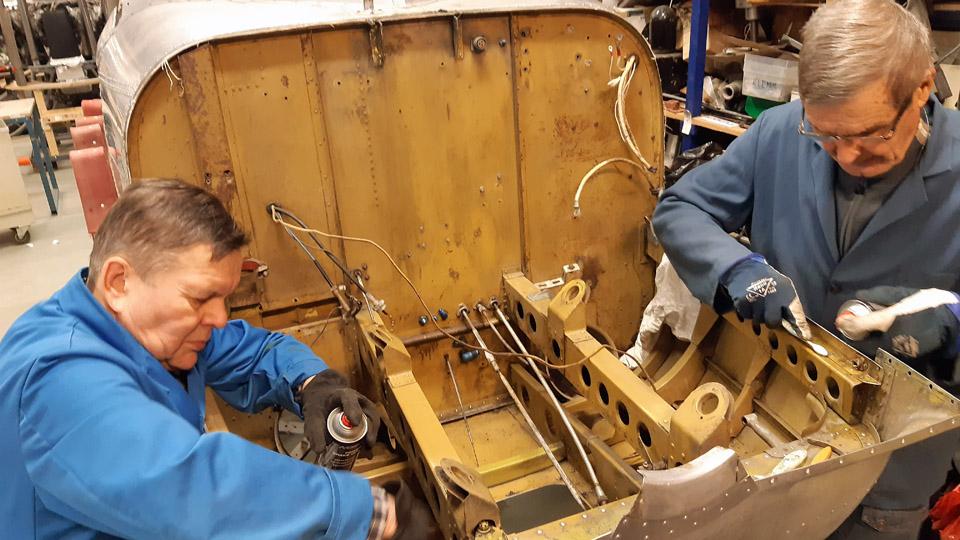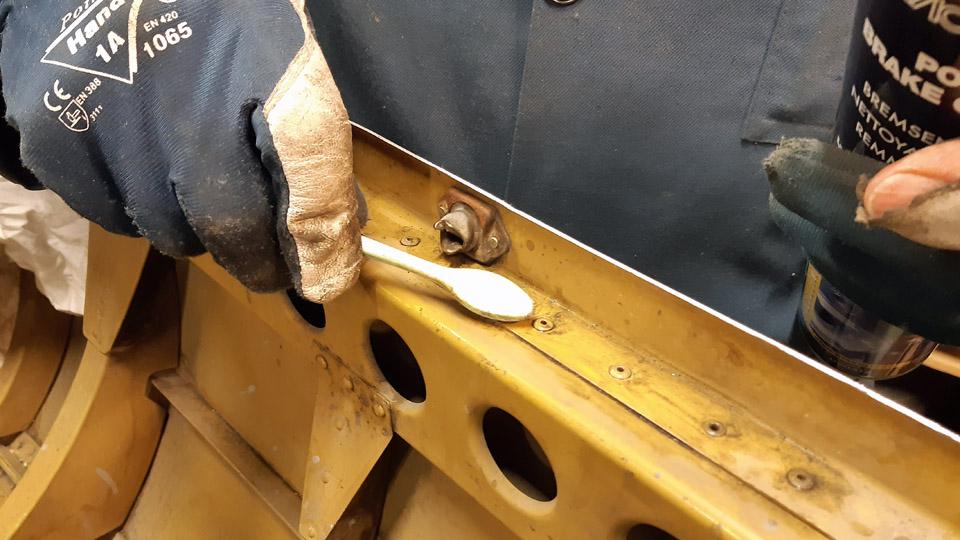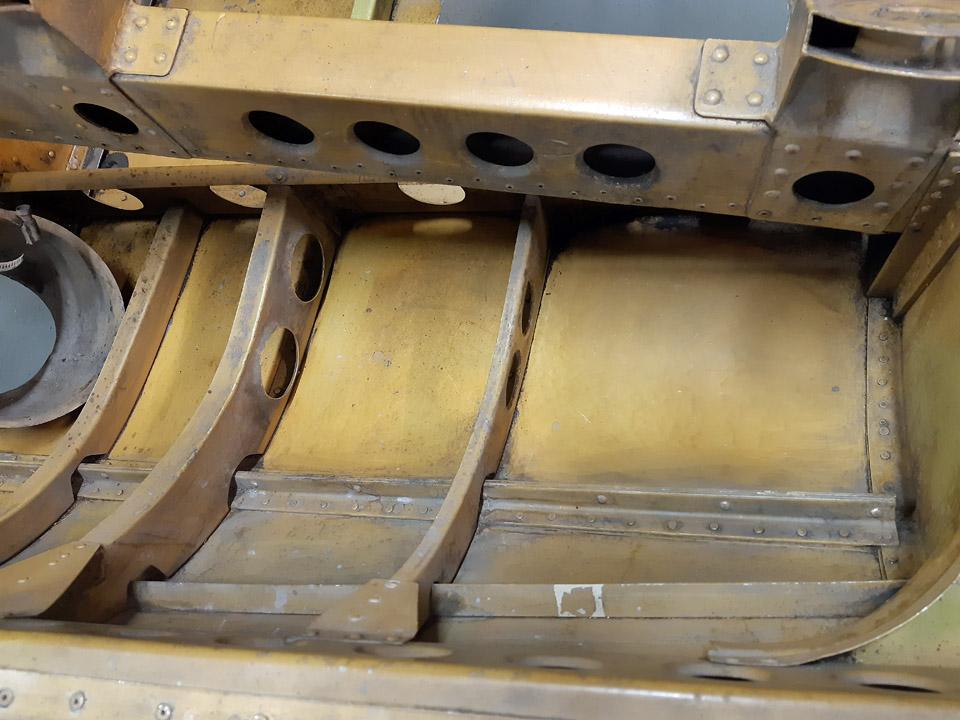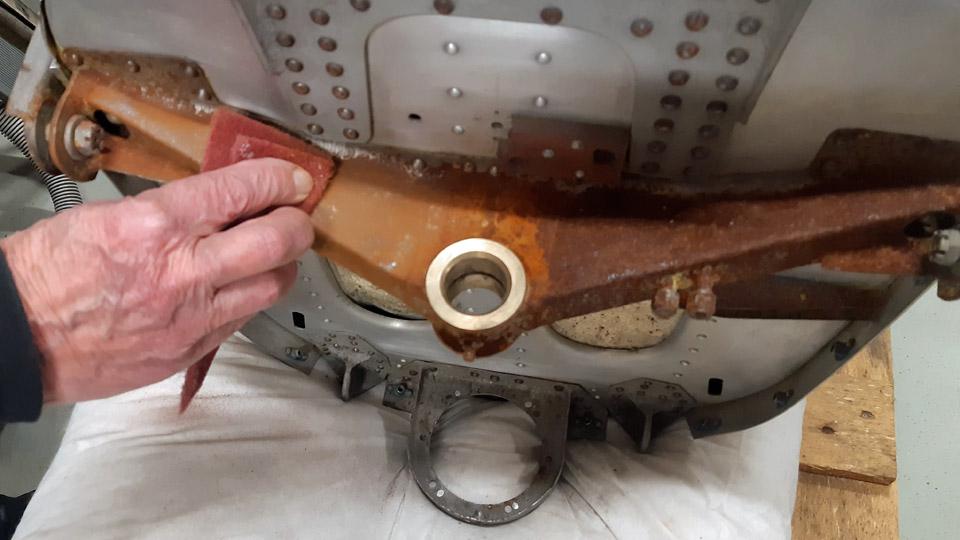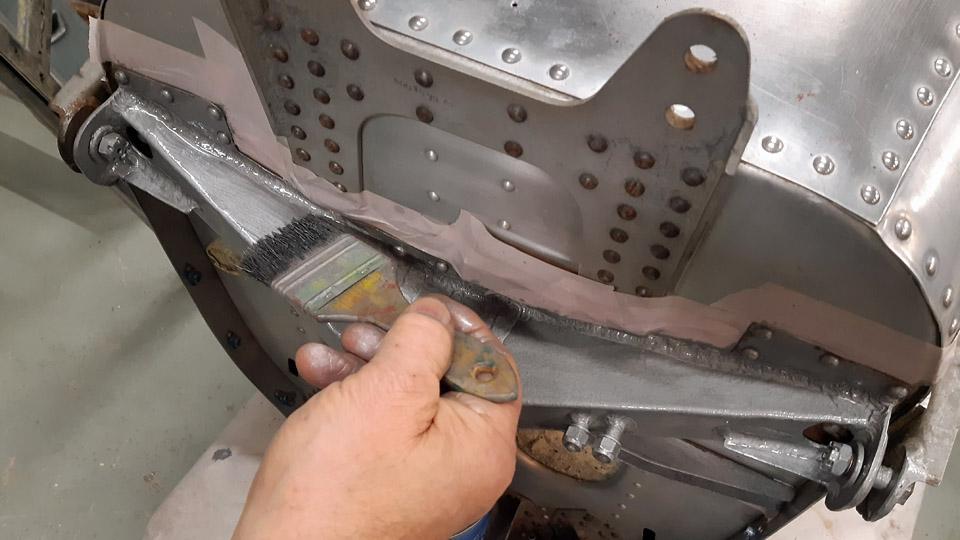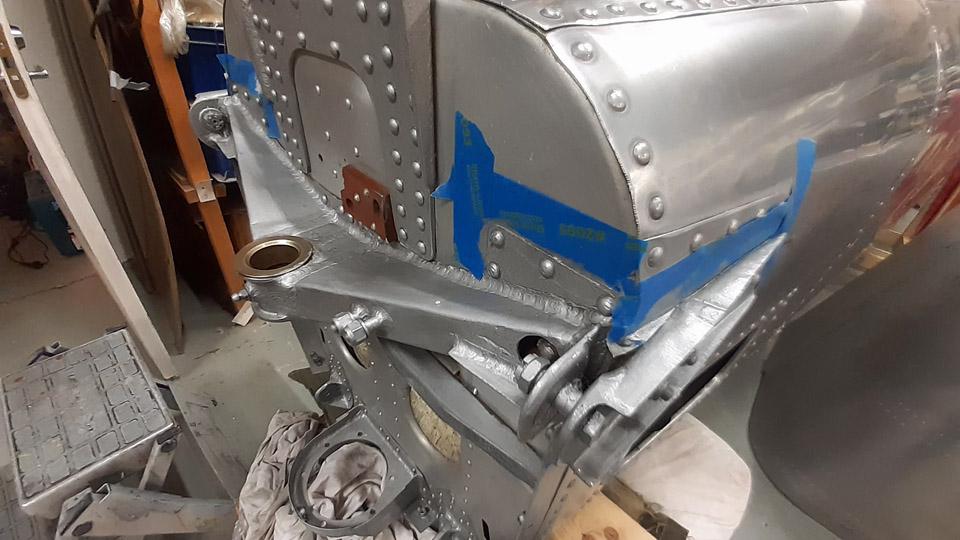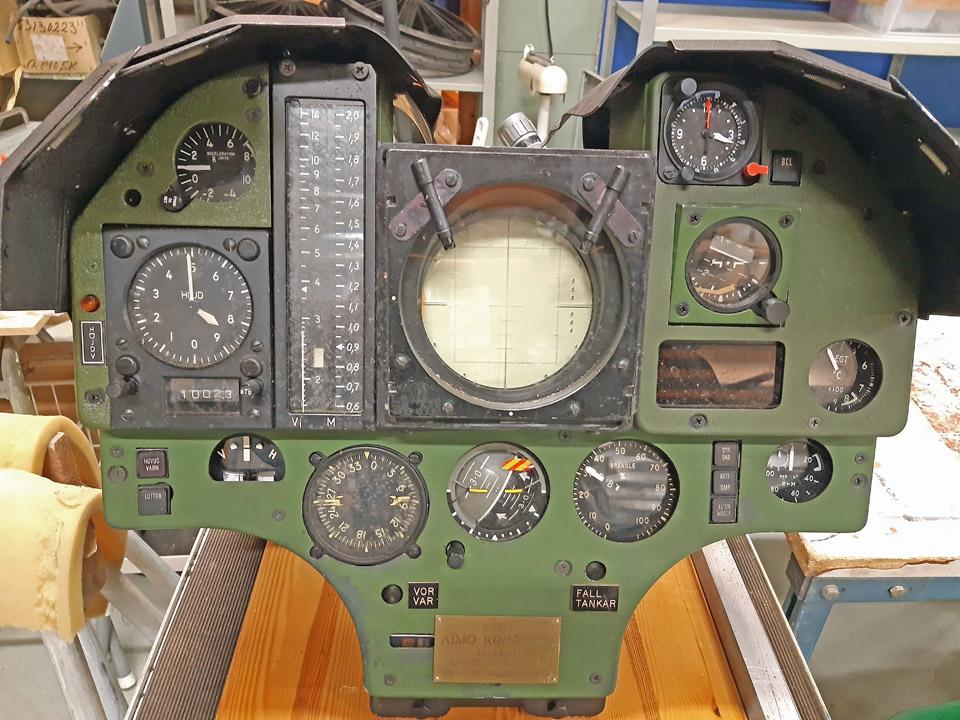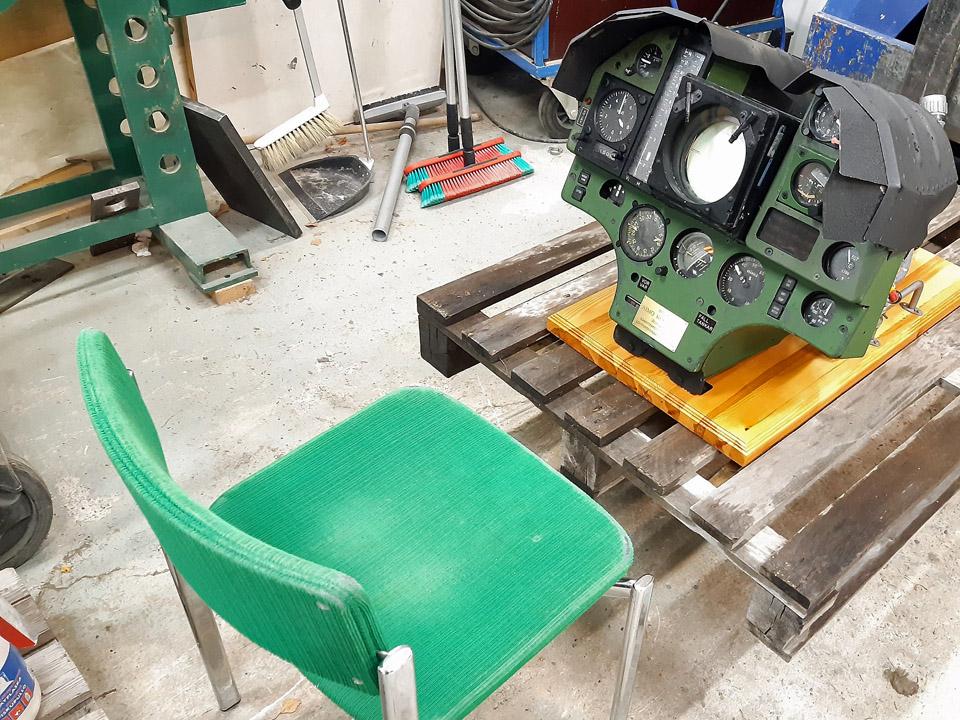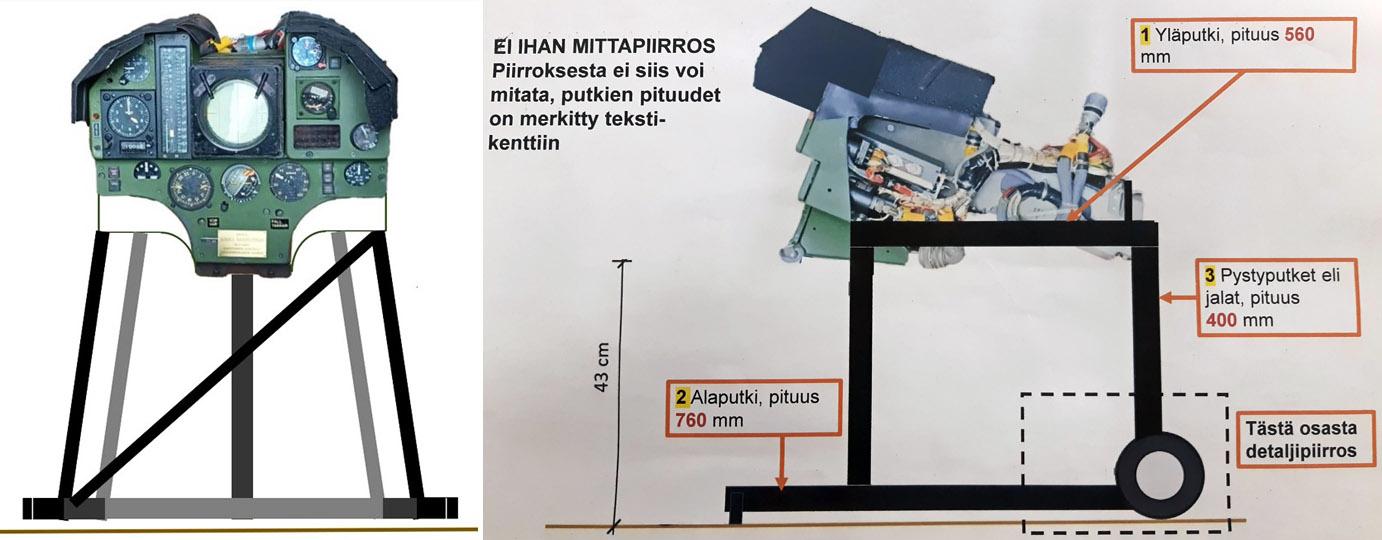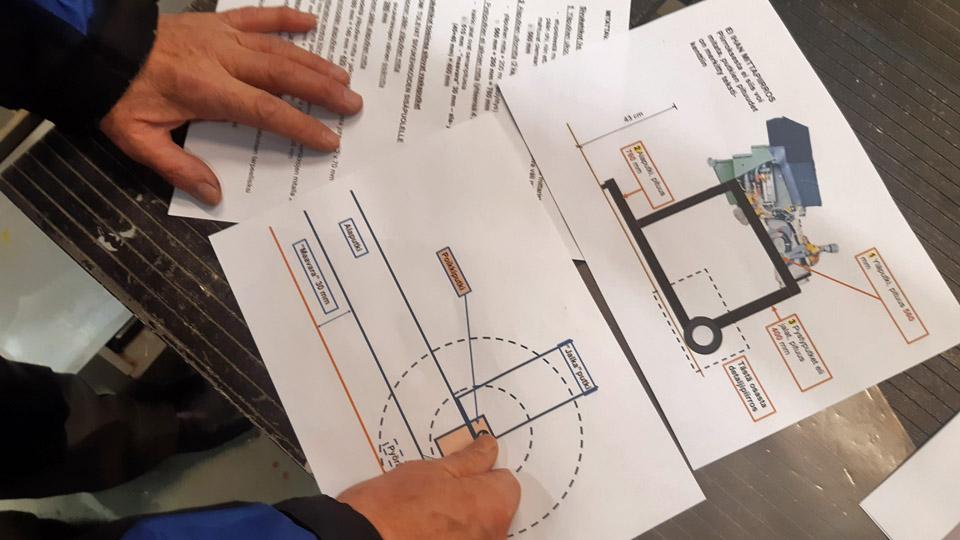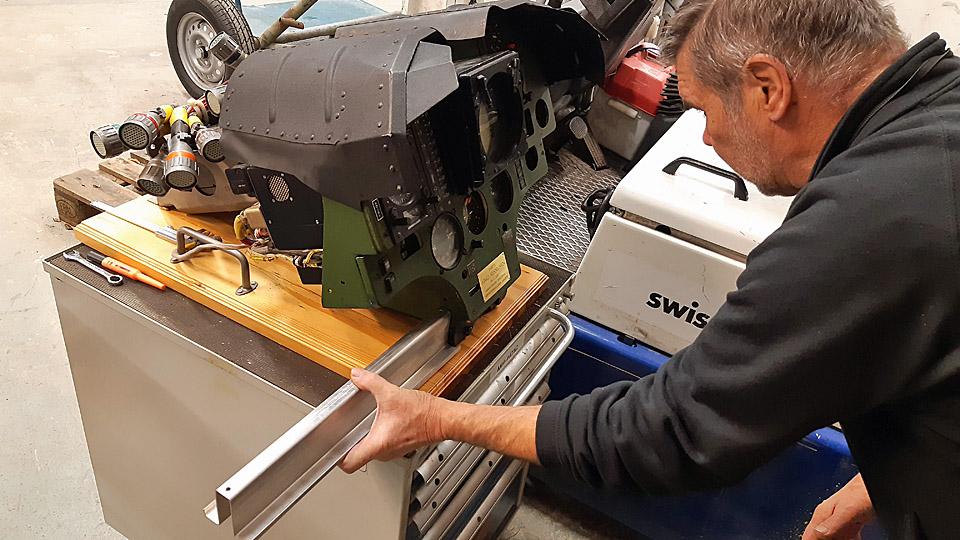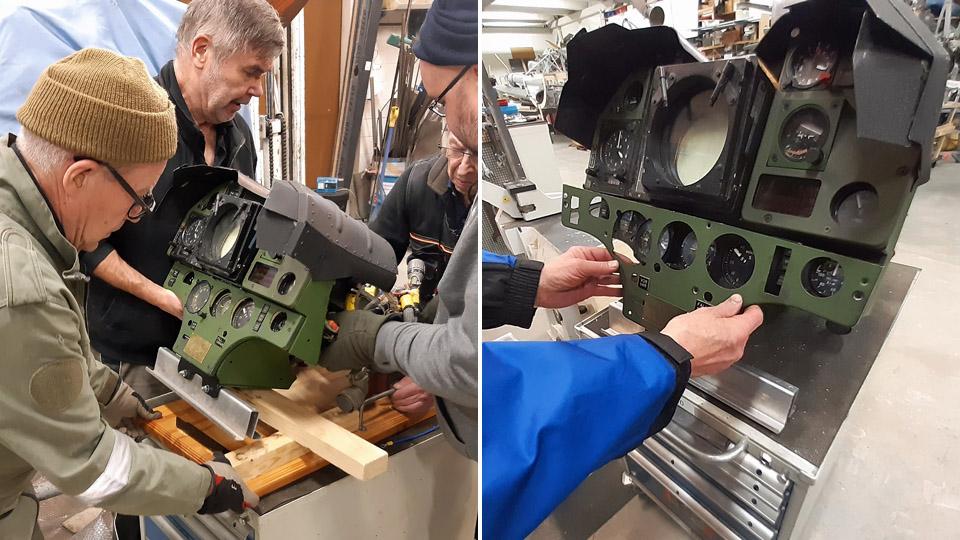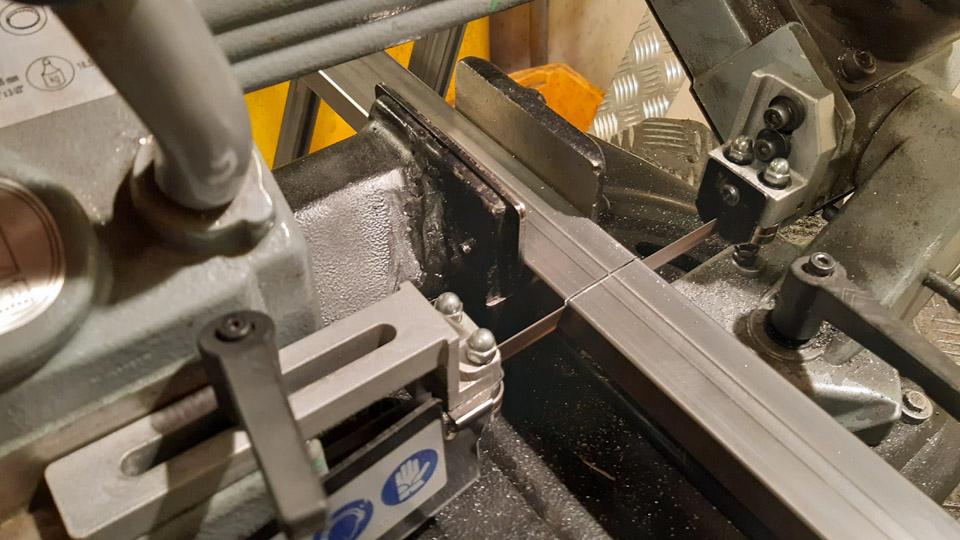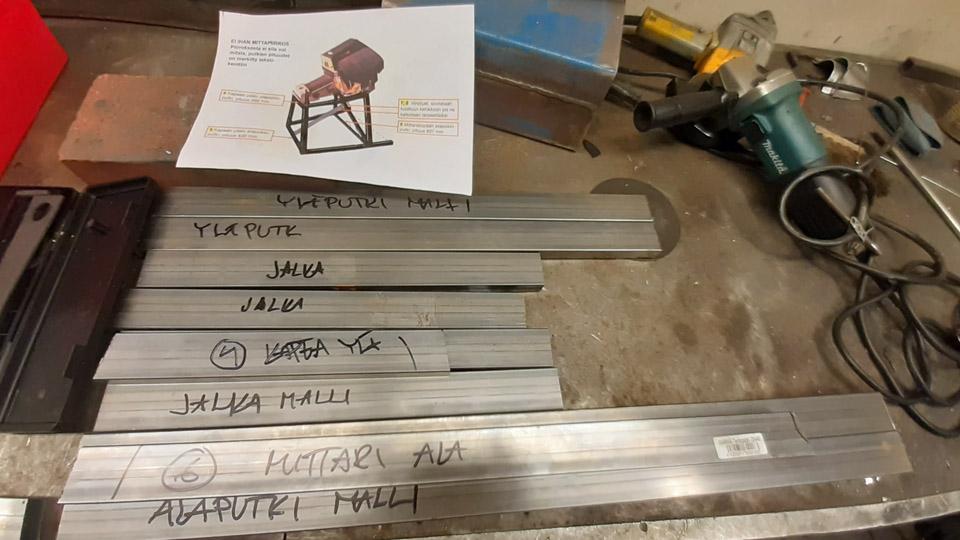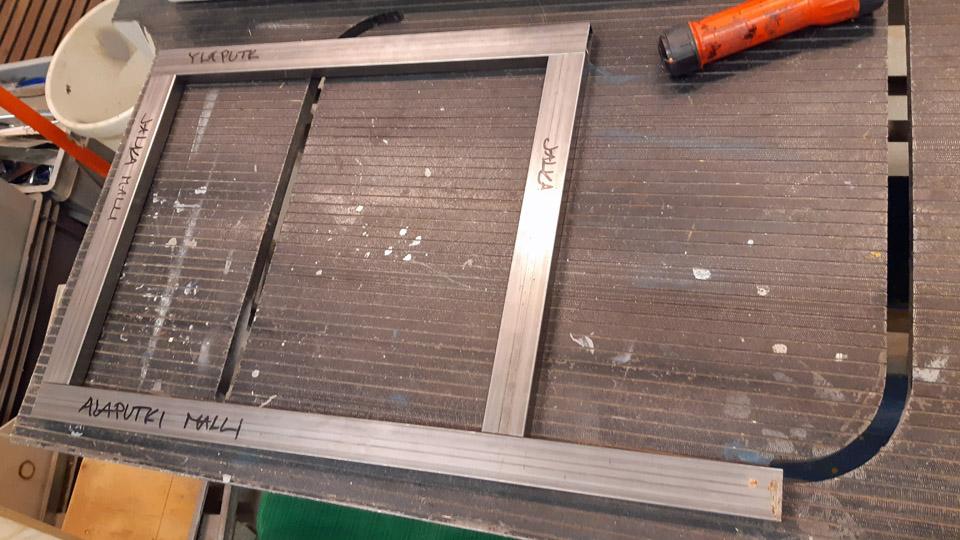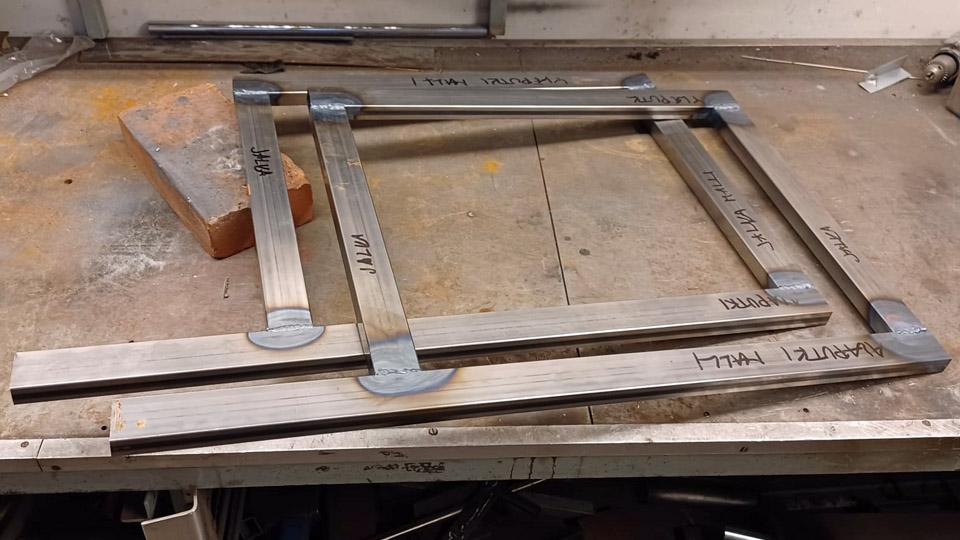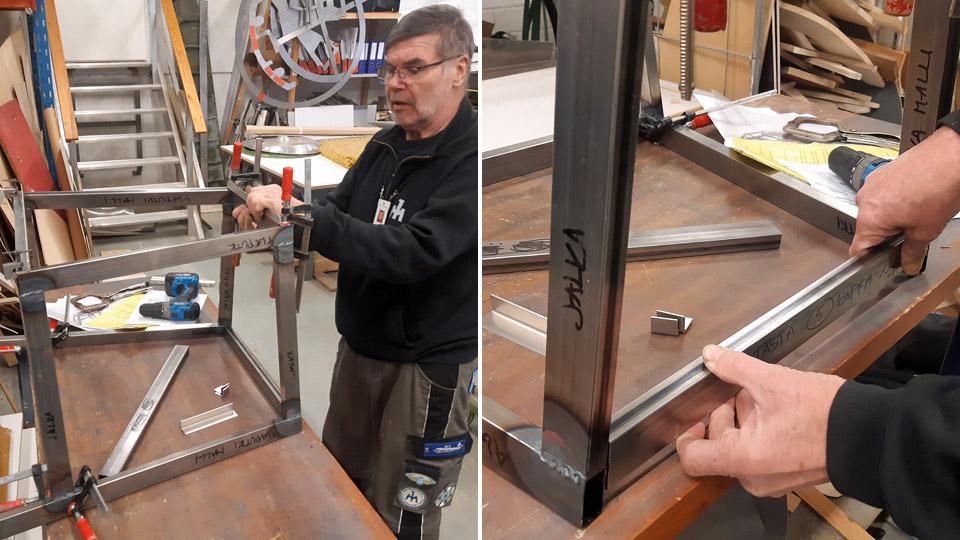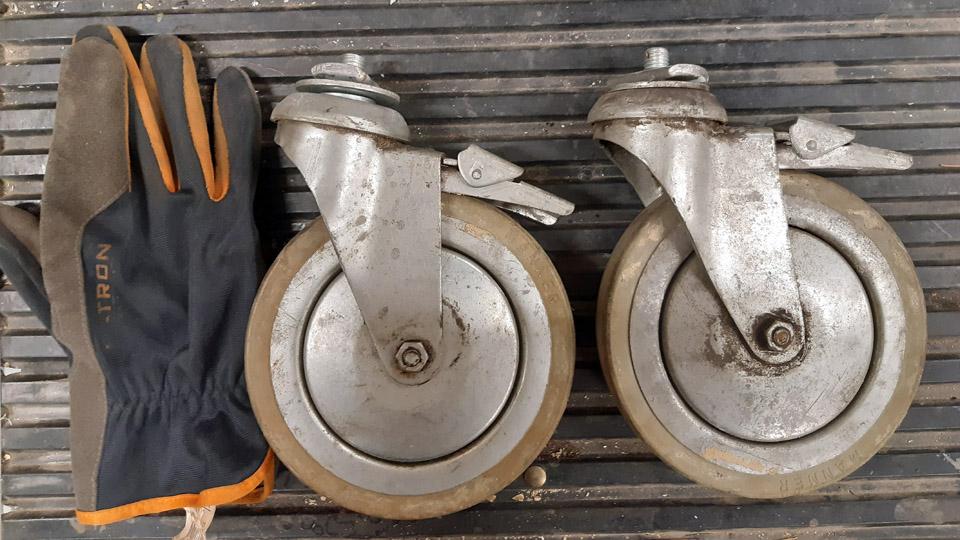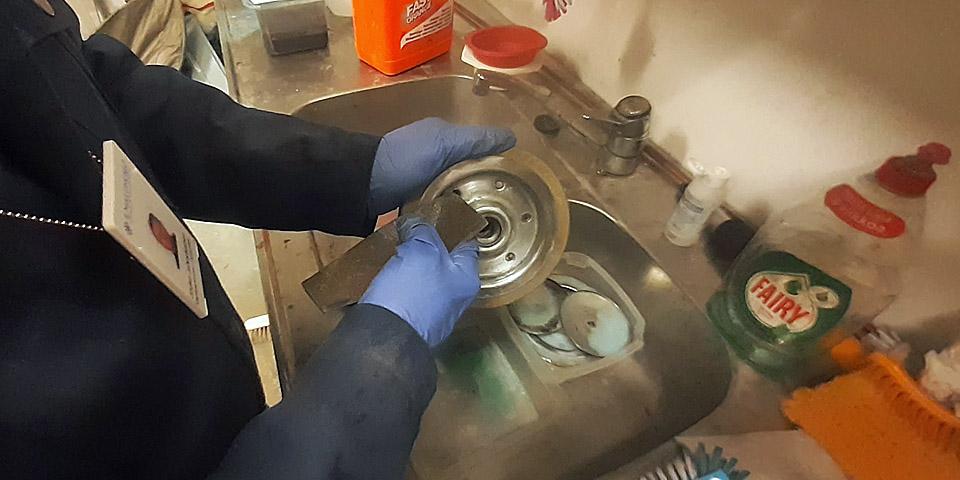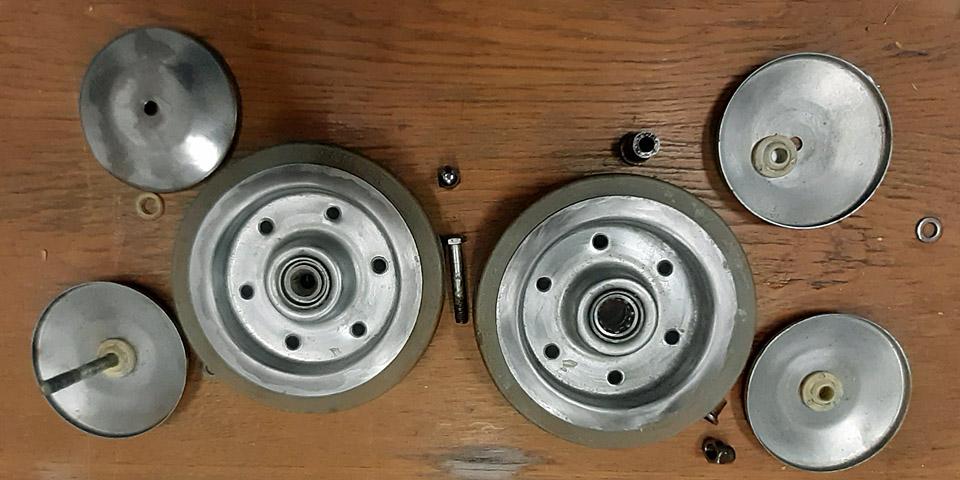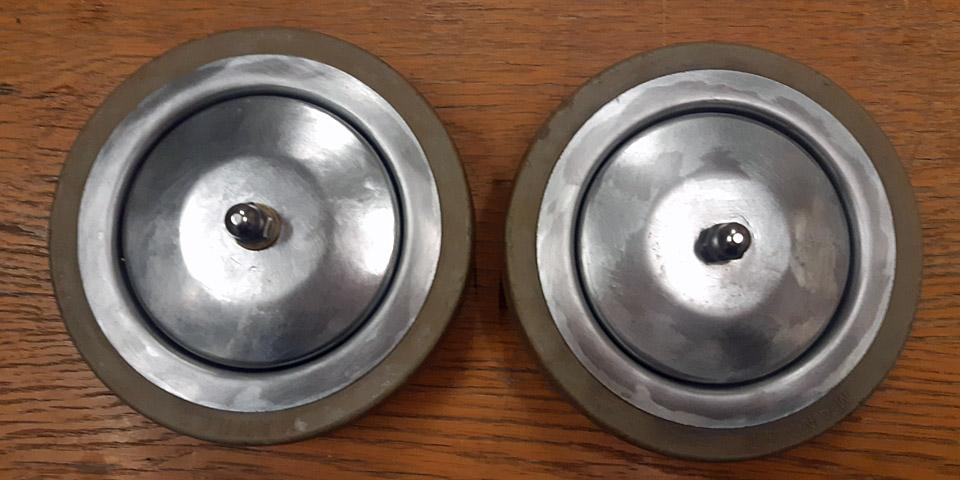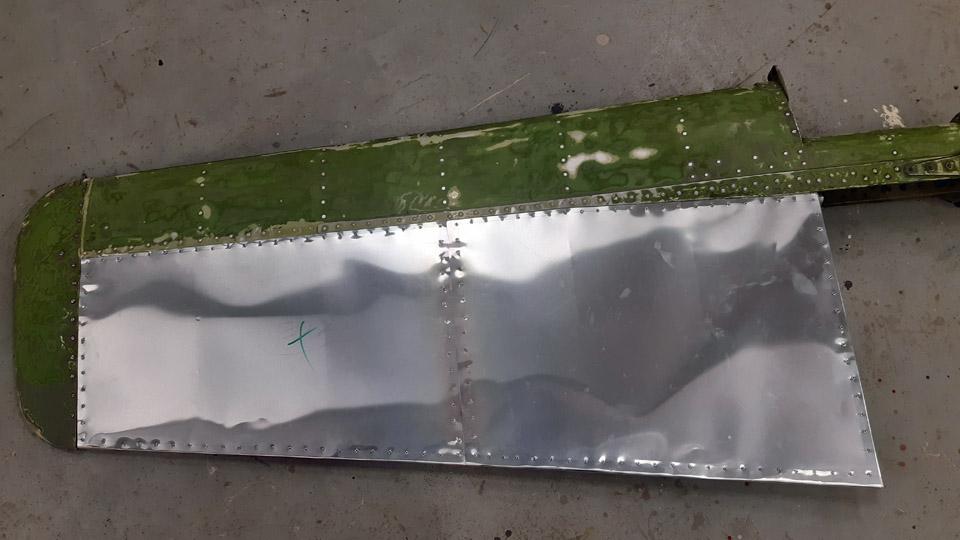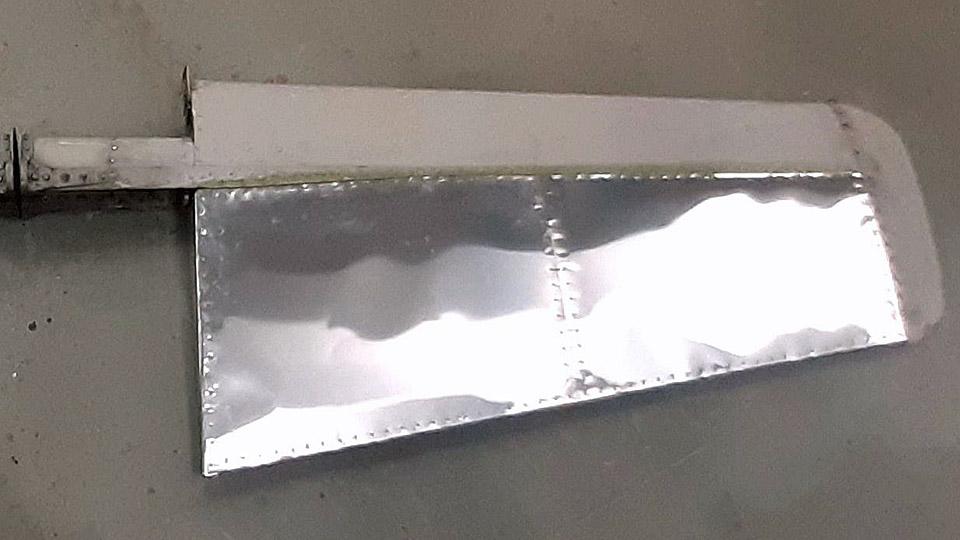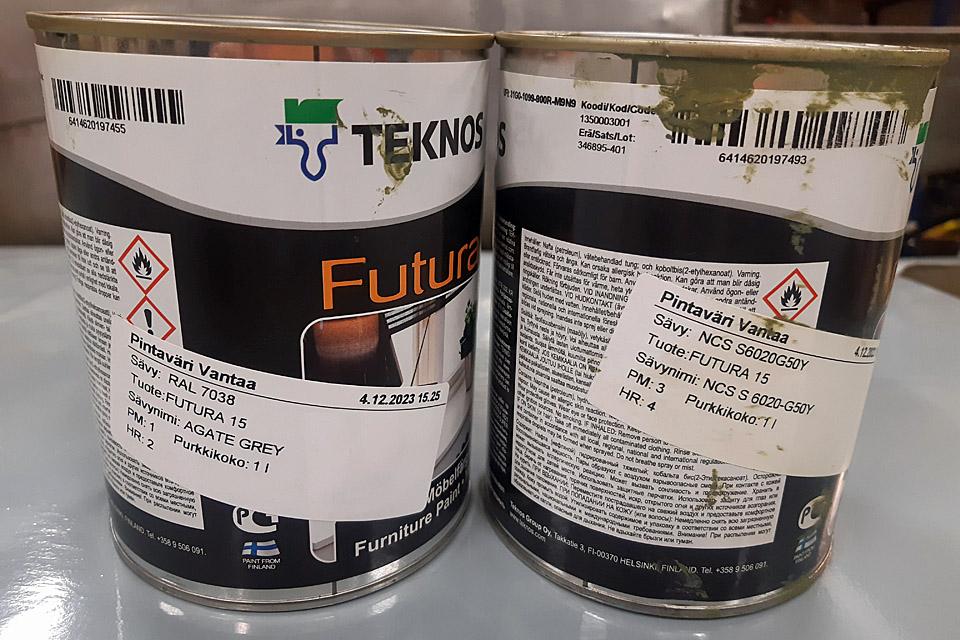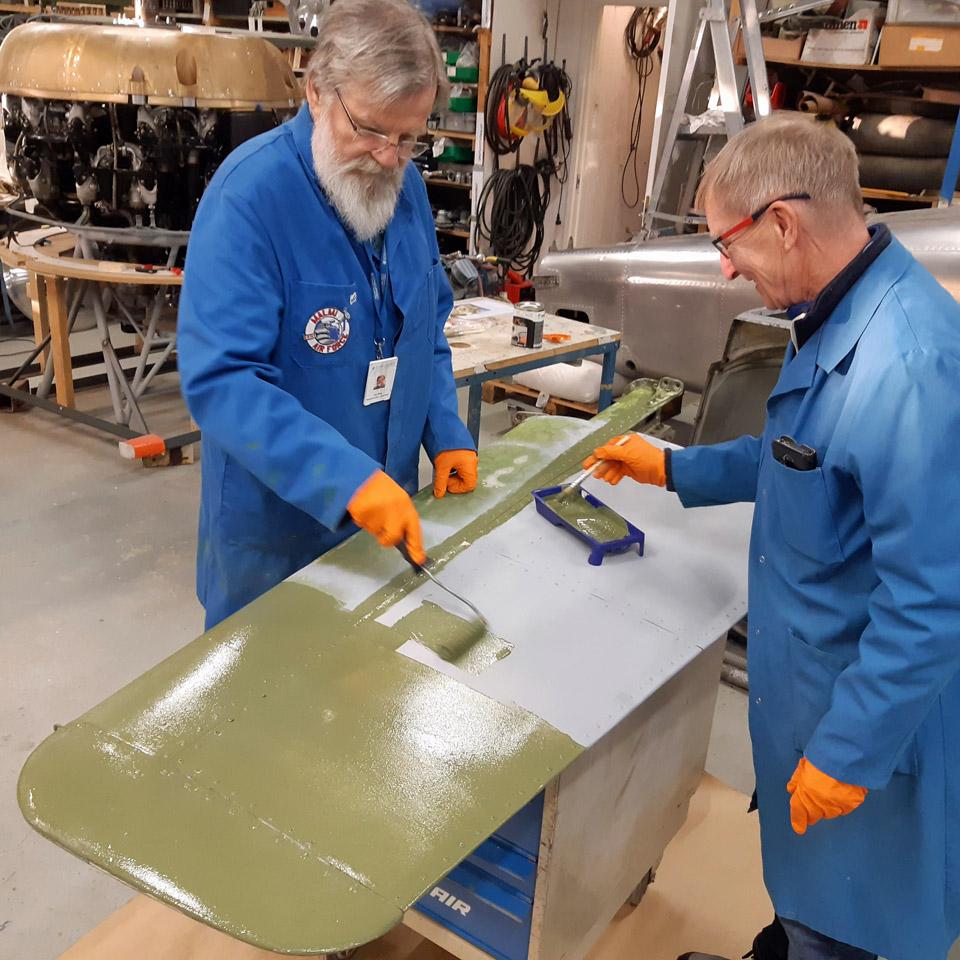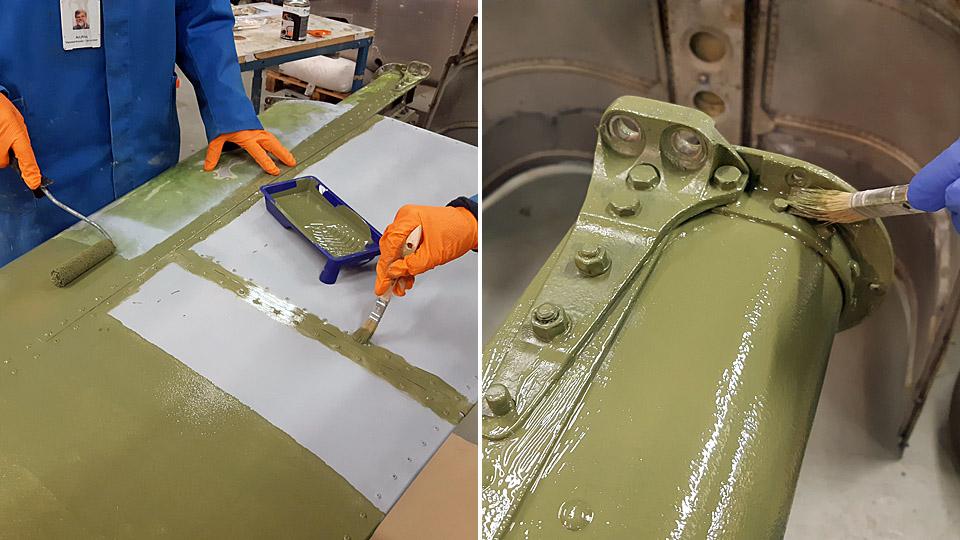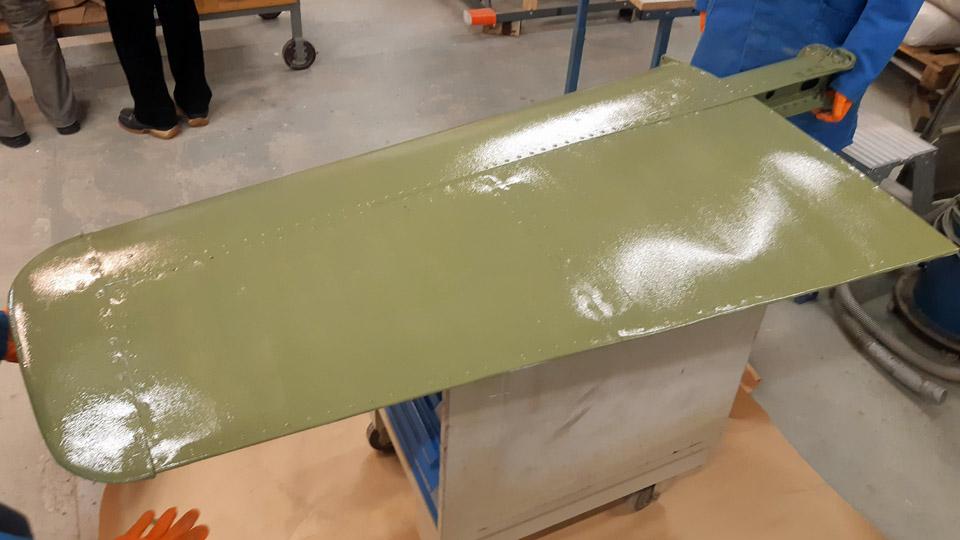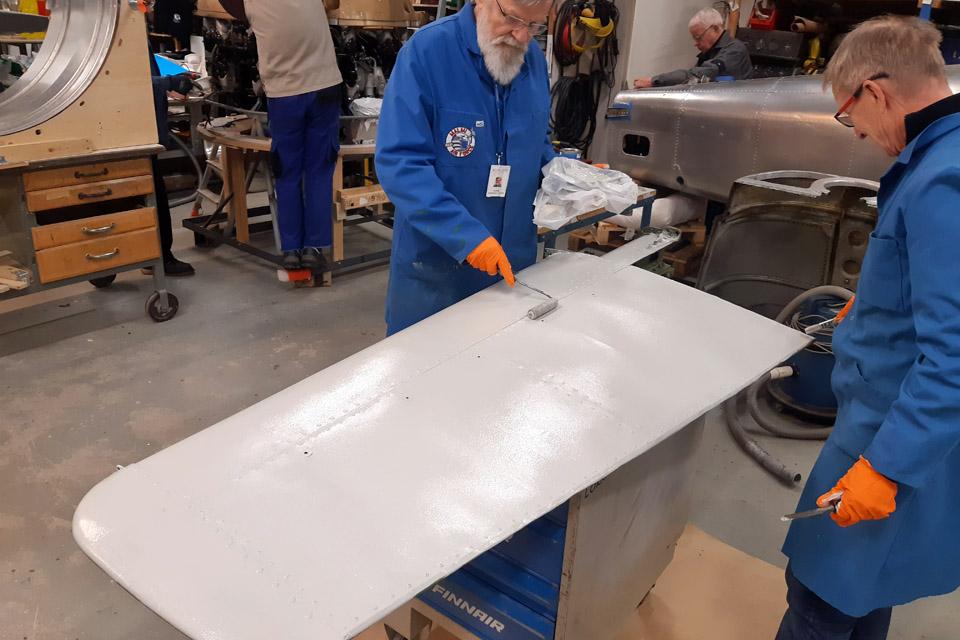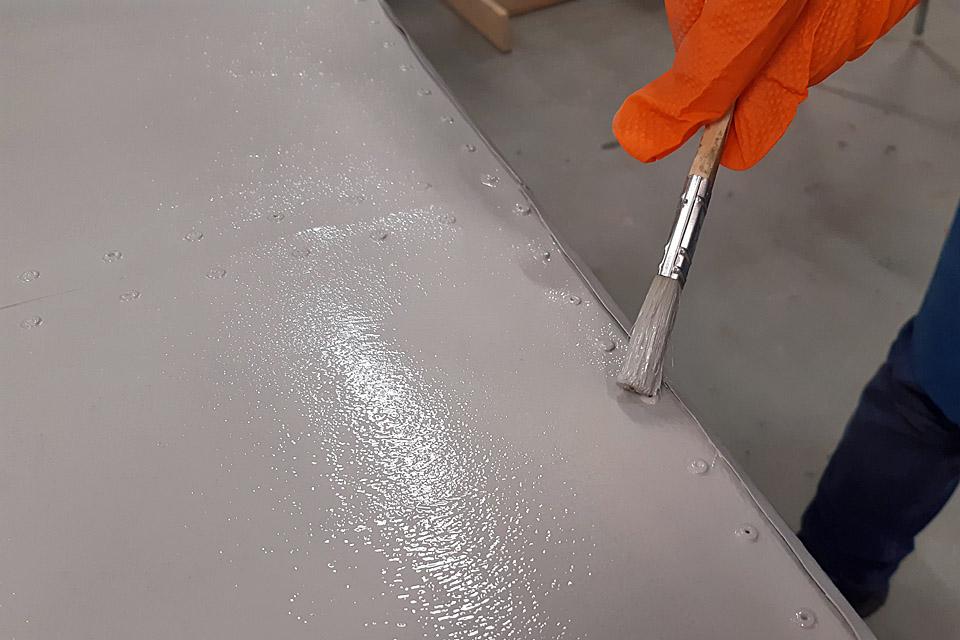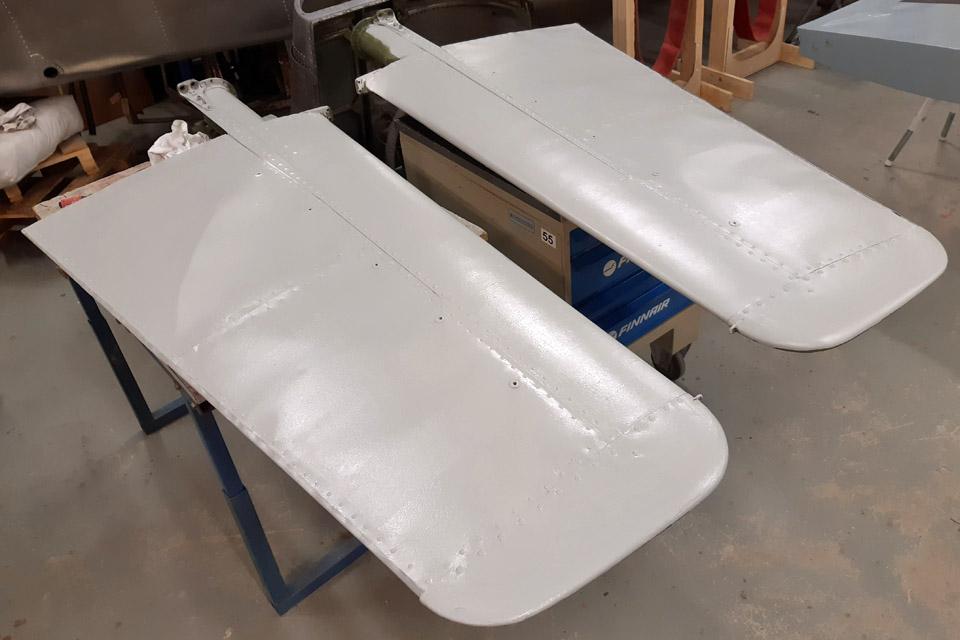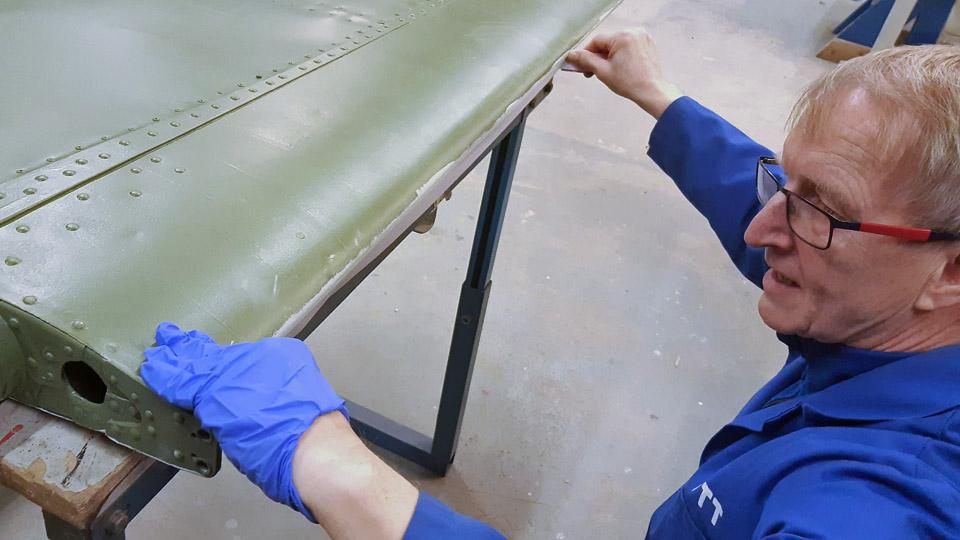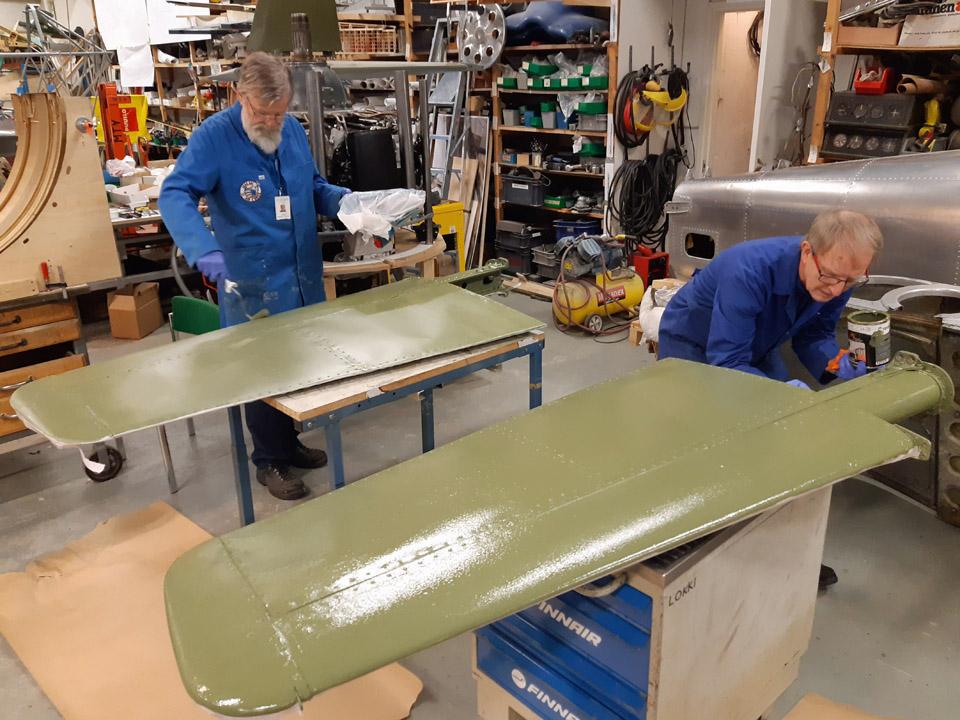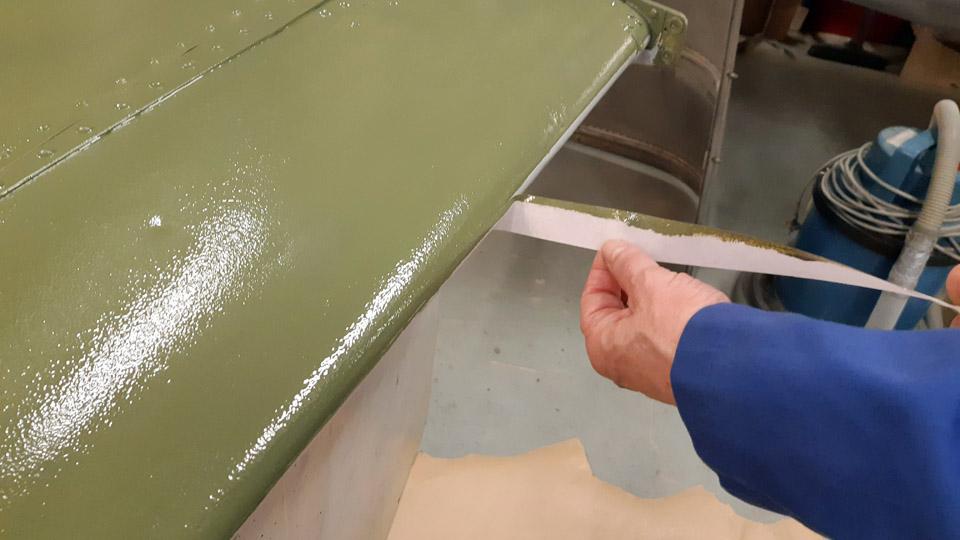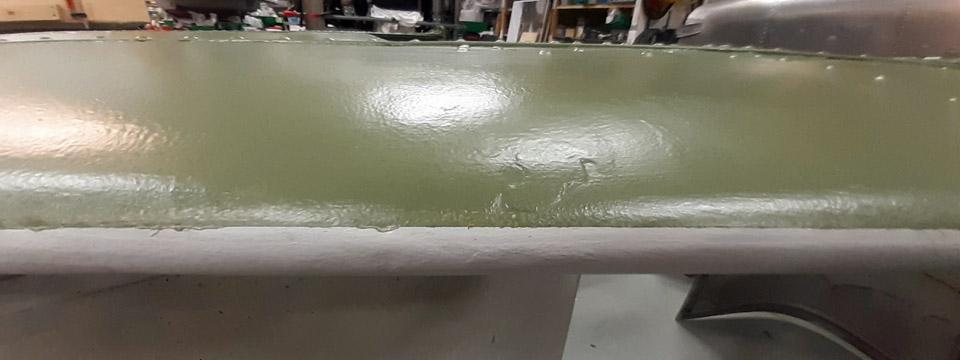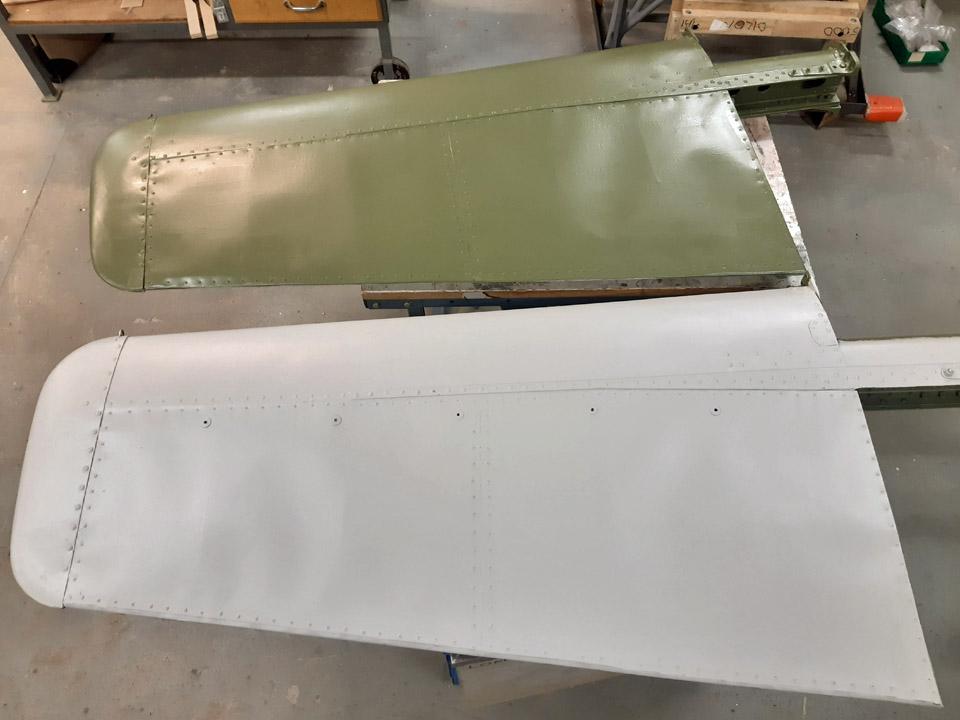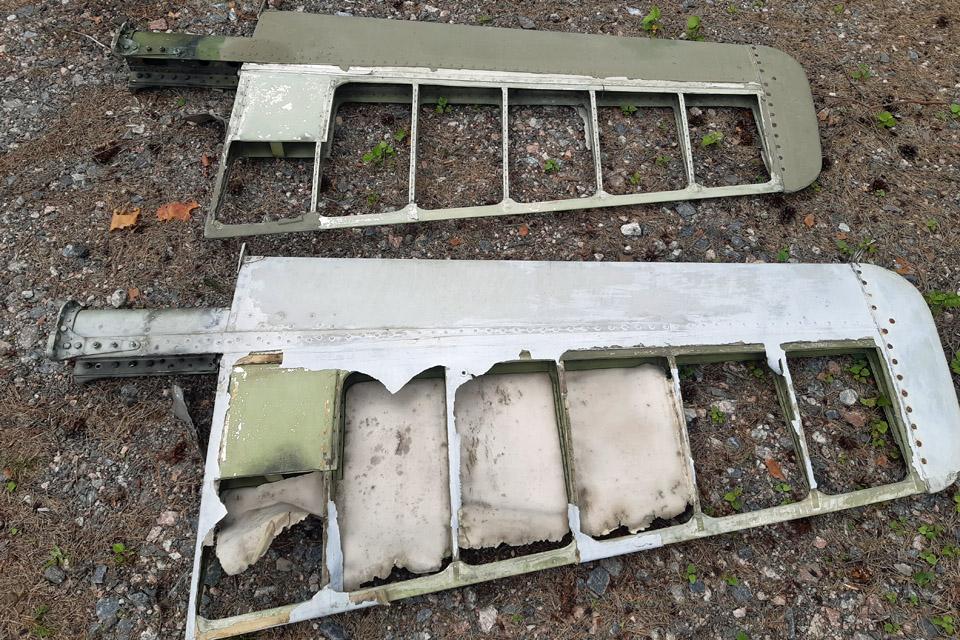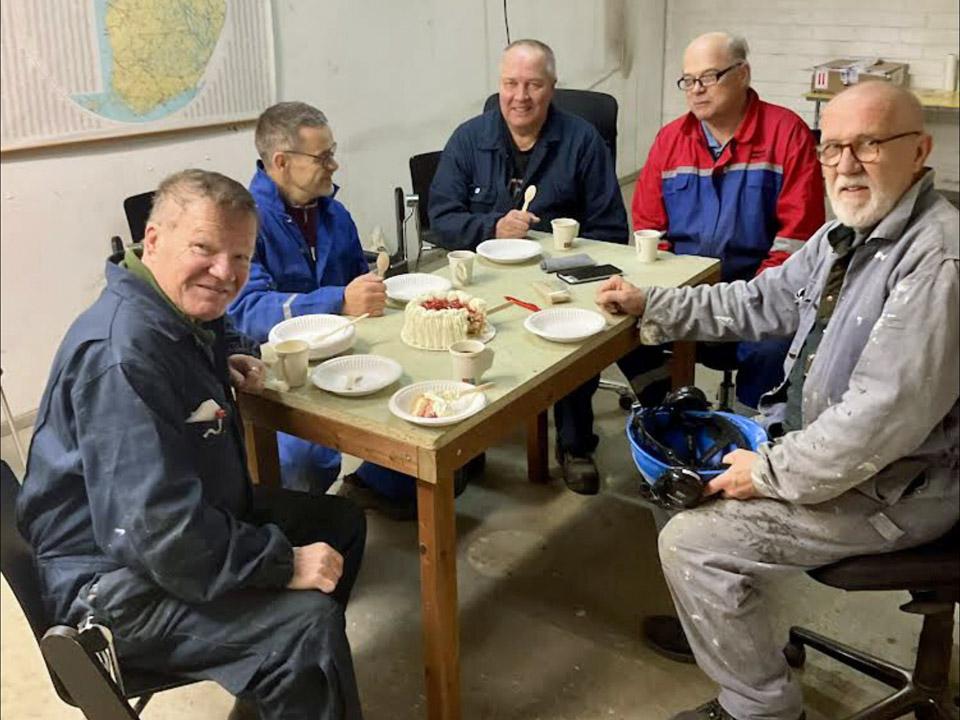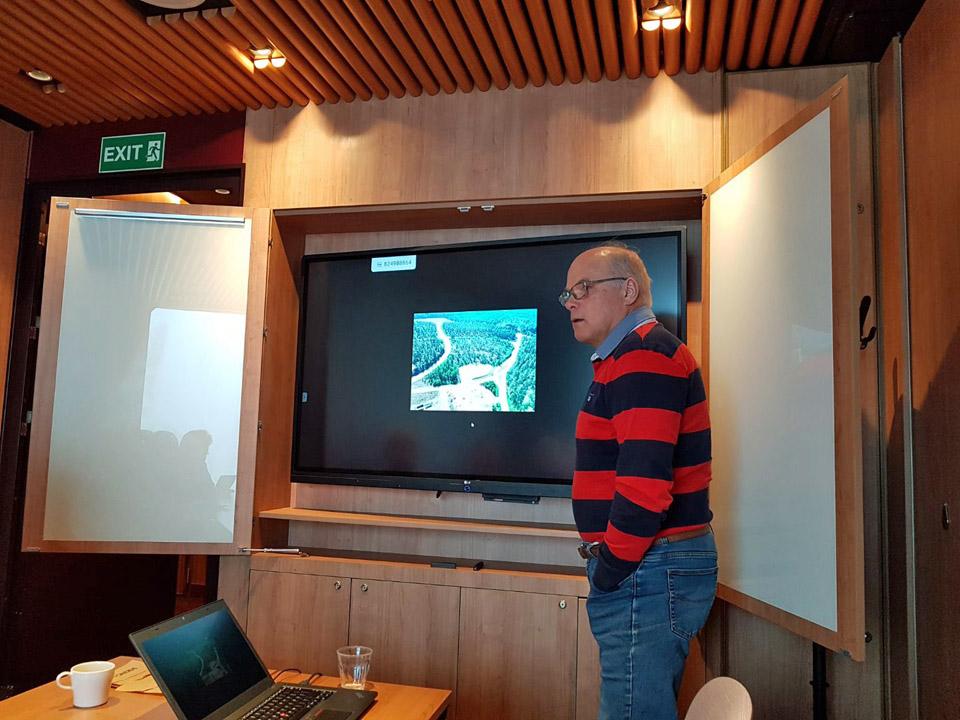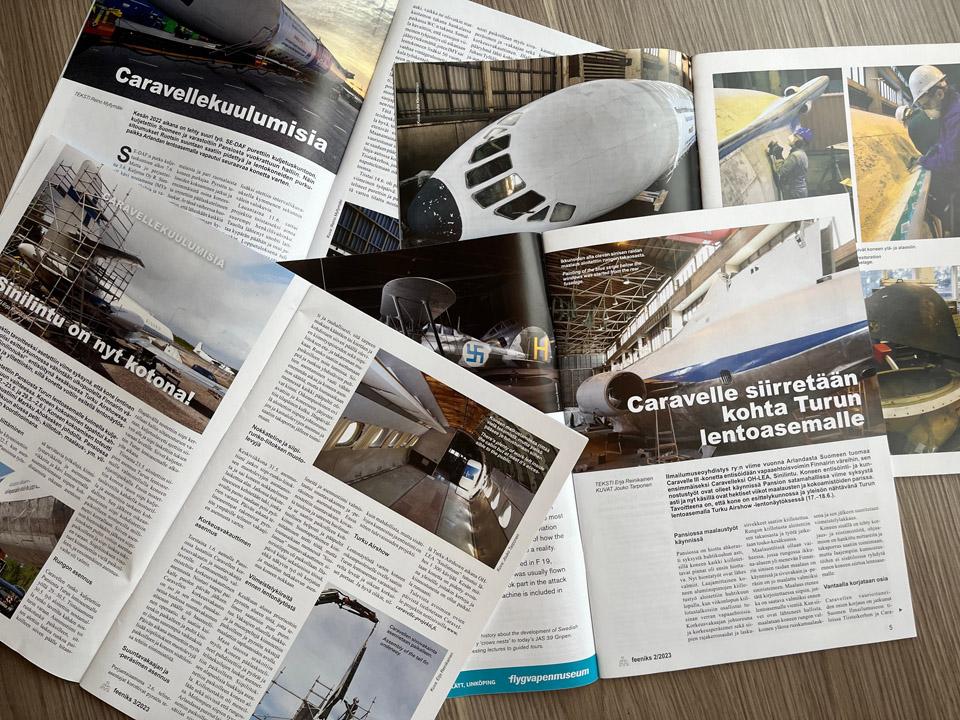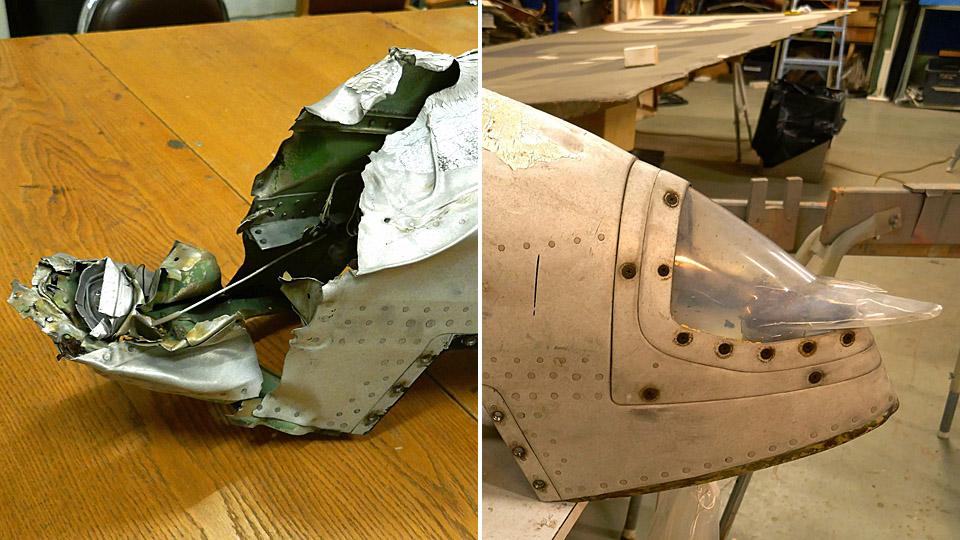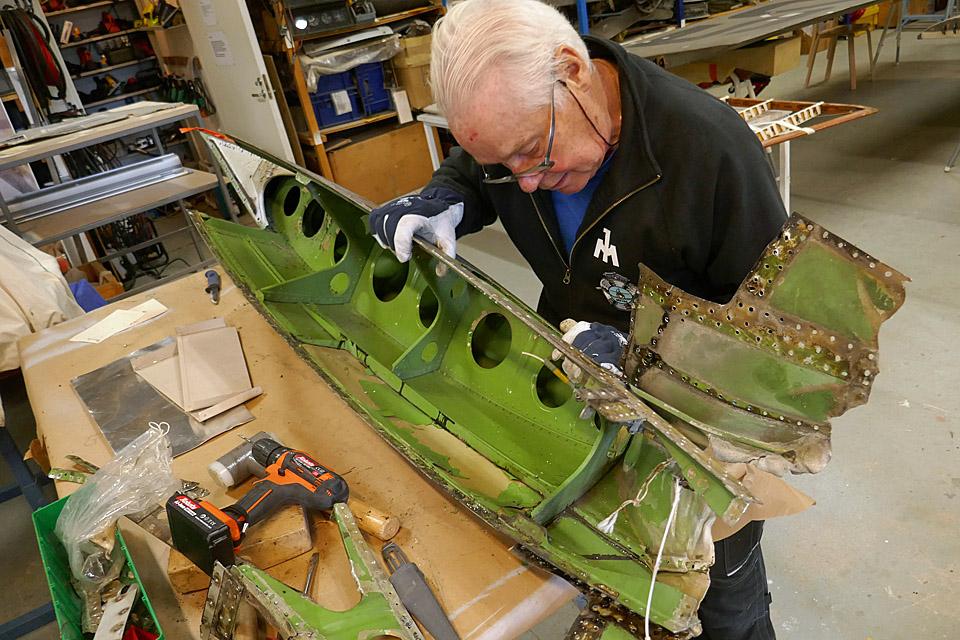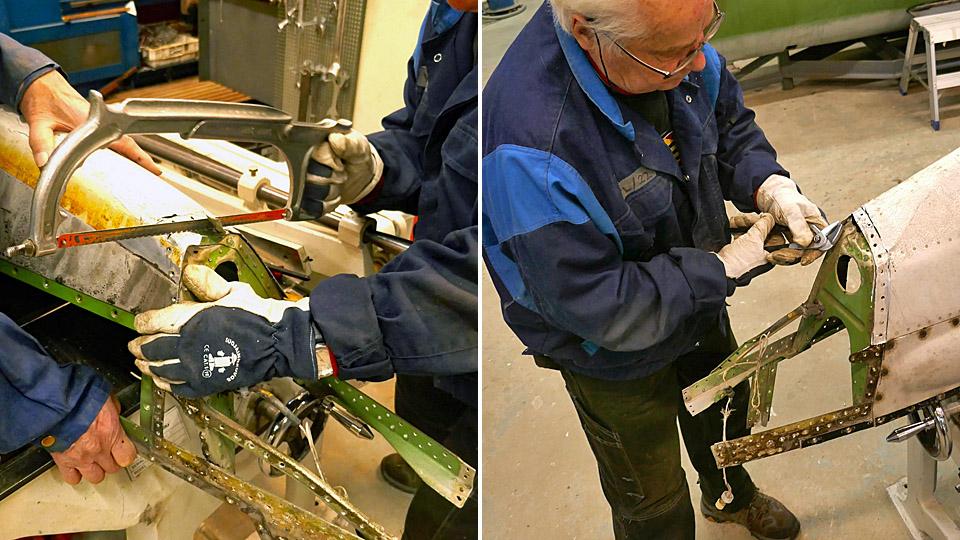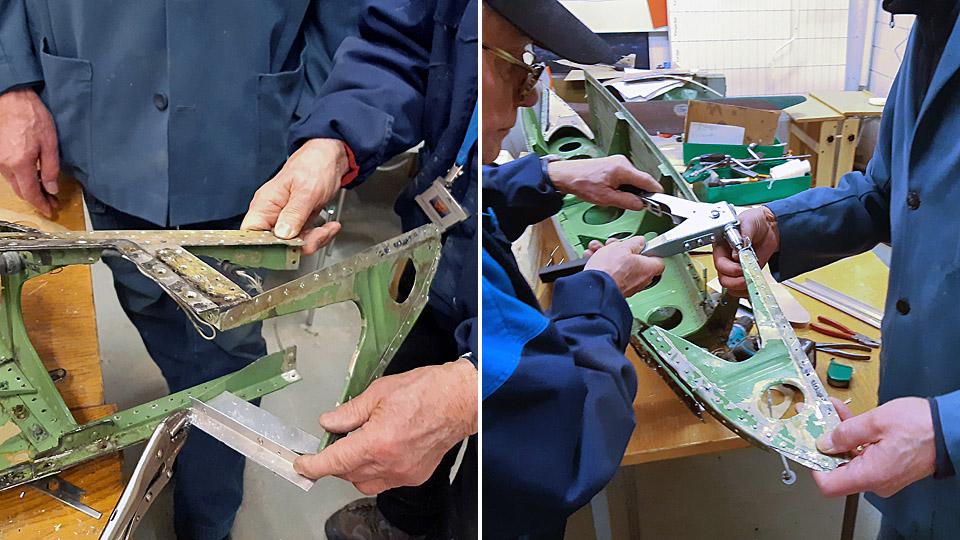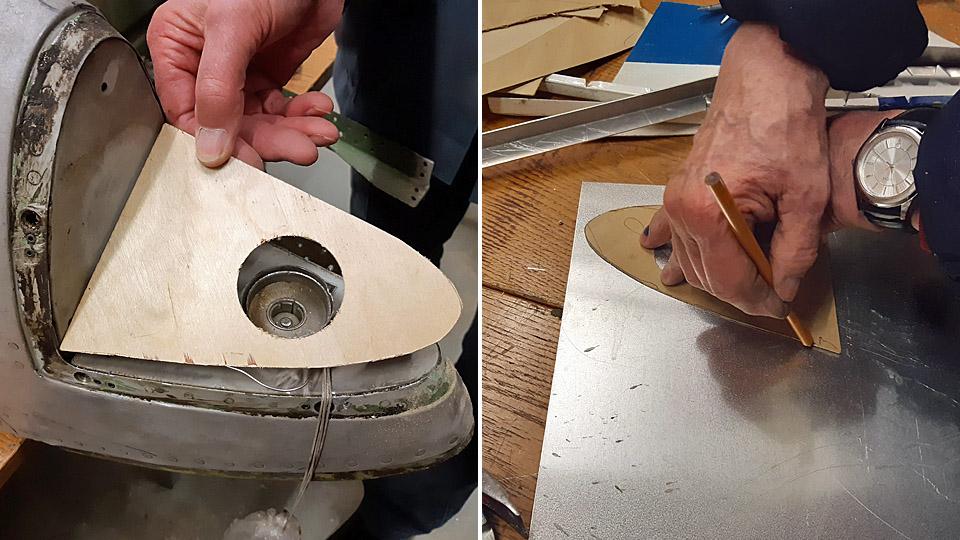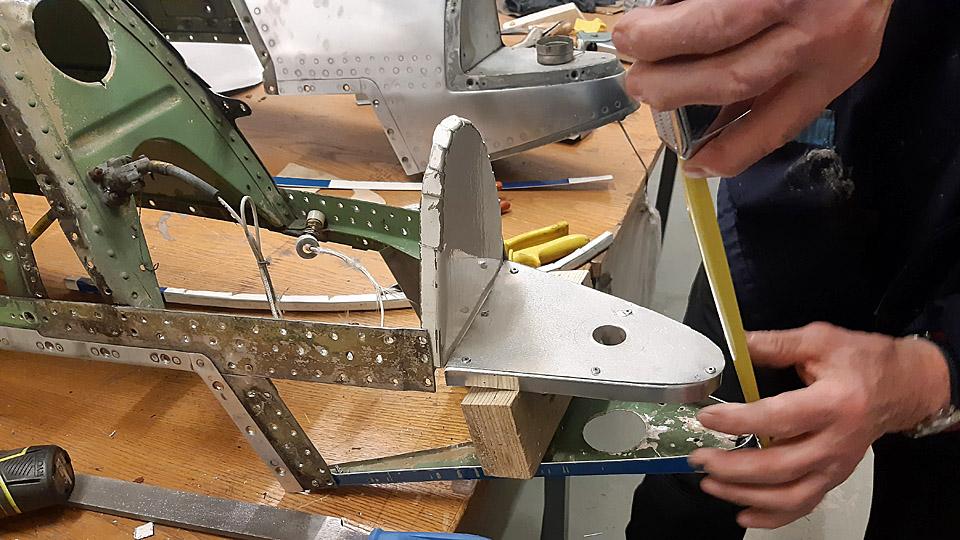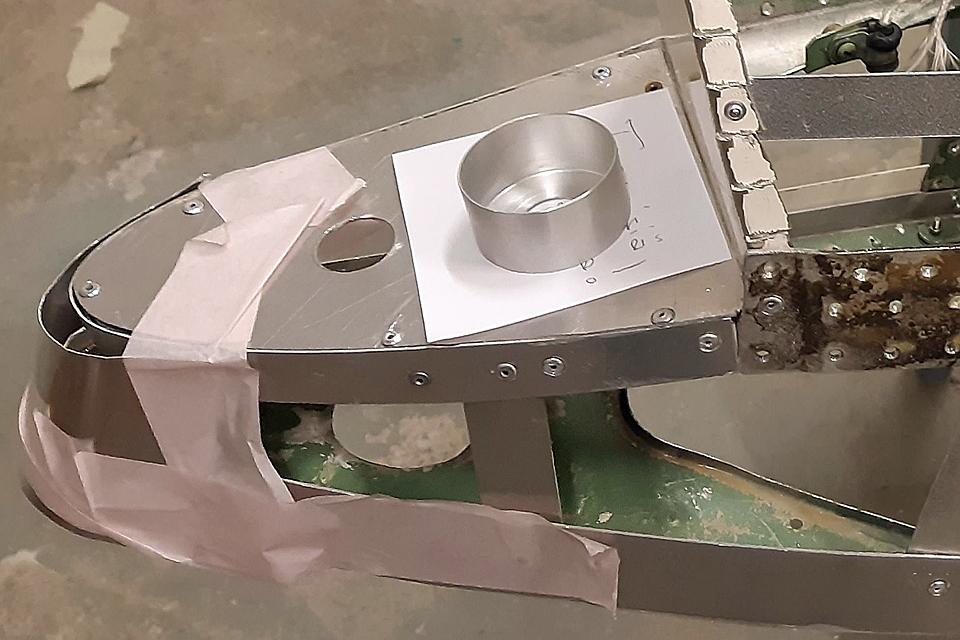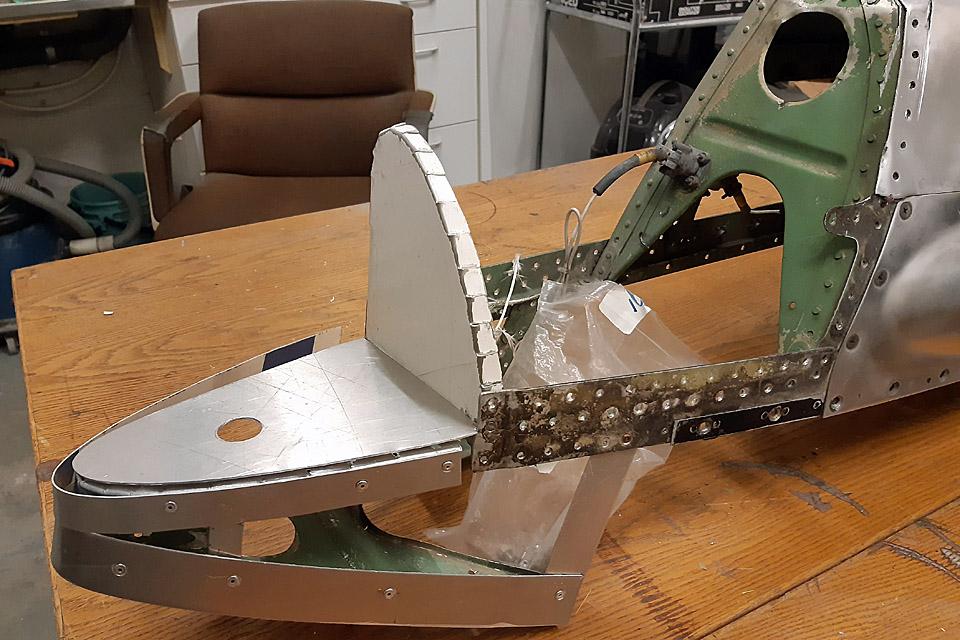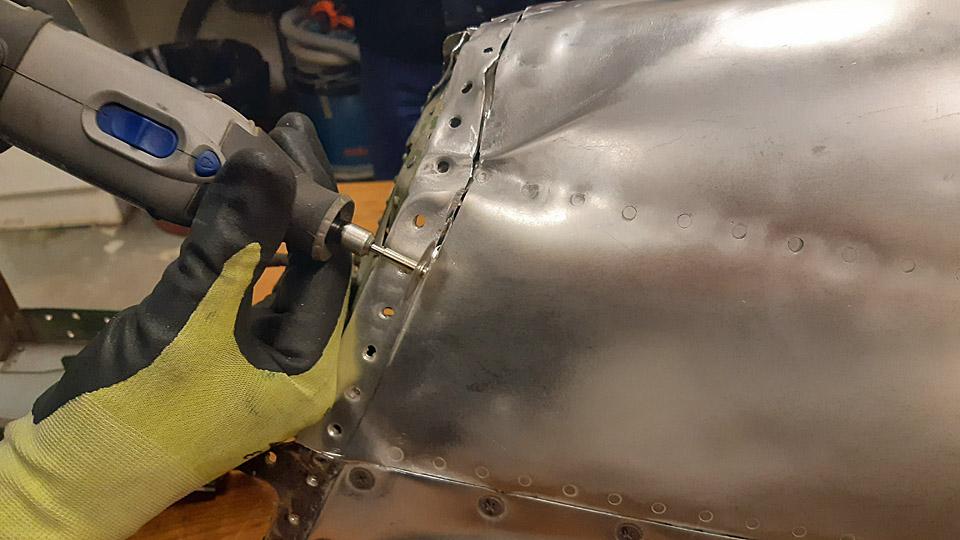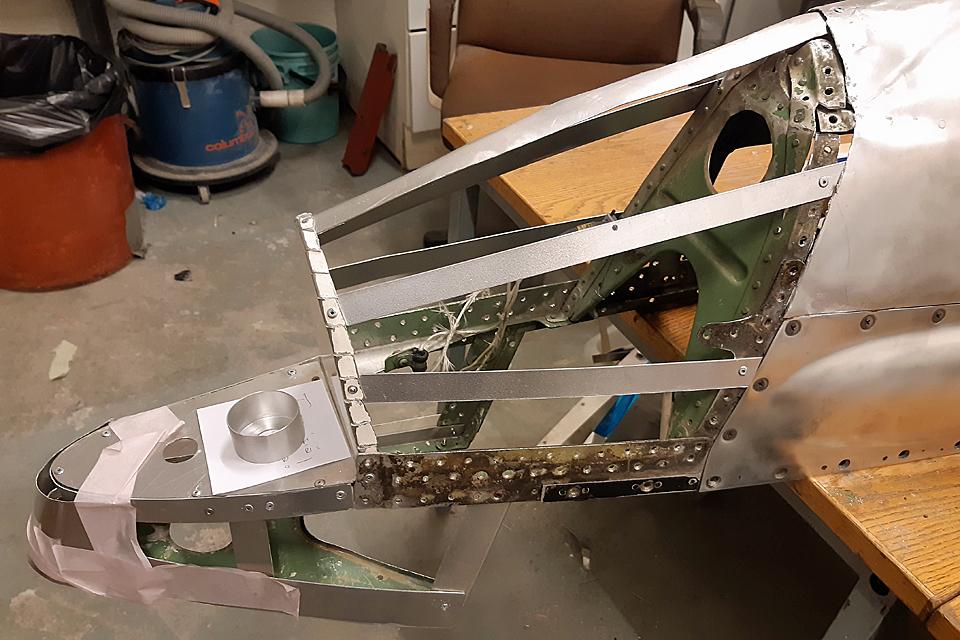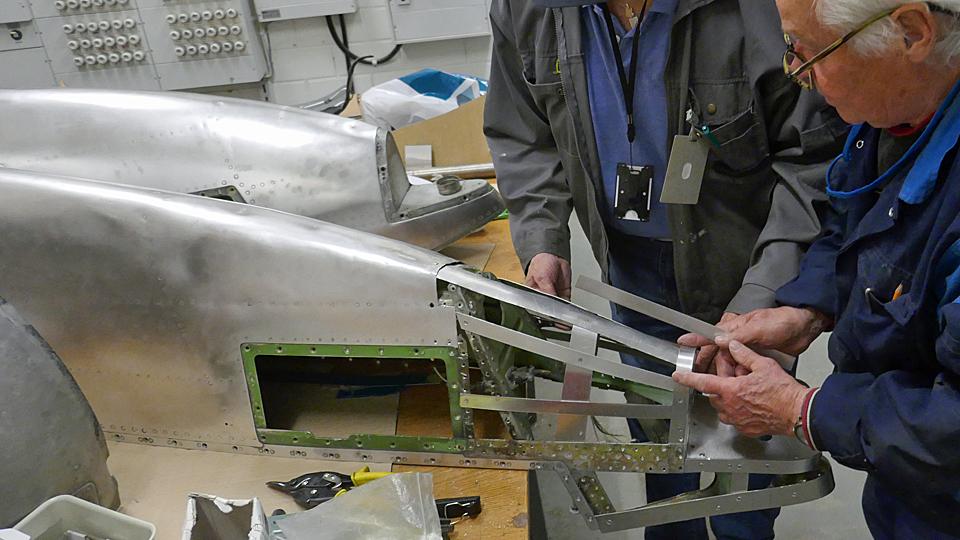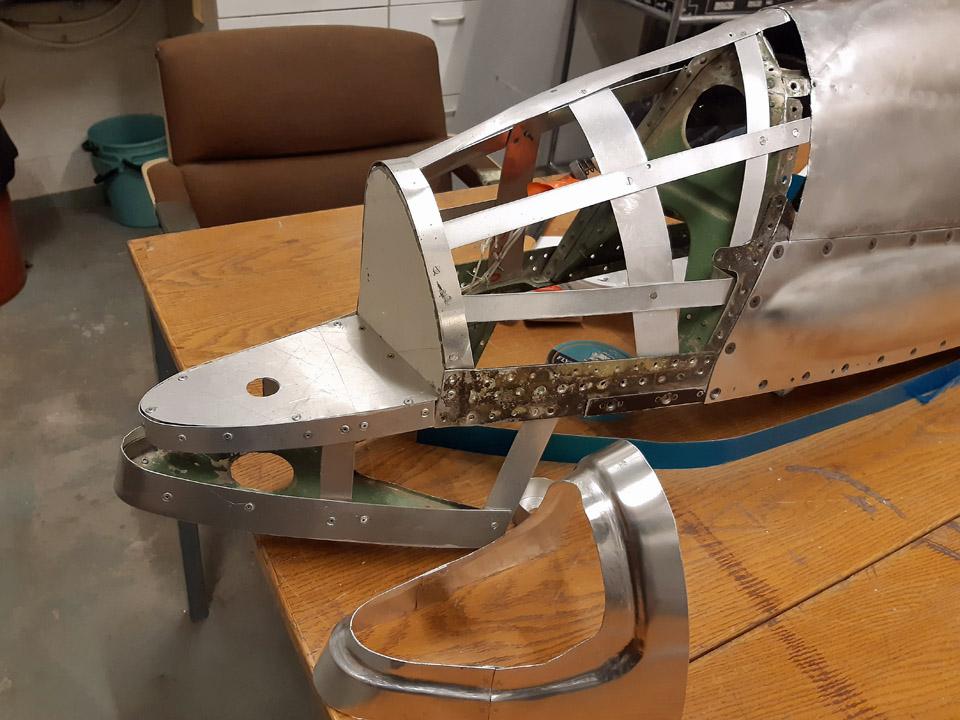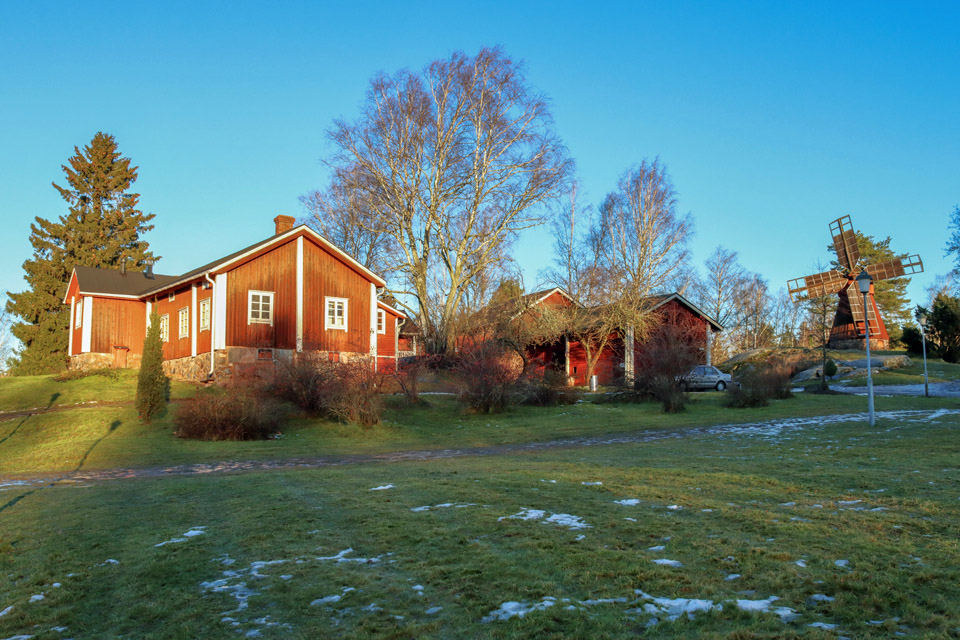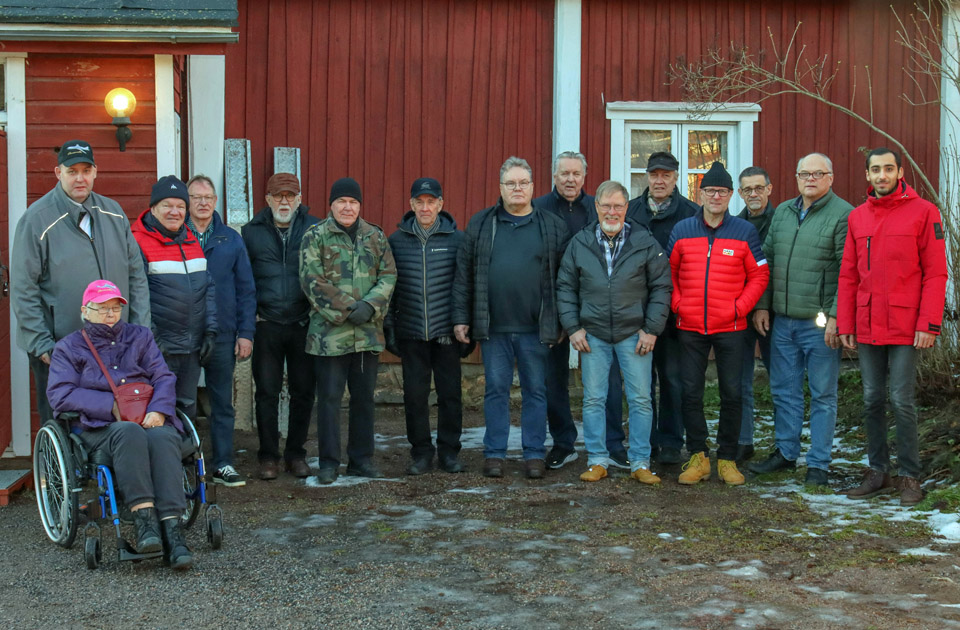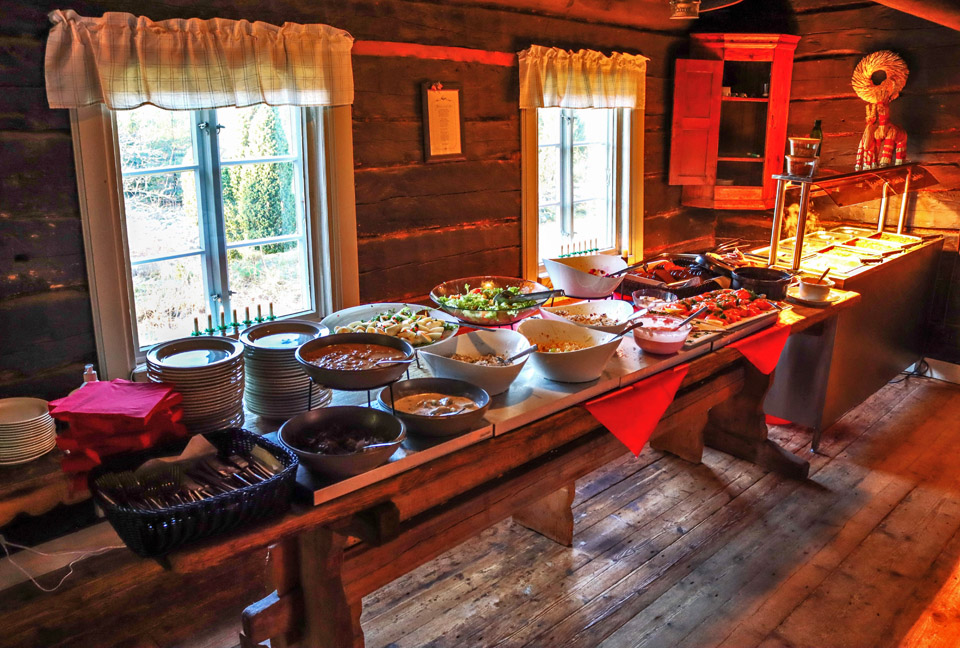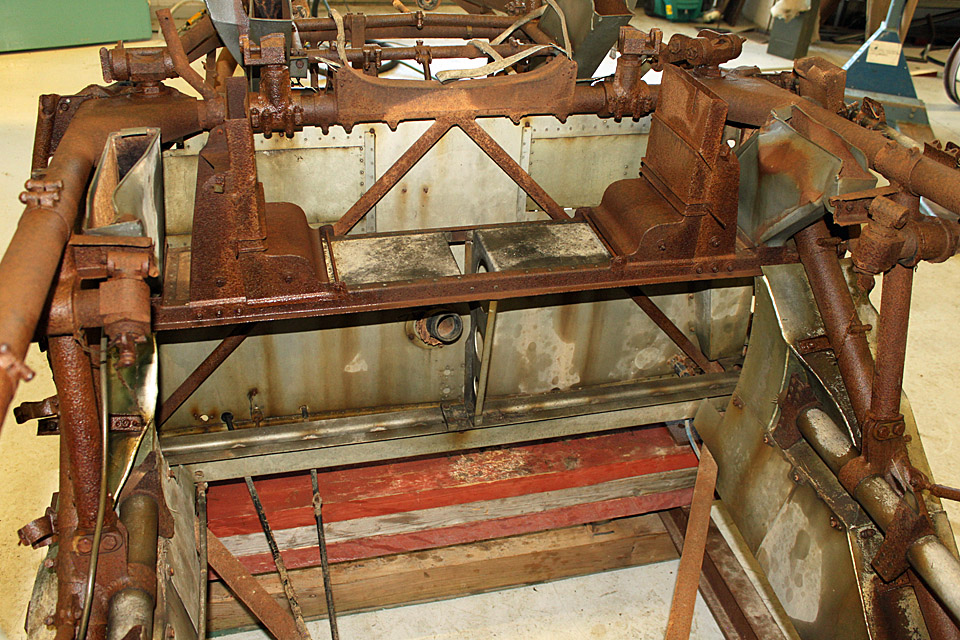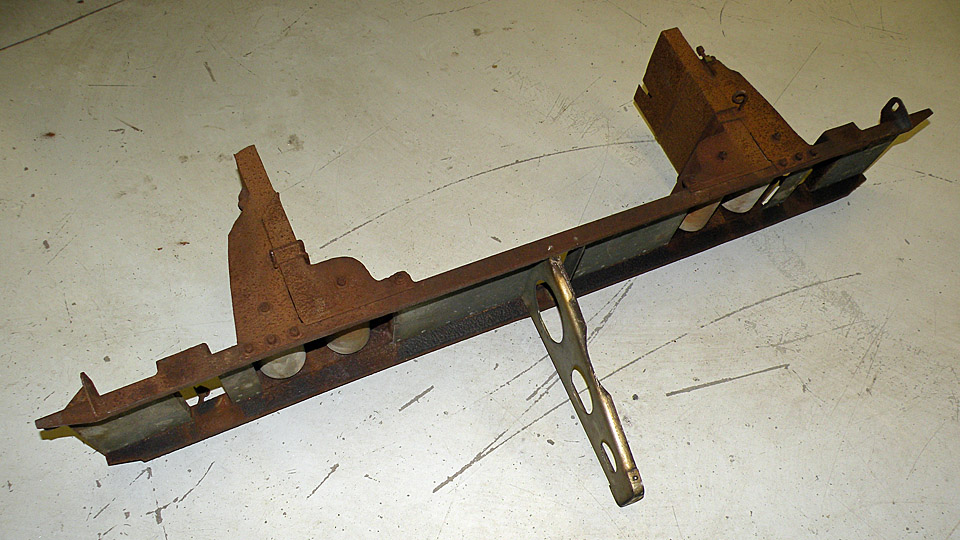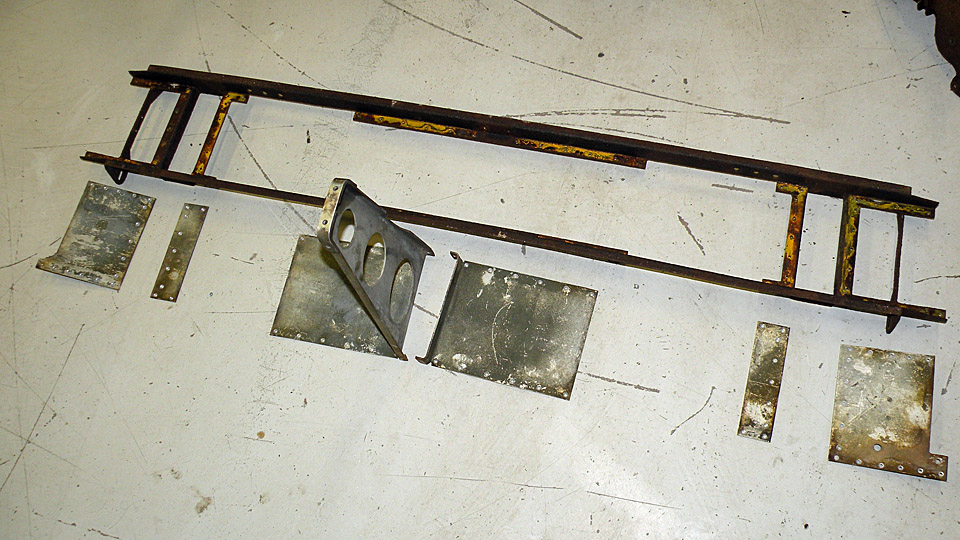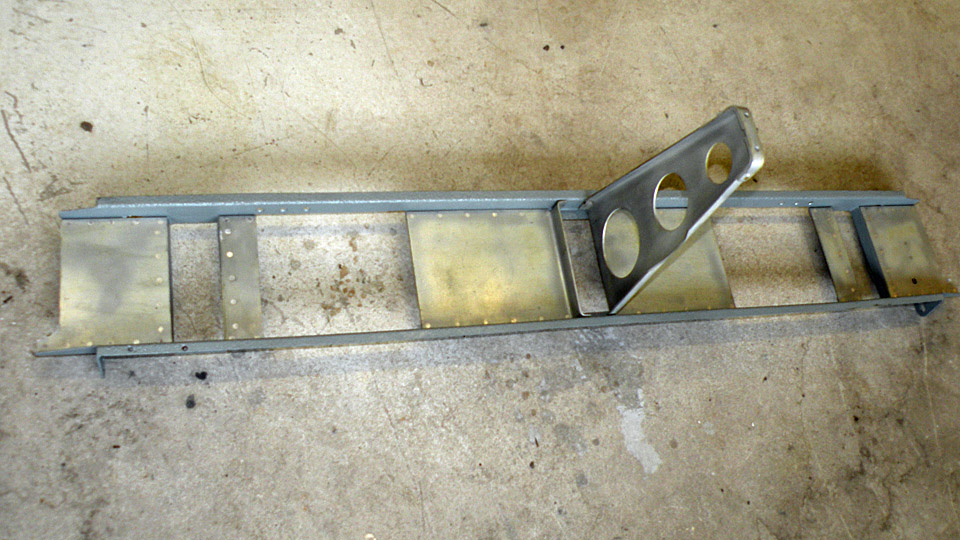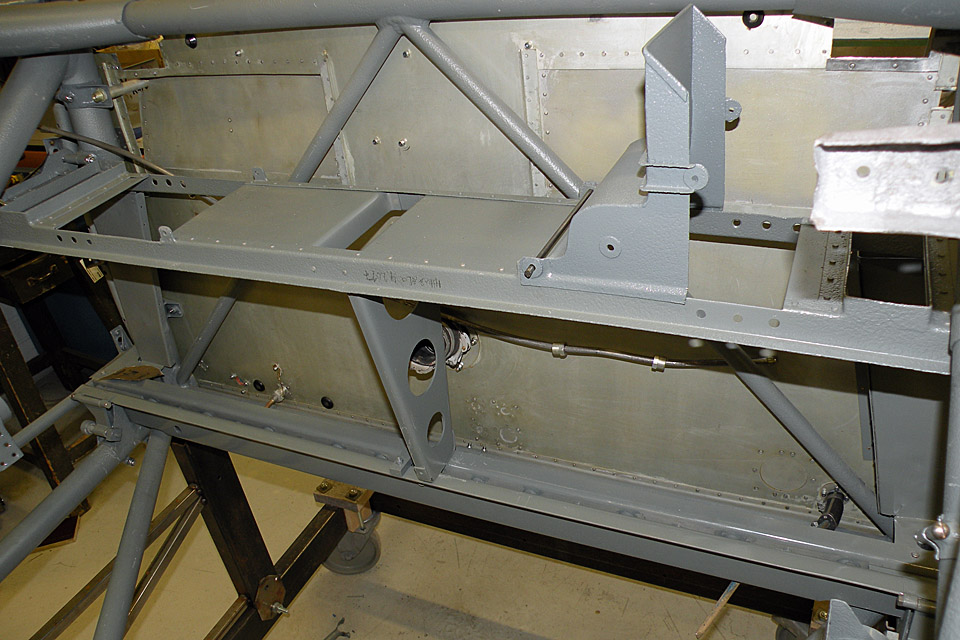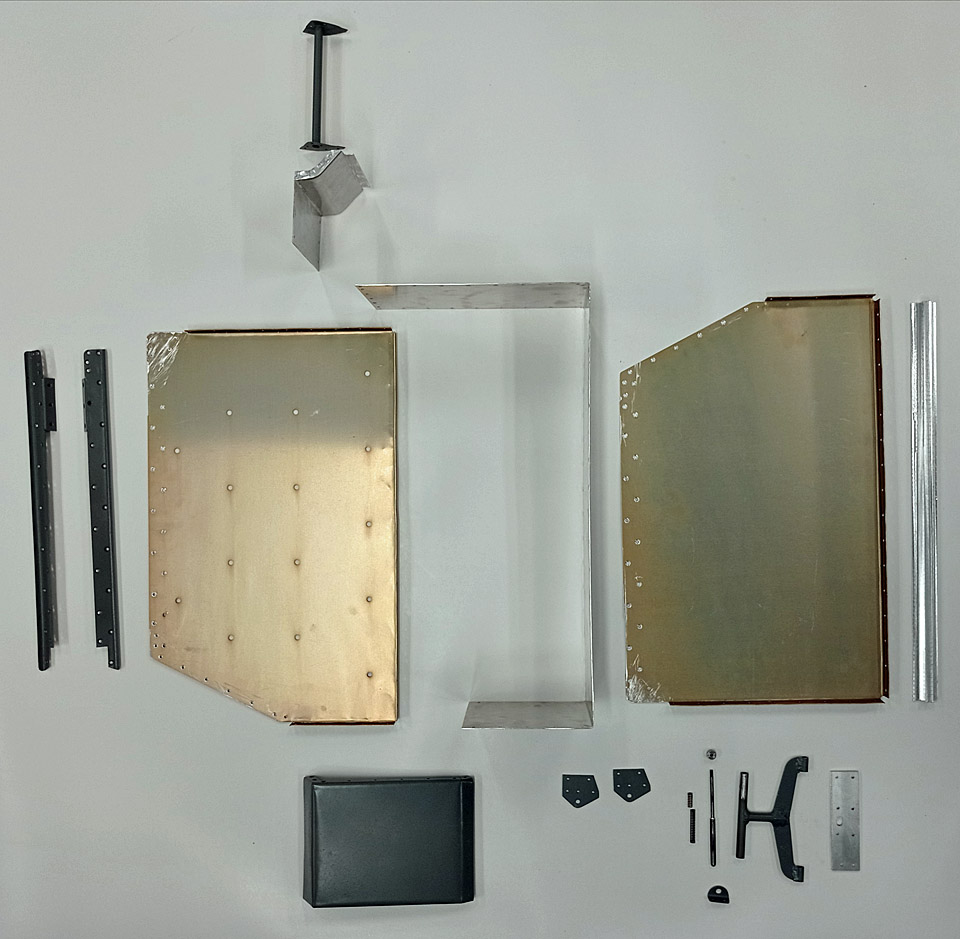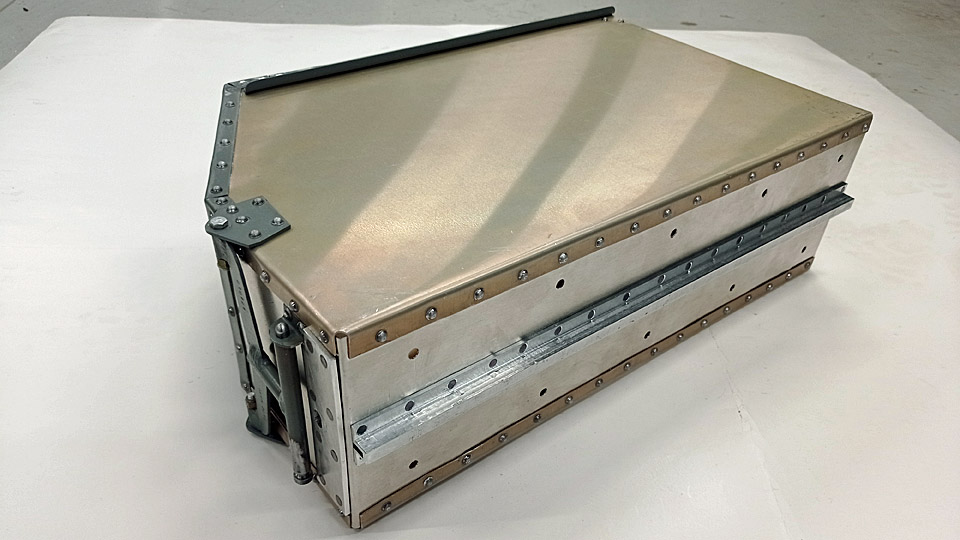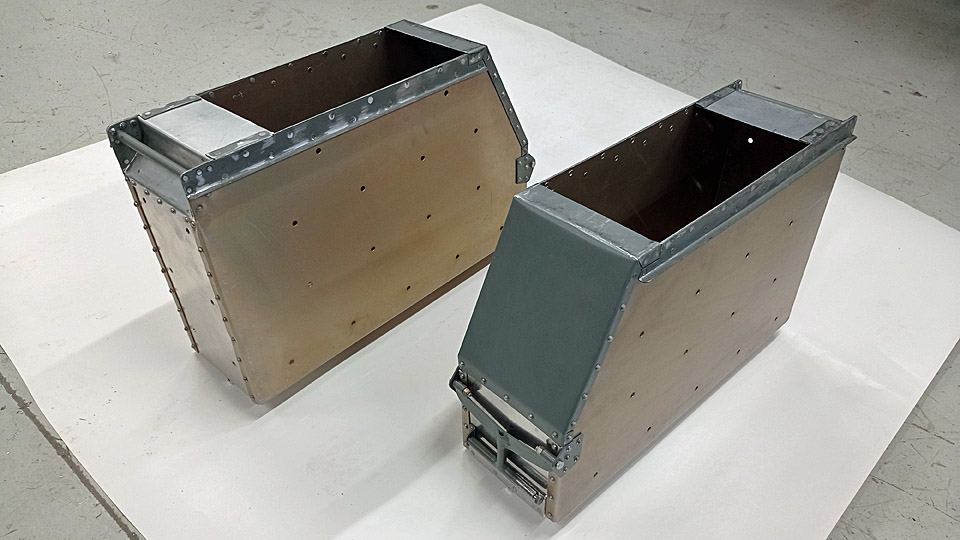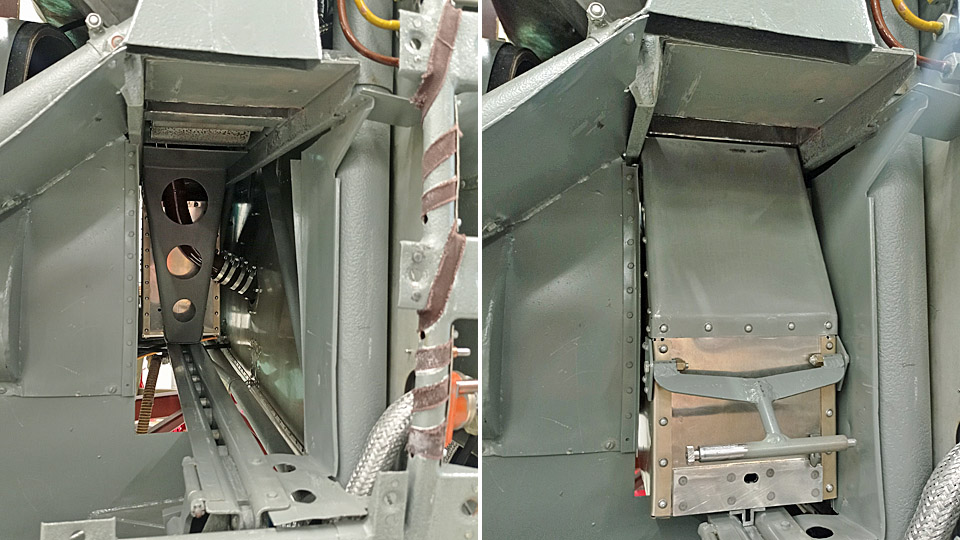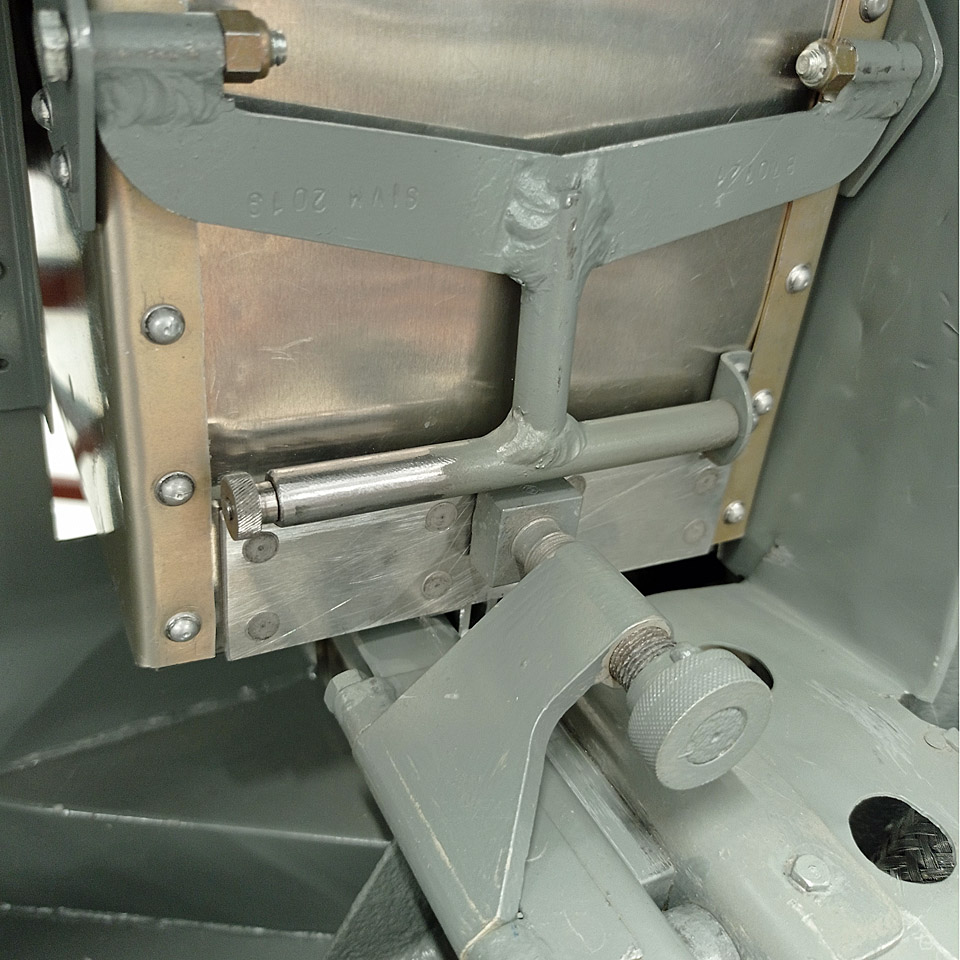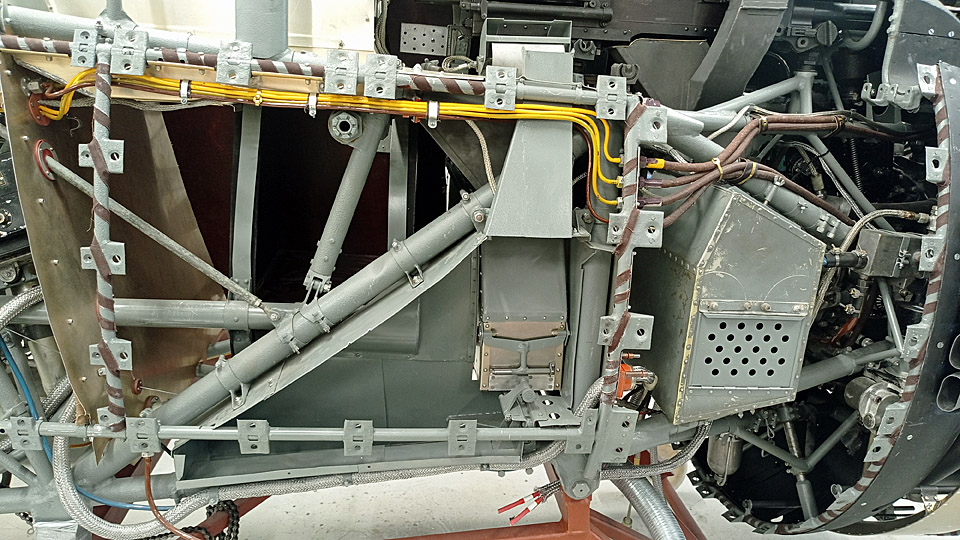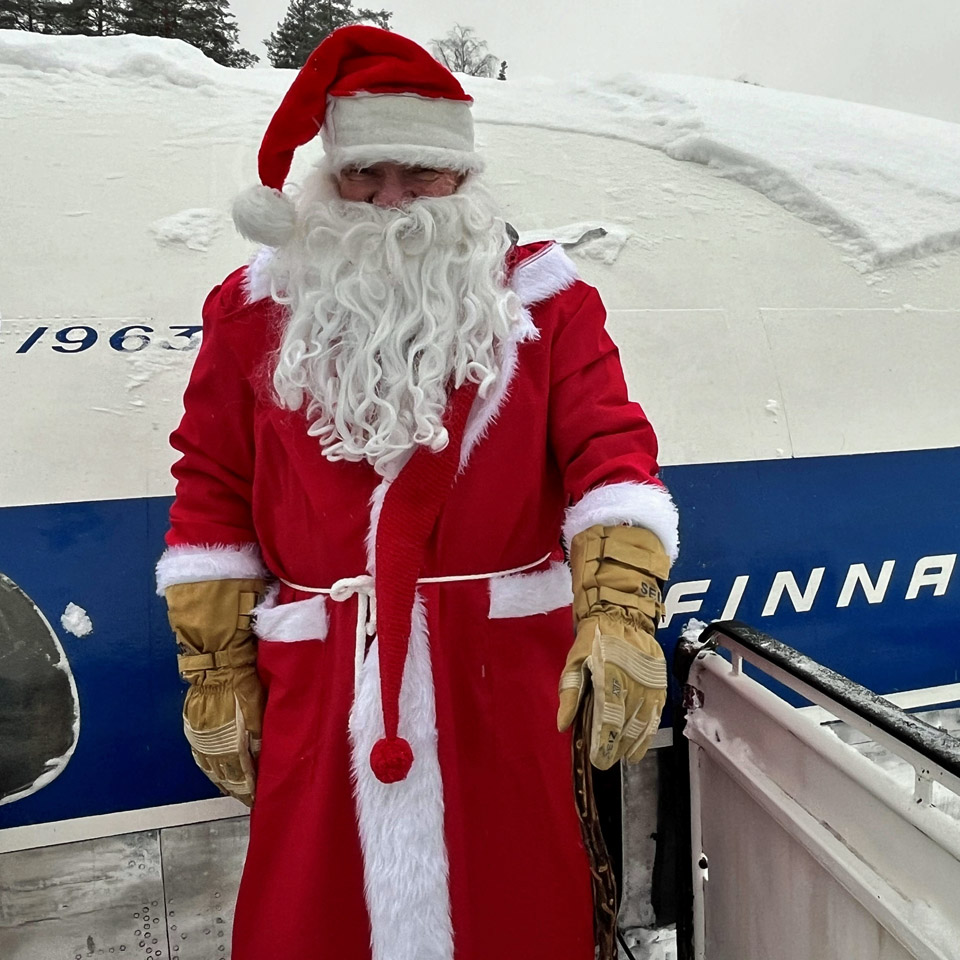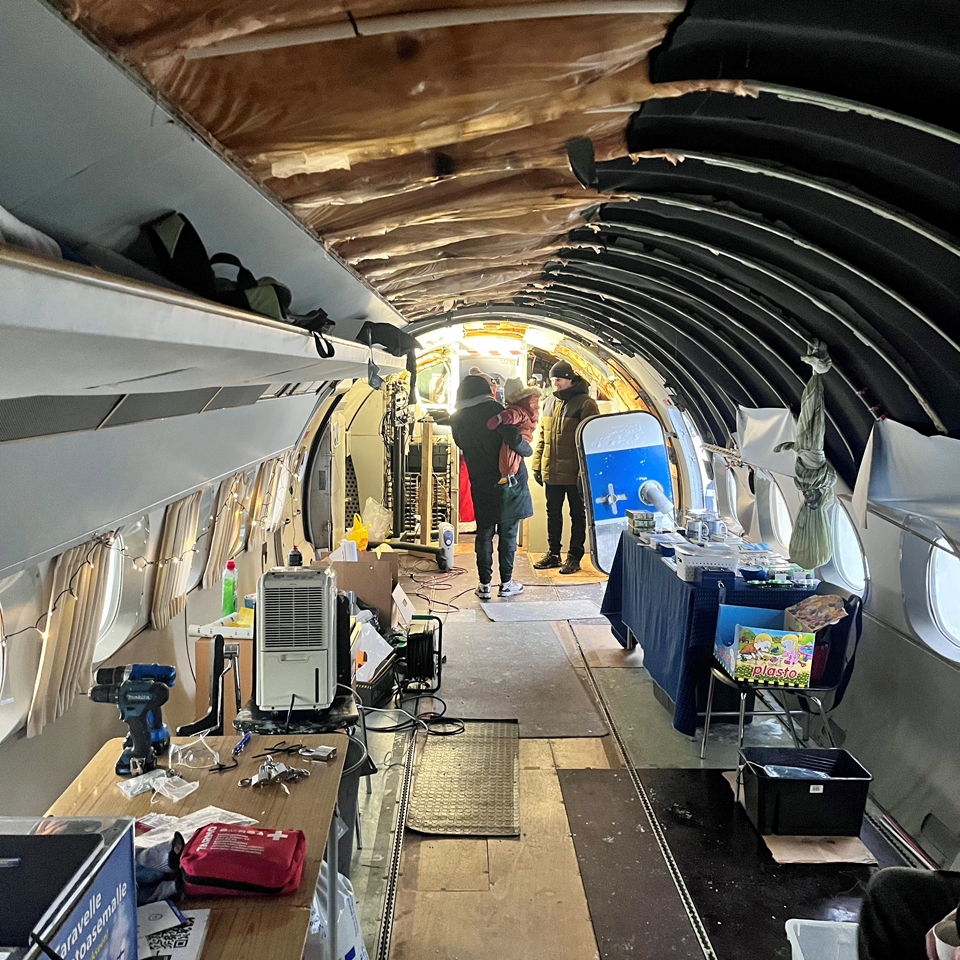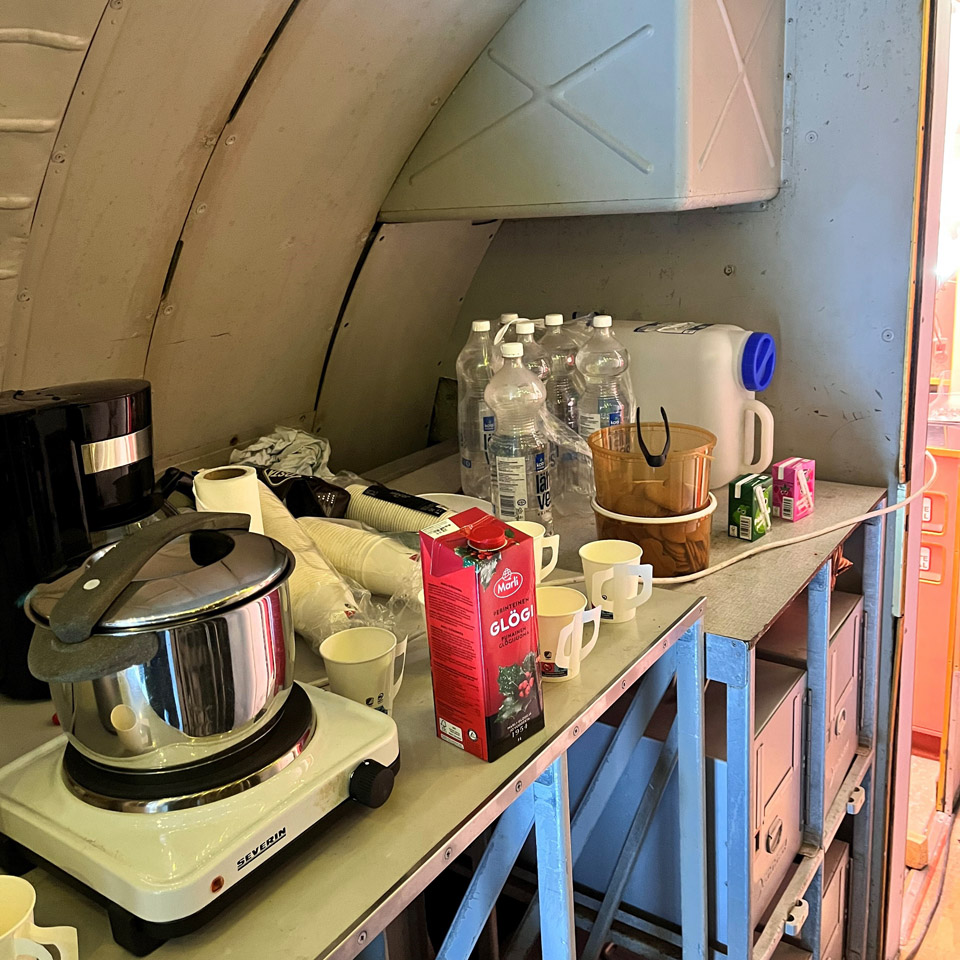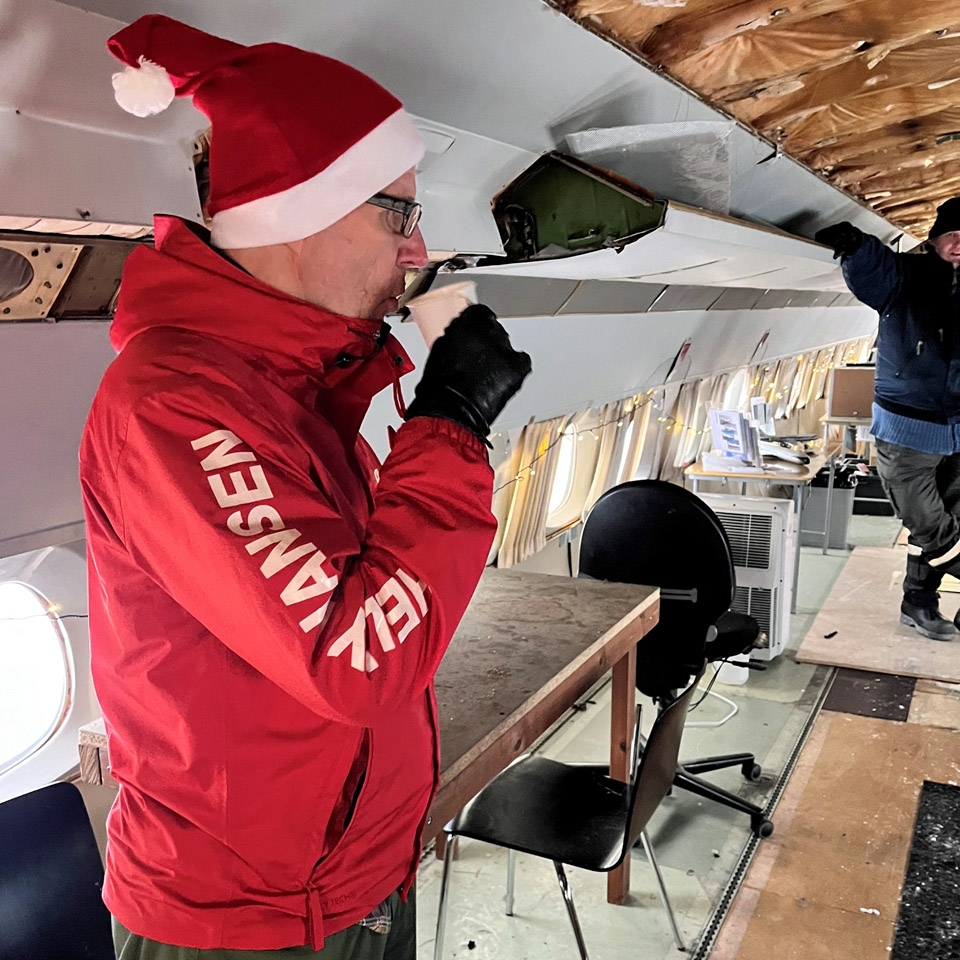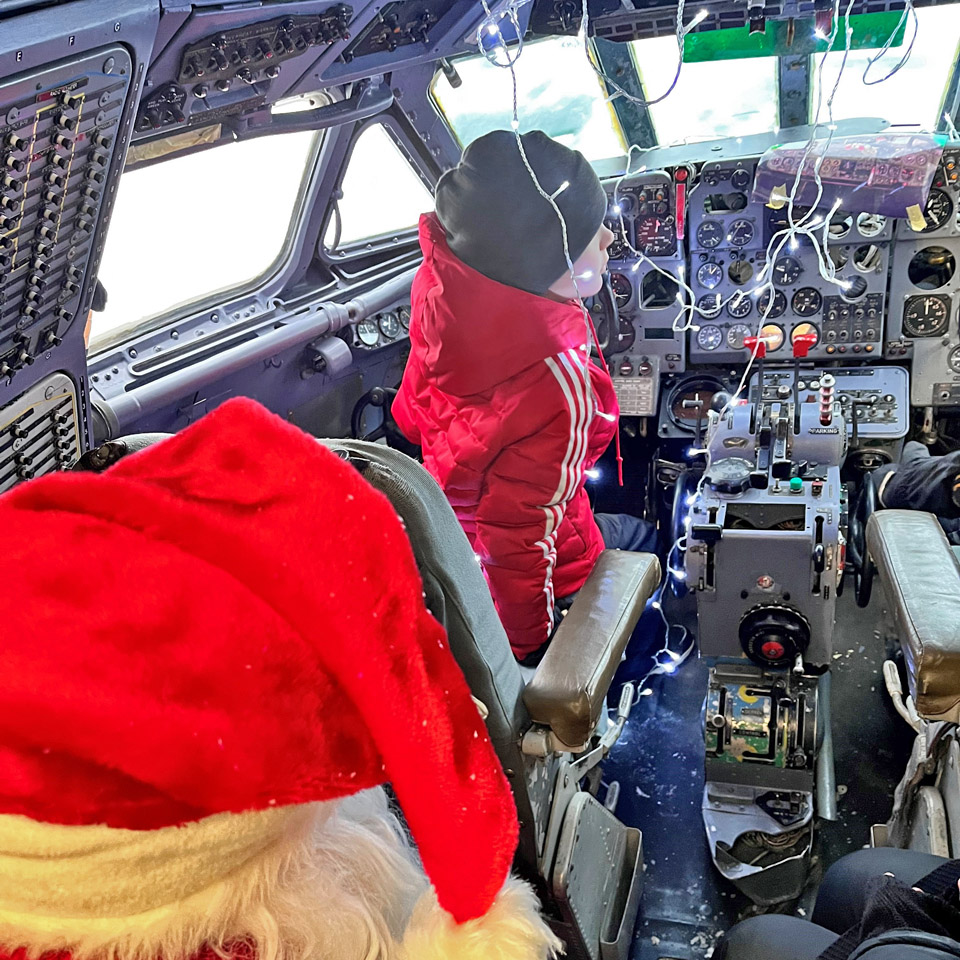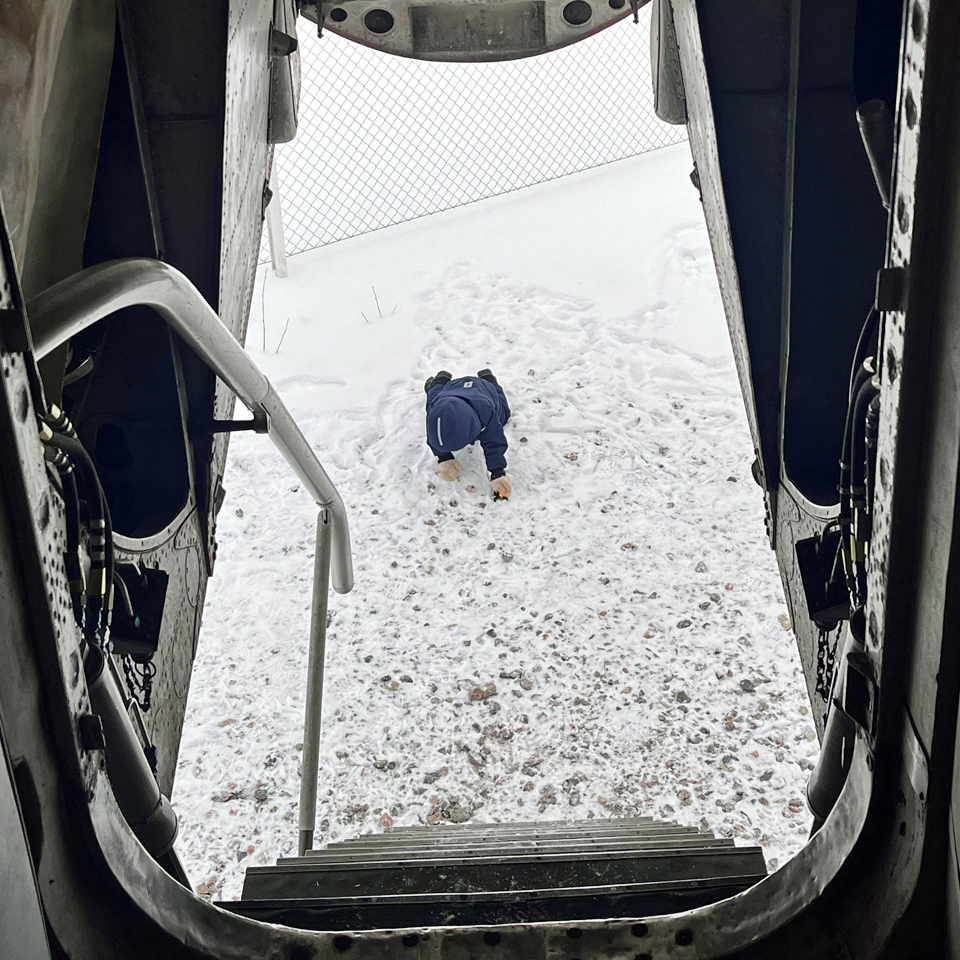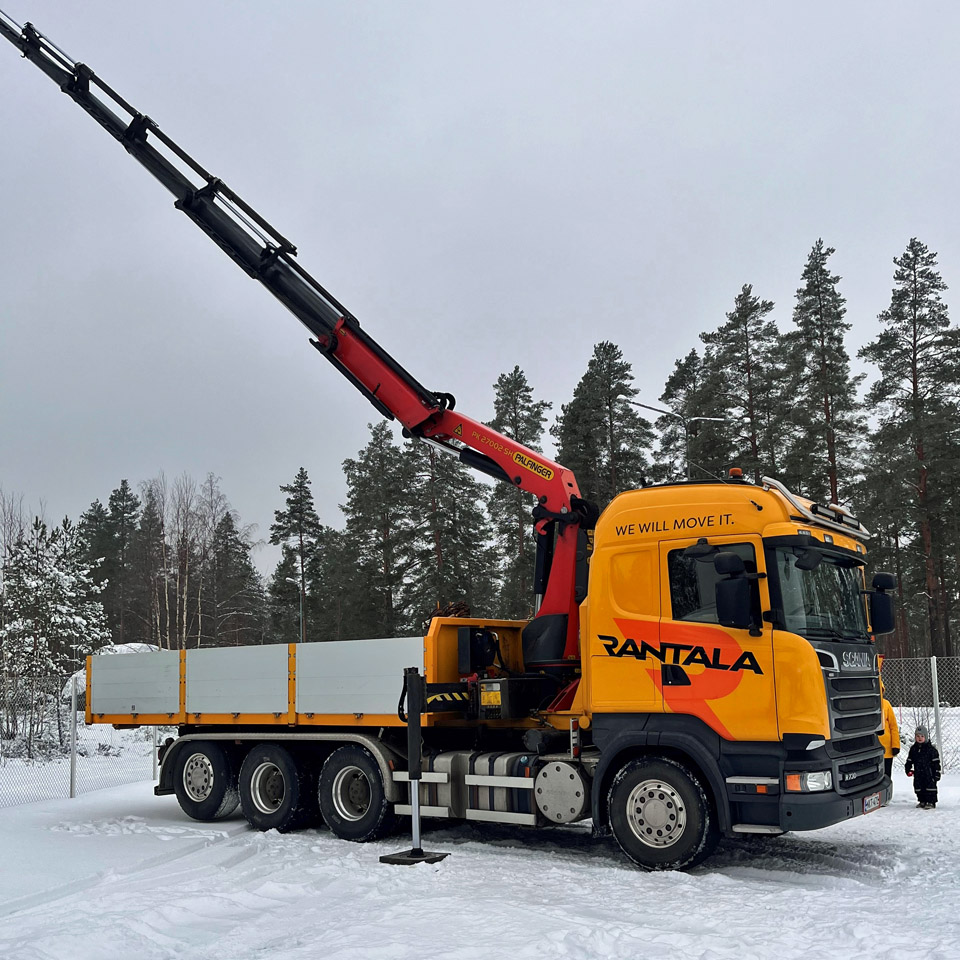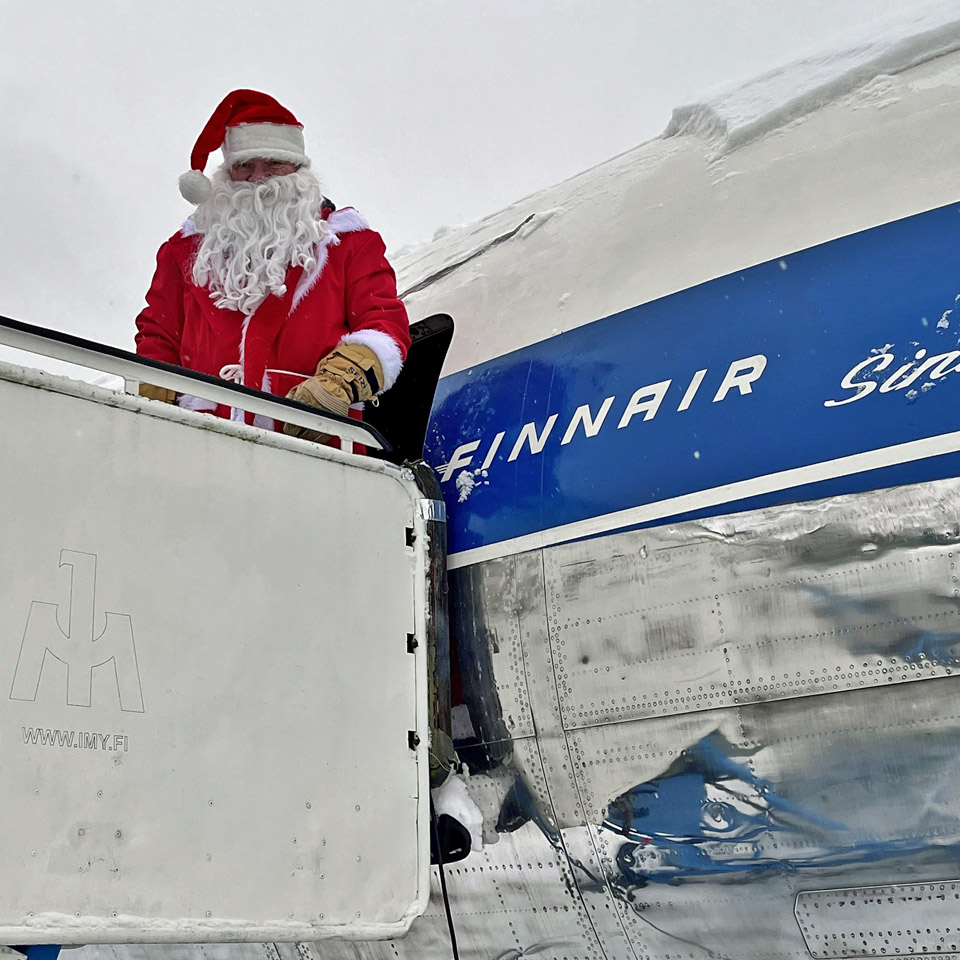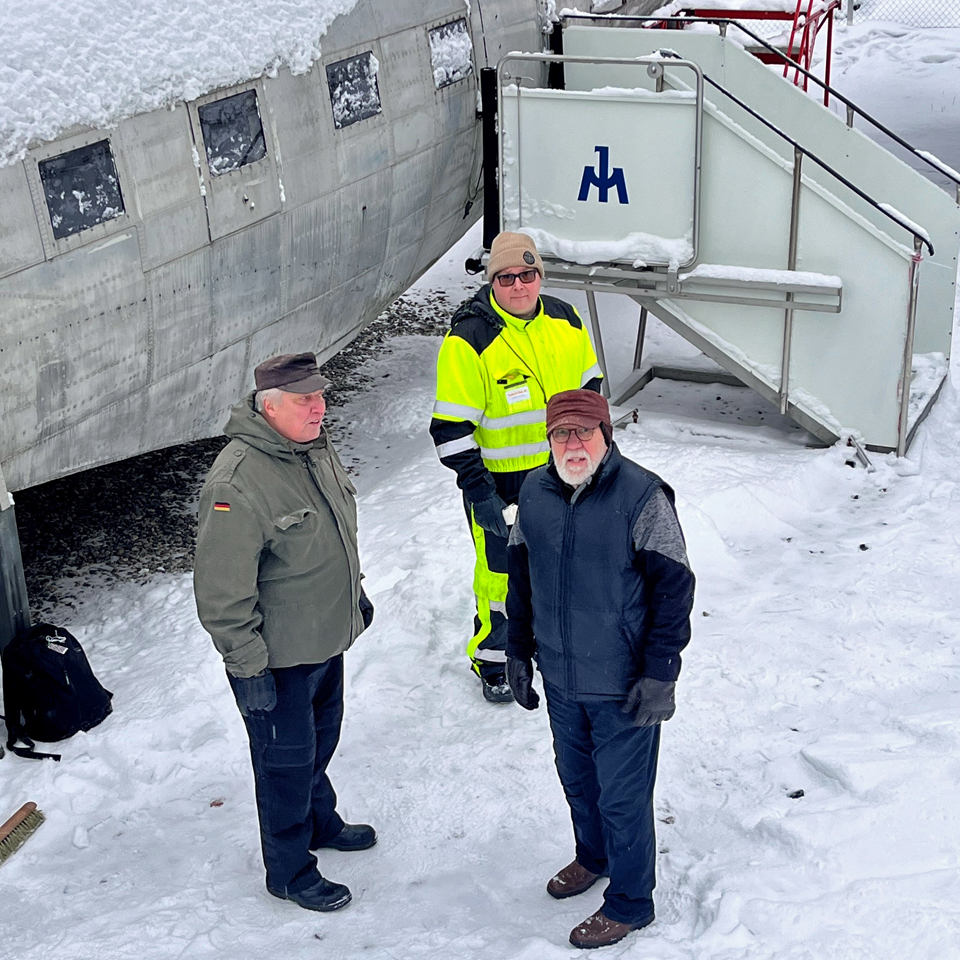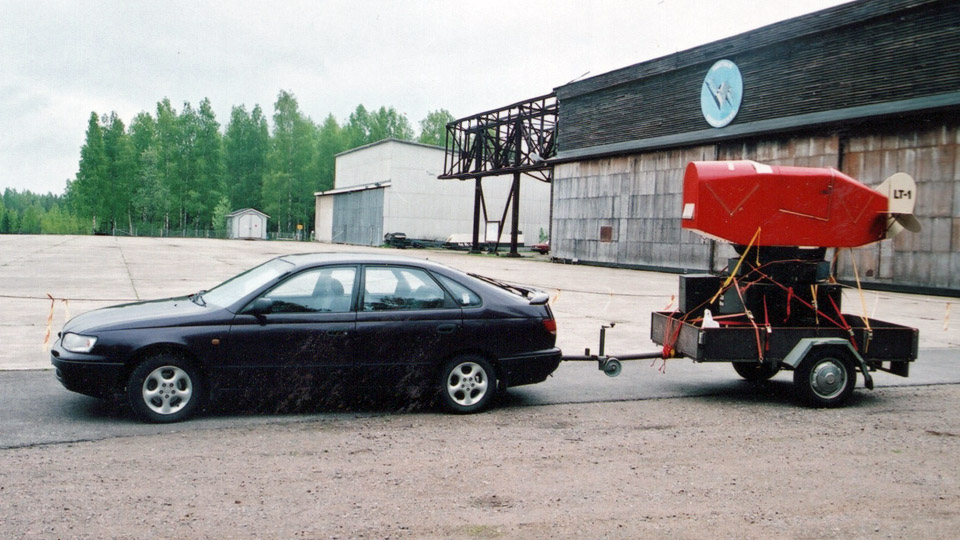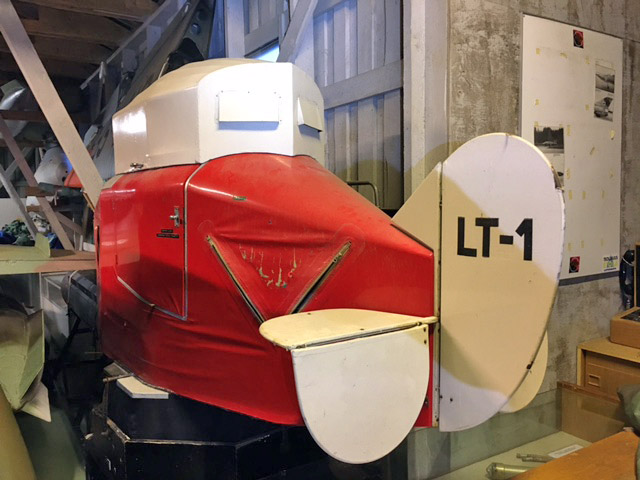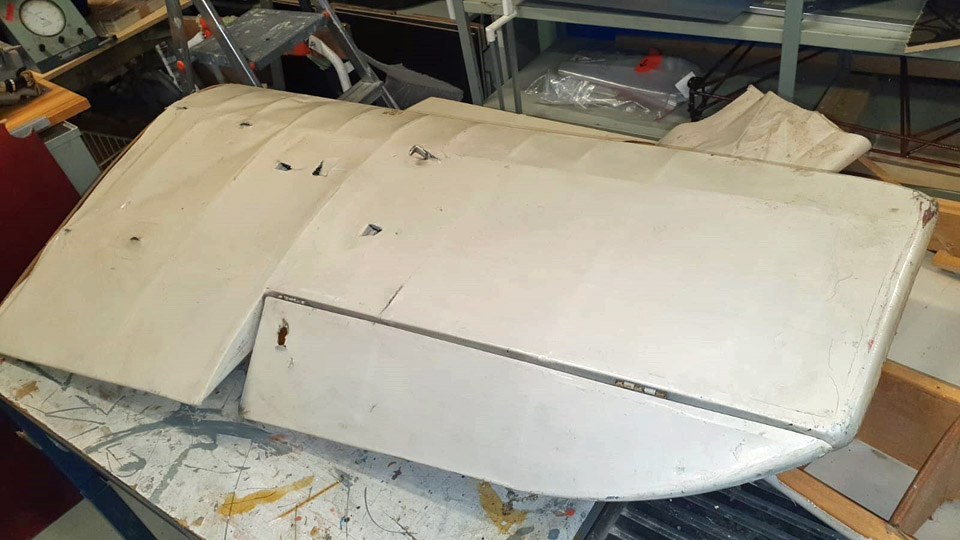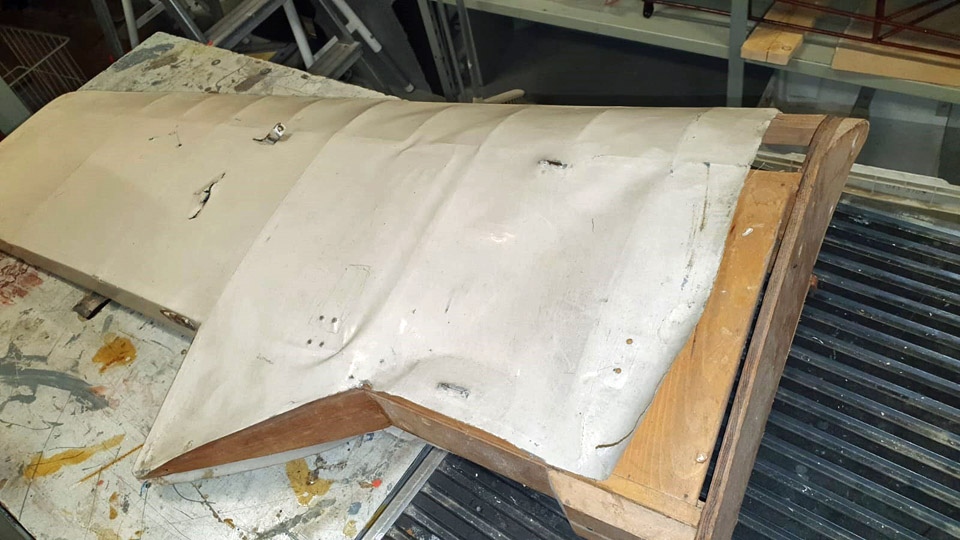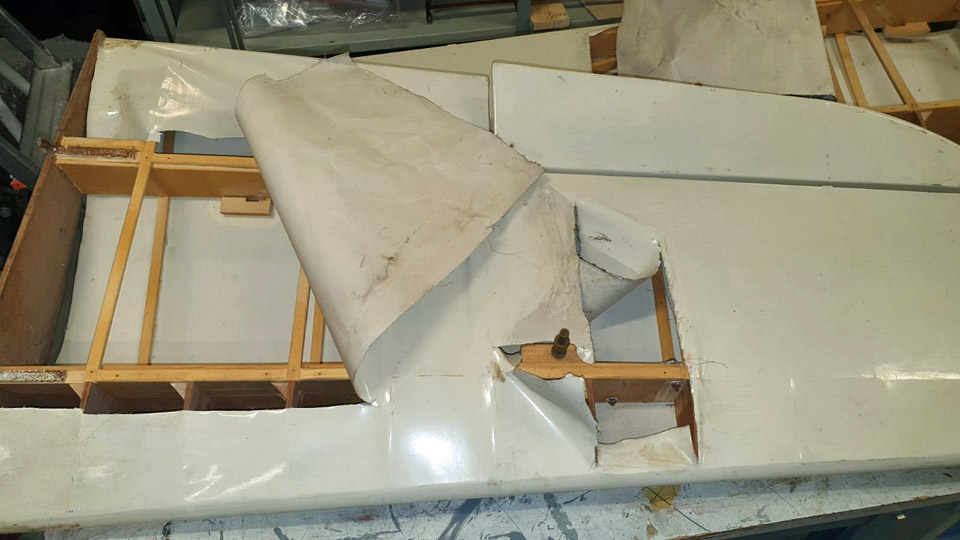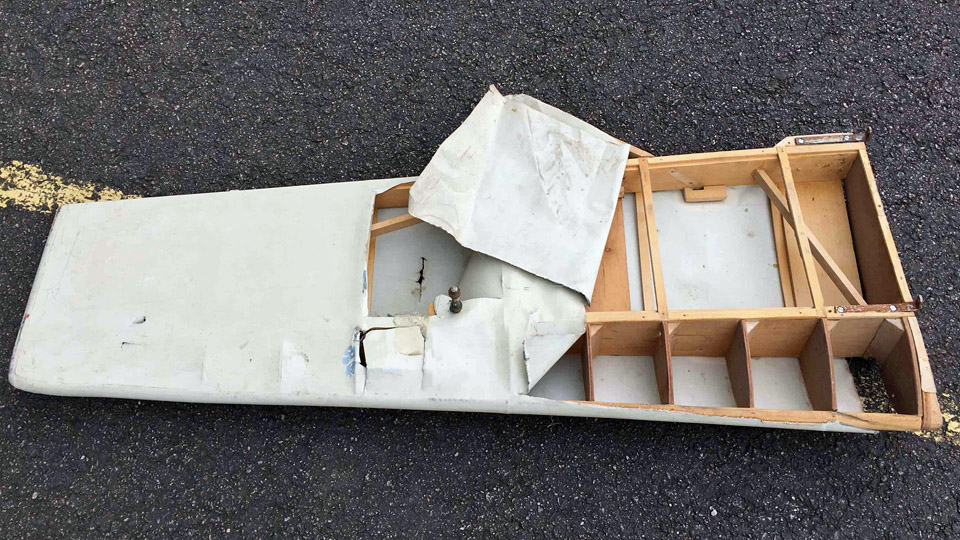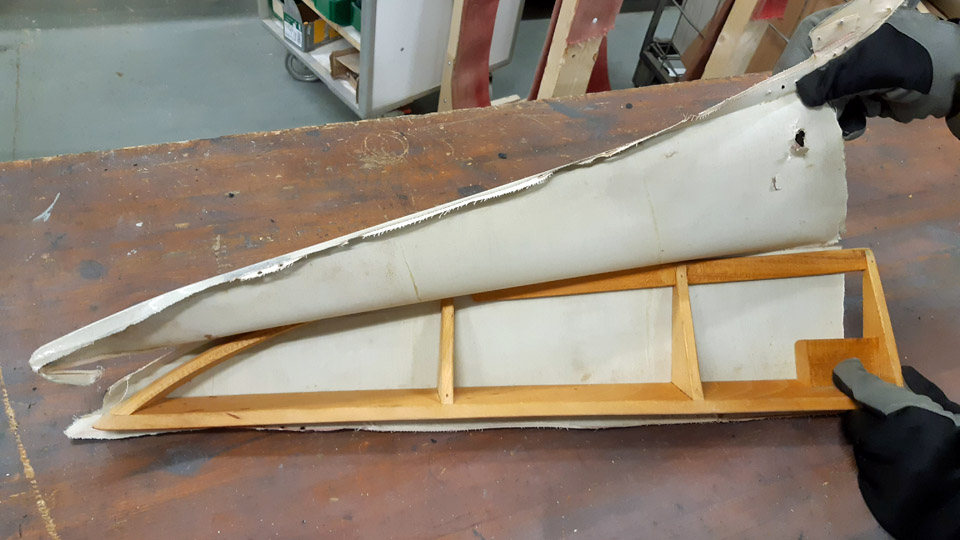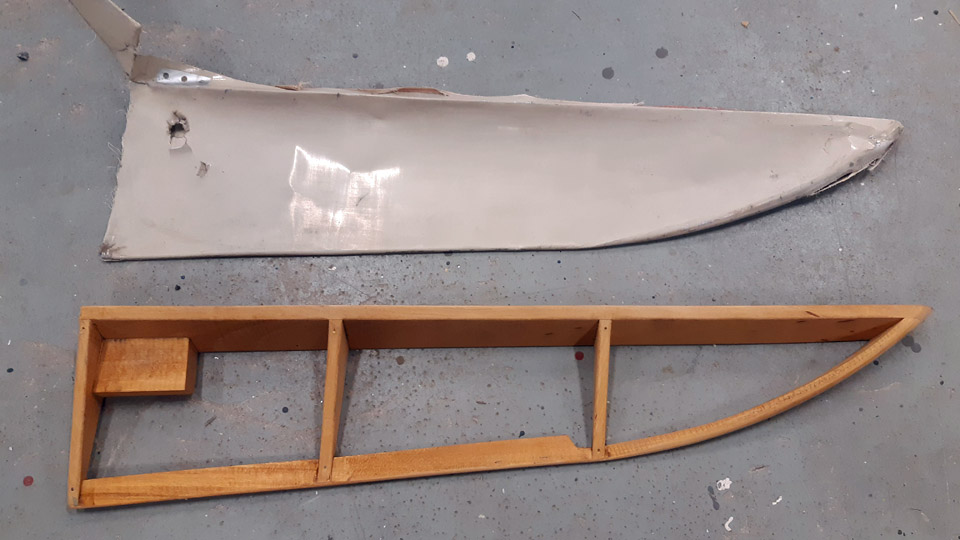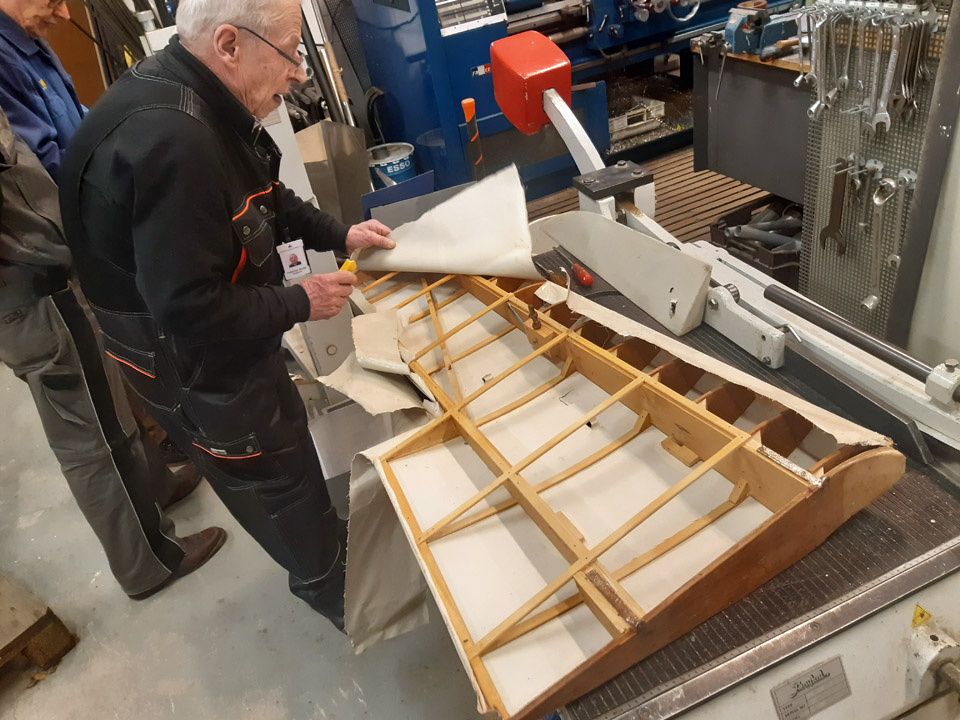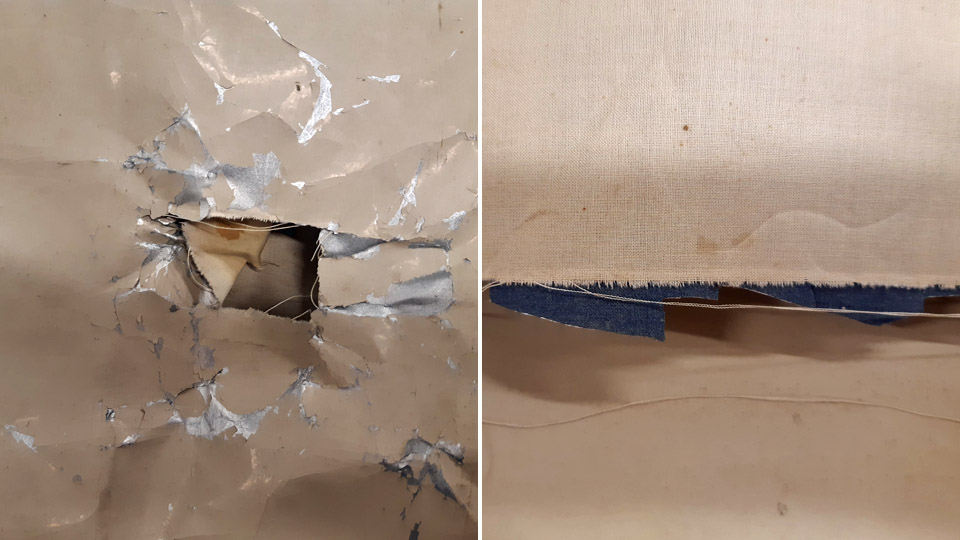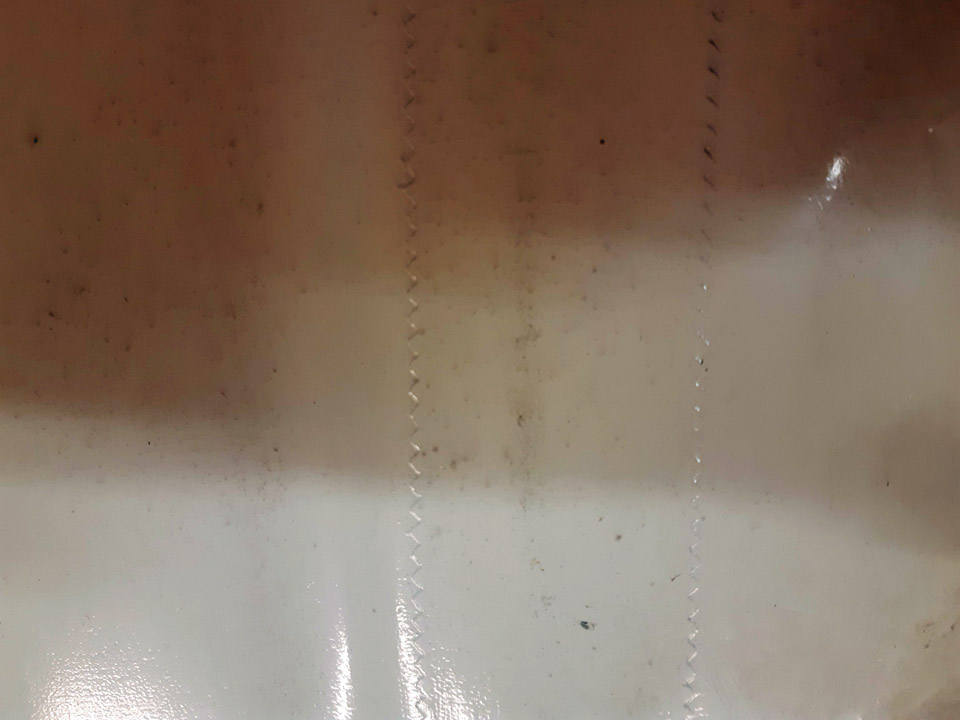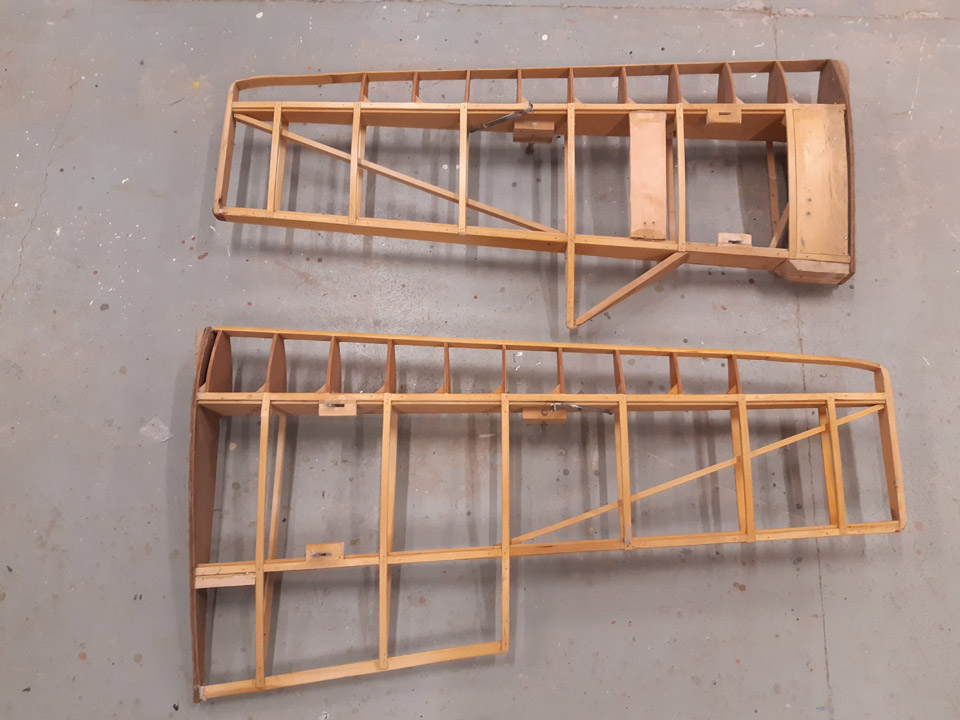Ressu's fuselage frame moved from Lemu to VantaaTiistai 9.4.2024 - Tuesday Club member On Thursday April 4th, the Tuesday Club task force set off towards Lemu in the Turku region to fetch the OH-XEA “Ressu” (“Snoopy”) fuselage frame to Finnish Aviation Museum to be restored by the Tuesday Club. The OH-XEA is an experimental aircraft, designed and built in the late 1960s by brothers Hietanen, Esko and Ari. Since last autumn we have been working on the restoration of Ressu’s horizontal stabilizer, elevator, rudder, and wing struts. This work will be ready soon and we could pick up the Ressu’s fuselage frame from Lemu to be restored. The Ressu fuselage, stripped entirely of its fabric covering, has been stored in the hall of Martti Mattila, an aviation enthusiast from Lemu. Last autumn we fetched the Ressu’s wings and tail parts from the same place. On our way to Lemu we made a detour via Turku Airport, to Caravelle “Bluebird”, which is on display there. In Helsinki we had picked up a Super Caravelle First-Class double seat frame, which we left to the Caravelle. The aim is to build four rows of seats in the “Bluebird” cabin and an adapted group of First-Class seats. From the Airport we continued to Lemu, where we arrived soon after noon.
Photo by Martti Mattila. Martti Mattila had already prepared the Ressu fuselage frame for pick up by fastening two wheels with pneumatic tyres, borrowed from a ride-on lawn mower, on the ends of the landing gear axle and by moving the fuselage frame outside the hall. Due to the wheels the fuselage frame was easy to move. The lawn mower wheels are exactly the suitable size for Ressu. Before the fuselage fame was moved next to the trailer to be loaded, the pick-up team posed for a group photo.
Photo by Matti Kainulainen. When the rather light fuselage frame was lifted on the trailer, we noticed that the landing gear with its wheels was too wide to fit inside the trailer sides. We solved the problem by unfastening the wheels and the landing gear fitted just nicely inside the trailer sides, and the fuselage frame rested on the trailer floor on its wheel flanges.
Photo by Matti Kainulainen. We fastened the fuselage frame on the trailer with the nose of the aircraft facing forward. The trailer we had at our disposal was long enough to hold almost the whole length of the Ressu’s fuselage frame. The tail reached just slightly over the tailgate. The fuselage frame was secured tightly on the trailer, front and aft, using cargo straps. We topped up our cargo by adding a security banner on the tail. We also loaded the rest of the Ressu stuff from Mattila’s hall, such as the cockpit plexiglass windows and the seat belts. Many thanks to Martti Mattila for accommodating Ressu and its parts in his hall since last June.
Photo by Matti Kainulainen. We spent some time with Martti Mattila, listening to him talking about his ongoing aircraft engine project. Based on what we heard, we can say that Mattila is a person with multiple skills when it comes to aircraft engines and aircraft in general. He has designed and built an aircraft and he also owns an airworthy engine-Lerche.
It was time to head back to Vantaa and the Finnish Aviation Museum, where we arrived late in the afternoon. On the museum yard we unfastened the cargo straps from Ressu’s fuselage frame and reassembled the wheels on the landing gear. Then we lifted the fuselage frame from the trailer on the asphalt-covered museum yard and pushed it on its wheels in front of the restoration workshop. As the Ressu’s fuselage frame will remain outside for the time being, we wrapped a tarpaulin around it to protect it from rain.
The Ressu’s fuselage frame is now ready to face the restoration procedure of the Tuesday Club. The first actual work item will be to clean the rusty frame tubes of the fuselage frame, stripped of its fabric covering. Then the tubes will be painted with protective Isotrol paint. Photos by Lassi Karivalo except if otherwise mentioned. Translation by Erja Reinikainen. |
|
Avainsanat: aviation history, restoration, Tuesday Club, Hietanen HEA-23b, OH-XEA, "Ressu" |
Caravelle's overhead storage shelf is movedTiistai 2.4.2024 - Ismo Matinlauri The interior work of Caravelle III, restored as Finnair OH-LEA Bluebird, started in March after the winter break. The first work item was to move the rear part of the left-hand side overhead storage compartment to the front RH side. (In this case the compartment is actually a shelf, and it will be called that in this blog.) On the right-hand side all overhead storage shelves and the ceiling structure have been dismantled in Sweden for the needs of the local Caravelle III SE-DAI. Our aim is to build a part of a passenger cabin to the front part of the fuselage, with four rows of seats. For this purpose the overhead storage shelf had to be disassembled from the rear part and installed to the other side in front. The rear part of the cabin will be an open space for future events and exhibitions. Disassembling the overhead storage shelf proved to be an arduous operation. This seems to be the first area in the Caravelle where screws have not been used sparingly. Obviously the shelf has not been meant to be disassembled regularly during maintenance work. Dozens of small screws had to be unfastened and on top of that, four locking bolts had to be unfastened through the passenger service unit. We had to build a long-handled tool specifically for this purpose.
Fastening battens for the overhead storage shelf were fastened on the RH side, starting from the service door. The lower aluminium batten could be moved but the upper batten proved impossible to unfasten and move, so we decided to use a wooden batten instead.
Reassembling the overhead storage shelf happened as the disassembly but in reversed order. First we fastened the row of air conditioning and loudspeaker panels into place.
The fasteners of the overhead storage shelf had to be modified to fit into their new location. The original spacing of the fasteners didn’t fit because the shelf had to be turned around to assemble it to the other side.
The final fastening of the shelf was done through the passenger service unit (PSU). This time the fastening bolts were replaced with self-drilling screws. We decided not to move the brackets for the fastening bolts, we estimated the screws to be sufficient.
Above the overhead storage shelves we stretched the covering material we had taken down from the other side. Now the front part of the cabin looks identical on both sides. Finally we installed the metal grilles to cover the air-conditioning and loudspeaker panels.
We had been doubtful about moving the overhead storage shelves because of the amount of work and breaking the existing structure. Actually disassembling the shelf proved to be the most difficult and the most time-consuming phase. After that the reassembly into the new place was quite straight-forward. There will be a partition at both ends of the shelf so that the cut ends of the shelf will be covered. Building the partitions will be another story and we will come back to that later. Photos by Ismo Matinlauri. Translation by Erja Reinikainen. |
|
Avainsanat: aviation history, restoration, Caravelle, OH-LEA, Sinilintu, Bluebird |
The Caravelle right-hand wingtip leading edge is completedKeskiviikko 27.3.2024 - Tuesday Club member Owned by Aviation Museum Society Finland and now on display at Turku Airport, the Caravelle lll (OH-LEA Sinilintu, Bluebird) has had its damaged right-hand wingtip leading edge restoration completed. The wingtip in the Caravelle is a separate entity, which can be detached from the wing. For the sake of simplicity, I’ll use the term wingtip for this structure in the future.
The last task in building the new leading edge for the wingtip was to rivet the edges of the upper and lower covering sheets to the centre line of the leading edge. The edges of the covering sheets meet at the centreline of the leading edge. Otherwise the covering sheets of the new wingtip had already been riveted in the wingtip structure.
To be able to rivet the covering sheet edges on the leading edge centreline, the sheet edges were tightened against the leading edge using a cargo strap, tied around the wingtip. After this, rivet holes were drilled at both ends of the sheets and the edges were riveted on the centre line with pop rivets.
It was noticed that a gap of 1-4 mm was left between the edges. The edges of the sheets therefore didn’t reach each other to form a butt joint. It was decided to cover the gap with an aluminium covering strip, running along the leading edge centre line.
To make the covering strip, an 8 cm wide and 40 cm long aluminium strip was cut out of 1 mm thick aluminium sheet to conceal the seam between the covering sheets. The aluminium strip was shaped to the curved form of the leading edge by shaping it against a suitable size iron tube. The concealing strip was arduous to shape because the wingtip leading edge slopes to various directions. The strip was, therefore, moulded phase by phase, fitting it to place at times. Thus the concealing strip was made to press tightly against the leading edge ridge.
Now the blue plastic films protecting the aluminium sheet could be removed and start the riveting of the covering strip. For the riveting the covering strip was tightened to place at both ends with a cargo strap. Masking tape was applied to both ends of the covering strip to mark the places of the pop rivets. The places were marked on the surface of the tape at even spaces with a compass and pencil, and the holes for the rivets were drilled accordingly.
We discussed what would be the best order to rivet the covering strip, so that it would best confirm to the shape of the wingtip leading edge. We ended up in starting the riveting from the rear end of the covering strip, proceeding rivet by rivet towards the wingtip. In doing so, the covering strip riveted itself tightly to the wingtip leading edge. Finally, the edges of the covering strip were tapped with a hammer and a piece of wood to press it still more tightly to the underlying surface of the covering material.
The demanding task of rebuilding the destroyed wingtip leading edge of the Caravelle III was now ready. Let’s not forget the fitting of the 3D-printed navigation lamp cover to its place in the leading edge tip. Photos by Lassi Karivalo. Translation by Matti Liuskallio. |
|
Avainsanat: aviation history, restoration, Caravelle, OH-LEA, Sinilintu, Bluebird, Tuesday Club |
Covering the Link Trainer aileronsMaanantai 18.3.2024 - Tuesday Club member The wing refurbishing of the South-Karelian Aviation Museum’s Link Trainer has moved on to the covering stage. At first we set on to covering the ailerons. One aileron was original and the other built at the Aviation Museum Society’s Tuesday Club to replace the missing aileron. Stripped of its covering, the repaired original aileron and the rebuilt aileron were covered with a special cotton fabric for covering, bought from Switzerland at Craftlab.
The covering was commenced by setting the aileron on the covering fabric and drawing the shape of the aileron on the fabric with a felt pen. The fabric was cut with a wide margin, taking into consideration the actual space for working. The fabric was folded around the aileron, so that the lapels met at the trailing edge. The lapels were fastened together with wig pins, at the same time tightening the fabric on the aileron. T-headed and long wig pins are very handy for this purpose. The pins were acquired from a Chinese on-line shop.
After the lapels of the covering fabric had been fastened to each other with pins, we were facing with tightening the fabric with water. Water tightening is the first phase to make the covering fabric tight. In the process the warp and weft already shrink somewhat, i.e. the fabric pre-tightens around the aileron. For water tightening the water was boiled. By boiling the water it will be disinfected, so that organic impurities won’t infect the fabric, which could cause the fabric to mould. Well, in this case the boiling wouldn’t have been necessary, because we aren’t dealing here with an airworthy device. After the water had cooled down, the fabric was thoroughly soaked.
After the fabric had dried, the proper tightening was commenced. It will be done with nitrocellulose lacquer, which causes the fabric to become as tight as a drumhead. As a lacquer we used NC-Speed nitrocellulose lacquer and as thinner Ohenne 8. Red iron oxide was mixed into the tightening lacquer as a pigment. It is customary to colour the tightening lacquer, so that you can keep track of which areas have been dealt with and which haven’t.
25 % lacquer.
50 % lacquer. The tightening coats of lacquer for the covering fabric will be applied in phases by starting with diluted lacquer and ending up with undiluted lacquer. The Link Trainer’s ailerons were applied at first with two layers of 25% lacquer, followed by two applications of 50% lacquer, one application of 75% lacquer and to finish it all an application of undiluted nitrocellulose lacquer. The lacquered surfaces were sanded between applications for the fuzz, which was stood up by the lacquer.
After the application of 50% lacquer, the fastening pins of the covering fabric were removed. At the same time the extra fabric lapels’ surplus to the trailing edge were cut off with a Stanley knife. This was possible, because the covering fabric was glued firmly enough to the trailing edge of the aileron, the ribs, and other parts of the aileron structure. The trailing edge will be sanded smooth, and a serrated cotton strip will be glued to it to strengthen it.
75 % lacquer. In this connection it must be noted that in case of an airworthy aircraft, the covering fabric would have been sewn to the ribs of the aileron, the same way as the fabric would have been sewn to the wing ribs. In not covering the ailerons and the wings we decided to cut corners, so in this case skip sewing the fabric to the ribs. This had been the case with the damaged covering fabric we stripped off the wings.
The tightening lacquer for one aileron is ready and waiting for to be painted beige. The other aileron will receive a few more applications of lacquer, before its fabric will be as tight as a drumhead. Photos by Lassi Karivalo. Translation by Matti Liuskallio. |
|
Avainsanat: aviation history, restoration, Tuesday Club, Link Trainer |
Damages in the Ressu (Snoopy) plywood covering repairedTiistai 12.3.2024 - Tuesday Club member The restoration of the experimental aircraft (OH-XEA) “Ressu” has so far concentrated on the work with repairing the holes and damages in the plywood covering of the wing halves, ailerons, horizontal stabilizer, and the elevator. This job has now been finished as far as patching goes.
There were about twenty holes and damaged areas in the plywood covering. Part of them being tiny pinpricks, but some were damages measuring tens of centimetres. As patching material, 0,9 mm aircraft plywood was used. To patch small holes, Ressu’s original plywood with a coating of paint was used. We obtained it in connection with clearing the large damaged areas in the wing. In patching the holes in the Ressu plywood covering, we followed the same proven method throughout. In this blog the patching of a largish damage on the lower surface of the left-hand wing will be presented as an example.
A hole, or an area of a larger damage, was sawn open to a square or rectangular shape. In sawing, a “Kugihiki”, or a so-called Japanese saw was used, which is an excellent tool for sawing thin plywood. Supporting battens were glued under the sawn edges, so that about 1 cm protruded from the inside of the opening. The plywood patch to cover the opening will be glued on these supporting battens.
For gluing the supporting battens and the plywood patches, moisture resistant Erikeeper Plus or Casco Outdoor glue for wood was used. Before gluing the support battens, the protective lacquer was ground off the edges of the underside of the covering plywood. Thus the glue sticks better on the underside of the covering plywood. The support battens were pressed onto the edges of the underside covering plywood with small clamps. Work was also in progress with other holes in the wings, simultaneously with this large opening underside the left-hand side wing.
After the glue had dried, a sheet of thin paper was fastened over the whole opening to be patched. The plywood edges of the plywood opening were “smudged” with a pencil so that it became visible on the paper, thus producing an image of the edge line of the opening. The paper was cut along the now visible opening edge in the plywood. So we had a model to cut the right size of a patch. The paper was superimposed on a sheet of plywood and, hey presto, after this model a plywood patch we needed was cut out of the sheet.
The cutout piece of plywood was fitted in place on the support battens. We marked with arrows the places where the plywood patch still needed filing at the edges, to get the patch press itself in a butt-joint manner against the edges of the opening. When the plywood was in place, glue was spread on the support battens, and the plywood was pressed against the battens.
The gluing of the plywood patch was secured by putting a sturdy plywood sheet on the patch and iron weights piled on it. At the lowest a sheet of foam rubber was placed to distribute the weight evenly.
Before laying the weights, a layer of protective plastic was spread over the patch, to prevent extra glue from seeping off the seams of the plywood patch and possibly sticking to the foam rubber sheet. When both the foam rubber sheet and the sturdy plywood sheet were in place, iron weights were piled on the plywood sheet. We noticed after the glue had dried and the weights and the plywood sheet were removed, that the plywood patch had settled very neatly in place. Photos by Lassi Karivalo. Translation by Matti Liuskallio. |
|
Avainsanat: aviation history, restoration, Tuesday Club, Hietanen HEA-23b, OH-XEA, "Ressu" |
Building of the missing Link Trainer aileronSunnuntai 10.3.2024 - Tuesday Club member The restoration of the Lappeenranta based Karelian Aviation Museum’s Link Trainer wings is underway at the Aviation Museum Society’s Tuesday Club. Our main work is to refurbish the wings and cover them again. Furthermore the missing aileron from the left-hand wing had to be built. As a model we used the right-hand wing aileron, which was stripped of its covering.
Photo by Kimmo Marttinen.
Photo by Lassi Karivalo.
Photo by Lassi Karivalo. We started to build the aileron from strips of wood according to the original. However, we noticed after a few days that the finished parts of the aileron didn’t keep their form, but there were distortions. The material we used wasn’t good enough. We ended up with a solution different from the original by building the left-hand aileron mainly from plywood, which keeps its form well. The decision facilitated our work also so that the curved trailing edge tip had originally got its form from strips of wood soaked in water. Making the curved part of the aileron from plywood will be easier.
Photo by Lassi Karivalo.
We started making the aileron from the curved tip of the trailing edge. In order to get thick enough plywood to build the trailing edge tip, we glued two sheets of plywood together. After the glue had dried, a picture of the right-hand aileron’s curved trailing edge was drawn on the plywood. The plywood was sawn along the drawing line, to give us a blank for the left-hand aileron trailing edge. The blank was shaped tentatively to its form.
Next we made from plywood the left-hand aileron’s leading edge, which could be called the spar of the aileron. We sawed it from 6 mm thick plywood according to the model given by the right-hand aileron. The leading edge is not at right angles to the wing base. The correct angle (98,3 degrees) was defined from right-hand aileron’s leading edge. The left-hand aileron’s leading edge base was ground to that angle. The leading edge batten was now ready.
The necessary three triangular ribs were made of plywood according to the right-hand wing aileron ribs and angles. In the same way some thin 3 mm strip of pine was found, from which the straight stem of the trailing edge was made. The trailing edge stem will be joined according to the original model with a 5 cm long glue joint to the curved tip of the trailing edge batten.
When all the components of the aileron had been made, the construction of the aileron was started. The compilation was commenced with the leading edge and the ribs that were glued to it. As a gluing platform sturdy plywood was used, onto which a guiding piece with an angle of 93,8 was fastened. The leading edge batten was fastened with clamps to the guide piece and its sturdy platform. First the aileron’s root rib was glued into place and after that the two other ribs. The gluing was secured with two screws. The aileron had already got its basic form.
The trailing edge of the aileron was still missing. First the straight thin stem of the trailing edge, which was shaped from a batten of wood, was glued to the ribs. Last to go to place was the curved tip of the trailing edge. At the same time the tip and stem were joined at the rib with a glue joint. The rib also strengthens the glue joint. Because the curved tip of the trailing edge had only been tentatively ground, the tip was ground to final form after the glue had dried.
The missing aileron of the Link Trainer was structurally finished. The aileron will be covered and painted in accordance with the covering of the Link Trainer wings. Photos by Pauli Jokimies except if otherwise mentioned. Translation by Matti Liuskallio. |
|
Avainsanat: aviation history, restoration, Tuesday Club, Link Trainer |
To the sunny south by Super CaravelleMaanantai 26.2.2024 - Erja Reinikainen I wrote in my travel diary on June 22nd, 1966: “The airplane is still on the ground, the engines are running. … We have been in the air for quite a while now. We had lunch and we will be in Warsaw in about 30 minutes. … We took off from Warsaw a long time ago and are flying high above the clouds. Soon we will land in Constanta. We will go by bus from the airport to Hotel Lotus”. We were on a holiday trip to Mamaia beach resort in Romania, on the Black Sea coast. I was 10 years old. The aircraft was Finnair Super Caravelle, but I haven’t noted its registration, and it can’t be seen in the photographs. On the way there and coming back we stopped in Warsaw to refuel. In the same diary there are stories from a trip on the Swedish charter airline’s Internord DC-6 from Helsinki to Naples and back in 1967. Flying over the Alps on a sunny day was an experience for a child from Finland where there are no mountains: “Ahead of us there are magnificent and beautiful mountains! The majestic Alps with their wonderful valleys glide by”. Some superlatives from a 11-year-old.
Between the diary pages there is a leaflet by Aurinkomatkat travel agency “Relaxing holiday to Rhodes, May 29th, 1968”. It shows that our flight was a Kar-Air flight, the aircraft belonged to Aero Oy. The following year we are in the air again and I write in my diary on May 29th, 1968: “Once more on a Finnair Super Caravelle. We are heading away from Seutula airport and towards Rhodes. … A map-like view opens below us with forests, lakes, and fields. The clouds drift by, soft and white. This time we will stop in Budapest to refuel. … Now we are in Budapest, but they won’t let us out. Why not?? So this is Budapest, looks very ordinary to me: a radar, an Interflug airplane and fuel trucks”.
Erja and her mother in the Rhodes harbour. This is the photo which everybody who goes there will have. In 1969 we were on the way to Rhodes again, this time the Caravelle was OH-LSB “Tampere”. I drew a picture of it in my diary. It is rather short and the windows are not triangular, but otherwise it is almost recognizable: engines on the rear fuselage, the horizontal stabilizer is almost the right size and there are boundary fences on the wings.
Drawing of Super Caravelle from 1969. Some background information for the travel stories: my father was an air force mechanic during WW2, and he wanted his family to experience what it was like to fly. I was 6 years old when we travelled from Helsinki to Tampere on a Kar-Air DC-3. In 1962-69 and in the early 1970s I travelled somewhere with my parents every year, usually by air. And I thought flying was fantastic. |
|
Avainsanat: aviation history, restoration, Caravelle, OH-LEA, Sinilintu, Bluebird |
Restoration of the Ressu (Snoopy) experimental aircraft?s wing struts and building the missing oneLauantai 17.2.2024 - Tuesday Club member The restoration of the Ressu aircraft’s wing struts is completed. The aircraft was designed and built by the brothers Hietanen from Turku in the 1960s. Originally registered OH-HEA, the aircraft was registered as an experimental aircraft with the registration OH-XEA in 1969.
The wing halves of the high-wing Ressu are supported with two wing struts fastened to the fuselage lower edge. The front strut has been made of 50 mm and the rear strut of 20 mm thick steel tube. Both the front struts have remained, but only one of the rear struts. These three struts had been in storage inside the bare fuselage frame, which had no covering. The rusty struts were restored yellow according to the original paint scheme and the missing strut was built.
The restoration of the struts was started by taking them to be sand blasted at Taximo Oy in the Tattarisuo area in Helsinki. The sandblasted struts were dealt with a transparent anti-rust Isotrol-lacquer immediately after the sandblasting. The struts were primed with light grey Isotrol-paint of the shade RAL 7005. The light grey primer worked well for the yellow finishing paint of the struts.
As the yellow finishing paint we used at first the Tikkurila UNICA outdoor furniture paint with RAL 1023 as the shade. The yellow paint had poor coverage, which we knew in advance. To replace the UNICA, a corresponding yellow Isotrol paint of the similar shade was chosen for the second coat of paint. The yellow pigment of the Isotrol paint has a better coverage, which was noted when painting the struts. They were painted with the yellow Isotrol three times over, so
To make the missing rear strut, a 2,5 m long 22 mm thick steel tube was bought from Starkki hardware store. As a model for the building, a wing rear strut has survived. At both ends of the rear strut there’s a fixed bracket plate, with holes in it to fasten the strut to a bracket in the wing and the fuselage.
When we examined the photographs of Ressu at our disposal, we noticed that the lower end of the rear strut had been adjustable and not fixed, as was the case with the rear strut at our disposal. At the lower end of the strut can be seen a fork-like bracket with a threaded spindle. It was evident that the lower end of the rear strut had been changed to a fixed bracket. We decided to make the missing rear strut lower end adjustable, to correspond to the wing strut in the photograph. For this purpose we received a wing strut adjustable head used in a Super Cub.
The building of the missing wing rear strut was started by cutting the steel tube to the measure of the rear strut. First we made the lower end of the rear strut. We welded a suitable nut, which fitted the threaded spindle of the lower end of the tube and screwed the bracket in place.
We made the wing rear strut top end a fixed one, according to the strut we had at our disposal. The end of the tube was sawn at an acute angle. After that the bracket halves for both sides were cut out of 2 mm metal plate to be welded in place. They were welded to the top sides of the tube. After welding, the bracket was ground to its final shape. When a hole had been drilled for the strut fastening bolt, the new strut was structurally finished.
The new wing strut was primed with light grey Isotrol paint, the same way as the three original ones had earlier been dealt with. After the primer had dried it received a coat of yellow Isotrol paint. Thus we had restored the two original front wing struts and a rear strut of the Ressu-aircraft and built the missing wing rear strut Photos by Lassi Karivalo. Translation by Matti Liuskallio. |
|
Avainsanat: aviation history, restoration, Tuesday Club, Hietanen HEA-23b, OH-XEA, "Ressu" |
Stories from the Caravelle's winterSunnuntai 11.2.2024 - Jouko Tarponen ja Hannu Hedman There are several Caravelle veterans among us. During coffee breaks and in different conversations colourful stories have been told from those days. Below two personal experiences. My first trip by air in a CaravelleWhen we were 13-14 years old, my friend and I were real aircraft fans. We lived in Raisio and we came often to Turku airport or the nearby Sikovuori nearby to see airplanes. Mainly we came there by bike but sometimes our parents drove us there.
In spring 1982 my friend and I saved money to travel by air from Turku to Helsinki, the aim was to fly in a Super Caravelle which Finnair was about to remove from service. I was already then a Caravelle fan, which must be because it was probably the first aircraft I was able to recognise as a child. In those days a weekly charter flight from Turku to Heraklion was flown by a Caravelle. The Finnair Super Caravelle flew a scheduled flight from Helsinki to Turku on Saturday evening and the departure time to Heraklion was 9.15 pm - if I remember correctly. The return flight to Turku landed on Sunday morning at 7.15 am. The great day was Sunday, May 23rd, 1982. We bought tickets for the morning flight from Turku to Helsinki, departing at 7.45. The aircraft was Super Caravelle and the ticket cost 70 Finnish marks. We returned home by taking a bus from Helsinki-Vantaa airport to the Helsinki railway station and from there by train to Turku. I felt very nervous and thrilled about flying because I had never experienced it before. In the morning we left Raisio in sunny weather, taken to Turku airport by car by our parents. When we got there, the information display said that the aircraft will return from Heraklion almost two hours later than scheduled. Then we drove back home to Raisio and returned to the airport about one hour and a half later.
Finnair’s Super Caravelle OH-LSD ”Oulu” from Heraklion landed in Turku at 9.10, full of passengers. When the passengers had disembarked, and the aircraft had been refuelled, there was an announcement: “departure on Finnair flight AY204 to Helsinki, gate 1”. At that point I felt for a moment that the situation was almost insuperable.
I felt slightly better when my friend and I started to walk from the gate to the aircraft. I was a first-timer in air travel, my friend wasn’t. I could only look at the floor, during take-off the uneven surface of the runway could be felt inside the aircraft, and this was a new experience for me. When we were in the air, the travelling became smooth.
Soon I looked out of the window for the first time. That was something new and awesome. I don’t remember being afraid anymore, except when the aircraft was turning when coming in for landing. I was 14 and my friend was 13. The whole experience of the first flight was and still is one of my most memorable experiences. At that time air travel was rather luxurious, compared today. Travelling south on holiday was not that common then. This was really a great experience and overcame my fear of flying. Now I knew what flying was about. It was really safe in those days too. An encounter in the darkIn this poor-quality picture you see a page from my pilot’s logbook from more than 50 years ago. At that time I was on a night VFR and basic instrument course in Kuopio. We were flying training flights and solo flights in the dark. I flew my first solo flight at night on February 4th, 1972. At that time the evening flight AY555 from Helsinki to Kuopio was flown on a Super Caravelle.
On these late flights I was often in the air at the same time with the Caravelle. Once flight controller Kalle Linden in the Kuopio tower warned me when I was heading south by the Kurkimäki masts: “OH-PCD, look around, the Finnair Fiver (555) is ahead”. The Caravelle acknowledged: “We can see the small one”. That was when I noticed there was an enormous pool of light flying on my left side. After that I was more careful, and we met often in the air in the Kuopio APP area. It was rather stirring that the tower cleared my plane on the ramp close to the Finnair Caravelle. I had to go round and kick the wheels on my plane to make myself important. And yes, the guys waved from the Caravelle’s window. First story: Jouko Tarponen, the photographer from the Turku team and documenter of the Caravelle restoration project Second story: Hannu Hedman, also from the Turku Caravelle team and a pilot with his heart and soul. He also likes to wear a red robe before Christmas… |
|
Avainsanat: aviation history, restoration, Caravelle, OH-LEA, Sinilintu, Bluebird |
The Myrsky engine NACA-ring and lower cowling completionKeskiviikko 7.2.2024 - Tuesday Club member The engine’s NACA-ring of the VL Myrsky II (MY-14) under restoration was completed when the tightening collars, made at the Tuesday Club for the four machine gun flash tube openings at the upper part of the NACA-ring, were fitted. With the tightening collars the flash tubes made of steel will be locked to the four openings intended for them in the NACA-ring. Of the four openings the two midmost will have 70 mm flash tubes and the lateral ones will have 45 mm flash tubes. The midmost flash tubes will be fastened at their rear end to brackets on the ring of the engine cradle. The machine gun barrel will thrust itself into the rear end of the lateral flash tube, holding it in place.
The excessively long flash tubes are still “sticking out” of the NACA-ring flash tube openings. They will be cut shorter, so that the flash tube ends will only protrude to some extent out of the flash tube openings. The difference in sizes of the flash tubes is due among other things to the fact that there’s no room at the side of the engine under the upper cowling for thick flash tubes. There are shields as well made of steel plate above these narrow flash tubes. They protect the upper cowling, which is nearly touching the flash tube, from overheating when the machine gun is firing. But all the same, both sizes of the flash tubes serve the four 12,7 mm LKk/42 machine guns.
Building of the lower cowling is almost completed at the Tuesday Club. The last tasks have been the guides, which will be fastened on the cowling’s inside surface stiffening strip, the guiding pegs to the front end of the cowling, and the tightening latches, with which the lower cowling will be locked to the upper cowling. Let it be pointed out, that the MY-14 engine upper cowling will be built in the Finnish Air Force Museum.
The guides, as well as the guiding pegs, and the tightening latches were made at the Tuesday Club. Owing to the guides and the guiding pegs, the lower cowling is easy to fit into place. Three slot-formed guides were riveted on the cowling’s inner surface rearmost stiffening strip. With the aid of these slot-formed guides the cowling “snaps” in place to the fastening ring of the rear part of the engine.
Photo by Jorma Laakkonen. The three guide pegs of the cowling’s front edge were riveted on the inner surface of the cowling’s front edge. The guide pegs of the front edge push into the holes drilled in the NACA-ring hem, thus fastening the cowling from its front edge on the NACA-ring. An insulation strip made of fabric was glued to the hem of the NACA-ring to separate the two metal surfaces from each other.
The upper and lower cowlings are locked to each other with four tightening latches. These four complicated tightening latches were built at the Tuesday Club, according to Myrsky blueprints. With adjustable tightening latches the upper and lower cowling can be locked to each other to suitable tightness. The parts of the latches with springs will be fastened to the upper edge of the lower cowling and the parts with levers to the upper cowling. The parts of the latches with springs are tentatively in place, waiting to be riveted.
After the guides and guiding pegs had been fastened on the cowling, the cowling’s fastening to the NACA-ring was tested. The testing was done while the cowling was still fastened on the last where it was built. It was noted that the guiding pegs fitted expectedly to the holes drilled in the hem of the NACA-ring. Thus the NACA-ring was fastened in place on the Pratt & Whitney R-1830 Twin Wasp engine, after which the lower cowling was fastened from its upper edge to the NACA-ring and from its lower half to the fastening ring of the rear part of the engine. The engine is beginning to resemble that of the Myrsky fighter. Photos by Lassi Karivalo except if otherwise mentioned. Translation by Matti Liuskallio. |
|
Avainsanat: aviation history, restoration, MY-14, VL Myrsky, Tuesday Club |
Demoiselle on show to the Shopping Centre TuulonenTiistai 6.2.2024 - Tuesday Club member The Shopping Centre Tuulonen’s small aviation museum received a new aircraft, when the Santos-Dumont n:o 20 – La Demoiselle was assembled on show along he DC-2 Hanssin-Jukka. La Demoiselle was donated by Museum Centre Vapriikki to Aviation Museum Society Finland. The display in the Hanssin Jukka hangar had been agreed between the Hanssin-Jukka heritage foundation and Aviation Museum Society. This Demoiselle is a replica and was built at the change of the Millenium.
The Demoiselle replica arrived by road transportation from Tampere to Tuulonen on Monday February 5th. Without the outer wing panels the fuselage with the centre wing fitted well on a closed-bed lorry. After the transportation arrived at Tuulonen, the outer wing panels were carried straight into the Hanssin-Jukka hangar. The Demoiselle fuselage with its mid-wing section were drawn out of the transportation and wangled inside through the double doors and to the shopping centre corridor. There it was noted that the fuselage with its mid-wing will not fit through the Hanssin-Jukka hangar double doors. Thus the mid-wing section had to come off.
Photo by Juha Veijalainen.
The unfastening of the wing posed no problem to the Tuesday Club members who were present. The two parts of the mid-wing were unfastened from their struts. After that it was easy to draw off both halves of the mid-wing from their fastening pegs in the fuselage. The left-hand and right-hand side wing halves were carried into the hangar.
Photo by Ari Aho.
Photo by Ari Aho. After that the mere Demoiselle fuselage was lifted with the shopping centre personnel engine first over the rails in front of the hangar doors, and from there carried into the hangar. There the fuselage was carried tail first into an area bordered by Hanssin-Jukka’s right-hand wing, fuselage and the horizontal stabilizer.
The original idea was to place the Demoiselle on show hanging from the ceiling, as was the case at the Museum Centre Vapriikki. It was, however, found that the floor level beside the Hanssin-Jukka was a much more presentable place. There the Demoiselle will be very well visible from the windows of the shopping centre and the aircraft wouldn’t obstruct the view to the Hanssin-Jukka. Thus the Demoiselle was decided to be reassembled right away.
Reassembling the Demoiselle replica was fairly straight forward. The Demoiselle’s use in shows with numerous dissembling and assembling has clearly been taken into account when building the aircraft. First the left- and right-hand halves of the mid-wing were pushed into the support pegs in the fuselage and the struts were fastened into the brackets situated on the wing under surface. Now the outer wing panels could be pushed into the fastening pegs in the mid-wing and tightened into place with overwing and underwing steel wire braces. When the propeller had also been fitted, the Demoiselle replica had been reassembled on show.
The Demoiselle replica, expertly built by a voluntary group in Tampere, is a resplendent sight, even though it’s not an original Demoiselle. The aircraft gives a good idea of the early 1900s aircraft and in this particular case of the Santos – Dumont n:o 20 – La Demoiselle type of aircraft. Adolf Arno of Tampere tried as the first Finn to get airborne in 1911 in a similar type - although failing in the attempt. Photos by Lassi Karivalo except if otherwise mentioned. Translation by Matti Liuskallio. |
|
Avainsanat: aviation history, restoration, Santos-Dumont, La Demoiselle |
A report on the Tuuli III (TL-1) fuselage restaurationSunnuntai 28.1.2024 - Tiistaikerholainen At the beginning of the autumn season we carried on with the restoration work of the fuselage of the Tuuli III in the storage tent at the Finnish Aviation Museum’s yard. First we emptied the cockpit from the stored and packaged Tuuli parts. While doing this we noticed that the temporary cockpit floor plywood panels, that we had installed about five years ago for the period of the restoration work, were covered with mould. We disposed of them and made new ones out of 9 mm film plywood to the measurements of the original Tuuli floor panels, which were in storage. The floor panels were installed to the cockpit.
We started to clean the dirty cockpit walls and floor surfaces. We removed the surface dust with a vacuum cleaner nozzle and a brush. However, the surfaces had still to be washed clean. At first we used the steam cleaner, which had been acquired to the museum, but it turned out to be ineffective particularly in cleaning the oiled and sticky floor surfaces. The best cleaning agent for oiled and dirty surfaces proved to be a car brake cleaning liquid, Motip Brake Cleaner. The cleaning liquid was put into a spray bottle, from which the liquid was sprayed onto the surface to be cleaned and the surface was wiped clean with a rag. The cold autumn weather forced us to move indoors, so the Tuuli fuselage was towed by a lift fork from the storage tent to the Finnish Aviation Museum’s restoration workshop.
At the restoration workshop we started to work on the canopy frames, with the future glass bead blasting in mind. The completely opaque plexiglass panes had already earlier been unfastened from the frames. Our job was to strip off the sloppy rubber seals. We tried different methods for this. The best way proved to be one where we heated the seal with a hot air blower, loosening the seal simultaneously with a broad chisel. Thus we managed to get rid of the rubber seals and the frames were now waiting to be glass bead blasted and subsequent painting.
Simultaneously with working with the frames we started the cleaning of the Tuuli engine bay surfaces. For that purpose the upper engine cowling was detached. Before we could get to cleaning the surfaces, we had to dismantle wires and gadgets from the fire wall between the cockpit and the engine bay.
As the wires and gadgets were dismantled, they were marked and put into bags or boxes. The parts were also photographed before unfastening to facilitate their refitting. Part of the gadgets in the firewall were fastened with bolts through the firewall. These bolts, too, and with them the gadgets could be unfastened, when one of the club members crawled into the cockpit under the instrument panel, and reached and held the nut in place, when the bolt was wrenched open from the other side. Thus all the parts fastened to the firewall could finally be detached. The exhaust tubes going below the fuselage were unfastened from the engine bay bottom.
The engine bay surfaces were now ready for cleaning. First we vacuum-cleaned the surfaces from dust and dirt. After that the surfaces were cleaned with Motip Brake Cleaner. Now the cleaning liquid was acquired in spray form. The cleaning of the surfaces was advanced by small steps. First the cleaning agent was sprayed onto the surface. Then the dirt was taken off with a paintbrush or a small brush and finally swept clean with a piece of cloth.
The Tuuli fuselage is without the tailplane. At the end of the cut off fuselage, there is a bulky metal support for the rudder axle. It’s covered with thick rust. The initial thought was to unfasten it for cleaning. Because the metal support is fastened to the end of the fuselage with rivets, we gave up the idea.
The surfaces of the metal support, and other rusty parts had their surfaces ground with a scouring pad, when most of the rust came off. Then the parts were dealt with an anti- grease substance and painted with aluminium-coloured rust-protecting Isotrol-paint. You can also apply Isotrol on a rusty surface because it penetrates the rust to the surface of the metal, preventing the corrosion from continuing. Photos by Lassi Karivalo. Translation by Matti Liuskallio. |
|
Avainsanat: aviation history, restoration, Tuesday Club, Valmet Tuuli III, OH-XTL, TL-1 |
The Draken instrument panel into display artefactSunnuntai 21.1.2024 - Tuesday Club member Aviation Museum Society Finland received as a donation, a Saab J 35 Draken instrument panel entity, which was fastened to a sturdy wood panel. The society decided to make it into a showpiece that could be presented at Aviation Museum Society’s stands at fairs or airshows. Other times the instrument panel would be on display beside the Draken in no 1 Hall of the Finnish Aviation Museum. So far it’s not known to which sub-type of the Saab J 35 Draken the instrument panel belongs to.
Making a display artefact requires that a safe rack must be built for the very heavy instrument panel entity. The rack will be built of metal and into such a form, that when sitting in front of the instrument panel with feet under it, the visitor can look at it just like the Draken-pilot would do in his cockpit.
So it had to be defined, at which elevation the instrument panel has to be, for the before mentioned conditions to be fulfilled. We lifted the heavy instrument panel onto a transfer platform on the forks of a forklift. After that we put a chair in front of the forklift and adjusted the elevation of the platform so that the instrument panel is in the visitor’s field of vision. It was noted that 40 cm from the floor level to the lower edge of the instrument panel will be suitable.
Drawings by Juha Veijalainen.
Now structural drawings and visualization images of the instrument panel rack could be made to build the rack. A solid and safe rack will be made of 20 mm x 40 mm steel tube. To make way for the rack, a lacquered wooden platform had to be unfastened from the instrument panel. Before unfastening the platform, a metal support was fastened to the lower edge of the instrument panel. The instrument panel was lowered on this support after unfastening the wooden platform.
We also detached a plaque fastened on the Draken instrument panel, saying that the instrument panel was a retirement present. To unfasten the plaque, we had to detach the front panel of the instrument panel. In place of the detached plaque we fastened a plaque, which said the instrument panel to be “that of the Saab J35 Draken-fighters, used by the Finnish Air Force”.
To build the rack for the instrument panel we bought a couple of bars of 20x40 mm metal tube. Pieces were sawn off the tube according to the drawings. The sawn pieces of tube were welded to one another. First the lower, upper and vertical tubes of both sides of the rack were welded together. After this, the rack was tentatively put together by fastening between both sides the cross bars of the lower and upper parts of the rack with clamps. It was noted that the rack will be just as we planned it. The next phase is to weld the cross bars to the sides of the rack, after which the instrument panel rack will be structurally ready.
Photo by Juha Veijalainen.
The Draken instrument panel with its rack is heavy, so moving it about is challenging. To facilitate the moving, the rear ends of the lower bars of the rack will be equipped with wheels. On top of that, sliding shafts will be built to the front end of the upper tubes. The shafts will slide inside the tubes, so the instrument panel will be movable like a wheelbarrow. We found a suitable set of trolley wheels of 150 mm in diameter at the storage of the Finnish Aviation Museum.
The 360 degrees revolving stem of the wheel was detached from them, because on the instrument panel rack the wheels will be fixed. Both wheels were taken apart and their bearings were serviced to operating standard.
Next the rack will be welded together to form an entity, after which the instrument panel can be fastened to the rack. After the lower bars have received their wheels and the shafts have been made, the rack will be painted. After that the donation to Aviation Museum Society Finland will be ready to be moved beside the Draken in the Finnish Aviation Museum. Photos by Lassi Karivalo except if otherwise mentioned. Translation by Matti Liuskallio. |
|
Avainsanat: aviation history, restoration, Tuesday Club;Saab J35 Draken |
Painting of the Mi-8 helicopter tail boom stabilizersTiistai 16.1.2024 - Tuesday Club member The restoration of the Karalian Aviation Museum situated Mil Mi-8T (HS-4) tail boom stabilizers has been concluded. It started at the Tuesday Club in the autumn season 2023. The decayed covering fabrics of the stabilizers of aluminium structure were removed and the stabilizers were covered with weatherproof thin aluminium sheets instead of fabric. Because it was decided to paint the stabilizers all round, the worn paint surfaces were ground ready for painting. The priming of the stabilizers has been described in an earlier blog.
The stabilizers of the tail boom will be painted according to the paint scheme used in Mi-8 helicopters in the Defence Forces. The upper surfaces will get a camouflage colour AN 22 green (Light bronze green), which compares to the NCS-shade map NCS S6020-G50Y. The under surface will be light grey (Light aircraft gray), which corresponds to the RAL shade map RAL 7038. As the surface paint the Teknos Futura 15 outside furniture paint was chosen. Corresponding to the aforementioned shades, the grey and green paints were bought at the Pintaväri Vantaa branch.
The painting was started from the upper surfaces with the green Futura. The smooth surfaces were painted with a narrow mohair roller. Uneven surfaces like the rivet studs, the stabilizer stem and the strut were painted with a brush. The first time over gave a fairly good coverage, but to achieve a good surface the stabilizers have to be painted twice over.
After the green paint had dried, the under surfaces were painted once over with the light grey Futura. This paint, too, gave laudable coverage with the first painting. However, the under surfaces were painted a second time over after the paint had dried, to achieve an even and well protecting surface.
We still had to paint the stabilizers’ upper surface for a second time. The painting of the upper surface for the second time was left last, because at the seam of the upper and under surfaces of the stabilizer, the green paint gives a good coverage over the light grey paint. In this context the green and grey border surface of the stabilizer was taped over with painter’s tape. Another option would have been to paint the border area with a roller without masking. However, we ended up with masking, because it produces a neat and tidy straight border between the grey and green paint.
When masking is used in painting, it’s important to take off the masking tapes immediately, before the paint dries. If you leave the tape in place till the paint is dry, when taking the tape off it easily tears dried paint along, and the neat border that was meant to be achieved by masking, will be lost.
The Mil Mi-8T helicopter of the Karelian Aviation Museum has now had its tail boom stabilizers restored and they are ready to be delivered to Lappeenranta. Photos by Lassi Karivalo. Translation by Matti Liuskallio. |
|
Avainsanat: aviation history, restoration, Mil Mi-8, HS-4, Tuesday Club |
Mid-winter Caravelle news from the writing deskSunnuntai 14.1.2024 - Erja Reinikainen About six months ago Ismo Matinlauri wrote a blog on this website where he talks about the amount of work and accessories used so far for Caravelle’s restoration project. At the end of 2023 the number of working hours spent on Caravelle’s disassembly, restoration and reassembly totalled 5,653 hours.
Photo via Ismo Matinlauri. Paraphrasing Ismo’s text from last July: "Restoring the Caravelle has required a fair number of volunteers’ working hours. The job can’t be done by restoration work volunteers alone, a lot of paperwork is also needed".
Photo via Ismo Matinlauri. The successful running of the project has required comprehensive commitment from the key personnel, especially for planning, procurement, and practical arrangements before each actual phase of work. In the three years since the beginning of the project, a large number of Caravelle-related meetings have been arranged by various groups involved in the project:
A memo has been written of nearly all meetings. We can say that the project has been rather well documented for the future aviation history researchers. The background crew of the project have also taken care of informing the various stakeholders about the project, as well as of Facebook posting, press releases, media interviews, photo processing, project material filing, etc. My estimate is that there are about 8-10 of us who have been involved in the project as PR officers, writers, translators, bloggers, photographers, etc.
Photo by Erja Reinikainen. About 50 blogs have been written yearly on the Caravelle project website, and all blogs have been complemented with photographs and translated into English. The web pages went through a thorough update in October 2023. Several articles have been written about the Caravelle and the project phases, mainly for the Feeniks journal of the Aviation Museum Society, but also for other aviation history magazines. Based on an unofficial and rather freely formulated Excel spreadsheet, about 70 meeting memos have been prepared so far in the Caravelle project. About 80 person-workdays have been spent in meetings when all participants and the memo writing are considered. It can be also estimated that about 40 person-workdays have been spent on publishing all the blogs, including writing, translation, photographs, and publishing. As the year 2024 progresses and the Caravelle restoration work continues, there will be more weekly meetings, blogs, articles, and photographs – and the documenting team will be busy again… |
|
Avainsanat: aviation history, restoration, Caravelle, OH-LEA, Sinilintu, Bluebird |
Repairing the Caravelle right-hand wingtipSunnuntai 14.1.2024 - Tuesday Club member Acquired from Sweden by Aviation Museum Society Finland, the Caravelle (OH-LEA) restored at Turku airport as Finnair’s “Bluebird” had had its right-hand wingtip leading edge badly damaged during its stay in Sweden. It was damaged for a distance of ca. 40 cm, and at the process the wingtip navigation light was also destroyed. Luckily the left-hand wingtip is intact, so that it can be used as a model when rebuilding the right-hand smashed wingtip. So the destroyed wingtip must be remade.
The remaking the right-hand wingtip was started by dismantling the damaged area. The rivets on the crumpled aluminium sheets were drilled away, so that the wingtip covering could be bent open, and the covering sheets detached from the wingtip support frame. We tried to straighten the detached aluminium sheets to their original shape, but they turned out to be so brittle, that they broke when straightened to their shape. So we concluded that the right-hand wingtip leading edge had to be covered with new sheets of aluminium.
We dismantled the detachable support frames of the damaged area. Part of the structure didn’t need to be detached, so it could be used as such in reconstructing the wingtip leading edge. The detached and usable frames were straightened to their original shape. They were fastened with pop rivets to their places, utilizing the intact left-hand wingtip when positioning the support frames.
After this the back wall and bottom plate of the right-hand wing navigation light bay was constructed with the left-hand wing navigation light bay as a model. The back wall and bottom plate were cut off from 1 mm thick aluminium plate. When the navigation light bay back wall and bottom plate were tentatively in place, the wingtip leading edge was nearing its original shape.
An opening was made in the bottom plate of the navigation light for the wiring of the navigation light. Also a cup-like socket was lathed for the later fixing of the light in mind. After that the whole navigation light bay was locked from its edges to the remaining original frames of the wingtip with strips cut from 1 mm thick aluminium plate. The fastening was done with pop rivets.
The next phase was to make a support frame between the edge of the intact area in the wingtip and the back wall of the navigation light, where the original frame had been destroyed. The edge of the intact area is formed by the wingtip’s original curve. However, the curve is somewhat damaged in its upper edge, but repairable and will be hidden by the wingtip new covering.
The support frame was made of 2 cm wide strips cut off from 1mm thick aluminium plate. To be able to rivet the ends of the support frame strips to the edge of the curve, the original damaged aluminium covering which had been on the frame, was cut off with a Dremel blade. Five strips were fastened between the edge of the curve and the back wall of the navigation light. The fastening was made with pop rivets. To make the structure sturdy enough to bend and fasten the aluminium cover sheets on the frame, two additional crosswise support strips were riveted to the structure. Now we’ll be ready to start covering the right-hand wingtip leading edge with 1 mm thick aluminium sheets. Photos by Lassi Karivalo. Translation by Matti Liuskallio. |
|
Avainsanat: aviation history, restoration, Caravelle, OH-LEA, Sinilintu, Bluebird, Tuesday Club |
Caravelle's Turku team and a nice Christmas lunchLauantai 23.12.2023 - Ismo Matinlauri On Tuesday, December 19th, the Caravelle Turku restoration group gathered for a Christmas lunch. The place was Krookila Wanha Tupa (Old Farmhouse). The history of the place goes as far back as 1490, and in the summer the farm is open to the public as a museum. We enjoyed a nice and traditional Christmas lunch in this historic and beautiful surrounding.
The group picture shows 13 members of the Turku team with Aviation Museum Society Finland chairman Janne Salonen and his mother Liisa Salonen. Liisa has participated in the Caravelle restoration project and has encouraged and cheered up the Turku team on several occasions. Our chief photographer Jouko Tarponen is missing from the picture – he was naturally behind the camera.
This team will continue its work with the Caravelle after a hopefully short winter break. If we are able to find a suitable warm workshop we will start restoring the passenger seat frames and cabin partition walls while waiting for the weather to get warmer. Photos by Jouko Tarponen Translation by Erja Reinikainen |
|
Avainsanat: ilmailuhistoria, entisöinti, Caravelle, OH-LEA, Sinilintu |
MY-14 lateral machine gun caissonsTorstai 14.12.2023 - Reino Myllymäki The armament of VL Myrsky II consists of four synchronized heavy 12,7mm VKT machine guns, located in the front fuselage. Each machine gun has its own caisson. The machine gun caissons in the middle hold 220 and the lateral gun caissons 260 rounds.
The VL Myrsky II restoration project has available three Myrsky fuselages (MY-5, MY-9 and MY-14). In all of them the original rails for the caissons were in place. In all these the rails were intact, but the steel parts were badly rusted. The original caissons couldn’t be found anywhere.
The MY-14 rails were picked out to be restored, dismantled from the fuselage and all the screws and rivets were taken apart. The rust from the steel parts was blown away with glass ball blasting, the surfaces were treated with Isotol-klarlack and painted grey. The aluminium parts were cleaned with glass ball blasting. The parts were riveted together again with aluminium rivets according to the blueprint, and the entity was painted grey all round. The refurbished rails were installed back to their original place.
The entirely new caissons were made according to the blueprints. The blueprints lacked the detail picture of the rear handle, the necessary measurements were obtained from the assembly blueprint. The finished caissons turned out to be slightly too big and they didn’t fit properly into place. The matter could be corrected by adjusting the rails and hammering the caissons. The left-hand caisson remained a bit ill fitting. This was mostly because the left-hand adjustment screws of the rails couldn’t be properly reached. The locking of the caissons was observed to be working.
How the caisson is fitted into place and locked: The caisson slides to place on a roller rail. The locking lever in the lower rail is turned up, and with a screw in the lever the caisson is tightened into place. The handle of the caisson is turned down and a locking peg inside the handle locks the handle in the down-position. The square-shaped tip of the locking screw leans now against the handle of the caisson and prevents the locking screw from turning on its own account. The steel front plate of the caisson is meant to guide the spent cartridges, coming from the gun above, into the collection box.
The caissons will be painted grey all over later, at the same time as other larger parts are taken to be spray painted. |
|
Avainsanat: aviation history, restoration, MY-14, VL Myrsky |
Santa Claus visited CaravelleTiistai 12.12.2023 - Ismo Matinlauri On Saturday, December 9th, we had the pleasure to welcome Santa Claus on board our Caravelle. Santa turned out to be a competent pilot and well familiar with the Caravelle’s flight deck equipment. This is understandable – after all, he has hundreds of years’ experience of flying with reindeer.
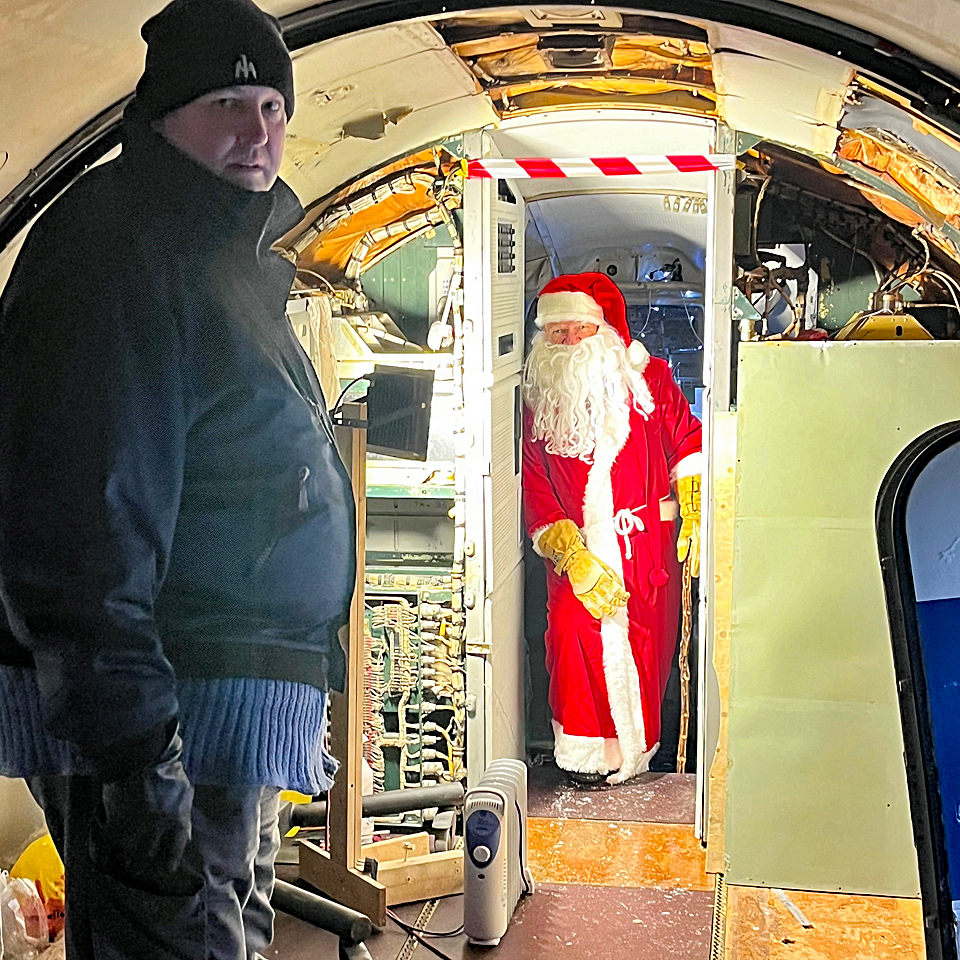 The aircraft was open to the public, too. The weather was slightly colder than during the assembly phase in the beginning of June, now it was -5 degrees Centigrade. The rear pantry was in use for the first time, serving visitors glögg and gingerbread and juice boxes to the younger ones.
During the day we had 63 visitors, including about 15 children. The visitor from farthest away came from Portugal. The visitors were genuinely excited and interested about the airliner and stayed a long time despite the cold weather.
The hydraulic system of the rear stairway had been repaired a couple of days earlier so we could have the stair open during Santa’s visit. This way the visitors could move flexibly to the aircraft’s tail and behind it, where the Rantala crane truck was parked. The truck interested especially the youngest visitors.
After the last visitors, we topped up the bags of de-icing salt to make sure the de-humidifying continues inside the aircraft. Santa’s visit was a suitable closing for this eventful year in our Caravelle.
The Caravelle team wishes our readers Merry Christmas and a Happy New Year! Photos by Ismo Matinlauri Translation by Erja Reinikainen |
|
Avainsanat: ilmailuhistoria, entisöinti, Caravelle, OH-LEA, Sinilintu |
The wings of a Link Trainer to the Tuesday Club to be coveredSunnuntai 3.12.2023 - Tuesday Club member The collection of the Karelian Aviation Museum includes a Link Trainer (LT-1). This Link Trainer has last been in use at Immola. The retired link Trainer was collected in a trailer to the Karelian Aviation Museum to Lappeenranta on June 6th, 2004.
Photos by Kimmo Marttinen. This Link Trainer has wooden wings with ailerons. The fabric covering of the wings is badly torn. On top of that the left aileron is missing. The wings are structurally more or less intact, so for that part there isn’t much to repair.
Photos by Ari Aho. The chairman of the Karelian Aviation Museum, Mr Kimmo Marttinen, turned to the Tuesday Club, whether the Tuesday Club could cover anew the LT-1 wings. The Club has several restoration projects active, but we answered in the affirmative because the wings are tiny, and their covering anew won’t take much room. The LT-1 wings were brought from Lappeenranta to the Finnish Aviation Museum at the beginning of November.
Photo by Ari Aho.
Photo by Kimmo Marttinen. At the Aviation Museum we examined more closely the Link Trainer’s fabric covered wings. There were damages on the covering of the upper surface of both the wings, but they could be patched. The covering of the underside of both the wings, instead, was badly damaged. However, we decided to cover both wings anew, because the end result wouldn’t be tidy, if it consisted of both old patched and new fabric covered surfaces.
Before we started to dismantle the covering, the right-hand wing’s aileron was taken off. Even though the covering was intact, it was dismantled. The reason for this being that we’ll have to build the lacking aileron for the left-hand wing, and for that we needed the structure of the right-hand aileron as a model. The structure of the aileron for building the lacking one can’t be seen without taking off the covering from the aileron.
When dismantling the covering fabric from Link Trainer’s wings, our attention was drawn to the thickness of the covering fabric. At the same time it was noticed that where there was damage in the fabric, silver and dark blue paint appeared from under the beige paint. The Link Trainer’s wings have originally, or before the last coat of paint, been blue on the upper surfaces and silver on the undersurfaces.
The covering fabric also told us that the wing had been covered with fabric consisting of several pieces sewn to each other. While covering the wing the stitches have been hidden with strips of fabric with zig-zag edges put into place with tightening lacquer to protect the seams.
When scrutinizing the wings stripped of the fabric, we noticed that the stem of the left-hand wing differed in form from that of the right- hand wing. Could it be that the entrance to the Link Trainer is on the left-hand side, therefore “a sidestep” has been made to the wing stem to facilitate entering the Trainer cockpit. We also noticed that the gluing seam in the wing structure had opened in places. These seams must be glued before commencing the covering. The airframe of the wing and aileron are very well and meticulously done, and also very typical wing structure with spars and ribs. Actually one wonders why the wing has been made so complete, because the Link Trainer’s wings weren’t meant to be airworthy. It would have been easier to construct the wings, if the wing had been made of plate, cut into wing form, as is the case in some Link Trainers. Before we get to covering the Link Trainer’s wings, we must find a suitable fabric. In this case an ordinary white cotton fabric will do, as long as it has good tightening qualities. So we bought two different kinds of cotton fabric from Eurokangas for testing the tightening qualities (Bed sheet fabric 150 and Satin), whose tightening qualities we now will test with nitro cellulose lacquer. Hopefully one of them will meet our requirements in covering the Link Trainer’s wings. Photos by Lassi Karivalo except if otherwise mentioned. Translation by Matti Liuskallio. |
|
Avainsanat: aviation history, restoration, Tuesday Club, Link Trainer |


